AP Calculus AB 2018

Copyright © 2016 by McGraw-Hill Education. All rights reserved. Except as permitted under the United States Copyright Act of 1976, no part of this publication may be reproduced or distributed in any form or by any means, or stored in a database or retrieval system, without the prior written permission of the publisher, with the exception that the program listings may be entered, stored, and executed in a computer system, but they may not be reproduced for publication.
ISBN: 978-1-259-58337-7
MHID: 1-259-58337-6
The material in this eBook also appears in the print version of this title: ISBN: 978-1-259-58336-0,
MHID: 1-259-58336-8.
eBook conversion by codeMantra
Version 1.0
All trademarks are trademarks of their respective owners. Rather than put a trademark symbol after every occurrence of a trademarked name, we use names in an editorial fashion only, and to the benefit of the trademark owner, with no intention of infringement of the trademark. Where such designations appear in this book, they have been printed with initial caps.
McGraw-Hill Education eBooks are available at special quantity discounts to use as premiums and sales promotions or for use in corporate training programs. To contact a representative, please visit the Contact Us page at www.mhprofessional.com .
McGraw-Hill Education, the McGraw-Hill Education logo, 5 Steps to a 5 , and related trade dress are trademarks or registered trademarks of McGraw-Hill Education and/or its affiliates in the United States and other countries and may not be used without written permission. All other trademarks are the property of their respective owners. McGraw-Hill Education is not associated with any product or vendor mentioned in this book.
AP, Advanced Placement Program , and College Board are registered trademarks of the College Board, which was not involved in the production of, and does not endorse, this product.
TERMS OF USE
This is a copyrighted work and McGraw-Hill Education and its licensors reserve all rights in and to the work. Use of this work is subject to these terms. Except as permitted under the Copyright Act of 1976 and the right to store and retrieve one copy of the work, you may not decompile, disassemble, reverse engineer, reproduce, modify, create derivative works based upon, transmit, distribute, disseminate, sell, publish or sublicense the work or any part of it without McGraw-Hill Education’s prior consent. You may use the work for your own noncommercial and personal use; any other use of the work is strictly prohibited. Your right to use the work may be terminated if you fail to comply with these terms.
THE WORK IS PROVIDED “AS IS.” McGRAW-HILL EDUCATION AND ITS LICENSORS MAKE NO GUARANTEES OR WARRANTIES AS TO THE ACCURACY, ADEQUACY OR COMPLETENESS OF OR RESULTS TO BE OBTAINED FROM USING THE WORK, INCLUDING ANY INFORMATION THAT CAN BE ACCESSED THROUGH THE WORK VIA HYPERLINK OR OTHERWISE, AND EXPRESSLY DISCLAIM ANY WARRANTY, EXPRESS OR IMPLIED, INCLUDING BUT NOT LIMITED TO IMPLIED WARRANTIES OF MERCHANTABILITY OR FITNESS FOR A PARTICULAR PURPOSE. McGraw-Hill Education and its licensors do not warrant or guarantee that the functions contained in the work will meet your requirements or that its operation will be uninterrupted or error free. Neither McGraw-Hill Education nor its licensors shall be liable to you or anyone else for any inaccuracy, error or omission, regardless of cause, in the work or for any damages resulting therefrom. McGraw-Hill Education has no responsibility for the content of any information accessed through the work. Under no circumstances shall McGraw-Hill Education and/or its licensors be liable for any indirect, incidental, special, punitive, consequential or similar damages that result from the use of or inability to use the work, even if any of them has been advised of the possibility of such damages. This limitation of liability shall apply to any claim or cause whatsoever whether such claim or cause arises in contract, tort or otherwise.
CONTENTS
About the Author
Preface
Acknowledgments
Introduction: The Five-Step Program
STEP 1 Set Up Your Study Plan
1 What You Need to Know About the AP Calculus AB Exam
1.1 What Is Covered on the AP Calculus Exam?
1.2 What Is the Format of the AP Calculus AB Exam?
1.3 What Are the Advanced Placement Exam Grades?
How Is the AP Calculus AB Exam Grade Calculated?
1.4 Which Graphing Calculators Are Allowed for the Exam?
Calculators and Other Devices Not Allowed for the AP Calculus AB Exam
Other Restrictions on Calculators
2 How to Plan Your Time
2.1 Three Approaches to Preparing for the AP Calculus AB Exam
Overview of the Three Plans
2.2 Calendar for Each Plan
Summary of the Three Study Plans
STEP 2 Determine Your Test Readiness
3 Take a Diagnostic Exam
3.1 Getting Started!
3.2 Diagnostic Test
3.3 Answers to Diagnostic Test
3.4 Solutions to Diagnostic Test
3.5 Calculate Your Score
Short-Answer Questions
AP Calculus AB Diagnostic Test
STEP 3 Develop Strategies for Success
4 How to Approach Each Question Type
4.1 The Multiple-Choice Questions
4.2 The Free-Response Questions
4.3 Using a Graphing Calculator
4.4 Taking the Exam
What Do I Need to Bring to the Exam?
Tips for Taking the Exam
STEP 4 Review the Knowledge You Need to Score High
5 Review of Precalculus
5.1 Lines
Slope of a Line
Equations of a Line
Parallel and Perpendicular Lines
5.2 Absolute Values and Inequalities
Absolute Values
Inequalities and the Real Number Line
Solving Absolute Value Inequalities
Solving Polynomial Inequalities
Solving Rational Inequalities
5.3 Functions
Definition of a Function
Operations on Functions
Inverse Functions
Trigonometric and Inverse Trigonometric Functions
Exponential and Logarithmic Functions
5.4 Graphs of Functions
Increasing and Decreasing Functions
Intercepts and Zeros
Odd and Even Functions
Shifting, Reflecting, and Stretching Graphs
5.5 Rapid Review
5.6 Practice Problems
5.7 Cumulative Review Problems
5.8 Solutions to Practice Problems
5.9 Solutions to Cumulative Review Problems
Big Idea 1: Limits
6 Limits and Continuity
6.1 The Limit of a Function
Definition and Properties of Limits
Evaluating Limits
One-Sided Limits
Squeeze Theorem
6.2 Limits Involving Infinities
Infinite Limits (as x → a )
Limits at Infinity (as x → ±∞)
Horizontal and Vertical Asymptotes
6.3 Continuity of a Function
Continuity of a Function at a Number
Continuity of a Function over an Interval
Theorems on Continuity
6.4 Rapid Review
6.5 Practice Problems
6.6 Cumulative Review Problems
6.7 Solutions to Practice Problems
6.8 Solutions to Cumulative Review Problems
Big Idea 2: Derivatives
7 Differentiation
7.1 Derivatives of Algebraic Functions
Definition of the Derivative of a Function
Power Rule
The Sum, Difference, Product, and Quotient Rules
The Chain Rule
7.2 Derivatives of Trigonometric, Inverse Trigonometric, Exponential, and Logarithmic Functions
Derivatives of Trigonometric Functions
Derivatives of Inverse Trigonometric Functions
Derivatives of Exponential and Logarithmic Functions
7.3 Implicit Differentiation
Procedure for Implicit Differentiation
7.4 Approximating a Derivative
7.5 Derivatives of Inverse Functions
7.6 Higher Order Derivatives
7.7 L’Hôpital’s Rule for Indeterminate Forms
7.8 Rapid Review
7.9 Practice Problems
7.10 Cumulative Review Problems
7.11 Solutions to Practice Problems
7.12 Solutions to Cumulative Review Problems
8 Graphs of Functions and Derivatives
8.1 Rolle’s Theorem, Mean Value Theorem, and Extreme Value Theorem
Rolle’s Theorem
Mean Value Theorem
Extreme Value Theorem
8.2 Determining the Behavior of Functions
Test for Increasing and Decreasing Functions
First Derivative Test and Second Derivative Test for Relative Extrema
Test for Concavity and Points of Inflection
8.3 Sketching the Graphs of Functions
Graphing without Calculators
Graphing with Calculators
8.4 Graphs of Derivatives
8.5 Rapid Review
8.6 Practice Problems
8.7 Cumulative Review Problems
8.8 Solutions to Practice Problems
8.9 Solutions to Cumulative Review Problems
9 Applications of Derivatives
9.1 Related Rate
General Procedure for Solving Related Rate Problems
Common Related Rate Problems
Inverted Cone (Water Tank) Problem
Shadow Problem
Angle of Elevation Problem
9.2 Applied Maximum and Minimum Problems
General Procedure for Solving Applied Maximum and Minimum Problems
Distance Problem
Area and Volume Problems
Business Problems
9.3 Rapid Review
9.4 Practice Problems
9.5 Cumulative Review Problems
9.6 Solutions to Practice Problems
9.7 Solutions to Cumulative Review Problems
10 More Applications of Derivatives
10.1 Tangent and Normal Lines
Tangent Lines
Normal Lines
10.2 Linear Approximations
Tangent Line Approximation (or Linear Approximation)
Estimating the n th Root of a Number
Estimating the Value of a Trigonometric Function of an Angle
10.3 Motion Along a Line
Instantaneous Velocity and Acceleration
Vertical Motion
Horizontal Motion
10.4 Rapid Review
10.5 Practice Problems
10.6 Cumulative Review Problems
10.7 Solutions to Practice Problems
10.8 Solutions to Cumulative Review Problems
Big Idea 3: Integrals and the Fundamental Theorems of Calculus
11 Integration
11.1 Evaluating Basic Integrals
Antiderivatives and Integration Formulas
Evaluating Integrals
11.2 Integration by U-Substitution
The U-Substitution Method
U-Substitution and Algebraic Functions
U-Substitution and Trigonometric Functions
U-Substitution and Inverse Trigonometric Functions
U-Substitution and Logarithmic and Exponential Functions
11.3 Rapid Review
11.4 Practice Problems
11.5 Cumulative Review Problems
11.6 Solutions to Practice Problems
11.7 Solutions to Cumulative Review Problems
12 Definite Integrals
12.1 Riemann Sums and Definite Integrals
Sigma Notation or Summation Notation
Definition of a Riemann Sum
Definition of a Definite Integral
Properties of Definite Integrals
12.2 Fundamental Theorems of Calculus
First Fundamental Theorem of Calculus
Second Fundamental Theorem of Calculus
12.3 Evaluating Definite Integrals
Definite Integrals Involving Algebraic Functions
Definite Integrals Involving Absolute Value
Definite Integrals Involving Trigonometric, Logarithmic, and Exponential Functions
Definite Integrals Involving Odd and Even Functions
12.4 Rapid Review
12.5 Practice Problems
12.6 Cumulative Review Problems
12.7 Solutions to Practice Problems
12.8 Solutions to Cumulative Review Problems
13 Areas and Volumes
13.1 The Function 
13.2 Approximating the Area Under a Curve
Rectangular Approximations
Trapezoidal Approximations
13.3 Area and Definite Integrals
Area Under a Curve
Area Between Two Curves
13.4 Volumes and Definite Integrals
Solids with Known Cross Sections
The Disc Method
The Washer Method
13.5 Rapid Review
13.6 Practice Problems
13.7 Cumulative Review Problems
13.8 Solutions to Practice Problems
13.9 Solutions to Cumulative Review Problems
14 More Applications of Definite Integrals
14.1 Average Value of a Function
Mean Value Theorem for Integrals
Average Value of a Function on [a, b ]
14.2 Distance Traveled Problems
14.3 Definite Integral as Accumulated Change
Business Problems
Temperature Problem
Leakage Problems
Growth Problem
14.4 Differential Equations
Exponential Growth/Decay Problems
Separable Differential Equations
14.5 Slope Fields
14.6 Rapid Review
14.7 Practice Problems
14.8 Cumulative Review Problems
14.9 Solutions to Practice Problems
14.10 Solutions to Cumulative Review Problems
STEP 5 Build Your Test-Taking Confidence
AP Calculus AB Practice Exam 1
AP Calculus AB Practice Exam 2
Appendix
Bibliography
Websites
ABOUT THE AUTHOR
WILLIAM MA has taught calculus for many years. He received his BA and MA from Columbia University. He was the chairman of the Math Department at the Herricks School District on Long Island, New York, for many years before retiring. He also taught as adjunct instructor at Baruch College, Fordham University, and Columbia University. He is the author of several books, including test preparation books for the SAT, ACT, GMAT, and AP Calculus AB and BC. He is currently a math consultant.
PREFACE
Congratulations! You are an AP Calculus student. Not too shabby! As you know, AP Calculus is one of the most challenging subjects in high school. You are studying mathematical ideas that helped change the world. Not that long ago, calculus was taught at the graduate level. Today, smart young people like yourself study calculus in high school. Most colleges will give you credit if you score a 3 or more on the AP Calculus exam.
So how do you do well on the AP Calculus exam? How do you get a 5? Well, you’ve already taken the first step. You’re reading this book. The next thing you need to do is to make sure that you understand the materials and do the practice problems. In recent years, the AP Calculus exam has gone through many changes. For example, today the questions no longer stress long and tedious algebraic manipulations. Instead, you are expected to be able to solve a broad range of problems, including problems presented to you in the form of a graph, a chart, or a word problem. For many of the questions, you are also expected to use your calculator to find the solutions.
After having taught AP Calculus for many years and having spoken to students and other calculus teachers, we understand some of the difficulties that students might encounter with the AP Calculus exam. For example, some students have complained about not being able to visualize what the question was asking and other students said that even when the solution was given, they could not follow the steps. Under these circumstances, who wouldn’t be frustrated? In this book, we have addressed these issues. Whenever possible, problems are accompanied by diagrams and solutions are presented in a step-by-step manner. The graphing calculator is used extensively whenever it is permitted. To make things even easier, this book begins with a chapter that reviews precalculus. So, if you need to look up a formula, definition, or concept in precalculus, it is right here in the book. If you’re familiar with these concepts, you might skip this chapter and begin with Chapter 6 .
So how do you get a 5 on the AP Calculus exam?
Step 1: Set up your study program by selecting one of the three study plans in Chapter 2 of this book.
Step 2: Determine your test readiness by taking the Diagnostic Exam in Chapter 3 .
Step 3: Develop strategies for success by learning the test-taking techniques offered in Chapter 4 .
Step 4: Review the knowledge you need to score high by studying the subject materials in Chapter 5 through Chapter 14 .
Step 5: Build your test-taking confidence by taking the Practice Exams provided in this book.
As an old martial artist once said, “First you must understand. Then you must practice.” Have fun and good luck!
ACKNOWLEDGMENTS
I could not have written this book without the help of the following people:
My high school calculus teacher, Michael Cantor , who taught me calculus.
Professor Leslie Beebe , who taught me how to write.
David Pickman , who fixed my computer and taught me Equation Editor.
Jennifer Tobin , who tirelessly edited many parts of the manuscript and with whom I look forward to coauthoring a math book in the future.
Robert Teseo and his calculus students who field-tested many of the problems.
Allison Litvack , Rich Peck , and Liz Spiegel , who proofread sections of the Practice Tests. And a special thanks to Trisha Ho , who edited some of the materials.
Mark Reynolds , who proofread part of the manuscript.
Maxine Lifsfitz , who offered many helpful comments and suggestions.
Grace Freedson , Del Franz , and Sonam Arora for all their assistance.
Sam Lee and Derek Ma , who were on 24-hour call for technical support.
My older daughter, Janet , for not killing me for missing one of her concerts.
My younger daughter, Karen , who helped me with many of the computer graphics.
My wife, Mary , who gave me many ideas for the book and who often has more confidence in me than I have in myself.
INTRODUCTION: THE FIVE-STEP PROGRAM
How Is This Book Organized?
This book begins with an introduction to the Five-Step Program followed by 14 chapters reflecting the five steps.
• Step 1 provides an overview of the AP Calculus AB exam and offers three study plans for preparing for this exam.
• Step 2 contains a diagnostic test with answers and explanations.
• Step 3 offers test-taking strategies for answering both multiple-choice and free-response questions, and for using a graphing calculator.
• Step 4 consists of 10 chapters providing a comprehensive review of all topics covered on the AP Calculus AB exam. At the end of each chapter (beginning with Chapter 5 ), you will find a set of practice problems with solutions, a set of cumulative review problems with solutions, and a Rapid Review section giving you the highlights of the chapter.
• Step 5 provides two full practice AP Calculus exams with answers, explanations, and worksheets to compute your score.
The book concludes with a summary of math formulas and theorems related to the AP Calculus exams. (Please note that the exercises in this book are done with the TI-89 Graphing Calculator. )
Introducing the Five-Step Preparation Program
This book is organized as a five-step program to prepare you to succeed in the AP Calculus AB exam. These steps are designed to provide you with vital skills, strategies, and the practice that can lead you to that perfect 5. Here are the five steps.
Step 1: Set Up Your Study Program
In this step you will read an overview of the AP Calculus AB exam, including a summary of topics covered in the exam and a description of the format of the exam. You will also follow a process to help determine which of the following preparation programs is right for you:
• Full school year: September through May
• One semester: January through May
• Six weeks: Basic training for the exam
Step 2: Determine Your Test Readiness
In this step you will take a diagnostic multiple-choice exam in calculus. This pre-test should give you an idea of how prepared you are to take the real exam before beginning to study for the actual AP Calculus AB exam.
Step 3: Develop Strategies for Success
In this step you will learn strategies that will help you do your best on the exam. These strategies cover both the multiple-choice and free-response sections of the exam.
• Learn to read multiple-choice questions.
• Learn how to answer multiple-choice questions.
• Learn how to plan and write answers to the free-response questions.
Step 4: Review the Knowledge You Need to Score High
In this step you will learn or review the material you need to know for the test. This review section takes up the bulk of this book. It contains:
• A comprehensive review of AP Calculus AB.
• A set of practice problems.
• A set of cumulative review problems beginning with Chapter 5 .
• A rapid review summarizing the highlights of the chapter.
Step 5: Build Your Test-Taking Confidence
In this step you will complete your preparation by testing yourself on practice exams. We have provided you with two complete AP Calculus AB exams, along with scoring guides for both of them. Although these practice exams are not reproduced questions from the actual AP calculus exams, they mirror both the material tested by AP and the way in which it is tested.
Finally, at the back of this book you will find additional resources to aid your preparation. These include:
• A brief bibliography.
• A list of websites related to the AP Calculus exam.
• A summary of formulas and theorems related to the AP Calculus exam.
Introduction to the Graphics Used in this Book
To emphasize particular skills and strategies, we use several icons throughout this book. An icon in the margin will alert you that you should pay particular attention to the accompanying text. We use these icons:

This icon points out a very important concept or fact that you should not pass over.

This icon calls your attention to a strategy that you may want to try.

This icon indicates a tip that you might find useful.
STEP 1
Set Up Your Study Plan
CHAPTER 1 What You Need to Know About the AP Calculus AB Exam
CHAPTER 2 How to Plan Your Time
CHAPTER 1
What You Need to Know About the AP Calculus AB Exam
IN THIS CHAPTER
Summary: Learn what topics are tested in the exam, what the format is, which calculators are allowed, and how the exam is graded.

Key Ideas
 The AP Calculus AB exam has 45 multiple-choice questions and 6 free-response questions. There are two types of questions, and each makes up 50% of the grade.
The AP Calculus AB exam has 45 multiple-choice questions and 6 free-response questions. There are two types of questions, and each makes up 50% of the grade.
 Many graphing calculators are permitted on the exam, including the TI-98.
Many graphing calculators are permitted on the exam, including the TI-98.
 You may bring up to two approved calculators for the exam.
You may bring up to two approved calculators for the exam.
 You may store programs in your calculator, and you are not required to clear the memories in your calculator for the exam.
You may store programs in your calculator, and you are not required to clear the memories in your calculator for the exam.
1.1 What Is Covered on the AP Calculus Exam?
The AP Calculus AB exam covers the following topics:
• Functions, Limits and Graphs of Functions, Continuity
• Definition and Computation of Derivatives, Second Derivatives, Relationship between the Graphs of Functions and Their Derivatives, Applications of Derivatives
• Finding Antiderivatives, Definite Integrals, Applications of Integrals, Fundamental Theorem of Calculus, Numerical Approximations of Definite Integrals, and Separable Differential Equations
Students are expected to be able to solve problems that are expressed graphically, numerically, analytically, and verbally. For a more detailed description of the topics covered in the AP Calculus AB exam, visit the College Board AP website at: www.exploreap.org .
1.2 What Is the Format of the AP Calculus AB Exam?
The AP Calculus AB exam has two sections:
Section I contains 45 multiple-choice questions for which you are given 105 minutes to complete.
Section II contains 6 free-response questions for which you are given 90 minutes to complete.
The total time allotted for both sections is 3 hours and 15 minutes. Below is a summary of the different parts of each section.

During the time allotted for Part B of Section II, students may continue to work on questions from Part A of Section II. However, they may not use a calculator at that time. Please note that you are not expected to be able to answer all the questions in order to receive a grade of 5. If you wish to see the specific instructions for each part of the test, visit the College Board website at: https://apstudent.collegeboard.org/apcourse/ap-calculus-ab/calculator-policy .
1.3 What Are the Advanced Placement Exam Grades?
Advanced Placement Exam grades are given on a 5-point scale with 5 being the highest grade. The grades are described below:

How Is the AP Calculus AB Exam Grade Calculated?
• The exam has a total raw score of 108 points: 54 points for the multiple-choice questions in Section I and 54 points for the free-response questions for Section II.
• Each correct answer in Section I is worth 1.2 points; there is no point deduction for incorrect answers and no points are given for unanswered questions. For example, suppose your result in Section I is as follows:

Your raw score for Section I would be:
40 × 1.2 = 48. Not a bad score!
• Each complete and correct solution for a question in Section II is worth 9 points.
• The total raw score for both Section I and II is converted to a 5-point scale. The cut-off points for each grade (1–5) vary from year to year. Visit the College Board website at: https://apstudent.collegeboard.org/exploreap/the-rewards/exam-scores for more information. Below is a rough estimate of the conversion scale:

Remember, these are approximate cut-off points.
1.4 Which Graphing Calculators Are Allowed for the Exam?
The following calculators are allowed:


For a more complete list, visit the College Board website at: https://apstudent.collegeboard.org/apcourse/ap-calculus-ab/calculator-policy . If you wish to use a graphing calculator that is not on the approved list, your teacher must obtain written permission from the ETS before April 1st of the testing year.
Calculators and Other Devices Not Allowed for the AP Calculus AB Exam
• TI-92 Plus, Voyage 200, and devices with QWERTY keyboards
• Non-graphing scientific calculators
• Laptop computers
• Pocket organizers, electronic writing pads, or pen-input devices
• Cellular phone calculators
Other Restrictions on Calculators
• You may bring up to two (but no more than two) approved graphing calculators to the exam.
• You may not share calculators with another student.
• You may store programs in your calculator.
• You are not required to clear the memories in your calculator for the exam.
• You may not use the memories of your calculator to store secured questions and take them out of the testing room.
CHAPTER 2
How to Plan Your Time
IN THIS CHAPTER
Summary: The right preparation plan for you depends on your study habits and the amount of time you have before the test.

Key Idea
 Choose the study plan that is right for you.
Choose the study plan that is right for you.
2.1 Three Approaches to Preparing for the AP Calculus AB Exam
Overview of the Three Plans
No one knows your study habits, likes, and dislikes better than you. So you are the only one who can decide which approach you want and/or need to adopt to prepare for the Advanced Placement Calculus exam. Look at the brief profiles below. These may help you to place yourself in a particular prep mode.
You are a full-year prep student (Approach A) if:
1. You are the kind of person who likes to plan for everything far in advance … and I mean far … ;
2. You arrive at the airport 2 hours before your flight because, “you never know when these planes might leave early …”;
3. You like detailed planning and everything in its place;
4. You feel you must be thoroughly prepared;
5. You hate surprises.
You are a one-semester prep student (Approach B) if:
1. You get to the airport 1 hour before your flight is scheduled to leave;
2. You are willing to plan ahead to feel comfortable in stressful situations, but are okay with skipping some details;
3. You feel more comfortable when you know what to expect, but a surprise or two is cool;
4. You’re always on time for appointments.
You are a six-week prep student (Approach C) if:
1. You get to the airport just as your plane is announcing its final boarding;
2. You work best under pressure and tight deadlines;
3. You feel very confident with the skills and background you’ve learned in your AP Calculus class;
4. You decided late in the year to take the exam;
5. You like surprises;
6. You feel okay if you arrive 10–15 minutes late for an appointment.
2.2 Calendar for Each Plan
A Calendar for Approach A:
A Year-Long Preparation for the AP Calculus AB Exam
Although its primary purpose is to prepare you for the AP Calculus AB exam you will take in May, this book can enrich your study of calculus, your analytical skills, and your problem-solving techniques.
SEPTEMBER–OCTOBER (Check off the activities as you complete them.)
_______ Determine into which student mode you would place yourself.
_______ Carefully read Steps 1 and 2.
_______ Get on the Web and take a look at the AP website(s).
_______ Skim the Comprehensive Review section. (These areas will be part of your year-long preparation.)
_______ Buy a few highlighters.
_______ Flip through the entire book. Break the book in. Write in it. Toss it around a little bit … Highlight it.
_______ Get a clear picture of what your own school’s AP Calculus curriculum is.
_______ Begin to use the book as a resource to supplement the classroom learning.
_______ Read and study Chapter 5 —Review of Precalculus.
_______ Read and study Chapter 6 —Limits and Continuity.
_______ Read and study Chapter 7 —Differentiation.
NOVEMBER (The first ten weeks have elapsed.)
_______ Read and study Chapter 8 —Graphs of Functions and Derivatives.
_______ Read and study Chapter 9 —Applications of Derivatives.
DECEMBER
_______ Read and study Chapter 10 —More Applications of Derivatives.
_______ Read and study Chapter 11 —Integration.
_______ Review Chapters 6 –8 .
JANUARY (Twenty weeks have now elapsed.)
_______ Read and study Chapter 12 —Definite Integrals.
_______ Review Chapters 9 –11 .
FEBRUARY
_______ Read and study Chapter 13 —Areas and Volumes.
_______ Take the Diagnostic Test.
_______ Evaluate your strengths and weaknesses.
_______ Study appropriate chapters to correct weaknesses.
MARCH (Thirty weeks have now elapsed.)
_______ Read and study Chapter 14 —More Applications of Definite Integrals.
_______ Review Chapters 12 –14 .
APRIL
_______ Take Practice Exam 1 in first week of April.
_______ Evaluate your strengths and weaknesses.
_______ Study appropriate chapters to correct weaknesses.
_______ Review Chapters 6 –14 .
MAY— First Two Weeks (THIS IS IT!)
_______ Take Practice Exam 2.
_______ Score yourself.
_______ Study appropriate chapters to correct weaknesses.
_______ Get a good night’s sleep the night before the exam. Fall asleep knowing you are well prepared.
GOOD LUCK ON THE TEST!
A Calendar for Approach B:
A Semester-Long Preparation for the AP Calculus AB Exam
Working under the assumption that you’ve completed one semester of calculus studies, the following calendar will use those skills you’ve been practicing to prepare you for the May exam.
JANUARY
_______ Carefully read Steps 1 and 2.
_______ Read and study Chapter 6 —Limits and Continuity.
_______ Read and study Chapter 7 —Differentiation.
_______ Read and study Chapter 8 —Graphs of Functions and Derivatives.
_______ Read and study Chapter 9 —Applications of Derivatives.
FEBRUARY
_______ Read and study Chapter 5 —Review of Precalculus.
_______ Read and study Chapter 10 —More Applications of Derivatives.
_______ Read and study Chapter 11 —Integration.
_______ Take the Diagnostic Test.
_______ Evaluate your strengths and weaknesses.
_______ Study appropriate chapters to correct weaknesses.
_______ Review Chapters 6 –9 .
MARCH (Ten weeks to go.)
_______ Read and study Chapter 12 —Definite Integrals.
_______ Read and study Chapter 13 —Areas and Volumes.
_______ Read and study Chapter 14 —More Applications of Definite Integrals.
_______ Review Chapters 10 –12 .
APRIL
_______ Take Practice Exam 1 in first week of April.
_______ Evaluate your strengths and weaknesses.
_______ Study appropriate chapters to correct weaknesses.
_______ Review Chapters 6 –14 .
MAY— First Two Weeks (THIS IS IT!)
_______ Take Practice Exam 2.
_______ Score yourself.
_______ Study appropriate chapters to correct weaknesses.
_______ Get a good night’s sleep the night before the exam. Fall asleep knowing you are well prepared.
GOOD LUCK ON THE TEST!
A Calendar for Approach C:
A Six-Week Preparation for the AP Calculus AB Exam
At this point, we are going to assume that you have been building your calculus knowledge base for more than six months. You will, therefore, use this book primarily as a specific guide to the AP Calculus AB exam.
Given the time constraints, now is not the time to try to expand your AP Calculus curriculum. Rather, it is time to limit and refine what you already do know.
APRIL 1st–15th
_______ Skim Steps 1 and 2.
_______ Skim Chapters 6 –10 .
_______ Carefully go over the “Rapid Review” sections of Chapters 6 –10 .
_______ Take the Diagnostic Test.
_______ Evaluate your strengths and weaknesses.
_______ Study appropriate chapters to correct weaknesses.
APRIL 16th–MAY 1st
_______ Skim Chapters 11 –14 .
_______ Carefully go over the “Rapid Review” sections of Chapters 11 –14 .
_______ Complete Practice Exam 1.
_______ Score yourself and analyze your errors.
_______ Study appropriate chapters to correct weaknesses.
MAY— First Two Weeks (THIS IS IT!)
_______ Complete Practice Exam 2.
_______ Score yourself and analyze your errors.
_______ Study appropriate chapters to correct weaknesses.
_______ Get a good night’s sleep. Fall asleep knowing you are well prepared.
GOOD LUCK ON THE TEST!
Summary of the Three Study Plans

STEP 2
Determine Your Test Readiness
CHAPTER 3 Take a Diagnostic Exam
CHAPTER 3
Take a Diagnostic Exam
IN THIS CHAPTER
Summary: Get started in your review by working out the problems in the diagnostic exam. Use the answer sheet to record your answers. After you have finished working the problems, check your answers with the answer key. The problems in the diagnostic exam are presented in small groups matching the order of the review chapters. Your results should give you a good idea of how well you are prepared for the AP Calculus AB exam at this time. Note those chapters that you need to study the most, and spend more time on them. Good luck. You can do it.

Key Ideas
 Work out the problems in the diagnostic exam carefully.
Work out the problems in the diagnostic exam carefully.
 Check your work against the given answers.
Check your work against the given answers.
 Determine your areas of strength and weakness.
Determine your areas of strength and weakness.
 Identify and mark the pages that you must give special attention.
Identify and mark the pages that you must give special attention.
DIAGNOSTIC TEST ANSWER SHEET

3.1 Getting Started!
Taking the Diagnostic Test helps you assess your strengths and weaknesses as you begin preparing for the AP Calculus AB exam. The questions in the Diagnostic Test contain both multiple-choice and open-ended questions. They are arranged by topic and designed to review concepts tested on the AP Calculus AB exam. All questions in the Diagnostic Test should be done without the use of a graphing calculator, except in a few cases where you need to find the numerical value of a logarithmic or exponential function.
3.2 Diagnostic Test
Chapter 5
1 . Write an equation of a line passing through the origin and perpendicular to the line 5x – 2y = 10.
2 . Solve the inequality 3|2x – 4| > 6 graphically. Write the solution in interval notation.
3 . Given f (x ) = x 2 + 1, evaluate  .
.
4 . Solve for x : 4 ln x – 2 = 6.
5 . Given f (x ) = x 3 – 8 and g (x ) = 2x – 2, find f (g (2)).
Chapter 6
6 . A function f is continuous on [–2, 0] and some of the values of f are shown below.

If f (x ) = 2 has no solution on [–2, 0], then b could be
(A) 3
(B) 2
(C) 0
(D) –2
7 . Evaluate  .
.
8 . If

9 . If f (x ) = |2xe x |, what is the value of  ?
?
Chapter 7
10 . Evaluate  .
.
11 . Given the equation y = (x + 1)(x – 3)2 , what is the instantaneous rate of change of y at x = –1?
12 . What is 
Chapter 8
13 . The graph of f is shown in the figure below. Draw a possible graph of f ′ on (a , b ).

14 . The graph of the function g is shown in the figure below. Which of the following is true for g on (a , b )?
I. g is monotonic on (a , b ).
II. g ′ is continuous on (a , b ).
III. g ″ > 0 on (a , b ).

15 . The graph of f is shown in the figure below. If f is twice differentiable, which of the following statements is true?

(A) f (10) < f ′(10) < f ″(10)
(B) f ″(10) < f ′(10) < f (10)
(C) f ′(10) < f (10) < f ″(10)
(D) f ′(10) < f ″(10) < f (10)
16 . The graph of f ′, the derivative of f , is shown in the following figure. At what value(s) of x is the graph of f concave up?

17 . How many points of inflection does the graph of y = sin(x 2 ) have on the interval [–π , π ]?

18 . If  and the graph of f is shown above, which of the graphs below is a possible graph of g ?
and the graph of f is shown above, which of the graphs below is a possible graph of g ?
(A) 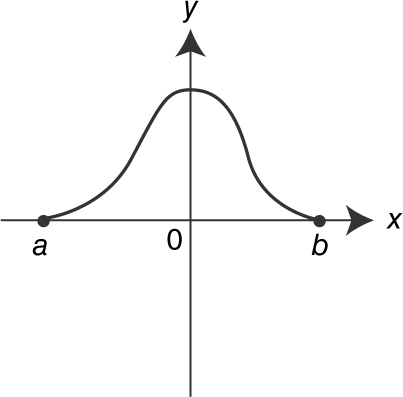
(B) 
(C) 
(D) 
19 . The graphs of f ′, g ′, p ′, and q ′ are shown below. Which of the functions f, g, p , or q have a point of inflection on (a , b )?

Chapter 9
20 . When the area of a square is increasing four times as fast as the diagonals, what is the length of a side of the square?
21 . If g (x ) = |x 2 – 4x – 12|, which of the following statements about g is/are true?
I. g has a relative maximum at x = 2.
II. g is differentiable at x = 6.
III. g has a point of inflection at x = –2.
Chapter 10
22 . Given the equation  , what is an equation of the normal line to the graph at x = 5?
, what is an equation of the normal line to the graph at x = 5?
23 . What is the slope of the tangent to the curve y = cos(xy ) at x = 0?
24 . The velocity function of a moving particle on the x -axis is given as v (t ) = t 2 – t . For what values of t is the particle’s speed decreasing?
25 . The velocity function of a moving particle is  for 0 ≤ t ≤ 6. What is the maximum acceleration of the particle on the interval 0 ≤ t ≤ 6?
for 0 ≤ t ≤ 6. What is the maximum acceleration of the particle on the interval 0 ≤ t ≤ 6?
26 . Write an equation of the normal line to the graph of f (x ) = x 3 for x ≥ 0 at the point where f ′(x ) = 12.
27 . At what value(s) of x do the graphs of  and y = –x 2 have perpendicular tangent lines?
and y = –x 2 have perpendicular tangent lines?
28 . Given a differentiable function f with  and
and  . Using a tangent line to the graph at
. Using a tangent line to the graph at  , find an approximate value of
, find an approximate value of  .
.
Chapter 11
29 . Evaluate  .
.
30 . If f (x ) is an antiderivative of  and f (0) = ln (2), find f (ln 2).
and f (0) = ln (2), find f (ln 2).
31 . Find the volume of the solid generated by revolving about the x -axis on the region bounded by the graph of y = sin 2x for 0 ≤ x ≤ π and the line  .
.
Chapter 12
32 . Evaluate  .
.
33 . If  , find k .
, find k .
34 . If  , find h ′(π ).
, find h ′(π ).
35 . If f ′(x ) = g (x ) and g is a continuous function for all real values of x , then  is
is
(A) 
(B) f (2) – f (0).
(C) f (6) – f (0).
(D) 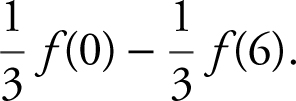
36 . Evaluate  .
.
37 . If a function f is continuous for all values of x , which of the following statements is/are always true?
I. 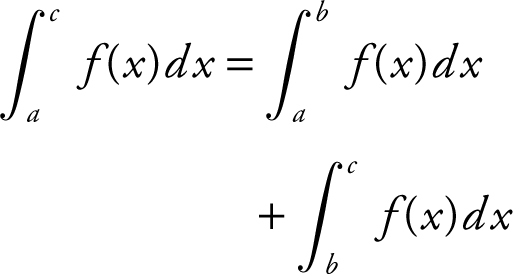
II. 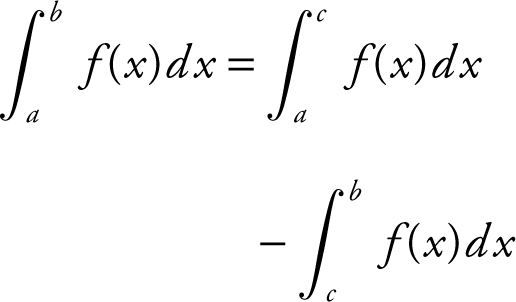
III. 
38 . If  , find the value(s) of x where g has a local minimum.
, find the value(s) of x where g has a local minimum.
Chapter 13
39 . The graph of the velocity function of a moving particle is shown in the following figure. What is the total distance traveled by the particle during 0 ≤ t ≤ 6?

40 . The graph of f consists of four line segments, for –1 ≤ x ≤ 5 as shown in the figure below. What is the value of 

41 . Find the area of the region enclosed by the graph of y = x 2 – x and the x -axis.
42 . If  for all real values of k , then which of the graphs shown on the next page could be the graph of f ?
for all real values of k , then which of the graphs shown on the next page could be the graph of f ?
43 . The area under the curve  from x = 1 to x = k is 8. Find the value of k .
from x = 1 to x = k is 8. Find the value of k .
44 . For 0 ≤ x ≤ 3π , find the area of the region bounded by the graphs of y = sin x and y = cos x .
45 . Let f be a continuous function on [0, 6] that has selected values as shown below:

Using three midpoint rectangles of equal widths, find an approximate value of 
(A) 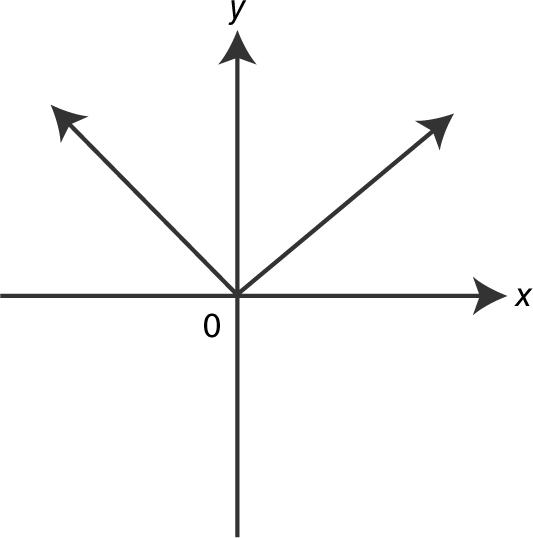
(B) 
(C) 
(D) 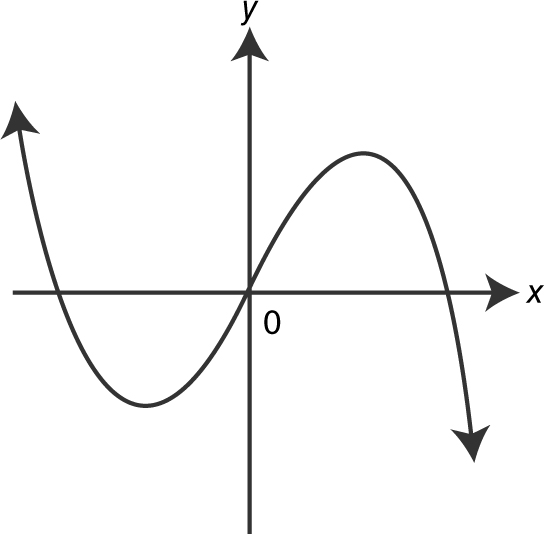
Chapter 14
46 . What is the average value of the function y = e -4x on [–ln 2, ln 2]?
47 . If 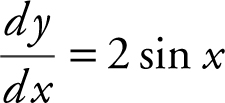 and at x = π , y = 2, find a solution to the differential equation.
and at x = π , y = 2, find a solution to the differential equation.
48 . Water is leaking from a tank at the rate of f (t )=10 ln(t +1) gallons per hour for 0 ≤ t ≤ 10, where t is measured in hours. How many gallons of water have leaked from the tank after 5 hours?
49 . Carbon-14 has a half-life of 5730 years. If y is the amount of Carbon-14 present and y decays according to the equation  , where k is a constant and t is measured in years, find the value of k .
, where k is a constant and t is measured in years, find the value of k .
50 . What is the volume of the solid whose base is the region enclosed by the graphs of y = x 2 and y = x + 2 and whose cross sections perpendicular to the x -axis are squares?
3.3 Answers to Diagnostic Test
1 . 
2 . (– ∞, 1) ∪ (3, ∞)
3 . 6 + h
4 . x = e 2
5 . 0
6 . A
7 . –1/2
8 . Does not exist.
9 . 2
10 . 
11 . 16
12 . 2
13 . See the graph in Question 15 in the Solutions to Diagnostic Test.
14 . II & III
15 . C
16 . x < x 2
17 . 8
18 . A
19 . q
20 . 
21 . I
22 . y = –4x + 22
23 . 0
24 . 
25 . 12
26 . 
27 . 1.370
28 . 2.983
29 . 
30 . ln 3
31 . 1.503
32 . 2
33 . {–2, 5}
34 . 0
35 . A
36 . 
37 . I & III
38 . 2π
39 . 50 feet
40 . 2
41 . 
42 . D
43 . 132/3
44 . 5.657
45 . 76
46 . 
47 . y = –2 cos x
48 . 57.506
49 . 
50 . 
3.4 Solutions to Diagnostic Test
Chapter 5
1 . Write 5x – 2y = 10 in slope-intercept form y = mx + b and obtain  . The slope of the line
. The slope of the line  is
is  . Therefore the slope of the line perpendicular to
. Therefore the slope of the line perpendicular to  is –
is – . Since the line perpendicular to
. Since the line perpendicular to  also passes through the origin, its y -intercept is 0 and its equation is
also passes through the origin, its y -intercept is 0 and its equation is  .
.
2 . Using your calculator, set y 1 = 3|2x – 4| and y 2 = 6. Examine the figure below and note that 3|2x – 4| > 6 when x < 1 or x > 3.
Thus the solution in interval notation is (– ∞,1) ∪ (3, ∞).

3 . Since f (x ) = x 2 + 1, f (3) = 10 and f (3 + h ) = (3 + h )2 + 1 = 9 + 6h + h 2 + 1 = 10 + 6h + h 2 .
The quotient 

4 . Simplify the equation 4ln x – 2 = 6 and obtain ln x = 2. (Note that e x and ln x are inverse functions.) Thus, e ln x = e 2 or x = e 2 .
5 . Since g (x ) = 2x – 2, g (2) = 2(2) – 2 = 2.
Therefore f (g (2)) = f (2). Also f (x ) = x 3 – 8.
Thus f (2) = 23 – 8 = 0.
Chapter 6
6 . See the figure below.
If b = 2, then x = –1 would be a solution for f (x ) = 2.
If b = 1, 0, or – 2, f (x ) = 2 would have two solutions.
Thus, b = 3, choice (A).

7 . 
8 .  does not exist.
does not exist.
9 . 
Chapter 7
10 . By L’Hôpital’s Rule, 
 .
.
11 . 
12 . 
Chapter 8
13 . See the graph shown in Question 15.
14 . I. Since the graph of g is decreasing and then increasing, it is not monotonic.
II. Since the graph of g is
a smooth curve, g ′ is continuous.
III. Since the graph of g is
concave upward, g ″ > 0.
Thus, only statements II and III are true.
15 . The graph indicates that (1) f (10) = 0, (2) f ′(10) < 0, since f is decreasing; and (3) f ″(10) > 0, since f is concave upward.
Thus, f ′(10) < f (10) < f ″(10), choice (C).
Based on the graph of f :
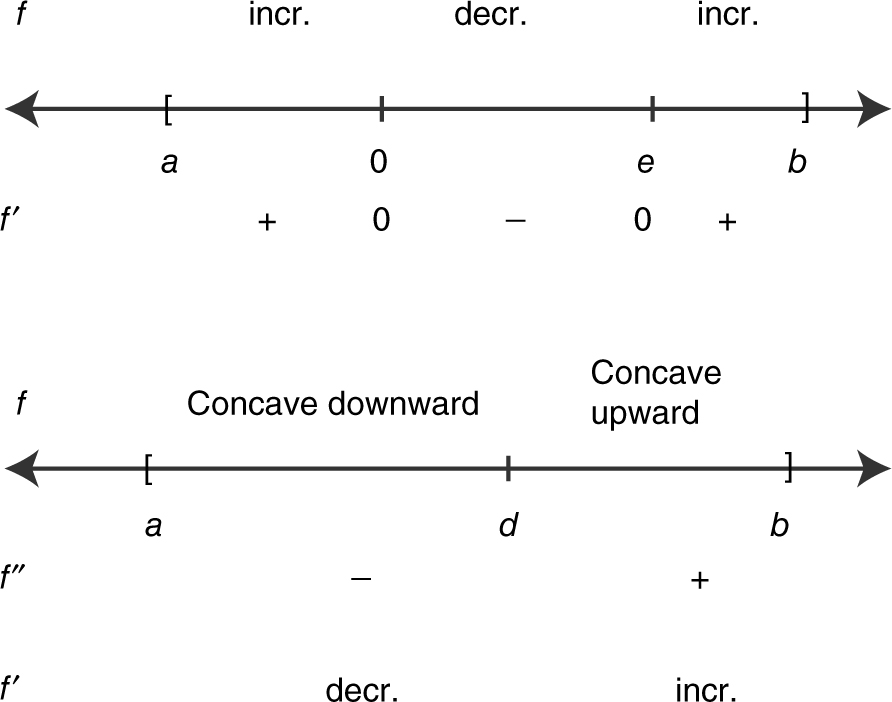
A possible graph of f ′

16 . See the figure below.
The graph of f is concave upward for x < x 2 .

17 . See the figure below.
Enter y 1 = sin(x 2 ). Using the [Inflection ] function of your calculator, you obtain four points of inflection on [0, π ]. The points of inflection occur at x = 0.81, 1.81, 2.52, and 3.07. Since y 1 = sin (x 2 ) is an even function, there is a total of eight points of inflection on [–π , π ]. An alternate solution is to enter  . The graph of y 2 crosses the x -axis eight times, thus eight zeros on [–π , π ].
. The graph of y 2 crosses the x -axis eight times, thus eight zeros on [–π , π ].

18 . Since  .
.
See the figure below.
The only graph that satisfies the behavior of g is choice (A).

19 . See the figure below.
A change of concavity occurs at x = 0 for q .
Thus, q has a point of inflection at x = 0.
None of the other functions has a point of inflection.

Chapter 9
20 . Let z be the diagonal of a square. Area of a square 

Since  .
.
Let s be a side of the square. Since the diagonal z = 4, s 2 + s 2 = z 2 or 2s 2 = 16. Thus, s 2 = 8 or  .
.
21 . See the figure below.
The graph of g indicates that a relative maximum occurs at x = 2; g is not differentiable at x = 6, since there is a cusp at x = 6, and g does not have a point of inflection at x = –2, since there is no tangent line at x = –2. Thus, only statement I is true.

Chapter 10
22 . 
Slope of normal line = negative reciprocal of  .
.
Equation of normal line:

23 . 

Thus, the slope of the tangent at x = 0 is 0.
24 . See the figure below.

Since v (t ) < 0 and a (t ) > 0 on  , the speed of the particle is decreasing on
, the speed of the particle is decreasing on  .
.

25 . 
a (t ) = v ′(t ) = t 2 – 4t
See the figure below.
The graph indicates that the maximum acceleration occurs at the endpoint t = 6. a (t ) = t 2 – 4t and a (6) = 62 – 4(6) = 12.

26 . 
Slope of normal = negative reciprocal of slope of tangent = –  .
.

27 . 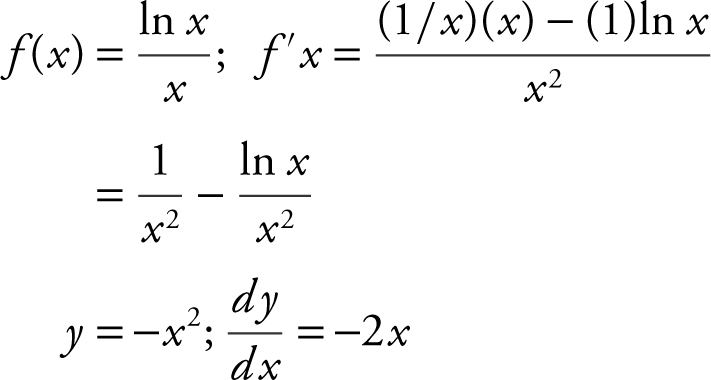
Perpendicular tangents

Using the [Solve ] function on your calculator, you obtain x ≈ 1.37015 ≈ 1.370.
28 .  is on the graph.
is on the graph.
 slope of the tangent at
slope of the tangent at  is –1.
is –1.
Equation of tangent line: y – 3 =

Chapter 11
29 . 

You can check the answer by differentiating your result.
30 . Let u = ex + 1; du = ex dx .


31 . See the figure below.
To find the points of intersection, set

Volume of solid

Using your calculator, you obtain: Volume of solid ≈ (0.478306)π ≈ 1.50264 ≈ 1.503.

Chapter 12
32 . 
33 . 

You can check your answer by evaluating  and
and  .
.
34 . 
35 . Let u = 3x ; du = 3dx or  .
.

Thus, the correct choice is (A).
36 . 
37 . I. 
The statement is true, since the upper and lower limits of the integrals are in sequence, i.e., a → c = a → b → c .
II. 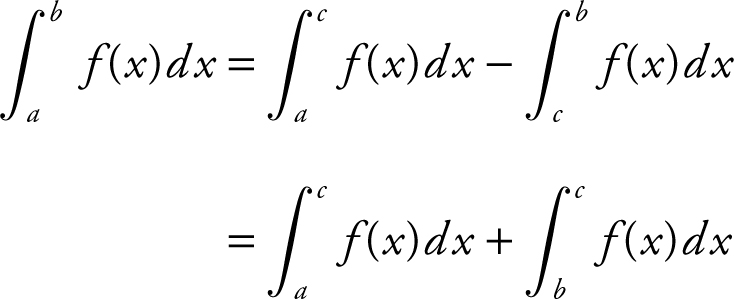
The statement is not always true.
III. 
The statement is true.
Thus, only statements I and III are true.
38 . Since  sin t dt , then g ′(x ) = 2 sin x .
sin t dt , then g ′(x ) = 2 sin x .
Set g ′(x ) = 0 ⇒ 2 sin x = 0 ⇒ x = π or 2π g″ (x ) = 2 cos x and g″ (π ) = 2 cos π = –2 and g″ (2π ) = 1.
Thus g has a local minimum at x = 2π . You can also approach the problem geometrically by looking at the area under the curve. See the figure below.

Chapter 13
39 . 
40 . 
41 . To find points of intersection, set y = x 2 – x = 0
⇒ x (x – 1) = 0 ⇒ x = 0 or x = 1.
See the figure below.


42 .  is an odd function, i.e., f (x ) = –f (–x ). Thus the graph in choice (D) is the only odd function.
is an odd function, i.e., f (x ) = –f (–x ). Thus the graph in choice (D) is the only odd function.
43 . 
44 . See the figure below.

Using the [Intersection ] function of the calculator, you obtain the intersection points at x = 0.785398, 3.92699, and 7.06858.
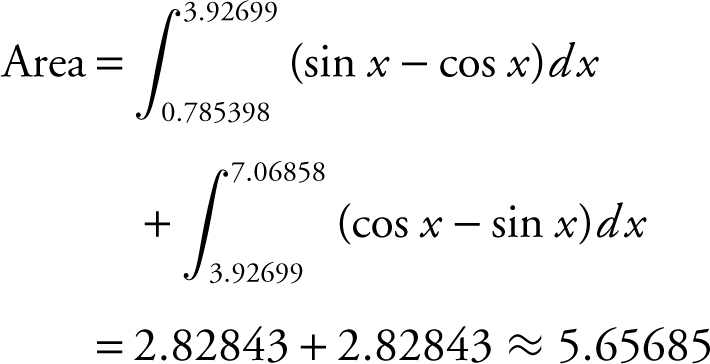
You can also find the area by:

45 . Width of a rectangle =  .
.
Midpoints are x = 1, 3, and 5 and f (1) = 2, f (3) = 10, and f (5) = 26.

Chapter 14
46 . 
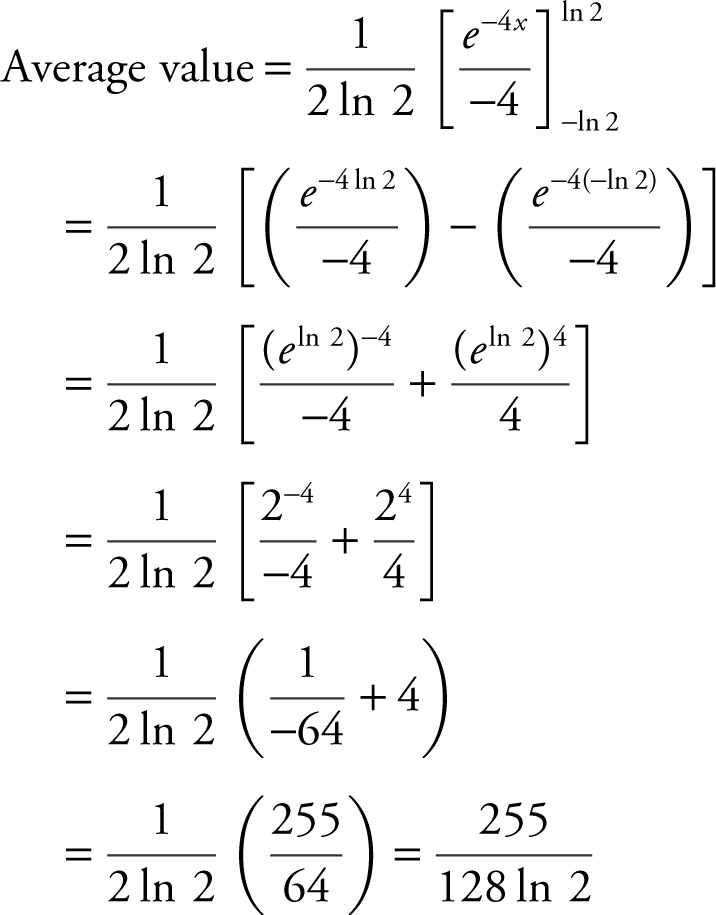
47 . 
48 . Amount of water leaked

Using your calculator, you obtain 10(6 ln 6–5) which is approximately 57.506 gallons.
49 . 
50 . See the figure below.

To find points of intersection, set x 2 = x + 2 ⇒ x 2 – x – 2 = 0 ⇒ x = 2 or x =–1.
Area of cross section = ((x + 2) – x 2 )2 .
Volume of solid,  .
.
Using your calculator, you obtain:  .
.
3.5 Calculate Your Score
Short-Answer Questions
Questions 1–50 for AP Calculus AB

AP Calculus AB Diagnostic Test

STEP 3
Develop Strategies for Success
CHAPTER 4 How to Approach Each Question Type
CHAPTER 4
How to Approach Each Question Type
IN THIS CHAPTER
Summary: Knowing and applying question-answering strategies helps you succeed on tests. This chapter provides you with many test-taking tips to help you earn a 5 on the AP Calculus exam.

Key Ideas
 Read each question carefully.
Read each question carefully.
 Do not linger on a question. Time yourself accordingly.
Do not linger on a question. Time yourself accordingly.
 For multiple-choice questions, sometimes it is easier to work backward by trying each of the given choices. You will be able to eliminate some of the choices quickly.
For multiple-choice questions, sometimes it is easier to work backward by trying each of the given choices. You will be able to eliminate some of the choices quickly.
 For free-response questions, always show sufficient work so that your line of reasoning is clear.
For free-response questions, always show sufficient work so that your line of reasoning is clear.
 Write legibly.
Write legibly.
 Always use calculus notations instead of calculator syntax.
Always use calculus notations instead of calculator syntax.
 If the question involves decimals, round your final answer to 3 decimal places unless the question indicates otherwise.
If the question involves decimals, round your final answer to 3 decimal places unless the question indicates otherwise.
 Trust your instincts. Your first approach to solving a problem is usually the correct one.
Trust your instincts. Your first approach to solving a problem is usually the correct one.
 Get a good night’s sleep the night before.
Get a good night’s sleep the night before.
4.1 The Multiple-Choice Questions
• There are 45 multiple-choice questions for the AP Calculus AB exam. These questions are divided into Section I–Part A, which consists of 30 questions for which the use of a calculator is not permitted; and Section I–Part B with 15 questions, for which the use of a graphing calculator is allowed. The multiple-choice questions account for 50% of the grade for the whole test.
• Do the easy questions first because all multiple-choice questions are worth the same amount of credit. You have 60 minutes for the 30 questions in Section I–Part A and 45 minutes for the 15 questions in Section I–Part B. Do not linger on any one question. Time yourself accordingly.
• There is no partial credit for multiple-choice questions, and you do not need to show work to receive credit for the correct answer.

• Read the question carefully. If there is a graph or a chart, look at it carefully. For example, be sure to know if the given graph is that of f (x ) or f ′(x ). Pay attention to the scale of the x and y axes, and the unit of measurement.
• Never leave a question blank since there is no penalty for incorrect answers.

• If a question involves finding the derivative of a function, you must first find the derivative, and then see if you need to do additional work to get the final answer to the question. For example, if a question asks for an equation of the tangent line to a curve at a given point, you must first find the derivative, evaluate it at the given point (which gives you the slope of the line), and then proceed to find an equation of the tangent line. For some questions, finding the derivative of a given function (or sometimes, the antiderivative), is only the first step to solving the problem. It is not the final answer to the question. You might need to do more work to get the final answer.

• Sometimes, it is easier to work backward by trying each of the given choices as the final answer. Often, you will be able to eliminate some of the given choices quickly.
• If a question involves decimal numbers, do not round until the final answer, and at that point, the final answer is usually rounded to 3 decimal places. Look at the number of decimal places of the answers in the given choices.
• Trust your instincts. Usually your first approach to solving a problem is the correct one.
4.2 The Free-Response Questions
• There are 6 free-response questions in Section II: Part A consisting of 2 questions which allow the use of a calculator, and Part B with 4 questions which do not permit the use of a calculator. The 6 free-response questions account for 50% of the grade for the whole test.
• Read, Read, Read. Read the question carefully. Know what information is given, what quantity is being sought, and what additional information you need to find in order to answer the question.

• Always show a sufficient amount of work so that your line of reasoning is clear. This is particularly important in determining partial credit. In general, use complete sentences to explain your reasoning. Include all graphs, charts, relevant procedures, and theorems. Clearly indicate all the important steps that you have taken in solving the problem. A correct answer with insufficient work will receive minimal credit.
• When appropriate, represent the given information in calculus notations. For example, if it is given that the volume of a cone is decreasing at 2 cm3 per second, write  –2 cm3 /sec. Similarly, represent the quantity being sought in calculus notations. For example, if the question asks for the rate of change of the radius of the cone at 5 seconds, write “Find
–2 cm3 /sec. Similarly, represent the quantity being sought in calculus notations. For example, if the question asks for the rate of change of the radius of the cone at 5 seconds, write “Find  at t = 5 sec.”
at t = 5 sec.”

• Do not forget to answer the question. Free-response questions tend to involve many computations. It is easy to forget to indicate the final answer. As a habit, always state the final answer as the last step in your solution, and if appropriate, include the unit of measurement in your final answer. For example, if a question asks for the area of a region, you may want to conclude your solution by stating that “The area of the region is 20 square units.”
• Do the easy questions first. Each of the 6 free-response questions is worth the same amount of credit. There is no penalty for an incorrect solution.
• Pay attention to the scales of the x and y axes, the unit of measurement, and the labeling of given charts and graphs. For example, be sure to know whether a given graph is that of f (x ) or f ′(x ).
• When finding relative extrema or points of inflection, you must show the behavior of the function that leads to your conclusion. Simply showing a sign chart is not sufficient.

• Often a question has several parts. Sometimes, in order to answer a question in one part of the question, you might need the answer to an earlier part of the question. For example, to answer the question in part (b), you might need the answer in part (a). If you are not sure how to answer part (a), make an educated guess for the best possible answer and then use this answer to solve the problem in part (b). If your solution in part (b) uses the correct approach but your final answer is incorrect, you could still receive full or almost full credit for your work.
• As with solving multiple-choice questions, trust your instincts. Your first approach to solving a problem is usually the correct one.
4.3 Using a Graphing Calculator
• The use of a graphing calculator is permitted in Section I–Part B multiple-choice questions and in Section II–Part A free-response questions.
• You are permitted to use the following 4 built-in capabilities of your graphing calculator to obtain an answer:
1. plotting the graph of a function
2. finding the zeros of a function
3. calculating numerically the derivative of a function
4. calculating numerically the value of a definite integral
For example, if you have to find the area of a region, you need to show a definite integral. You may then proceed to use the calculator to produce the numerical value of the definite integral without showing any supporting work. All other capabilities of your calculator can only be used to check your answer. For example, you may not use the built-in [Inflection ] function of your calculator to find points of inflection. You must use calculus showing derivatives and indicating a change of concavity.
• You may not use calculator syntax to substitute for calculus notations. For example, you may not write “Volume =  ”; instead you need to write “Volume =
”; instead you need to write “Volume =  .”
.”
• When using a graphing calculator to solve a problem, you are required to write the setup that leads to the answer. For example, if you are finding the volume of a solid, you must write the definite integral and then use the calculator to compute the numerical value, e.g., Volume =  . Simply indicating the answer without writing the integral is considered an incomplete solution, for which you would receive minimal credit (possibly 1 point) instead of full credit for a complete solution.
. Simply indicating the answer without writing the integral is considered an incomplete solution, for which you would receive minimal credit (possibly 1 point) instead of full credit for a complete solution.
• Set your calculator to radian mode, and change to degree mode only if necessary.
• If you are using a TI-89 graphing calculator, clear all previous entries for variables a through z before the AP Calculus exam.
• You are permitted to store computer programs in your calculator and use them in the AP Calculus exam. Your calculator memories will not be cleared.
• Using the [Trace ] function to find points on a graph may not produce the required accuracy. Most graphing calculators have other built-in functions that can produce more accurate results. For example, to find the x -intercepts of a graph, use the [Zero ] function, and to find the intersection point of two curves, use the [Intersection ] function.
• When decimal numbers are involved, do not round until the final answer. Unless otherwise stated, your final answer should be accurate to three places after the decimal point.
• You may bring up to two calculators to the AP Calculus exam.
• Replace old batteries with new ones and make sure that the calculator is functioning properly before the exam.
4.4 Taking the Exam
What Do I Need to Bring to the Exam?
• Several Number 2 pencils.
• A good eraser and a pencil sharpener.
• Two black or blue pens.
• One or two approved graphing calculators with fresh batteries. (Be careful when you change batteries so that you don’t lose your programs.)
• A watch.
• An admissions card or a photo I.D. card if your school or the test site requires it.
• Your Social Security number.
• Your school code number if the test site is not at your school.
• A simple snack if the test site permits it . (Don’t eat anything you haven’t eaten before. You might have an allergic reaction.)
• A light jacket if you know that the test site has strong air conditioning.
• Do not bring Wite Out or scrap paper.
Tips for Taking the Exam

General Tips
• Write legibly.
• Label all diagrams.
• Organize your solution so that the reader can follow your line of reasoning.
• Use complete sentences whenever possible. Always indicate what the final answer is.

More Tips
• Do easy questions first.
• Write out formulas and indicate all major steps.
• Never leave a question blank, especially a multiple-choice question, since there is no penalty for incorrect answers.
• Be careful to bubble in the right grid, especially if you skip a question.
• Move on. Don’t linger on a problem too long. Make an educated guess.
• Go with your first instinct if you are unsure.

Still More Tips
• Indicate units of measure.
• Simplify numeric or algebraic expressions only if the question asks you to do so.
• Carry all decimal places and round only at the end.
• Round to 3 decimal places unless the question indicates otherwise.
• Watch out for different units of measure, e.g., the radius, r , is 2 feet, find  in inches per second.
in inches per second.
• Use calculus notations and not calculator syntax, e.g., write ∫ x 2 dx and not ∫ (x ^2, x ).
• Use only the four specified capabilities of your calculator to get your answer: plotting graphs, finding zeros, calculating numerical derivatives, and evaluating definite integrals. All other built-in capabilities can only be used to check your solution.
• Answer all parts of a question from Section II even if you think your answer to an earlier part of the question might not be correct.

Enough Already … Just 3 More Tips
• Be familiar with the instructions for the different parts of the exam. Review the practice exams in the back of this book.
• Get a good night’s sleep the night before.
• Have a light breakfast before the exam.
STEP 4
Review the Knowledge You Need to Score High
CHAPTER 5 Review of Precalculus
BIG IDEA 1: Limits
CHAPTER 6 Limits and Continuity
BIG IDEA 2: Derivatives
CHAPTER 7 Differentiation
CHAPTER 8 Graphs of Functions and Derivatives
CHAPTER 9 Applications of Derivatives
BIG IDEA 3: Integrals and the Fundamental Theorem of Calculus
CHAPTER 10 More Applications of Derivatives
CHAPTER 11 Integration
CHAPTER 12 Definite Integrals
CHAPTER 13 Areas and Volumes
CHAPTER 14 More Applications of Definite Integrals
CHAPTER 5
Review of Precalculus
IN THIS CHAPTER
Summary: Many questions on the AP Calculus exam require the application of precalculus concepts. In this chapter, you will be guided through a summary of these precalculus concepts including the properties of lines, inequalities, and absolute values, and the behavior of functions and inverse functions. It is important that you review this chapter thoroughly. Your ability to solve the problems here is a prerequisite to doing well on the AP Calculus AB exam.

Key Ideas
 Writing an equation of a line
Writing an equation of a line
 Solving inequalities
Solving inequalities
 Working with functions and inverse functions
Working with functions and inverse functions
 Properties of trigonometric and inverse trigonometric functions
Properties of trigonometric and inverse trigonometric functions
 Properties of exponential and logarithmic functions
Properties of exponential and logarithmic functions
 Properties of odd and even functions
Properties of odd and even functions
 Behaviors of increasing and decreasing functions
Behaviors of increasing and decreasing functions
5.1 Lines
Main Concepts: Slope of a Line, Equations of a Line, Parallel and Perpendicular Lines
Slope of a Line
Given two points A (x 1 , y 1 ) and B (x 2 , y 2 ), the slope of the line passing through the two given points is defined as

Note that if (x 2 – x 1 ) = 0, then x 2 = x 1 , which implies that points A and B are on a vertical line parallel to the y -axis, and thus, the slope is undefined .
Example 1
Find the slope of the line passing through the points (3, 2) and (5, –4).
Using the definition  , the slope of the line is
, the slope of the line is  .
.
Example 2
Find the slope of the line passing through the points (–5, 3) and (2, 3).
The slope  . This implies that the points (–5, 3) and (2, 3) are on a horizontal line parallel to the x -axis.
. This implies that the points (–5, 3) and (2, 3) are on a horizontal line parallel to the x -axis.
Example 3
Figure 5.1-1 is a summary of four different orientations of lines and their slopes:

Figure 5.1-1
Equations of a Line
y = mx + b Slope-intercept form of a line where m is its slope and b is the y -intercept.
y – y∞ = m ⇐ x – x ∞ ⇒ Point-slope form of a line where m is the slope and (x 1 , y 1 ) is a point on the line.
Ax + By + C = ′ General form of a line where A , B , and C are constants and A and B are not both equal to 0.
Example 1
Write an equation of the line through the points (–2, 1) and (3, –9).
The slope of line passing through (–2, 1) and (3, –9) is  . Using the point-slope form and the point (–2, 1),
. Using the point-slope form and the point (–2, 1),

An equation of the line is y = –2x – 3.
Example 2
An equation of a line l is 2x + 3y = 12. Find the slope, the x -intercept, and the y -intercept of line l .
Begin by expressing the equation 2x + 3y = 12 in slope-intercept form .

Therefore, m , the slope of line l , is  and b , the y -intercept, is 4. To find the x -intercept, set y = 0 in the original equation 2x + 3y = 12. Thus, 2x + 0 = 12 and x = 6. The x -intercept of line l is 6.
and b , the y -intercept, is 4. To find the x -intercept, set y = 0 in the original equation 2x + 3y = 12. Thus, 2x + 0 = 12 and x = 6. The x -intercept of line l is 6.
Example 3
Equations of vertical and horizontal lines involve only a single variable. Figure 5.1-2 shows several examples:

Figure 5.1-2
Parallel and Perpendicular Lines
Given two nonvertical lines l 1 and l 2 with slopes m 1 and m 2 , as shown in Figure 5.1-3 , respectively, they are parallel if and only if m 1 = m 2 .

Figure 5.1-3
Lines l 1 and l 2 are perpendicular if and only if m 1 m 2 = –1. (See Figure 5.1-4 .)

Figure 5.1-4
Example 1
Write an equation of the line through the point (–1, 3) and parallel to the line 3x – 2y = 6. (See Figure 5.1-5 .)

Figure 5.1-5
Begin by expressing 3x – 2y = 6 in slope-intercept form.

Therefore, the slope of the line 3x – 2y = 6 is  , and the slope of the line parallel to the line 3x – 2y = 6 is also
, and the slope of the line parallel to the line 3x – 2y = 6 is also  . Since the line parallel to 3x – 2y = 6 passes through the point (–1, 3), you can use the point-slope form to obtain the equation
. Since the line parallel to 3x – 2y = 6 passes through the point (–1, 3), you can use the point-slope form to obtain the equation  or
or  .
.
Example 2
Write an equation of the perpendicular bisector of the line segment joining the points A (3, 0) and B (–1, 4). (See Figure 5.1-6 .)

Figure 5.1-6
Begin by finding the midpoint of  . Midpoint
. Midpoint  . The slope of
. The slope of  is
is  . Therefore, the perpendicular bisector of
. Therefore, the perpendicular bisector of  has a slope of 1. Since the perpendicular bisector of
has a slope of 1. Since the perpendicular bisector of  passes through the midpoint, you could use the point-slope form to obtain y – 2 = 1(x – 1) or y – 2 = x – 1 or y = x + 1.
passes through the midpoint, you could use the point-slope form to obtain y – 2 = 1(x – 1) or y – 2 = x – 1 or y = x + 1.
Example 3
Write an equation of the circle with center at C (–2, 1) and tangent to line l having the equation x + y = 5. (See Figure 5.1-7 .)

Figure 5.1-7
Let M be the point of tangency. Express the equation x + y = 5 in slope-intercept form to obtain y = –x + 5. Thus, the slope of line l is – 1. Since  is a radius drawn to the point of tangency, it is perpendicular to line l , and the slope of
is a radius drawn to the point of tangency, it is perpendicular to line l , and the slope of  is 1. Using the point-slope formula, the equation of
is 1. Using the point-slope formula, the equation of  is y – 1 = 1(x – (–2)) or y = x + 3. To find the coordinates of point M , solve the two equations y = –x + 5 and y = x + 3 simultaneously. Thus, –x + 5 = x + 3 which is equivalent to 2 = 2x or x = 1.
is y – 1 = 1(x – (–2)) or y = x + 3. To find the coordinates of point M , solve the two equations y = –x + 5 and y = x + 3 simultaneously. Thus, –x + 5 = x + 3 which is equivalent to 2 = 2x or x = 1.
Substituting x = 1 into y = x + 3, you have y = 4. Therefore, the coordinates of M are (1, 4). Since  is the radius of the circle, you should find the length of
is the radius of the circle, you should find the length of  by using the distance formula
by using the distance formula  . Thus,
. Thus,  . Now that you know both the radius of the circle
. Now that you know both the radius of the circle  and its center, (–2, 1), use the formula (x – h )2 + (y – k )2 = r 2 to find an equation of the circle. Thus, an equation of the circle is (x – (–2))2 + (y – 1)2 = 18 or (x + 2)2 + (y – 1)2 = 18.
and its center, (–2, 1), use the formula (x – h )2 + (y – k )2 = r 2 to find an equation of the circle. Thus, an equation of the circle is (x – (–2))2 + (y – 1)2 = 18 or (x + 2)2 + (y – 1)2 = 18.
5.2 Absolute Values and Inequalities
Main Concepts: Absolute Values, Inequalities and the Real Number Line, Solving Absolute Value Inequalities, Solving Polynomial Inequalities, and Solving Rational Inequalities
Absolute Values
Let a and b be real numbers.
1. 
2. |ab | = |a ||b |
3. |a – b | = |b – a |
4. 
Example 1
Solve for x : |3x – 12| = 18.
Depending on whether the value of (3x – 12) is positive or negative, the equation |3x – 12| = 18 could be written as 3x – 12 = 18 or 3x – 12 = –18. Solving both equations, you have x = 10 and x = –2. (Be sure to check both answers in the original equation. ) The solution set for x is {–2, 10}.
Example 2
Solve for x : |2x – 12| = |4x + 24|.
The given equation implies that either 2x – 12 = 4x + 24 or 2x – 12 = –(4x + 24). Solving both equations, you have x = –18 and x = –2. Checking x = –18 with the original equation: |2(–18) – 12| = |4(–18) + 24| or |–36 – 12| = | – 72 + 24| or | – 48| = | – 48|. Checking x = –2 with the original equation, you have |– 16| = |16|. Thus, the solution set for x is {18, –2}.
Example 3
Solve for x : |11 – 3x | = 1 – x .
Depending on the value of (11 – 3x )—whether it is greater than or less than 0—the given equation could be written as 11 – 3x = 1 – x or 11 – 3x = –(1 – x ). Solving both equations, you have x = 5 and x = 3. Checking x = 5 with the original equation yields |11 – 3(5)| = 1 – 5 or | – 4| = –4, which is not possible. Checking x = 3 with the original equation shows that |11 – 3(3)| = 1 – 3 or | – 2| =–2 which is also not possible. Thus, the solution for x is the empty set { }. You could also solve the equation by using a graphing calculator.
Enter y 1 = |11 – 3x | and y 2 = 1 – x . The two graphs do not intersect, thus there is no common solution. (See Figure 5.2-1 .)

Figure 5.2-1
Inequalities and the Real Number Line
Properties of Inequalities
Let a , b , c , d , and k be real numbers:
1. If a < b and b < c , then a < c . For example, –7 < 2 and 2 < 5 ⇒ –7 < 5.
2. If a < b and c < d , then a + c < b + d . For example, 5 < 7 and 3 < 6 ⇒ 5 + 3 < 7 + 6.
3. If a < b and k > 0, then ak < bk . For example, 3 < 5 and 2 > 0 ⇒ 3(2) < 5(2).
4. If a < b and k < 0, then ak > bk . For example, 3 < 5 and –2 < 0 ⇒ 3(–2) > 5(–2).
Example 1
Solve the inequality 6 – 2x ≤ 18 and sketch the solution on the real number line.
Solving the inequality 6 – 2x ≤ 18 gives

Therefore, the solution set is the interval [–6, ∞) or, by expressing the solution set in set notation, {x |x ≥ –6}.
Example 2
Solve the double inequality –15 ≤ 3x + 6 < 9 and sketch the solution on the real number line.
Solving the double inequality –15 ≤ 3x + 6 < 9 gives

Therefore, the solution set is the interval [–7, 1) or, by expressing the solution in set notation: {x | – 7 ≤ x < 1}.
Example 3
Here is a summary of the different types of intervals on a number line:
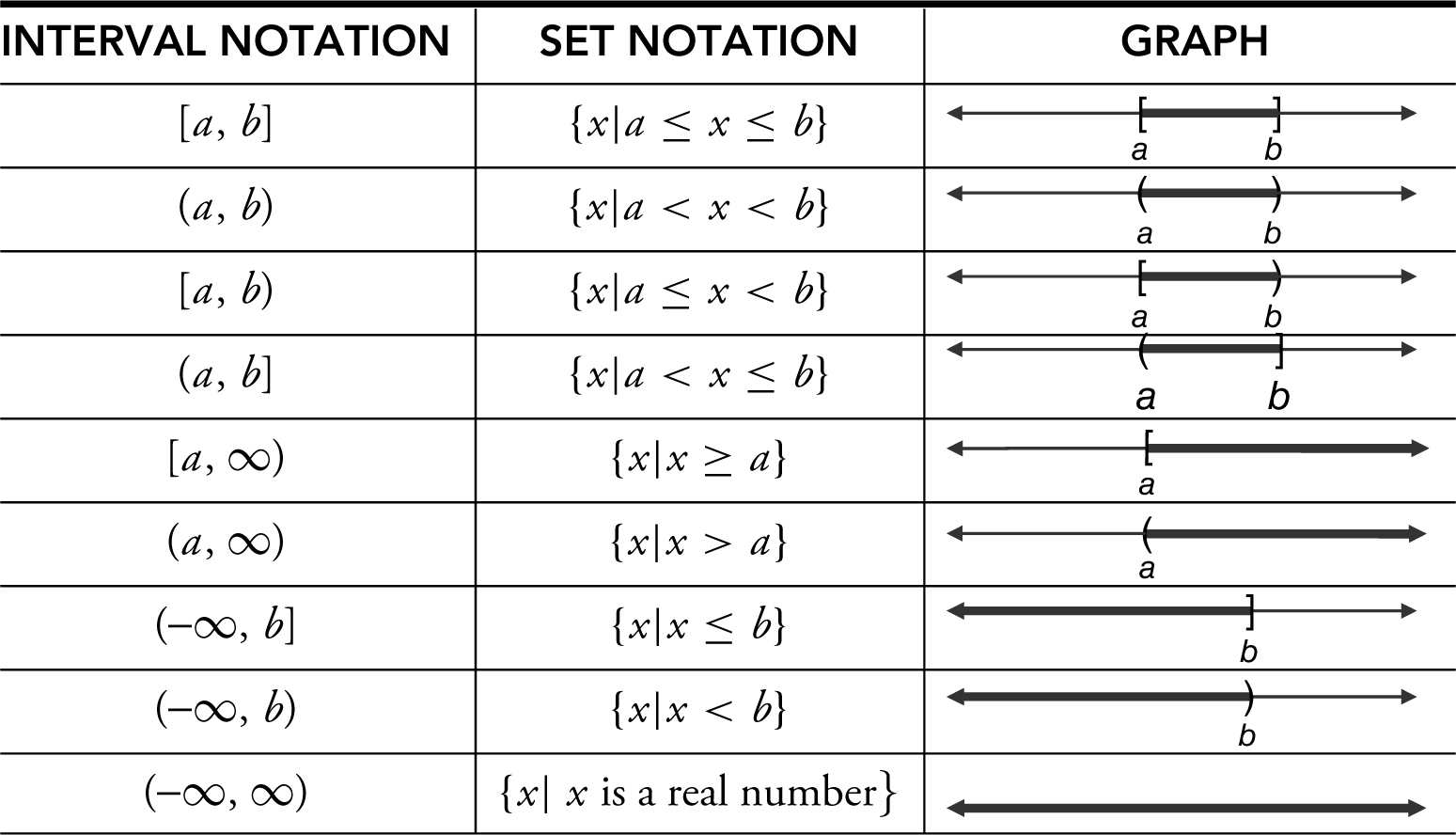
Solving Absolute Value Inequalities
Let a be a real number such that a ≥ 0.
|x | ≥ a ⇔ (x ≥ a or x ≤ – a ) and | x | > a ⇔ (x > a or x < a )
|x ≤ a ⇔ ( – a ≤ x ≤ a ) and | x | < a ⇔ ( – a < x < a )
Example 1
Solve the inequality |3x – 6| ≤ 15 and sketch the solution on the real number line.
The given inequality is equivalent to

Therefore, the solution set is the interval [–3, 7] or, in set notation, {x | – 3 ≤ x ≤ 7}.
Example 2
Solve the inequality |2x + 1| > 9 and sketch the solution on the real number line.
The inequality |2x + 1| > 9 implies that

Solving the two inequalities in the above line, you have x > 4 or x < –5. Therefore, the solution set is the union of the two disjoint intervals (x > 4) ∪ (x < –5) or, by writing the solution in set notation, {x |(x > 4) or (x < –5)}.
Example 3
Solve the inequality |1 – 2x | ≤ 7 and sketch the solution on the real number line.
The inequality |1 – 2x | ≤ 7 implies that

Therefore, the solution set is the interval [–3, 4] or, by writing the solution in set notation, {x | – 3 ≤ x ≤ 4}. (See Figure 5.2-2 .)

Figure 5.2-2
Note : You can solve an absolute value inequality by using a graphing calculator. For instance, in Example 3, enter y 1 = |1 – 2x | and y 2 = 7. The graphs intersect at x = –3 and 4, and y 1 is below y 2 on the interval (–3, 4). Since the inequality is ≤, the solution set is [–3, 4].
Solving Polynomial Inequalities
1. Write the given inequality in standard form with the polynomial on the left and zero on the right.
2. Factor the polynomial, if possible.
3. Find all zeros of the polynomials.
4. Using the zeros on a number line, determine the test intervals.
5. Select an x -value from each interval and substitute it in the polynomial.
6. Check the endpoints of each interval with the inequality.
7. Write the solution to the inequality.
Example 1
Solve the inequality x 2 – 3x ≥ 4.
1. Write in standard form: x 2 – 3x – 4 ≥ 0
2. Factor the polynomial: (x – 4)(x + 1)
3. Find zeros: (x – 4)(x + 1) = 0 implies that x = 4 and x = –1.
4. Determine intervals:

5. Select an x -value in each interval and evaluate the polynomial at that value:

Therefore the intervals (–∞, –1) and (4, ∞) make (x – 4)(x + 1) > 0.
6. Check endpoints: Since the inequality x 2 – 3x – 4 ≥ 0 is greater than or equal to 0, both endpoints x = –1 and x = 4 are included in the solution.
7. Write the solution: The solution is (–∞, –1] ∪ [4, ∞). (See Figure 5.2-3 .)

Figure 5.2-3
Note : The inequality x 2 – 3x ≥ 4 could have been solved by using a graphing calculator. Enter y 1 = x 2 – 3x and y 2 = 4. The graph of y 1 is above y 2 on (–∞, –1) and (4, ∞). Since the inequality is ≥, the solution set is (–∞, –1] and [4, ∞).
Example 2
Solve the inequality x 3 – 9x < 0, using a graphing calculator. (See Figure 5.2-4 .)

Figure 5.2-4
1. Enter y = x 3 – 8x into your graphing calculator.
2. Find the zeros of y : x = –3, 0, and 3.
3. Determine the intervals on which y < 0: (–∞, –3) and (0, 3).
4. Check whether the endpoints satisfy the inequality. Since the inequality is strictly less than 0, the endpoints are not included in the solution.
5. Write the solution to the inequality. The solution is (–∞, –3) ∪ (0, 3).
Example 3
Solve the inequality x 3 – 9x < 0 algebraically.
1. Write in standard form: x 3 – 9x < 0 is already in standard form.
2. Factor the polynomial: x (x – 3)(x + 3)
3. Find zeros: x (x – 3)(x + 3) = 0 implies that x = 0, x = 3, and x = –3.
4. Determine the intervals:

5. Select an x -value and evaluate the polynomial:

Therefore, the intervals (–∞, –3) and (0, 3) make x (x – 3)(x + 3) < 0.
6. Check the endpoints: Since the inequality x 3 – 9x < 0 is strictly less than 0, none of the endpoints x = –3, 0, and 3 are included in the solution.
7. Write the solution: The solution is (–∞, –3) ∪ (0, 3).
Solving Rational Inequalities
1. Rewrite the given inequality so that all the terms are on the left and only zero is on the right.
2. Find the least common denominator, and combine all the terms on the left into a single fraction .
3. Factor the numerator and the denominator, if possible.
4. Find all x -values for which the numerator or the denominator is zero.
5. Putting these x -values on a number line, determine the test intervals.
6. Select an x -value from each interval and substitute it in the fraction.
7. Check the endpoints of each interval with the inequality.
8. Write the solution to the inequality.
Example 1
Solve the inequality  .
.
1. Rewrite: 
2. Combine: 
3. Set the numerator and denominator equal to 0 and solve for x : x = 2 and 3.
4. Determine intervals:

5. Select an x -value and evaluate the fraction:

Therefore, the interval (2, 3) makes the fraction < 0.
6. Check the endpoints: At x = 3, the fraction is undefined. Thus the only endpoint is x = 2. Since the inequality is less than or equal to 0, x = 2 is included in the solution.
7. Write the solution: The solution is the interval [2, 3).
Example 2
Solve the inequality  by using a graphing calculator. (See Figure 5.2-5 .)
by using a graphing calculator. (See Figure 5.2-5 .)

Figure 5.2-5
1. Enter  and y 2 = 1.
and y 2 = 1.
2. Find the intersection points: x = 2. (Note that at x = 3, y 1 is undefined.)
3. Determine the intervals on which y 1 is below y 2 : The interval is (2, 3).
4. Check whether the endpoints satisfy the inequality. Since the inequality is less than or equal to 1, the endpoint at x = 2 is included in the solution.
5. Write the solution to the inequality. The solution is the interval [2, 3).
Example 3
Solve the inequality  by using a graphing calculator. (See Figure 5.2-6 .)
by using a graphing calculator. (See Figure 5.2-6 .)

Figure 5.2-6
1. Enter  and y 2 = x .
and y 2 = x .
2. Find the intersection points: x = –1 and x = 1. (Note that at x = 0, y 1 is undefined.)
3. Determine the intervals on which y 1 ≥ y 2 . The intervals are (–∞, –1) and (0, 1).
4. Check whether the endpoints satisfy the inequality: Since the inequality is greater than or equal to x , the endpoints at x = –1 and x = 1 are included in the solution.
5. Write the solution to the inequality. The solution is the interval (–∞, –1] ∪ (0, 1].
5.3 Functions
Main Concepts: Definition of a Function, Operations on Functions, Inverse Functions, Trigonometric and Inverse Trigonometric Functions, Exponential and Logarithmic Functions
Definition of a Function
A function f is a set of ordered pairs (x , y ) in which for every x coordinate there is one and only one corresponding y coordinate. We write f (x ) = y . The domain of f is the set of all possible values of x , and the range of f is the set of all values of y .
The Vertical Line Test
If all vertical lines pass through the graph of an equation at no more than one point, then the equation is a function.
Example 1
Given  , sketch the graph of the equation, determine if the equation is a function, and find the domain and range of the equation. (See Figure 5.3-1 .)
, sketch the graph of the equation, determine if the equation is a function, and find the domain and range of the equation. (See Figure 5.3-1 .)

Figure 5.3-1
Since the graph of  passes the vertical line test, the equation is a function. Let y = f (x ). The expression
passes the vertical line test, the equation is a function. Let y = f (x ). The expression  implies that 9 – x 2 ≥ 0. By inspection, note that –3 ≤ x ≤ 3. Thus the domain is [–3, 3]. Since f (x ) is defined for all values of x ∈ [–3, 3] and f (–3) = 0 is the minimum value and f (0) = 3 is the maximum value, the range of f (x ) is [0, 3].
implies that 9 – x 2 ≥ 0. By inspection, note that –3 ≤ x ≤ 3. Thus the domain is [–3, 3]. Since f (x ) is defined for all values of x ∈ [–3, 3] and f (–3) = 0 is the minimum value and f (0) = 3 is the maximum value, the range of f (x ) is [0, 3].
Example 2
Given f (x ) = x 2 – 4x , find f (–3), f (–x ), and  .
.

Operations on Functions
Let f and g be two given functions. Then for all x in the intersection of the domains of f and g , the sum , difference , product , and quotient of f and g , respectively, are defined as follows:

The composition of f with g is (f ∘ g )(x ) = f (g (x )), where the domain of f ∘ g is the set containing all x in the domain of g for which g (x ) is in the domain of f .
Example 1
Given f (x ) = x 2 – 4 and g (x ) = x – 5, find
(a) (f ∘ g )(–1)
(b) (g ∘ f )(–1)
(c) (f + g )(–3)
(d) (f – g )(1)
(e) (fg )(2)
(f) 
(g) 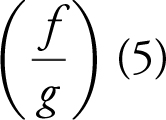
(h) 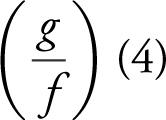
(a) (f ∘ g )(x ) = f (g (x )) = f (x – 5) = (x – 5)2 – 4 = x 2 – 10x + 21.
Thus (f ∘ g )(–1) = (–1)2 – 10(–1) + 21 = 1 + 10 + 21 = 32.
Or (f ∘ g )(–1) = f (g (–1)) = f (–6) = 32.
(b) (g ∘ f )(x ) = g (f (x )) = g (x 2 – 4) = (x 2 – 4) – 5 = x 2 – 9.
Thus (g ∘ f )(–1) = (–1)2 – 9 = 1 – 9 = –8.
(c) (f + g )(x ) = (x 2 – 4) + (x – 5) = x 2 + x – 9. Thus (f + g )(–3) = –3.
(d) (f – g )(x ) = (x 2 – 4) – (x – 5) = x 2 – x + 1. Thus (f – g )(1) = 1.
(e) (fg )(x ) = (x 2 – 4)(x – 5) = x 3 – 5x 2 – 4x + 20. Thus (fg )(2) = 0.
(f)  . Thus
. Thus  .
.
(g) Since g (5) = 0, x = 5 is not in the domain of  and
and  is undefined .
is undefined .
(h)  or –2. Thus
or –2. Thus 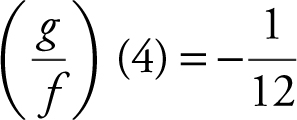 .
.
Example 2
Given  and
and 
(a) find  and indicate its domain and
and indicate its domain and
(b) find  and indicate its domain.
and indicate its domain.
(a) 
The domain of h (x ) is [0, ∞), and the domain of k (x ) is [–3, 3].
The intersection of the two domains is [0, 3]. However, k (3) = 0.
Therefore the domain of  is [0, 3).
is [0, 3).
Note that  is not equivalent to
is not equivalent to 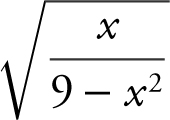 outside of the domain [0, 3).
outside of the domain [0, 3).
(b) 
The intersection of the two domains is [0, 3]. However, h (0) = 0.
Therefore the domain of  is (0, 3].
is (0, 3].
Example 3
Given the graphs of functions f (x ) and g (x ) in Figures 5.3-2 and 5.3-3 ,

Figure 5.3-2

Figure 5.3-3
find:
(a) (f + g )(1)
(b) (fg )(0)
(c) 
(d) f (g (3))
(a) (f + g )(1) = f (1) + g (1) = 3
(b) (fg )(0) = f (0)g (0) = 3(0) = 0
(c)  undefined
undefined
(d) f (g (3)) = f (1) = 1
Inverse Functions
Given a function f , the inverse of f (if it exists) is a function g such that f (g (x )) = x for every x in the domain of g and g (f (x )) = x for every x in the domain of f . The function g is written as f –1 . Thus, f (f –1 (x )) = x and f –1 (f (x )) = x . The graphs of f and f –1 in Figure 5.3-4 are reflections of each other in the line y = x . The point (a , b ) is on the graph of f if and only if the point (b , a ) is on the graph of f –1 .

Figure 5.3-4
A function f is one-to-one if for any two points x 1 and x 2 in the domain such that x 1 ≠ x 2 , then f (x 1 ) ≠ f (x 2 ).
Equivalent Statements
Given a function f :
1. The function f has an inverse.
2. The function f is one-to-one.
3. Every horizontal line passes through the graph of f no more than once.
4. The function f is monotonic—strictly increasing or decreasing.
To find the inverse of a function f :
1. Check if f has an inverse, that is, if f is one-to-one or passes the horizontal line test.
2. Replace f (x ) by y .
3. Interchange the variables x and y .
4. Solve for y .
5. Replace y by f –1 (x ).
6. Indicate the domain of f –1 (x ) as the range of f (x ).
7. Verify f –1 (x ) by checking if f (f –1 (x )) = f –1 (f (x )) = x .
Example 1
Given the graph of f (x ) in Figure 5.3-5 , find:
(a) f –1 (0)
(b) f –1 (1)
(c) f –1 (3)
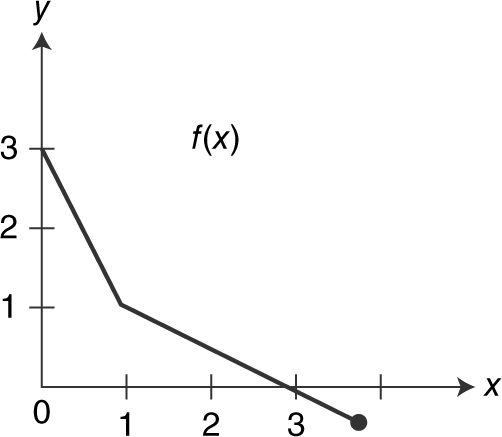
Figure 5.3-5
(a) By inspection, f (3) = 0. Thus, f –1 (0) = 3.
(b) Since f (1) = 1, thus, f –1 (1) = 1.
(c) Since f (0) = 3, therefore f –1 (3) = 0.
Example 2
Determine if the given functions have an inverse:
(a) f (x ) = x 3 + x – 2
(b) f (x ) = x 3 – 2x + 1
(a) By inspection, the graph of f (x ) = x 3 + x – 2 in Figure 5.3-6 is strictly increasing, which implies that f (x ) is one-to-one. (You could also use the horizontal line test.) Therefore, f (x ) has an inverse function.

Figure 5.3-6
(b) By inspection, the graph of f (x ) = x 3 – 2x + 1 in Figure 5.3-7 fails the horizontal line test. Thus, f (x ) has no inverse function.

Figure 5.3-7
Example 3
Find the inverse function of  . (See Figure 5.3-8 .)
. (See Figure 5.3-8 .)

Figure 5.3-8
1. Since f (x ) is a strictly increasing function, the inverse function exists.
2. Let y = f (x ). Thus,  .
.
3. Interchange x and y . You have  .
.
4. Solve for y . Thus,  .
.
5. Replace y by f –1 (x ). You have  .
.
6. Since the range of f (x ) is [0, ∞), the domain of f –1 (x ) is [0, ∞).
7. Verify f –1 (x ) by checking:
Since x > 0,  ,
,
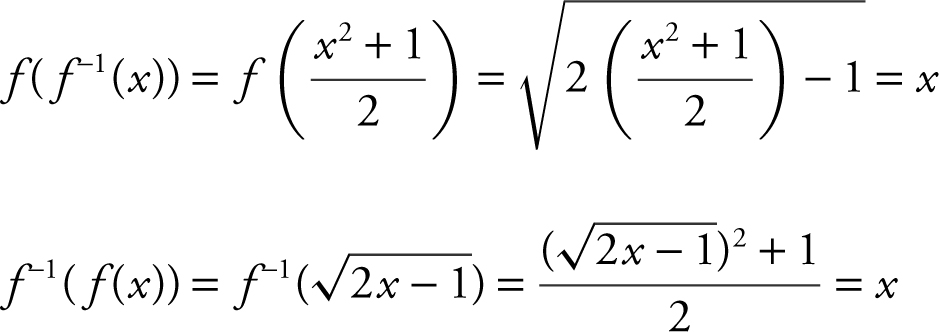
Trigonometric and Inverse Trigonometric Functions
There are six basic trigonometric functions and six inverse trigonometric functions. Their graphs are illustrated in Figures 5.3-9 to 5.3-20 .

Figure 5.3-9

Figure 5.3-10

Figure 5.3-11

Figure 5.3-12

Figure 5.3-13

Figure 5.3-14

Figure 5.3-15
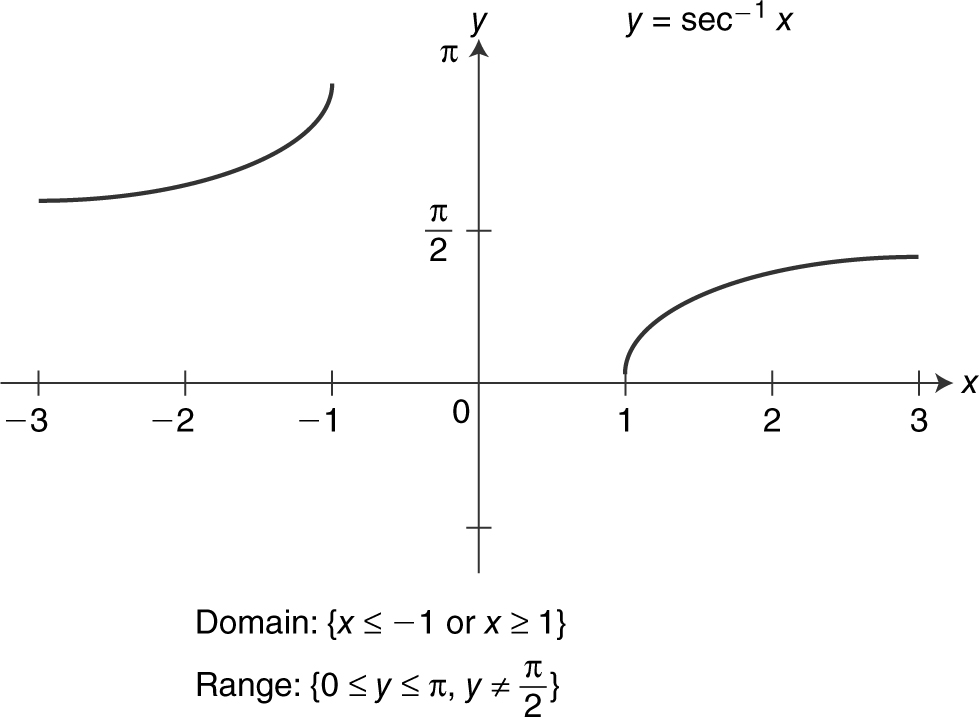
Figure 5.3-16

Figure 5.3-17

Figure 5.3-18

Figure 5.3-19

Figure 5.3-20
Formulas for using a calculator to get sec–1 x , csc–1 x , and cot–1 x :
sec–1 x = cos–1 (1/x )
csc–1 x = sin–1 (1/x )
cot–1 x = π /2 – tan–1 x
Example 1
Sketch the graph of the function y = 3 sin 2x . Indicate its domain, range, amplitude, period, and frequency.
The domain is all real numbers. The range is [–3, 3]. The amplitude is 3, which is the coefficient of sin 2x . The frequency is 2, the coefficient of x , and the period is (2π )÷ (the frequency), thus 2π ÷ 2 = π . See Figure 5.3-21 .

Figure 5.3-21
Example 2
Solve the equation cos x = –0.5 if 0 ≤ x ≤ 2π .
Note that cos (π /3) = 0.5 and that the cosine is negative in the second and third quadrants. Since cos x = –0.5, x must be in the second or third quadrant with a reference angle of π /3. In the second quadrant, x =π –(π /3)=2π /3 and in the third quadrant, x =π + (π /3)=4π /3. Thus x = 2π /3 or 4π /3. See Figure 5.3-22 .

Figure 5.3-22
Example 3
Evaluate tan–1 (3).
Using your graphing calculator, enter tan–1 (3). The result is 1.2490457724. Note that the range of tan–1 x is (–π /2, π /2) and –π /2 ≤ 1.2490457724 ≤ π /2. Thus tan–1 (3) ≈ 1.2490457724.
Example 4
Evaluate sin 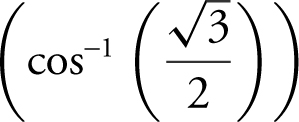 .
.
Note that  , and thus,
, and thus,  Or you could use a calculator and
Or you could use a calculator and
enter  and get 0.5.
and get 0.5.
Exponential and Logarithmic Functions
Exponential function with base a : f (x ) = a x where a > 0 and a ≠ 1.
Domain: {all real numbers}. Range: {y |y > 0}. y -Intercept: (0, 1). Horizontal asymptote: x -axis. Behavior: strictly increasing. See Figure 5.3-23 .

Figure 5.3-23
Properties of Exponents
Given a > 0, b > 0, and x and y are real numbers, then

Logarithmic function with base a : y = log a x if and only if a y = x where x > 0, a > 0, and a ≠ 1. See Figure 5.3-24 .

Figure 5.3-24
Domain: {x |x > 0}. Range: {all real numbers}. x -Intercept: (1, 0). Vertical asymptote: y -axis. Behavior: strictly increasing.
Note that y = log a x and y = a x are inverse functions (that is, log a (a x ) = a log a x = x ). See Figure 5.3-25 .

Figure 5.3-25
Properties of Logarithms
Given that x , y , and a are positive numbers with a ≠ 1 and n is a real number, then

Note that log a 1 = 0, log a a = 1, and log a a x = x .
The Natural Base e
e ≈ 2.71828182846 …
The expression  approaches the number e as x gets larger and larger. An equivalent expression is (1 + h )1/h . The expression (1 + h )1/h also approaches e as h approaches 0.
approaches the number e as x gets larger and larger. An equivalent expression is (1 + h )1/h . The expression (1 + h )1/h also approaches e as h approaches 0.
Exponential Function with Base e : f(x) = ex
The Natural Logarithmic Function: f (x ) = ln x = log e x where x > 0.
Note that y = e x and y = ln x are inverse functions: e ln x = ln e x = x . Also note that e 0 = 1, ln 1 = 0, and ln e = 1. See Figure 5.3-26 .
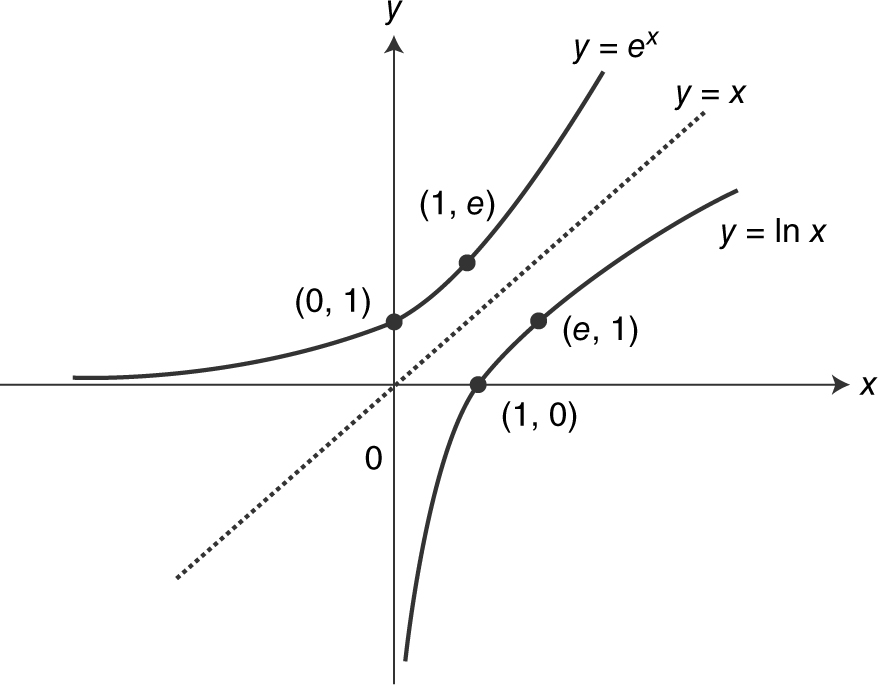
Figure 5.3-26
Properties of the Natural Logarithmic and Exponential Functions
Given x and y are real numbers, then
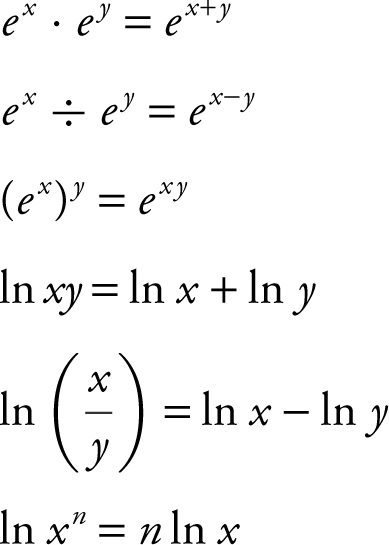
Change of Base Formula
 where a > 0 and a ≠ 1
where a > 0 and a ≠ 1
Example 1
Sketch the graph of f (x ) = ln(x – 2). Note that the domain of f (x ) is {x |x > 2} and that f (3) = ln(1) = 0; thus, the x -intercept is 3. See Figure 5.3-27 .

Figure 5.3-27
Example 2
Evaluate:
(a) log2 8
(b) 
(c) ln e 5
(a) Let n = log2 8 and thus 2 n = 8 = 23 . Therefore n = 3.
(b) Let n =  , and thus
, and thus  . Therefore, n = –2.
. Therefore, n = –2.
(c) You know that y = e x and y = ln x are inverse functions. Thus, ln e 5 = 5.
Example 3
Express ln(x (2x + 5)3 ) as the sum and multiplication of logarithms.
ln(x (2x + 5)3 ) = ln x + ln(2x + 5)3 = ln x + 3 ln(2x + 5)
Example 4
Solve 2e x +1 = 18 to the nearest thousandth.
2e x +1 = 18
e x +1 = 9
ln(e x +1 ) = ln 9
x + 1 = ln 9
x = 1.197
Example 5
Solve 3 ln 2x = 12 to the nearest thousandth.
3 ln 2x = 12
ln 2x = 4
e ln 2x = e 4
2x = e 4

5.4 Graphs of Functions
Main Concepts: Increasing and Decreasing Functions; Intercepts and Zeros; Odd and Even Functions; Shifting, Reflecting, and Stretching Graphs
Increasing and Decreasing Functions
Given a function f defined on an interval:
• f is increasing on an interval if f (x 1 ) < f (x 2 ) whenever x 1 < x 2 for any x 1 and x 2 in the interval.
• f is decreasing on an interval if f (x 1 ) > f (x 2 ) whenever x 1 < x 2 for any x 1 and x 2 in the interval.
• f is constant on an interval if f (x 1 ) = f (x 2 ) for any x 1 and x 2 in the interval.
A function value f (c ) is called a relative minimum of f if there exists an interval (a , b ) in the domain of f containing c such that f (c ) ≤ f (x ) for all x ∈ (a , b ).
A function value f (c ) is called a relative maximum of f if there exists an interval (a , b ) in the domain of f containing c such that f (c ) ≥ f (x ) for all x ∈ (a , b ).
See Figure 5.4-1 .

Figure 5.4-1
See the following examples. Using your graphing calculator, determine the intervals over which the given function is increasing, decreasing, or constant. Indicate any relative minimum and maximum values of the function.
Example 1
f (x ) = x 3 – 3x + 2
The function f (x ) = x 3 – 3x + 2 is increasing on (–∞, –1) and (1, ∞) and decreasing on (–1, 1). A relative minimum value of the function is 0, occurring at the point (1, 0), and a relative maximum value of 4 is located at the point (–1, 4). See Figure 5.4-2 .

Figure 5.4-2
Example 2
g (x ) = (x – 1)3
Note that g (x ) = (x – 1)3 is increasing for the entire domain (–∞, ∞) and it has no relative minimum or relative maximum values. See Figure 5.4-3 .

Figure 5.4-3
Example 3

The function f is decreasing on the intervals (–∞,2) and (2, ∞), and it has no relative minimum or relative maximum values. See Figure 5.4-4 .

Figure 5.4-4
Intercepts and Zeros
Given a function f , if f (a ) = 0, then the point (a ,0) is an x -intercept of the graph of the function, and the number a is called a zero of the function.
If f (0) = b , then b is the y -intercept of the graph of the function. See Figure 5.4-5 .

Figure 5.4-5
Note that to find the x -intercepts or zeros of a function, you should set f (x ) = 0; and to find the y -intercept, let x be 0 (i.e., find f (0)).
In the examples below, find the x -intercepts, y -intercept, and zeros of the given function if they exist.
Example 1
f (x ) = x 3 – 4x
Using your graphing calculator, note that the x -intercepts are –2, 0, and 2, and the y -intercept is 0. The zeros of f are –2, 0, and 2. See Figure 5.4-6 .

Figure 5.4-6
Example 2
f (x ) = x 2 – 2x + 4
Using your calculator, you see that the y -intercept is (0, 4) and the function f has no x -intercept or zeros. See Figure 5.4-7 .
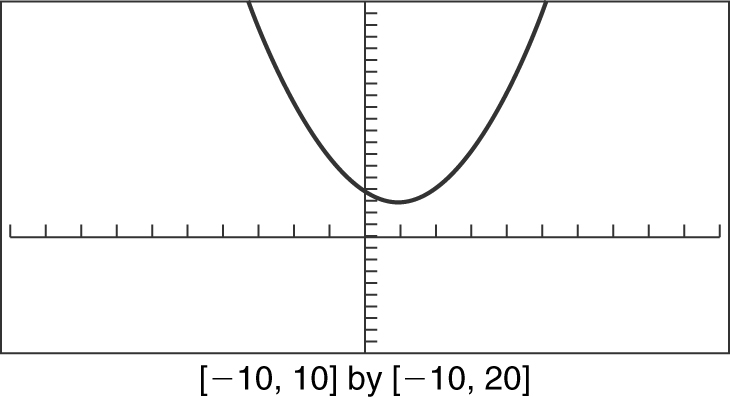
Figure 5.4-7
Odd and Even Functions
A function f is an even function if f (–x ) = f (x ) for all x in the domain. The graph of an even function is symmetrical with respect to the y -axis. If a point (a , b ) is on the graph, so is the point (–a , b ). If a function is a polynomial with only even powers, then it is an even function. See Figure 5.4-8 .

Figure 5.4-8
A function f is an odd function if f (–x ) = – f (x ) for all x in the domain. The graph of an odd function is symmetrical with respect to the origin. If a point (a , b ) is on the graph, so is the point (–a , –b ). If a function is a polynomial with only odd powers and a zero constant, then it is an odd function. See Figure 5.4-9 .

Figure 5.4-9
For the following examples, determine if the given functions are even, odd, or neither.
Example 1
f (x ) = x 4 – x 2
Begin by examining f (–x ). Since f (–x ) = (–x )4 – (–x )2 = x 4 – x 2 , f (–x ) = f (x ). Therefore, f (x ) = x 4 – x 2 is an even function. Or, using your graphing calculator, you see that the graph of f (x ) is symmetrical with respect to the y -axis. Thus, f (x ) is an even function. Or, since f has only even powers, it is an even function. See Figure 5.4-10 .

Figure 5.4-10
Example 2
g (x ) = x 3 + x
Examine g (–x ). Note that g (–x ) = (–x )3 + (–x ) = –x 3 – x = –g (x ). Therefore, g (x ) = x 3 + x is an odd function. Or, looking at the graph of g (x ) in your calculator, you see that the graph is symmetrical with respect to the origin. Therefore, g (x ) is an odd function. Or, since g (x ) has only odd powers and a zero constant, it is an odd function. See Figure 5.4-11 .

Figure 5.4-11
Example 3
h (x ) = x 3 + 1
Examine h (–x ). Since h (–x ) = (–x )3 + 1 = –x 3 + 1, h (–x ) ≠ h (x ) which indicates that h (x ) is not even. Also, –h (x ) = –x 3 – 1; therefore, h (–x ) ≠ – h (x ) which implies that h (x ) is not odd. Using your calculator, you notice that the graph of h (x ) is not symmetrical with respect to the y -axis or the origin. Thus, h (x ) is neither even nor odd. See Figure 5.4-12 .

Figure 5.4-12
Shifting, Reflecting, and Stretching Graphs
Vertical and Horizontal Shifts
Given y = f (x ) and a > 0, the graph of y = f (x ) + a is a vertical shift of the graph of y = f (x ) by a units upward. And y = f (x ) – a is a vertical shift of the graph of y = f (x ) by a units downward. See Figure 5.4-13 .

Figure 5.4-13
y = f (x – a ) is a horizontal shift of the graph of y = f (x ) by a units to the right. y = f (x + a ) is a horizontal shift of the graph of y = f (x ) by a units to the left. See Figure 5.4-14 .

Figure 5.4-14
Reflections About the x -Axis, y -Axis, and the Origin
Given y = f (x ), then the graph of y = – f (x ) is a reflection of the graph of y = f (x ) about the x -axis. See Figure 5.4-15 .

Figure 5.4-15
The graph of y = f (–x ) is a reflection of the graph of y = f (x ) about the y -axis. See Figure 5.4-16 .

Figure 5.4-16
The graph of y = – f (–x ) is a reflection of the graph of y = f (x ) about the origin. See Figure 5.4-17 .

Figure 5.4-17
Stretching Graphs
Given y = f (x ), the graph of y = af (x ), where a > 1 is a vertical stretch of the graph of y = f (x ), and y = af (x ), where 0 < a < 1 is a vertical shrink of the graph of y = f (x ). See Figure 5.4-18 .

Figure 5.4-18
Example 1
Sketch the graphs of the given functions and verify your results with your graphing calculator: f (x ) = x 2 , g (x ) = 2x 2 , and p (x ) = (x – 3)2 + 2.
Note that g (x ) is a vertical stretch of f (x ) and that p (x ) is a horizontal shift of f (x ) by 3 units to the right followed by a vertical shift of 2 units upward. See Figure 5.4-19 .

Figure 5.4-19
Example 2
Figure 5.4-20 contains the graphs of f (x ) = x 3 , h (x ), and g (x ). Find an equation for h (x ) and an equation for g (x ). See Figure 5.4-20 .

Figure 5.4-20
The graph of h (x ) is a horizontal shift of the graph of f (x ) by 1 unit to the right. Therefore, h (x ) = (x – 1)3 . The graph of g (x ) is a reflection of the graph of f (x ) about the x -axis followed by a vertical shift of 2 units upward. Thus, g (x ) = –x 3 + 2.
Example 3
Given f (x ) as shown in Figure 5.4-21 , sketch the graphs of f (x – 2), f (x ) + 1, and 2 f (x ).

Figure 5.4-21
Note that (a) f (x – 2) is a horizontal shift of f (x ) by 2 units to the right, (b) f (x ) + 1 is a vertical shift of f (x ) by 1 unit upward, and (c) 2f (x ) is a vertical stretch of f (x ) by a factor of 2. See Figure 5.4-22 .

Figure 5.4-22
5.5 Rapid Review
1. If line l is parallel to the line y – 3x = 2, find ml , the slope of line l .
Answer: ml = 3
2. If line l is perpendicular to the line 2y + x = 6, find ml .
Answer: ml = 2
3. If x 2 + y = 9, find the x -intercepts and y -intercept.
Answer: The x -intercepts are ±3 (by setting y = 0), and the y -intercept is 9 (by setting x = 0).
4. Simplify (a) ln(e 3x ) and (b) e ln(2x ) .
Answer: Since y = ln x and y = e x are inverse functions, ln(e 3x ) = 3x and e ln(2x ) = 2x .
5. Simplify ln  .
.
Answer: Since ln  = ln(a ) – ln(b ), ln
= ln(a ) – ln(b ), ln  = ln(1) – ln x = – ln x .
= ln(1) – ln x = – ln x .
6. Simplify ln (x 3 ).
Answer: Since ln(a b ) = b ln a , ln(x 3 ) = 3 ln x .
7. Solve the inequality x 2 – 4x > 5, using your calculator.
Answer: Let y 1 = x 2 – 4x and y 2 = 5. Look at the graph and see where y 1 is above y 2 .
Solution is {x : x < –1 or x > 5}. See Figure 5.5-1 .
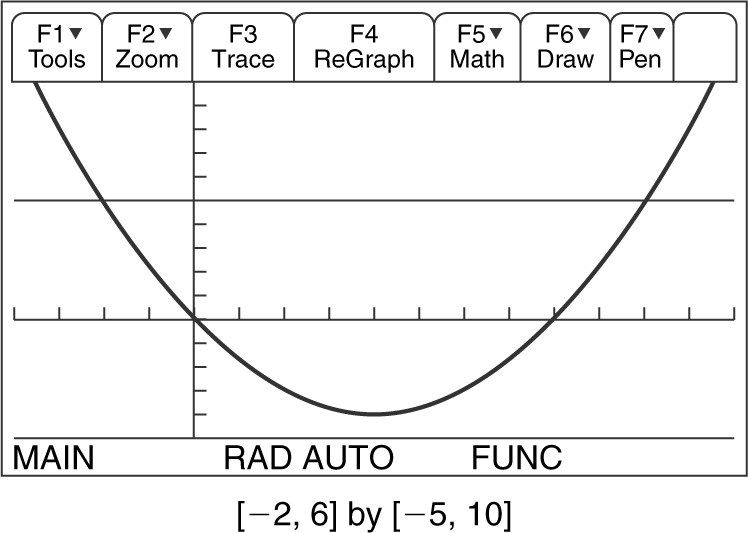
Figure 5.5-1
8. Evaluate  , and
, and  .
.
Answer:  , and
, and  .
.
9. 
Answer: The domain of f is {x : |x | ≥ 1 and x ≠ 2}.
10. Is the function f (x ) = x 4 – x 2 even, odd, or neither?
Answer: f (x ) is an even function since the exponents of x are all even.
5.6 Practice Problems
Part A—The use of a calculator is not allowed.
1 . Write an equation of a line passing through the point (–2, 5) and parallel to the line 3x – 4y + 12 = 0.
2 . The vertices of a triangle are A (–2, 0), B (0, 6), and C (4, 0). Find an equation of a line containing the median from vertex A to  .
.
3 . Write an equation of a circle whose center is at (2, –3) and tangent to the line y = –1.
4 . Solve for x : |x – 2| = 2x + 5.
5 . Solve the inequality |6 – 3x | < 18 and sketch the solution on the real number line.
6 . Given f (x ) = x 2 + 3x , find  in simplest form.
in simplest form.
7 . Determine which of the following equations represent y as a function of x :
(1) xy = –8
(2) 4x 2 + 9y 2 = 36
(3) 3x 2 – y = 1
(4) y 2 – x 2 = 4
8 . If f (x ) = x 2 and  , find (f ∘ g )(x ) and indicate its domain.
, find (f ∘ g )(x ) and indicate its domain.
9 . Given the graphs of f and g in Figures 5.6-1 and 5.6-2 , evaluate:
(1) (f – g )(2)
(2) (f ∘ g )(1)
(3) (g ∘ f )(0)

Figure 5.6-1
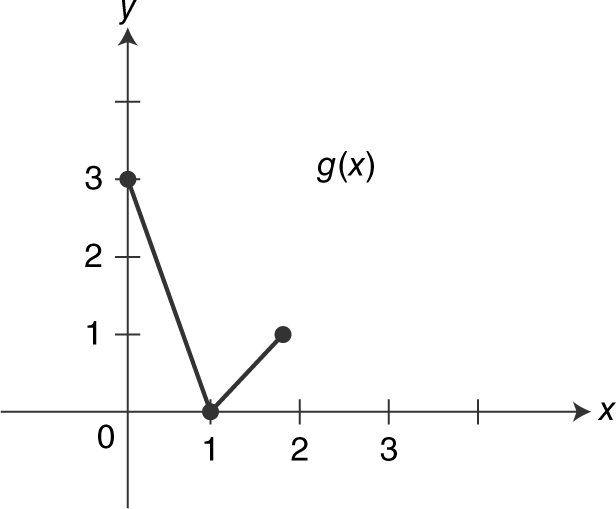
Figure 5.6-2
10 . Find the inverse of the function f (x ) = x 3 + 1.
11 . Sketch the graph of the equation  in the interval –2π ≤ x ≤ 2π and indicate the amplitude, frequency, and period.
in the interval –2π ≤ x ≤ 2π and indicate the amplitude, frequency, and period.
12 . On the same set of axes, sketch the graphs of:
(1) y = ln x
(2) y = ln(–x )
(3) y = – ln(x + 3)
Part B—Calculators are permitted.
13 . Solve the inequality |2x + 4| ≤ 10.
14 . Solve the inequality x 3 – 2x > 1.
15 . Evaluate  .
.
16 . Solve for x to the nearest thousandth: e 2x – 6e x + 5 = 0.
17 . Solve for x to the nearest thousandth: 3 ln 2x – 3 = 12.
18 . Solve the inequality  .
.
19 . Determine if the function f (x ) = –2x 4 + x 2 + 5 is even, odd, or neither.
20 . Given the function f (x ) = x 4 – 4x 3 , determine the intervals over which the function is increasing, decreasing, or constant. Find all zeros of f (x ), and indicate any relative minimum and maximum values of the function.
5.7 Cumulative Review Problems
21 . Given a linear function y = f (x ), with f (2) = 4 and f (–4) = 10, find f (x ).
22 . Solve the inequality x 3 – x ≥ 0 graphically.
23 . If  , x ≠ 0, evaluate
, x ≠ 0, evaluate  and express the answer in simplest form.
and express the answer in simplest form.
24 . Given g (x ) = 3x – 12, find g –1 (3).
25 . Write an equation of the tangent line to the graph of x 2 + y 2 = 25 at the point (4, –3).
5.8 Solutions to Practice Problems
Part A—The use of a calculator is not allowed.
1 . Rewrite the equation 3x – 4y + 12 = 0 in y = mx + b form:  . Thus, the slope of the line is
. Thus, the slope of the line is  . Since line l is parallel to this line, the slope of line l must also be
. Since line l is parallel to this line, the slope of line l must also be  . Line l also passes through the point (–2, 5). Therefore, an equation of line l is y – 5 =
. Line l also passes through the point (–2, 5). Therefore, an equation of line l is y – 5 =  (x + 2).
(x + 2).
2 . Let M be the midpoint of  . Using the midpoint formula, you will find the coordinates of M to be (2, 3). The slope of median
. Using the midpoint formula, you will find the coordinates of M to be (2, 3). The slope of median  is
is  . Thus, an equation of
. Thus, an equation of  is
is  .
.
3 . Since the circle is tangent to the line y = –1, the radius of the circle is 2 units. Therefore, the equation of the circle is (x – 2)2 + (y + 3)2 = 4.
4 . The two derived equations are x – 2 = 2x + 5 and x – 2 = –2x – 5. From x – 2 = 2x + 5, x = –7 and from x – 2 = –2x – 5, x = –1. However, substituting x = –7 into the original equation |x – 2| = 2x + 5 results in 9 = –9, which is not possible. Thus the only solution is –1.
5 . The inequality |6 – 3x | < 18 is equivalent to –18 < 6 – 3x < 18. Thus, –24 < –3x < 12. Dividing through by –3 and reversing the inequality sign, you have 8 > x > –4 or –4 < x < 8.
6 . Since f (x + h ) = (x + h )2 + 3(x + h ), the expression  is equivalent
is equivalent

7 . The graph of equation (2) 4x 2 + 9y 2 = 36 is an ellipse, and the graph of equation (4) y 2 – x 2 = 4 is a hyperbola intersecting the y -axis at two distinct points. Both of these graphs fail the vertical line test. Only the graphs of equations (1) xy = –8 and (3) 3x 2 – y = 1 (which are a hyperbola in the second and fourth quadrants and a parabola, respectively) pass the vertical line test. Thus, only (1) xy = –8 and (3) 3x 2 – y = 1 are functions.
8 . The domain of g (x ) is –5 ≤ x ≤ 5, and the domain of f (x ) is the set of all real numbers. Therefore, the domain of  is the interval –5 ≤ x ≤ 5.
is the interval –5 ≤ x ≤ 5.
9 . From the graph,
(f – g )(2) = f (2) – g (2) = 1 – 1 = 0,
(f ∘ g )(1) = f (g (1)) = f (0) = 1, and
(g ∘ f )(0) = g (f (0)) = g (1) = 0.
10 . Let y = f (x ) and thus y = x 3 + 1. Switch x and y to obtain x = y 3 + 1. Solve for y and you will have y = (x – 1)1/3 . Thus f –1 (x ) = (x – 1)1/3 .
11 . The amplitude is 3, frequency is ½, and period is 4π . See Figure 5.8-1 .

Figure 5.8-1
12 . Note that (1) y = ln x is the graph of the natural logarithmic function. (2) y = ln(–x ) is the reflection about the y -axis. (3) y = – ln(x + 3) is a horizontal shift 2 units to the left followed by a reflection about the x -axis. See Figure 5.8-2 .

Figure 5.8-2
Part B—Calculators are permitted.
13 . Enter into your calculator y 1 = |2x + 4| and y 2 = 10. Locate the intersection points. They occur at x = –7 and 3. Note that y 1 is below y 2 from x = –7 to 3. Since the inequality is less than or equal to, the solution is –7 ≤ x ≤ 3. See Figure 5.8-3 .

Figure 5.8-3
14 . Enter in your calculator y 1 = x 3 – 2x and y 2 = 1. Find the intersection points. The points are located at x = –1, –0.618, and 1.618. Since y 1 is above y 2 in the intervals –1 < x < –0.618 and x > 1.618 excluding the endpoints, the solutions to the inequality are the intervals –1 < x < –0.618 and x > 1.618. See Figure 5.8-4 .

Figure 5.8-4
15 . Enter 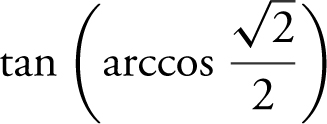 into your calculator and obtain 1. (Note that arccos
into your calculator and obtain 1. (Note that arccos  and
and  = 1.)
= 1.)
16 . Factor e 2x – 6e x + 5 = 0 as (e x – 5)(e x – 1) = 0. Thus (e x – 5) = 0 or (e x – 1) = 0, resulting in e x = 5 and e x = 1. Taking the natural log of both sides yields ln(e x ) = ln 5 ≈ 1.609 and ln(e x ) = ln 1 = 0. Therefore to the nearest thousandth, x = 1.609 or 0. (Note that ln(e x ) = x .)
17 . The equation 3 ln 2x – 3 = 12 is equivalent to ln 2x = 5. Therefore, e ln 2x = e 5 , 2x = e 5 ≈ 148.413159, and x ≈ 74.207.
18 . Enter  and y 2 = 1 into your calculator. Note that y 1 is below y 2 = 1 on the interval (–1, 2). Since the inequality is ≤ which includes the endpoint at x = 2, the solution is (–1, 2]. See Figure 5.8-5 .
and y 2 = 1 into your calculator. Note that y 1 is below y 2 = 1 on the interval (–1, 2). Since the inequality is ≤ which includes the endpoint at x = 2, the solution is (–1, 2]. See Figure 5.8-5 .

Figure 5.8-5
19 . Examine f (–x ) and f (–x ) = –2(–x )4 + (–x )2 + 5 =–2x 4 + x 2 + 5 = f (x ). Therefore, f (x ) is an even function. (Note that the graph of f (x ) is symmetrical with respect to the y -axis; thus, f (x ) is an even function.) See Figure 5.8-6 .

Figure 5.8-6
20 . Enter y 1 = x 4 – 4x 3 into your calculator and examine the graph. Note that the graph is decreasing on the interval (–∞, 3) and increasing on (3, ∞). The function crosses the x -axis at 0 and 4. Thus, the zeros of the function are 0 and 4. There is one relative minimum point at (3, –27). Thus, the relative minimum value for the function is –27. There is no relative maximum. See Figure 5.8-7 .

Figure 5.8-7
5.9 Solutions to Cumulative Review Problems
21 . The notation f (2) = 4 means that when x = 2, y = 4, and thus, the point (2, 4) is on the graph of f (x ). Similarly, f (–4) = 10 implies that the point (–4, 10) is also on the graph. Since f (x ) is a linear function, its graph is a line. The slope of a line, m , is defined as  . Thus
. Thus  .
.
Using the point slope of a line y – y 1 = m (x – x 1 ), you have y – 4 = –1(x – 2) or y = –x + 6.
22 . Enter into your calculator y 1 = x 3 – x and examine the graph. See Figure 5.9-1 .
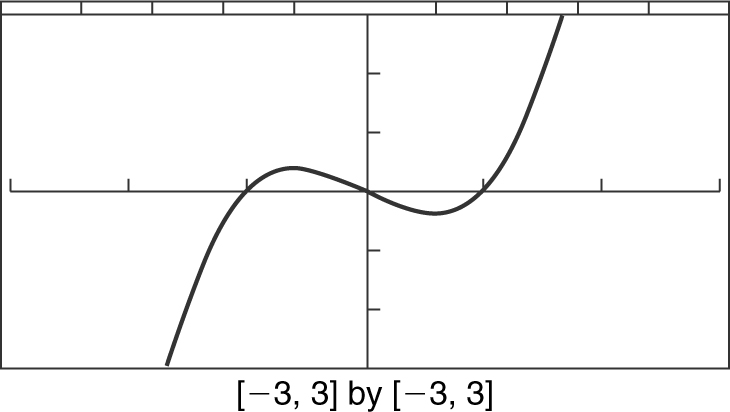
Figure 5.9-1
Note that f (x ) ≥ 0 on the intervals [–1, 0] and [1, ∞). Therefore, the solution to x 3 – x ≥ 0 is –1 ≤ x ≤ 0 or x ≥ 1.
23 . Since  ,
,  and the LCD (lowest common denominator) of
and the LCD (lowest common denominator) of  and
and  is x (x + h ). Multiplying the numerator and denominator of the complex fraction by the LCD, you have
is x (x + h ). Multiplying the numerator and denominator of the complex fraction by the LCD, you have  , which is equivalent to
, which is equivalent to 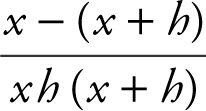 or
or  or
or  .
.
24 . Begin by finding g –1 (x ). Rewrite g (x ) = 3x – 12 as y = 3x – 12. Switch x and y , and you have x = 3y – 12. Solving for y , you have  . Substitute g –1 (x ) for y . Thus
. Substitute g –1 (x ) for y . Thus 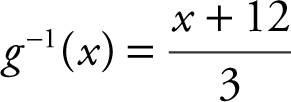 and
and  .
.
25 . The slope of the line segment joining the origin (0, 0) and the point of tangency (4, –3) is  . Since this line segment is perpendicular to the tangent line, the slope of the tangent line is
. Since this line segment is perpendicular to the tangent line, the slope of the tangent line is  .
.
Using the point-slope form of a line, you have y – y 1 = m (x – x 1 ), or  or
or  . See Figure 5.9-2 .
. See Figure 5.9-2 .

Figure 5.9-2
CHAPTER 6
Big Idea 1: Limits
Limits and Continuity
IN THIS CHAPTER
Summary: On the AP Calculus AB exam, you will be tested on your ability to find the limit of a function. In this chapter, you will be shown how to solve several types of limit problems which include finding the limit of a function as x approaches a specific value, finding the limit of a function as x approaches infinity, one-sided limits, infinite limits, and limits involving sine and cosine. You will also learn how to apply the concepts of limits to finding vertical and horizontal asymptotes as well as determining the continuity of a function.

Key Ideas
 Definition of the limit of a function
Definition of the limit of a function
 Properties of limits
Properties of limits
 Evaluating limits as x approaches a specific value
Evaluating limits as x approaches a specific value
 Evaluating limits as x approaches ± infinity
Evaluating limits as x approaches ± infinity
 One-sided limits
One-sided limits
 Limits involving infinities
Limits involving infinities
 Limits involving sine and cosine
Limits involving sine and cosine
 Vertical and horizontal asymptotes
Vertical and horizontal asymptotes
 Continuity
Continuity
6.1 The Limit of a Function
Main Concepts: Definition and Properties of Limits, Evaluating Limits, One-Sided Limits, Squeeze Theorem
Definition and Properties of Limits
Definition of Limit
Let f be a function defined on an open interval containing a , except possibly at a itself. Then  (read as the limit of f (x ) as x approaches a is L ) if for any ε > 0, there exists a δ > 0 such that | f (x ) – L | < ε whenever |x – a | < δ .
(read as the limit of f (x ) as x approaches a is L ) if for any ε > 0, there exists a δ > 0 such that | f (x ) – L | < ε whenever |x – a | < δ .
Properties of Limits
Given  and
and  and L , M , a , c , and n are real numbers, then:
and L , M , a , c , and n are real numbers, then:
1. 
2. 
3. 
4. 
5. 
6. 
Evaluating Limits
If f is a continuous function on an open interval containing the number a , then  = f (a ).
= f (a ).

Common techniques in evaluating limits are:
1. Substituting directly
2. Factoring and simplifying
3. Multiplying the numerator and denominator of a rational function by the conjugate of either the numerator or denominator
4. Using a graph or a table of values of the given function
Example 1
Find the limit:  .
.
Substituting directly:  .
.
Example 2
Find the limit:  .
.
Using the product rule,  .
.
Example 3
Find the limit:  .
.
Factoring and simplifying: 
(Note that had you substituted t = 2 directly in the original expression, you would have obtained a zero in both the numerator and denominator.)
Example 4
Find the limit:  .
.
Factoring and simplifying: 
Example 5
Find the limit: 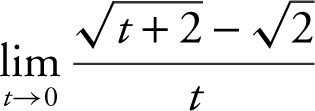 .
.
Multiplying both the numerator and the denominator by the conjugate of the numerator,
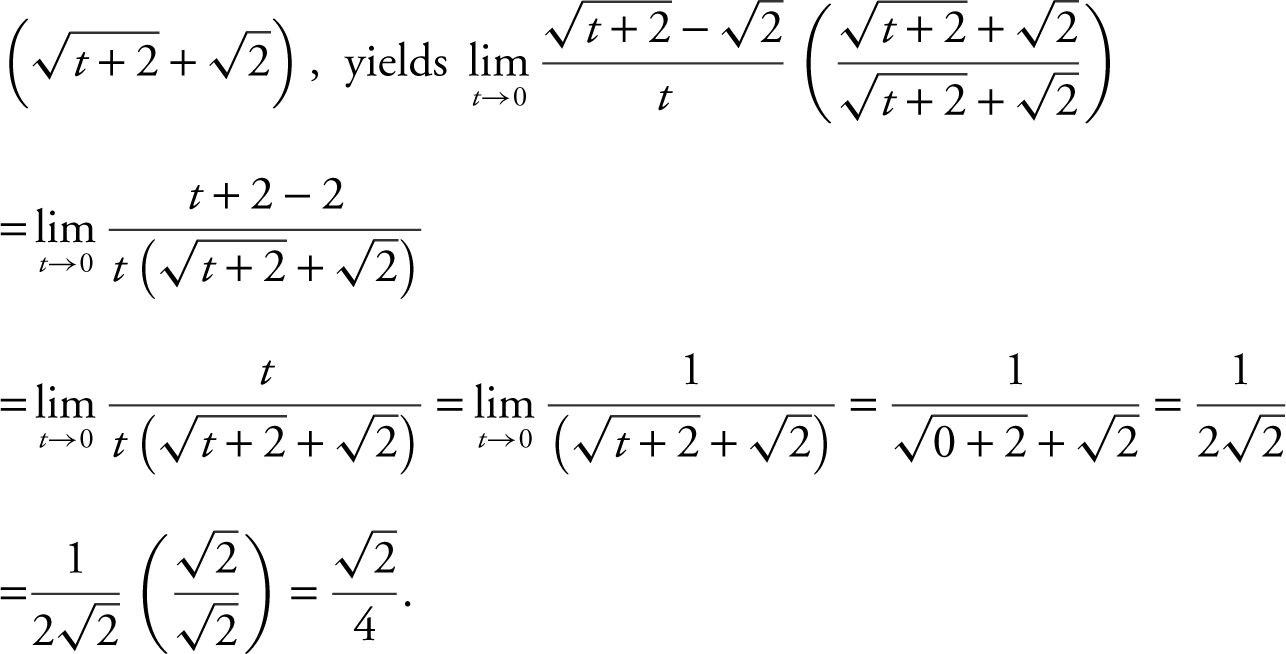
(Note that substituting 0 directly into the original expression would have produced a 0 in both the numerator and denominator.)
Example 6
Find the limit: 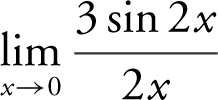 .
.
Enter  in the calculator. You see that the graph of f (x ) approaches 3 as x approaches 0. Thus, the
in the calculator. You see that the graph of f (x ) approaches 3 as x approaches 0. Thus, the 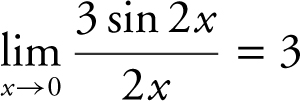 . (Note that had you substituted x = 0 directly in the original expression, you would have obtained a zero in both the numerator and denominator.) (See Figure 6.1-1 .)
. (Note that had you substituted x = 0 directly in the original expression, you would have obtained a zero in both the numerator and denominator.) (See Figure 6.1-1 .)
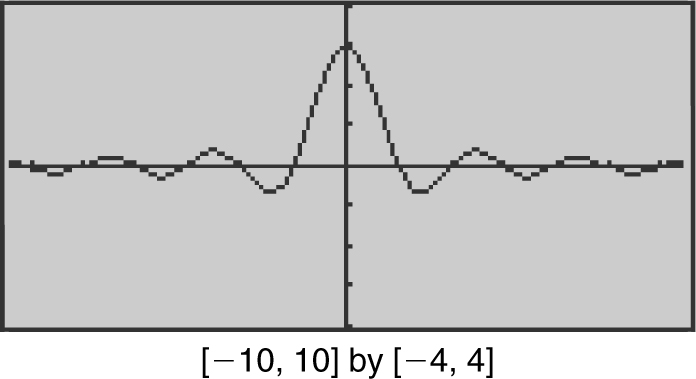
Figure 6.1-1
Example 7
Find the limit:  .
.
Enter  into your calculator. You notice that as x approaches 3 from the right, the graph of f (x ) goes higher and higher, and that as x approaches 3 from the left, the graph of f (x ) goes lower and lower. Therefore,
into your calculator. You notice that as x approaches 3 from the right, the graph of f (x ) goes higher and higher, and that as x approaches 3 from the left, the graph of f (x ) goes lower and lower. Therefore,  is undefined. (See Figure 6.1-2 .)
is undefined. (See Figure 6.1-2 .)

Figure 6.1-2

• Always indicate what the final answer is, e.g., “The maximum value of f is 5.” Use complete sentences whenever possible.
One-Sided Limits
Let f be a function and let a be a real number. Then the right-hand limit:  represents the limit of f as x approaches a from the right, and the left-hand limit:
represents the limit of f as x approaches a from the right, and the left-hand limit:  represents the limit of f as x approaches a from the left.
represents the limit of f as x approaches a from the left.
Existence of a Limit
Let f be a function and let a and L be real numbers. Then the two-sided limit:  if and only if the one-sided limits exist and
if and only if the one-sided limits exist and  .
.
Example 1
Given  , find the limits: (a)
, find the limits: (a)  , (b)
, (b)  , and (c)
, and (c)  . Substituting x = 3 into f (x ) leads to a 0 in both the numerator and denominator. Factor f (x ) as
. Substituting x = 3 into f (x ) leads to a 0 in both the numerator and denominator. Factor f (x ) as 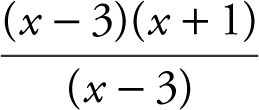 which is equivalent to (x + 1) where x ≠ 3. Thus, (a)
which is equivalent to (x + 1) where x ≠ 3. Thus, (a)  , (b)
, (b)  , and (c) since the one-sided limits exist and are equal,
, and (c) since the one-sided limits exist and are equal,  , therefore the two-sided limit
, therefore the two-sided limit  exists and
exists and  . (Note that f (x ) is undefined at x = 3, but the function gets arbitrarily close to 4 as x approaches 3. Therefore the limit exists.) (See Figure 6.1-3 .)
. (Note that f (x ) is undefined at x = 3, but the function gets arbitrarily close to 4 as x approaches 3. Therefore the limit exists.) (See Figure 6.1-3 .)

Figure 6.1-3
Example 2
Given f (x ) as illustrated in the accompanying diagram (Figure 6.1-4 ), find the limits: (a)  , (b)
, (b)  , and (c)
, and (c)  .
.

Figure 6.1-4
(a) As x approaches 0 from the left, f (x ) gets arbitrarily close to 0. Thus,  = 0.
= 0.
(b) As x approaches 0 from the right, f (x ) gets arbitrarily close to 2. Therefore,  = 2. Note that f (0) ≠ 2.
= 2. Note that f (0) ≠ 2.
(c) Since  does not exist.
does not exist.
Example 3
Given the greatest integer function f (x ) = [x ], find the limits: (a)  , (b)
, (b)  , and (c)
, and (c)  .
.
(a) Enter y 1 = int(x ) in your calculator. You see that as x approaches 1 from the right, the function stays at 1. Thus,  . Note that f (1) is also equal to 1.
. Note that f (1) is also equal to 1.
(b) As x approaches 1 from the left, the function stays at 0. Therefore,  . Notice that
. Notice that  .
.
(c). Since  , therefore,
, therefore,  does not exist. (See Figure 6.1-5 .)
does not exist. (See Figure 6.1-5 .)

Figure 6.1-5
Example 4
Given  , find the limits: (a)
, find the limits: (a)  , (b)
, (b)  , and (c)
, and (c)  . (a) From inspecting the graph,
. (a) From inspecting the graph,  , (b)
, (b)  , and (c) since
, and (c) since 
 , therefore,
, therefore,  does not exist. (See Figure 6.1-6 .)
does not exist. (See Figure 6.1-6 .)

Figure 6.1-6
Example 5

Thus,  does not exist.
does not exist.

• Remember ln(e ) = 1 and e ln3 = 3 since y = ln x and y = e x are inverse functions.
Squeeze Theorem
If f , g , and h are functions defined on some open interval containing a such that g (x ) ≤ f (x ) ≤ h (x ) for all x in the interval except possibly at a itself, and 
 , then
, then  .
.
Theorems on Limits
(1)  and (2)
and (2) 
Example 1
Find the limit if it exists:  .
.
Substituting 0 into the expression would lead to 0/0. Rewrite  as
as 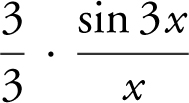 and thus,
and thus,  . As x approaches 0, so does 3x . Therefore,
. As x approaches 0, so does 3x . Therefore,  . (Note that
. (Note that  is equivalent to
is equivalent to  by replacing 3x by x .) Verify your result with a calculator. (See Figure 6.1-7 .)
by replacing 3x by x .) Verify your result with a calculator. (See Figure 6.1-7 .)

Figure 6.1-7
Example 2
Find the limit if it exists:  .
.
Rewrite  as
as  . As h approaches 0, so do 3h and 2h . Therefore,
. As h approaches 0, so do 3h and 2h . Therefore,
 . (Note that substituting h = 0 into the original expression would have produced 0/0.) Verify your result with a calculator. (See Figure 6.1-8 .)
. (Note that substituting h = 0 into the original expression would have produced 0/0.) Verify your result with a calculator. (See Figure 6.1-8 .)

Figure 6.1-8
Example 3
Find the limit if it exists:  .
.
Substituting 0 in the expression would lead to 0/0. Multiplying both the numerator and denominator by the conjugate (1 + cos y ) produces  .
.  = (1)2 (1 + 1) = 2. (Note that
= (1)2 (1 + 1) = 2. (Note that  .) Verify your result with a calculator. (See Figure 6.1-9 .)
.) Verify your result with a calculator. (See Figure 6.1-9 .)

Figure 6.1-9
Example 4
Find the limit if it exists:  .
.
Using the quotient rule for limits, you have  . Verify your result with a calculator. (See Figure 6.1-10 .)
. Verify your result with a calculator. (See Figure 6.1-10 .)

Figure 6.1-10
6.2 Limits Involving Infinities
Main Concepts: Infinite Limits (as x → a ), Limits at Infinity (as x → ∞), Horizontal and Vertical Asymptotes
Infinite Limits (as x → a )
If f is a function defined at every number in some open interval containing a , except possibly at a itself, then
(1)  means that f (x ) increases without bound as x approaches a .
means that f (x ) increases without bound as x approaches a .
(2)  means that f (x ) decreases without bound as x approaches a .
means that f (x ) decreases without bound as x approaches a .
Limit Theorems
(1) If n is a positive integer, then
(a) 
(b) 
(2) If the  , and
, and  , then
, then

(3) If the  , and
, and  , then
, then

(Note that limit theorems 2 and 3 hold true for x → a + and x → a – .)
Example 1
Evaluate the limit: (a)  and (b)
and (b)  .
.
(a) The limit of the numerator is 5 and the limit of the denominator is 0 through positive values. Thus,  . (b) The limit of the numerator is 5 and the limit of the denominator is 0 through negative values. Therefore,
. (b) The limit of the numerator is 5 and the limit of the denominator is 0 through negative values. Therefore,  . Verify your result with a calculator. (See Figure 6.2-1 .)
. Verify your result with a calculator. (See Figure 6.2-1 .)

Figure 6.2-1
Example 2
Find:  .
.
Factor the denominator obtaining  . The limit of the numerator is 9 and the limit of the denominator is (0)(6) = 0 through negative values. Therefore,
. The limit of the numerator is 9 and the limit of the denominator is (0)(6) = 0 through negative values. Therefore,  . Verify your result with a calculator. (See Figure 6.2-2 .)
. Verify your result with a calculator. (See Figure 6.2-2 .)

Figure 6.2-2
Example 3
Find:  .
.
Substituting 5 into the expression leads to 0/0. Factor the numerator  into
into  . As x → 5– , (x – 5) < 0. Rewrite (x – 5) as –(5 – x ) as x → 5– , (5 – x ) > 0 and thus, you may express (5 – x ) as
. As x → 5– , (x – 5) < 0. Rewrite (x – 5) as –(5 – x ) as x → 5– , (5 – x ) > 0 and thus, you may express (5 – x ) as  . Therefore,
. Therefore,  . Substituting these equivalent expressions into the original problem, you have
. Substituting these equivalent expressions into the original problem, you have 
 . The limit of the numerator is 10 and the limit of the denominator is 0 through positive values. Thus, the
. The limit of the numerator is 10 and the limit of the denominator is 0 through positive values. Thus, the  .
.
Example 4
Find: 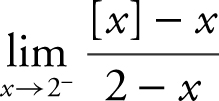 , where [x ] is the greatest integer value of x .
, where [x ] is the greatest integer value of x .
As x → 2– , [x ] = 1. The limit of the numerator is (1 – 2) = –1. As x → 2– , (2 – x ) = 0 through positive values. Thus,  .
.

• Do easy questions first. The easy ones are worth the same number of points as the hard ones.
Limits at Infinity (as x → ± ∞)
If f is a function defined at every number in some interval (a , ∞), then  means that L is the limit of f (x ) as x increases without bound. If f is a function defined at every number in some interval (–∞, a ), then
means that L is the limit of f (x ) as x increases without bound. If f is a function defined at every number in some interval (–∞, a ), then  means that L is the limit of f (x ) as x decreases without bound.
means that L is the limit of f (x ) as x decreases without bound.
Limit Theorem
If n is a positive integer, then
(a) 
(b) 
Example 1
Evaluate the limit:  .
.
Divide every term in the numerator and denominator by the highest power of x (in this case, it is x ), and obtain:

Verify your result with a calculator. (See Figure 6.2-3 .)

Figure 6.2-3
Example 2
Evaluate the limit:  .
.
Divide every term in the numerator and denominator by the highest power of x . In this case, it is x 3 . Thus, 
Verify your result with a calculator. (See Figure 6.2-4 .)

Figure 6.2-4
Example 3
Evaluate the limit:  .
.
Divide every term in the numerator and denominator by the highest power of x . In this case, it is x 2 . Therefore,  . The limit of the numerator is –1 and the limit of the denominator is 0. Thus,
. The limit of the numerator is –1 and the limit of the denominator is 0. Thus,  .
.
Verify your result with a calculator. (See Figure 6.2-5 .)

Figure 6.2-5
Example 4
Evaluate the limit:  .
.
As x → –∞, x < 0 and thus,  . Divide the numerator and denominator by x (not x 2 since the denominator has a square root). Thus, you have
. Divide the numerator and denominator by x (not x 2 since the denominator has a square root). Thus, you have 
Replacing the x below  by
by  , you have
, you have 

Verify your result with a calculator. (See Figure 6.2-6 .)

Figure 6.2-6

• Remember that ln  = ln (1) – ln x = – ln x and y = e –x
= ln (1) – ln x = – ln x and y = e –x  .
.
Horizontal and Vertical Asymptotes
A line y = b is called a horizontal asymptote for the graph of a function f if either  = b or
= b or  = b .
= b .
A line x = a is called a vertical asymptote for the graph of a function f if either  = +∞ or
= +∞ or  = +∞.
= +∞.
Example 1
Find the horizontal and vertical asymptotes of the function  .
.
To find the horizontal asymptotes, examine the  and the
and the  .
.
The  , and the
, and the 
 .
.
Thus, y = 3 is a horizontal asymptote.
To find the vertical asymptotes, look for x values such that the denominator (x – 2) would be 0, in this case, x = 2. Then examine:
(a)  , the limit of the numerator is 11 and the limit of the denominator is 0 through positive values, and thus,
, the limit of the numerator is 11 and the limit of the denominator is 0 through positive values, and thus,  .
.
(b)  , the limit of the numerator is 11 and the limit of the denominator is 0 through negative values, and thus,
, the limit of the numerator is 11 and the limit of the denominator is 0 through negative values, and thus,  .
.
Therefore, x = 2 is a vertical asymptote.
Example 2
Using your calculator, find the horizontal and vertical asymptotes of the function f (x ) =  .
.
Enter  . The graph shows that as x → ±∞, the function approaches 0, thus
. The graph shows that as x → ±∞, the function approaches 0, thus  . Therefore, a horizontal asymptote is y = 0 (or the x -axis).
. Therefore, a horizontal asymptote is y = 0 (or the x -axis).
For vertical asymptotes, you notice that  , and
, and . Thus, the vertical asymptotes are x = –2 and x = 2. (See Figure 6.2-7 .)
. Thus, the vertical asymptotes are x = –2 and x = 2. (See Figure 6.2-7 .)
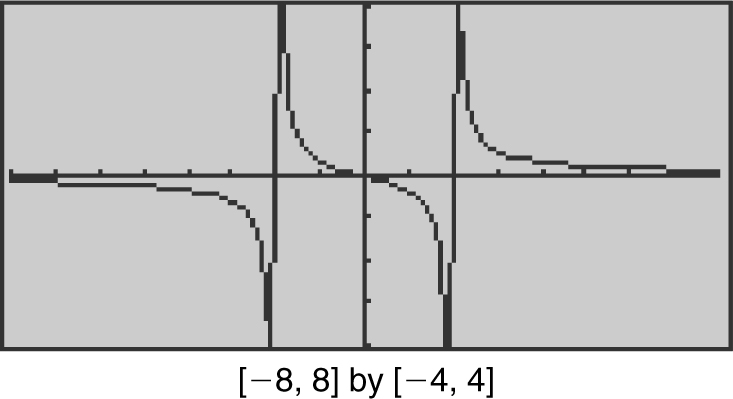
Figure 6.2-7
Example 3
Using your calculator, find the horizontal and vertical asymptotes of the function f (x ) =  .
.
Enter  . The graph of f (x ) shows that as x increases in the first quadrant, f (x ) goes higher and higher without bound. As x moves to the left in the second quadrant, f (x ) again goes higher and higher without bound. Thus, you may conclude that
. The graph of f (x ) shows that as x increases in the first quadrant, f (x ) goes higher and higher without bound. As x moves to the left in the second quadrant, f (x ) again goes higher and higher without bound. Thus, you may conclude that  and
and  and thus, f (x ) has no horizontal asymptote. For vertical asymptotes, you notice that
and thus, f (x ) has no horizontal asymptote. For vertical asymptotes, you notice that  , and
, and  . Therefore, the line x = 0 (or the y -axis) is a vertical asymptote. (See Figure 6.2-8 .)
. Therefore, the line x = 0 (or the y -axis) is a vertical asymptote. (See Figure 6.2-8 .)

Figure 6.2-8

Relationship between the limits of rational functions as x → ∞ and horizontal asymptotes:
Given  , then:
, then:
(1) If the degree of p (x ) is the same as the degree of q (x ), then  , where a is the coefficient of the highest power of x in p (x ) and b is the coefficient of the highest power of x in q (x ). The line
, where a is the coefficient of the highest power of x in p (x ) and b is the coefficient of the highest power of x in q (x ). The line  is a horizontal asymptote. See Example 1 on page 96 .
is a horizontal asymptote. See Example 1 on page 96 .
(2) If the degree of p (x ) is smaller than the degree of q (x ), then  . The line y = 0 (or x -axis) is a horizontal asymptote. See Example 2 on page 97 .
. The line y = 0 (or x -axis) is a horizontal asymptote. See Example 2 on page 97 .
(3) If the degree of p (x ) is greater than the degree of q (x ), then  and
and  . Thus, f (x ) has no horizontal asymptote. See Example 3 on page 97 .
. Thus, f (x ) has no horizontal asymptote. See Example 3 on page 97 .
Example 4
Using your calculator, find the horizontal asymptotes of the function 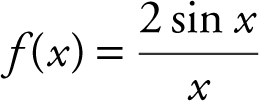 .
.
Enter  . The graph shows that f (x ) oscillates back and forth about the x -axis. As x → ±∞, the graph gets closer and closer to the x -axis which implies that f (x ) approaches 0. Thus, the line y = 0 (or the x -axis) is a horizontal asymptote. (See Figure 6.2-9 .)
. The graph shows that f (x ) oscillates back and forth about the x -axis. As x → ±∞, the graph gets closer and closer to the x -axis which implies that f (x ) approaches 0. Thus, the line y = 0 (or the x -axis) is a horizontal asymptote. (See Figure 6.2-9 .)

Figure 6.2-9

• When entering a rational function into a calculator, use parentheses for both the numerator and denominator, e.g., (x – 2) + (x + 3).
6.3 Continuity of a Function
Main Concepts: Continuity of a Function at a Number, Continuity of a Function over an Interval, Theorems on Continuity
Continuity of a Function at a Number
A function f is said to be continuous at a number a if the following three conditions are satisfied:
1. f (a ) exists
2. 
3. 
The function f is said to be discontinuous at a if one or more of these three conditions are not satisfied and a is called the point of discontinuity.
Continuity of a Function over an Interval
A function is continuous over an interval if it is continuous at every point in the interval.
Theorems on Continuity
1. If the functions f and g are continuous at a , then the functions f + g , f – g , f · g , f /g , and g (a ) ≠ 0, are also continuous at a .
2. A polynomial function is continuous everywhere.
3. A rational function is continuous everywhere, except at points where the denominator is zero.
4. Intermediate Value Theorem: If a function f is continuous on a closed interval [a , b ] and k is a number with f (a ) ≤ k ≤ f (b ), then there exists a number c in [a , b ] such that f (c ) = k .
Example 1
Find the points of discontinuity of the function  .
.
Since f (x ) is a rational function, it is continuous everywhere, except at points where the denominator is 0. Factor the denominator and set it equal to 0: (x – 2)(x + 1) = 0. Thus x = 2 or x = –1. The function f (x ) is undefined at x = –1 and at x = 2. Therefore, f (x ) is discontinuous at these points. Verify your result with a calculator. (See Figure 6.3-1 .)

Figure 6.3-1
Example 2
Determine the intervals on which the given function is continuous:

Check the three conditions of continuity at x = 2:
Condition 1: f (2) = 10.
Condition 2:  .
.
Condition 3:  . Thus, f (x ) is discontinuous at x = 2.
. Thus, f (x ) is discontinuous at x = 2.
The function is continuous on (–∞, 2) and (2, ∞). Verify your result with a calculator. (See Figure 6.3-2 .)

Figure 6.3-2

• Remember that  and
and  .
.
Example 3
For what value of k is the function  continuous at x = 6?
continuous at x = 6?
For f (x ) to be continuous at x = 6, it must satisfy the three conditions of continuity:
Condition 1: f (6) = 62 – 2(6) = 24.
Condition 2:  ; thus
; thus  must also be 24 in order for the
must also be 24 in order for the  to equal 24. Thus,
to equal 24. Thus,  which implies 2(6) + k = 24 and k = 12. Therefore, if k = 12,
which implies 2(6) + k = 24 and k = 12. Therefore, if k = 12,
Condition (3):  is also satisfied.
is also satisfied.
Example 4
Given f (x ) as shown in Figure 6.3-3 , (a) find f (3) and  , and (b) determine if f (x ) is continuous at x = 3? Explain your answer.
, and (b) determine if f (x ) is continuous at x = 3? Explain your answer.

Figure 6.3-3
(a) The graph of f (x ) shows that f (3) = 5 and the  . (b) Since
. (b) Since  , f (x ) is discontinuous at x = 3.
, f (x ) is discontinuous at x = 3.
Example 5
If g (x ) = x 2 – 2x – 15, using the Intermediate Value Theorem show that g (x ) has a root in the interval [1, 7].
Begin by finding g (1) and g (7), and g (1) = –16 and g (7) = 20. If g (x ) has a root, then g (x ) crosses the x -axis, i.e., g (x ) = 0. Since –16 ≤ 0 ≤ 20, by the Intermediate Value Theorem, there exists at least one number c in [1, 7] such that g (c ) = 0. The number c is a root of g (x ).
Example 6
A function f is continuous on [0, 5], and some of the values of f are shown below.

If f (x ) = –2 has no solution on [0, 5], then b could be
(A) 1
(B) 0
(C) –2
(D) –5
If b = –2, then x = 3 would be a solution for f (x ) = –2.
If b = 0, 1, or 3, f (x ) = –2 would have two solutions for f (x ) = –2.
Thus, b = –5, choice (D). (See Figure 6.3-4 .)

Figure 6.3-4
6.4 Rapid Review
1. Find f (2) and  and determine if f is continuous at x = 2. (See Figure 6.4-1 .)
and determine if f is continuous at x = 2. (See Figure 6.4-1 .)
Answer: f (2) = 2,  , and f is discontinuous at x = 2.
, and f is discontinuous at x = 2.

Figure 6.4-1
2. Evaluate 
Answer: 
3. Evaluate 
Answer: The limit is –3, since the polynomials in the numerator and denominator have the same degree.
4. Determine if 
Answer: The function f is continuous, since f (3) = 9,  f (x ) = 9, and
f (x ) = 9, and  .
.
5. If 
Answer: 
6. Evaluate 
Answer: The limit is  , since
, since  .
.
7. Evaluate 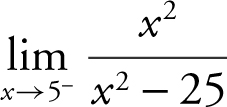 .
.
Answer: The limit is –∞, since (x 2 – 25) approaches 0 through negative values.
8. Find the vertical and horizontal asymptotes of  .
.
Answer: The vertical asymptotes are x = ±5, and the horizontal asymptote is y = 0, since  .
.
6.5 Practice Problems
Part A—The use of a calculator is not allowed.
Find the limits of the following:
1 . 
2 . If b ≠ 0, evaluate  .
.
3 . 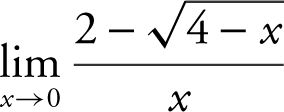
4 . 
5 . 
6 . 
7 . 
8 . 
9 . 
10 . 
11 . 
12 . The graph of a function f is shown in Figure 6.5-1 .
Which of the following statements is/are true?

Figure 6.5-1
I. 
II. 
III. x = 4 is not in the domain of f .
Part B—Calculators are allowed.
13 . Find the horizontal and vertical asymptotes of the graph of the function
 .
.
14 . Find the limit:  when [x ] is the greatest integer of x .
when [x ] is the greatest integer of x .
15 . Find all x -values where the function  is discontinuous.
is discontinuous.
16 . For what value of k is the function  continuous at x = 3?
continuous at x = 3?
17 . Determine if
 is continuous at x = 2. Explain why or why not.
is continuous at x = 2. Explain why or why not.
18 . Given f (x ) as shown in Figure 6.5-2 , find

Figure 6.5-2
(a) f (3).
(b) 
(c) 
(d) 
19 . A function f is continuous on [–2, 2] and some of the values of f are shown below:

If f has only one root, r , on the closed interval [–2, 2], and r ≠ 0, then a possible value of b is
(A) –2
(B) –1
(C) 0
(D) 1
20 . Evaluate  .
.
6.6 Cumulative Review Problems
21 . Write an equation of the line passing through the point (2, –4) and perpendicular to the line 3x – 2y = 6.
22 . The graph of a function f is shown in Figure 6.6-1 . Which of the following statements is/are true?

Figure 6.6-1
I. 
II. x = 4 is not in the domain of f .
III.  does not exist.
does not exist.
23 . Evaluate 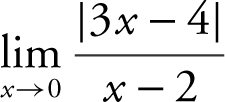 .
.
24 . Find  .
.
25 . Find the horizontal and vertical asymptotes of  .
.
6.7 Solutions to Practice Problems
Part A—The use of a calculator is not allowed.
1 . Using the product rule, 
2 . Rewrite  as
as  Substitute x = b and obtain
Substitute x = b and obtain  .
.
3 . Substituting x = 0 into the expression  leads to 0/0 which is an indeterminate form. Thus, multiply both the numerator and denominator by the conjugate
leads to 0/0 which is an indeterminate form. Thus, multiply both the numerator and denominator by the conjugate  and obtain
and obtain

4 . Since the degree of the polynomial in the numerator is the same as the degree of the polynomial in the denominator, 
5 . Since the degree of the polynomial in the numerator is 2 and the degree of the polynomial in the denominator is 3, 
6 . The degree of the monomial in the numerator is 2 and the degree of the binomial in the denominator is 1. Thus, 
7 . Divide every term in both the numerator and denominator by the highest power of x . In this case, it is x . Thus, you have 
Since the denominator involves a radical, rewrite the expression as

8 . 
9 .  . However, as x → ∞, the rate of increase of e x is much greater than the rate of decrease of (1 – x 3 ). Thus,
. However, as x → ∞, the rate of increase of e x is much greater than the rate of decrease of (1 – x 3 ). Thus,  .
.
10 . Divide both numerator and denominator by x and obtain  . Now rewrite the limit as
. Now rewrite the limit as 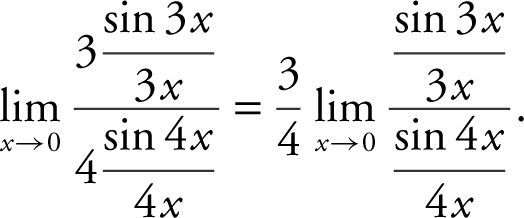 . As x approaches 0, so do 3x and 4x .
. As x approaches 0, so do 3x and 4x .
Thus, you have

11 . As t → 3+ , (t – 3) > 0, and thus  . Rewrite the limit as
. Rewrite the limit as  The limit of the numerator is
The limit of the numerator is  and the denominator is approaching 0 through positive values. Thus, positive values. Thus,
and the denominator is approaching 0 through positive values. Thus, positive values. Thus,  .
.
12 . The graph of f indicates that:
I.  is true.
is true.
II.  is false.
is false.
(The  = 5.)
= 5.)
III. “x = 4 is not in the domain of f ” is false since f (4) = 2.
Part B—Calculators are allowed.
13 . Examining the graph in your calculator, you notice that the function approaches the x -axis as x → ∞ or as x → –∞. Thus, the line y = 0 (the x -axis) is a horizontal asymptote. As x approaches 1 from either side, the function increases or decreases without bound. Similarly, as x approaches –2 from either side, the function increases or decreases without bound. Therefore, x = 1 and x = –2 are vertical asymptotes. (See Figure 6.7-1 .)

Figure 6.7-1
14 . As x → 5+ , the limit of the numerator (5 + [5]) is 10 and as x → 5+ , the denominator approaches 0 through negative values. Thus, the  .
.
15 . Since f (x ) is a rational function, it is continuous everywhere except at values where the denominator is 0. Factoring and setting the denominator equal to 0, you have (x + 6) (x – 2) = 0. Thus, the function is discontinuous at x = –6 and x = 2. Verify your result with a calculator. (See Figure 6.7-2 .)
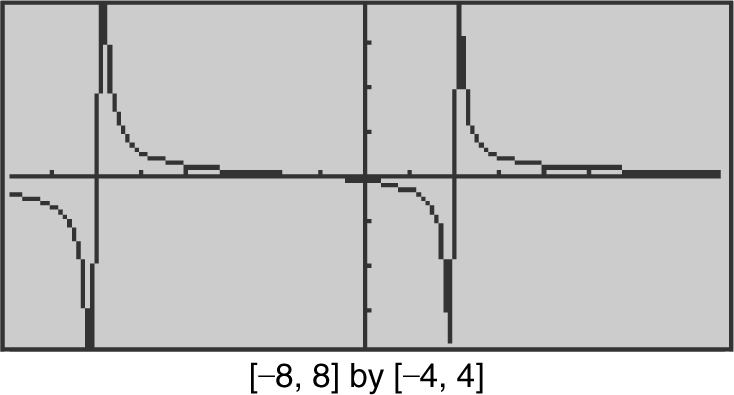
Figure 6.7-2
16 . In order for g (x ) to be continuous at x = 3, it must satisfy the three conditions of continuity:
(1) g (3) = 32 + 5 = 14,
(2)  = 14, and
= 14, and
(3)  – k , and the two one-sided limits must be equal in order for
– k , and the two one-sided limits must be equal in order for  to exist. Therefore, 6 – k = 14 and k = –8.
to exist. Therefore, 6 – k = 14 and k = –8.
Now,  and condition 3 is satisfied.
and condition 3 is satisfied.
17 . Checking with the three conditions of continuity:
(1) f (2) = 12,
(2) 
 , and
, and
(3)  . Therefore, f (x ) is discontinuos at x = 2.
. Therefore, f (x ) is discontinuos at x = 2.
18 . The graph indicates that (a) f (3) = 4, (b)  , (c)
, (c)  , (d)
, (d)  , and (e) therefore, f (x ) is not continuous at x = 3 since
, and (e) therefore, f (x ) is not continuous at x = 3 since  .
.
19 . (See Figure 6.7-3 .) If b = 0, then r = 0, but r cannot be 0. If b = –3, –2, or –1, f would have more than one root. Thus b = 1. Choice (D).

Figure 6.7-3
20 . Substituting x = 0 would lead to 0/0. Substitute (1 – cos2 x ) in place of sin2 x and obtain

Verify your result with a calculator. (See Figure 6.7-4 )

Figure 6.7-4
6.8 Solutions to Cumulative Review Problems
21 . Rewrite 3x – 2y = 6 in y = mx + b form which is  . The slope of this line whose equation is
. The slope of this line whose equation is  is
is  . Thus, the slope of a line perpendicular to this line is
. Thus, the slope of a line perpendicular to this line is  . Since the perpendicular line passes through the point (2, –4), therefore, an equation of the perpendicular line is
. Since the perpendicular line passes through the point (2, –4), therefore, an equation of the perpendicular line is  which is equivalent to
which is equivalent to  .
.
22 . The graph indicates that  , f (4) = 1, and
, f (4) = 1, and  does not exist. Therefore, only statements I and III are true.
does not exist. Therefore, only statements I and III are true.
23 . Substituting x = 0 into  , you obtain
, you obtain  .
.
24 . Rewrite  which is equivalent to
which is equivalent to  which is equal to
which is equal to  .
.
25 . To find horizontal asymptotes, examine the  and the
and the  . The
. The  . Dividing by the highest power of x (and in this case, it’s x ), you obtain
. Dividing by the highest power of x (and in this case, it’s x ), you obtain  . As x → ∞,
. As x → ∞,  . Thus, you have
. Thus, you have 
 . Thus, the line y = 1 is a horizontal asymptote.
. Thus, the line y = 1 is a horizontal asymptote.
The  . As
. As  . Thus,
. Thus, 
 .
.
Therefore, the line y = –1 is a horizontal asymptote. As for vertical asymptotes, f (x ) is continuous and defined for all real numbers. Thus, there is no vertical asymptote.
CHAPTER 7
Big Idea 2: Derivatives
Differentiation
IN THIS CHAPTER
Summary: The derivative of a function is often used to find rates of change. It is also related to the slope of a tangent line. On the AP Calculus AB exam, many questions involve finding the derivative of a function. In this chapter, you will learn different techniques for finding a derivative which include using the Power Rule, Product and Quotient Rules, Chain Rule, and Implicit Differentiation. You will also learn to find the derivatives of trigonometric, exponential, logarithmic, and inverse functions.

Key Ideas
 Definition of the derivative of a function
Definition of the derivative of a function
 Power Rule, Product and Quotient Rules, and Chain Rule
Power Rule, Product and Quotient Rules, and Chain Rule
 Derivatives of trigonometric, exponential, and logarithmic functions
Derivatives of trigonometric, exponential, and logarithmic functions
 Derivatives of inverse functions
Derivatives of inverse functions
 Implicit Differentiation
Implicit Differentiation
 Higher order derivatives
Higher order derivatives
 L’Hôpital’s Rule for Indeterminate Forms
L’Hôpital’s Rule for Indeterminate Forms
7.1 Derivatives of Algebraic Functions
Main Concepts: Definition of the Derivative of a Function; Power Rule; The Sum, Difference, Product, and Quotient Rules; The Chain Rule
Definition of the Derivative of a Function
The derivative of a function f , written as f ′, is defined as

if this limit exists. (Note that f ′(x ) is read as f prime of x .)
Other symbols of the derivative of a function are:
 .
.
Let m tangent be the slope of the tangent to a curve y = f (x ) at a point on the curve. Then,
 .
.
(See Figure 7.1-1 .)
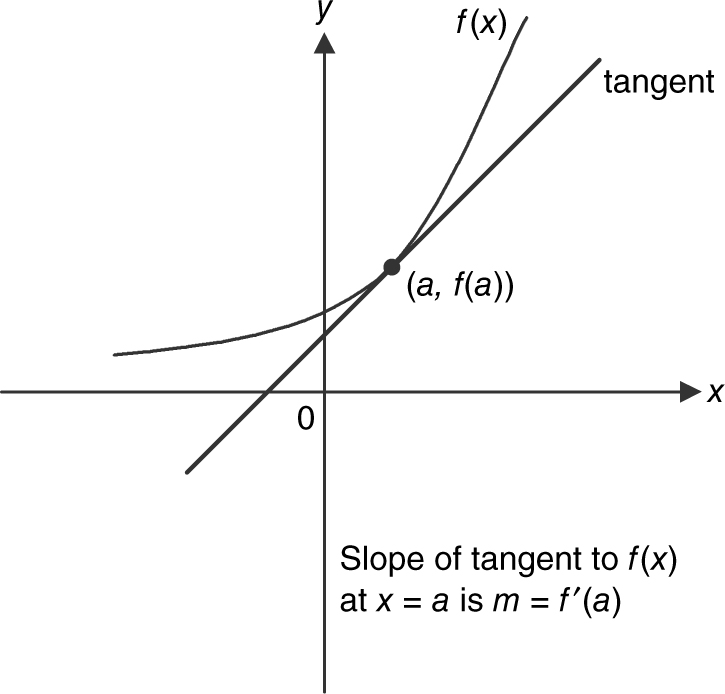
Figure 7.1-1
Given a function f , if f ′(x ) exists at x = a , then the function f is said to be differentiable at x = a . If a function f is differentiable at x = a , then f is continuous at x = a . (Note that the converse of the statement is not necessarily true, i.e., if a function f is continuous at x = a , then f may or may not be differentiable at x = a .) Here are several examples of functions that are not differentiable at a given number x = a . (See Figures 7.1-2 –7.1-5 .)

Figure 7.1-2

Figure 7.1-3

Figure 7.1-4

Figure 7.1-5
Example 1
If f (x ) = x 2 – 2x – 3, find (a) f ′(x ) using the definition of derivative, (b) f ′(0), (c) f ′(1), and (d) f ′(3).
(a) Using the definition of derivative, 

(b) f ′(0) = 2(0) – 2 = –2, (c) f ′(1) = 2(1) – 2 = 0, and (d) f ′(3) = 2(3) – 2 = 4.
Example 2
Evaluate  .
.
The expression  is equivalent to the derivative of the function f (x ) = cos x at x = π , i.e., f ′(π ). The derivative of f (x ) = cos x at x = π is equivalent to the slope of the tangent to the curve of cos x at x = π . The tangent is parallel to the x -axis. Thus, the slope is 0 or
is equivalent to the derivative of the function f (x ) = cos x at x = π , i.e., f ′(π ). The derivative of f (x ) = cos x at x = π is equivalent to the slope of the tangent to the curve of cos x at x = π . The tangent is parallel to the x -axis. Thus, the slope is 0 or  = 0.
= 0.
Or, using an algebraic method, note that cos(a + b ) = cos(a ) cos(b ) – sin(a ) sin(b ). Then rewrite 
 .
.
(See Figure 7.1-6 .)

Figure 7.1-6
Example 3
If the function f (x ) = x 2/3 + 1, find all points where f is not differentiable.
The function f (x ) is continuous for all real numbers and the graph of f (x ) forms a “cusp” at the point (0, 1). Thus, f (x ) is not differentiable at x = 0. (See Figure 7.1-7 .)

Figure 7.1-7
Example 4
Using a calculator, find the derivative of f (x ) = x 2 + 4x at x = 3.
There are several ways to find f ′(3), using a calculator. One way is to use the [nDeriv ] function of the calculator. From the main Home screen, select F3-Calc and then select [nDeriv ]. Enter [nDeriv ] (x 2 + 4x , x )|x = 3. The result is 10.

• Always write out all formulas in your solutions.
Power Rule
If f (x ) = c where c is a constant, then f ′(x ) = 0.
If f (x ) = xn where n is a real number, then f ′(x ) = nx n –1 .
If f (x ) = c x n where c is a constant and n is a real number, then f ′(x ) = cnx n –1 .
Summary of Derivatives of Algebraic Functions

Example 1
If f (x ) = 2x 3 , find (a) f ′(x ), (b) f ′(1), and (c) f ′(0).
Note that (a) f ′(x ) = 6x 2 , (b) f ′(1) = 6(1)2 = 6, and (c) f ′(0) = 0.
Example 2
If  , find (a)
, find (a)  and (b)
and (b)  (which represents
(which represents  at x = 0).
at x = 0).
Note that (a)  and thus,
and thus,  and (b)
and (b)  does not exist because the expression
does not exist because the expression  is undefined.
is undefined.
Example 3
Here are several examples of algebraic functions and their derivatives:

Example 4
Using a calculator, find f ′(x ) and f ′(3) if  .
.
There are several ways of finding f ′(x ) and f ′(9) using a calculator. One way is to use the d [Differentiate ] function. Go to the Home screen. Select F3-Calc and then select d [Differentiate ]. Enter  . The result is
. The result is  . To find f ′(3), enter
. To find f ′(3), enter  x )|x = 3. The result is
x )|x = 3. The result is  .
.

The Sum, Difference, Product, and Quotient Rules
If u and v are two differentiable functions, then

Example 1
Find f ′(x ) if f (x ) = x 3 – 10x + 5.
Using the sum and difference rules, you can differentiate each term and obtain f ′(x ) = 3x 2 – 10. Or using your calculator, select the d [Differentiate ] function and enter d (x 3 – 10x + 5, x ) and obtain 3x 2 – 10.
Example 2
If y = (3x – 5)(x 4 + 8x – 1), find  .
.
Using the product rule  , let u = (3x – 5) and v = (x 4 + 8x – 1).
, let u = (3x – 5) and v = (x 4 + 8x – 1).
Then  = (3)(x 4 + 8x – 1) + (4x 3 + 8)(3x – 5) = (3x 4 + 24x – 3) + (12x 4 – 20x 3 + 24x – 40) = 15x 4 – 20x 3 + 48x – 43. Or you can use your calculator and enter d ((3x – 5)(x 4 + 8x – 1), x ) and obtain the same result.
= (3)(x 4 + 8x – 1) + (4x 3 + 8)(3x – 5) = (3x 4 + 24x – 3) + (12x 4 – 20x 3 + 24x – 40) = 15x 4 – 20x 3 + 48x – 43. Or you can use your calculator and enter d ((3x – 5)(x 4 + 8x – 1), x ) and obtain the same result.
Example 3
If  , find f ′(x ).
, find f ′(x ).
Using the quotient rule  , let u = 2x – 1 and v = x + 5. Then
, let u = 2x – 1 and v = x + 5. Then  . Or you can use your calculator and enter d ((2x – 1)/(x + 5), x ) and obtain the same result.
. Or you can use your calculator and enter d ((2x – 1)/(x + 5), x ) and obtain the same result.
Example 4
Using your calculator, find an equation of the tangent to the curve f (x ) = x 2 – 3x + 2 at x = 5.
Find the slope of the tangent to the curve at x = 5 by entering d (x 2 – 3x + 2, x )|x = 5. The result is 7. Compute f (5) = 12. Thus, the point (5, 12) is on the curve of f (x ). An equation of the line whose slope m = 7 and passing through the point (5, 12) is y – 12 = 7(x – 5).

• Remember that  ln
ln  and
and  . The integral formula is not usually tested in the AB exam.
. The integral formula is not usually tested in the AB exam.
The Chain Rule
If y = f (u ) and u = g (x ) are differentiable functions of u and x respectively, then  or
or  .
.
Example 1
If y = (3x – 5)10 , find  .
.
Using the chain rule, let u = 3x – 5 and thus, y = u 10 . Then,  and
and  .
.
Since  (3) = 10(3x – 5)9 (3) = 30(3x – 5)9 . Or you can use your calculator and enter d ((3x – 5)10 , x ) and obtain the same result.
(3) = 10(3x – 5)9 (3) = 30(3x – 5)9 . Or you can use your calculator and enter d ((3x – 5)10 , x ) and obtain the same result.
Example 2
If  , find f ′(x ).
, find f ′(x ).
Rewrite  as f (x ) = 5x (25 – x 2 )1/2. Using the product rule, f ′(x ) =
as f (x ) = 5x (25 – x 2 )1/2. Using the product rule, f ′(x ) =  .
.
To find  , use the chain rule and let u = 25 – x 2 .
, use the chain rule and let u = 25 – x 2 .
Thus,  . Substituting this quantity back into f ′(x ), you have
. Substituting this quantity back into f ′(x ), you have 
 . Or you can use your calculator and enter
. Or you can use your calculator and enter  and obtain the same result.
and obtain the same result.
Example 3
If  , find
, find  .
.
Using the chain rule, let  . Then
. Then  .
.
To find  , use the quotient rule.
, use the quotient rule.
Thus,  . Substituting this quantity back into
. Substituting this quantity back into  .
.
An alternate solution is to use the product rule and rewrite  as y =
as y =  and use the quotient rule. Another approach is to express y = (2x – 1)3 (x –6 ) and use the product rule. Of course, you can always use your calculator if you are permitted to do so.
and use the quotient rule. Another approach is to express y = (2x – 1)3 (x –6 ) and use the product rule. Of course, you can always use your calculator if you are permitted to do so.
7.2 Derivatives of Trigonometric, Inverse Trigonometric, Exponential, and Logarithmic Functions
Main Concepts: Derivatives of Trigonometric Functions, Derivatives of Inverse Trigonometric Functions, Derivatives of Exponential and Logarithmic Functions
Derivatives of Trigonometric Functions
Summary of Derivatives of Trigonometric Functions

Note that the derivatives of cosine , cotangent , and cosecant all have a negative sign.
Example 1
If y = 6x 2 + 3 sec x , find  .
.
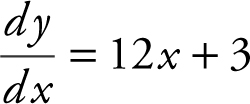 sec x tan x .
sec x tan x .
Example 2
Find f ′(x ) if f (x ) = cot(4x – 6).
Using the chain rule, let u = 4x – 6. Then f ′(x ) = [– csc2 (4x – 6)][4] = –4 csc2 (4x – 6).
Or using your calculator, enter d (1/tan(4x – 6), x ) and obtain  which is an equivalent form.
which is an equivalent form.
Example 3
Find f ′(x ) if f (x ) = 8 sin(x 2 ).
Using the chain rule, let u = x 2 . Then f ′(x ) = [8 cos(x 2 )][2x ] = 16x cos(x 2 ).
Example 4
If y = sin x cos(2x ), find  .
.
Using the product rule, let u = sin x and v = cos(2x ).
Then  .
.
Example 5
If y = sin[cos(2x )], find  .
.
Using the chain rule, let u = cos(2x ). Then
 .
.
To evaluate  , use the chain rule again by making another u -substitution, this time for 2x . Thus,
, use the chain rule again by making another u -substitution, this time for 2x . Thus,  . Therefore,
. Therefore,  .
.
Example 6
Find f ′(x ) if f (x ) = 5x csc x .
Using the product rule, let u = 5x and v = csc x . Then f ′(x ) = 5 csc x + (– csc x cot x ) (5x ) = 5 csc x – 5x (csc x )(cot x ).
Example 7
If  , find
, find  .
.
Rewrite  as y = (sin x ) 1/2 . Using the chain rule, let u = sin x . Thus,
as y = (sin x ) 1/2 . Using the chain rule, let u = sin x . Thus, 
 .
.
Example 8
If  , find
, find  .
.
Using the quotient rule, let u = tan x and v = (1 + tan x ). Then,

Note: For all of the above exercises, you can find the derivatives by using a calculator, provided that you are permitted to do so.
Derivatives of Inverse Trigonometric Functions
Summary of Derivatives of Inverse Trigonometric Functions
Let u be a differentiable function of x , then

Note that the derivatives of cos–1 x , cot–1 x , and csc–1 x all have a “–1” in their numerators.
Example 1
If y = 5 sin–1 (3x ), find  .
.
Let u = 3x . Then  .
.
Or using a calculator, enter d [5 sin–1 (3x ), x ] and obtain the same result.
Example 2
Find f ′(x )  .
.
Let 
Example 3
If y = sec–1 (3x 2 ), find  .
.
Let u = 3x 2 . Then  .
.
Example 4
If  .
.
Note: For all of the above exercises, you can find the derivatives by using a calculator, provided that you are permitted to do so.
Derivatives of Exponential and Logarithmic Functions
Summary of Derivatives of Exponential and Logarithmic Functions
Let u be a differentiable function of x , then
 .
.
For the following examples, find  and verify your result with a calculator.
and verify your result with a calculator.
Example 1
y = e 3x + 5xe 3 + e 3
 (Note that e 3 is a constant.)
(Note that e 3 is a constant.)
Example 2
y = xex – x 2 ex
Using the product rule for both terms, you have

Example 3
y = 3sin x
Let u = sin x . Then,  .
.
Example 4
y = e (x 3 )
Let u = x 3 . Then,  .
.
Example 5
y = (ln x )5
Let u = ln x . Then,  .
.
Example 6
y = ln(x 2 + 2x – 3) + ln 5
Let u = x 2 + 2x – 3. Then,  .
.
(Note that ln 5 is a constant. Thus the derivative of ln 5 is 0.)
Example 7
y = 2x ln x + x
Using the product rule for the first term,
you have  (2x ) + 1 = 2 ln x + 2 + 1 = 2 ln x + 3.
(2x ) + 1 = 2 ln x + 2 + 1 = 2 ln x + 3.
Example 8
y = ln(ln x )
Let u = ln x . Then  .
.
Example 9
y = log5 (2x + 1)
Let u = 2x + 1. Then  .
.
Example 10
Write an equation of the line tangent to the curve of y = ex at x = 1.
The slope of the tangent to the curve y = ex at x = 1 is equivalent to the value of the derivative of y = e x evaluated at x = 1. Using your calculator, enter d (e ∧ (x ), x )|x = 1 and obtain e . Thus, m = e , the slope of the tangent to the curve at x = 1. At x = 1, y = e 1 = e , and thus the point on the curve is (1, e ). Therefore, the equation of the tangent is y – e = e (x – 1) or y = ex . (See Figure 7.2-1 .)

Figure 7.2-1

• Never leave a multiple-choice question blank. There is no penalty for incorrect answers.
7.3 Implicit Differentiation
Main Concept: Procedure for Implicit Differentiation

Procedure for Implicit Differentiation
Given an equation containing the variables x and y for which you cannot easily solve for y in terms of x , you can find  by doing the following:
by doing the following:
Steps
1: Differentiate each term of the equation with respect to x .
2: Move all terms containing  to the left side of the equation and all other terms to the right side.
to the left side of the equation and all other terms to the right side.
3: Factor out  on the left side of the equation.
on the left side of the equation.
4: Solve for  .
.
Example 1
Find  if y 2 – 7y + x 2 – 4x = 10.
if y 2 – 7y + x 2 – 4x = 10.
Step 1: Differentiate each term of the equation with respect to x . (Note that y is treated as a function of x .) 
Step 2: Move all terms containing  to the left side of the equation and all other terms to the right:
to the left side of the equation and all other terms to the right:  .
.
Step 3: Factor out  .
.
Step 4: Solve for  .
.
Example 2
Given x 3 + y 3 = 6xy , find  .
.
Step 1: Differentiate each term with respect to  .
.
Step 2: Move all  terms to the left side:
terms to the left side:  .
.
Step 3: Factor out  .
.
Step 4: Solve for  .
.
Example 3
Find  if (x + y ) 2 – (x – y ) 2 = x 5 + y 5 .
if (x + y ) 2 – (x – y ) 2 = x 5 + y 5 .
Step 1: Differentiate each term with respect to x :

Distributing 2(x + y ) and –2(x – y ), you have.

Step 2: Move all  terms to the left side:
terms to the left side:

Step 3: Factor out  :
:

Step 4: Solve for  .
.
Example 4
Write an equation of the tangent to the curve x 2 + y 2 + 19 = 2x + 12y at (4, 3). The slope of the tangent to the curve at (4, 3) is equivalent to the derivative  at (4, 3).
at (4, 3).
Using implicit differentiation, you have:

Thus, the equation of the tangent is y – 3 = (1)(x – 4) or y – 3 = x – 4.
Example 5
Find  , if sin(x + y ) = 2x .
, if sin(x + y ) = 2x .
 .
.
7.4 Approximating a Derivative
Given a continuous and differentiable function, you can find the approximate value of a derivative at a given point numerically. Here are two examples.
Example 1
The graph of a function f on [0, 5] is shown in Figure 7.4-1 . Find the approximate value of f ′(3).
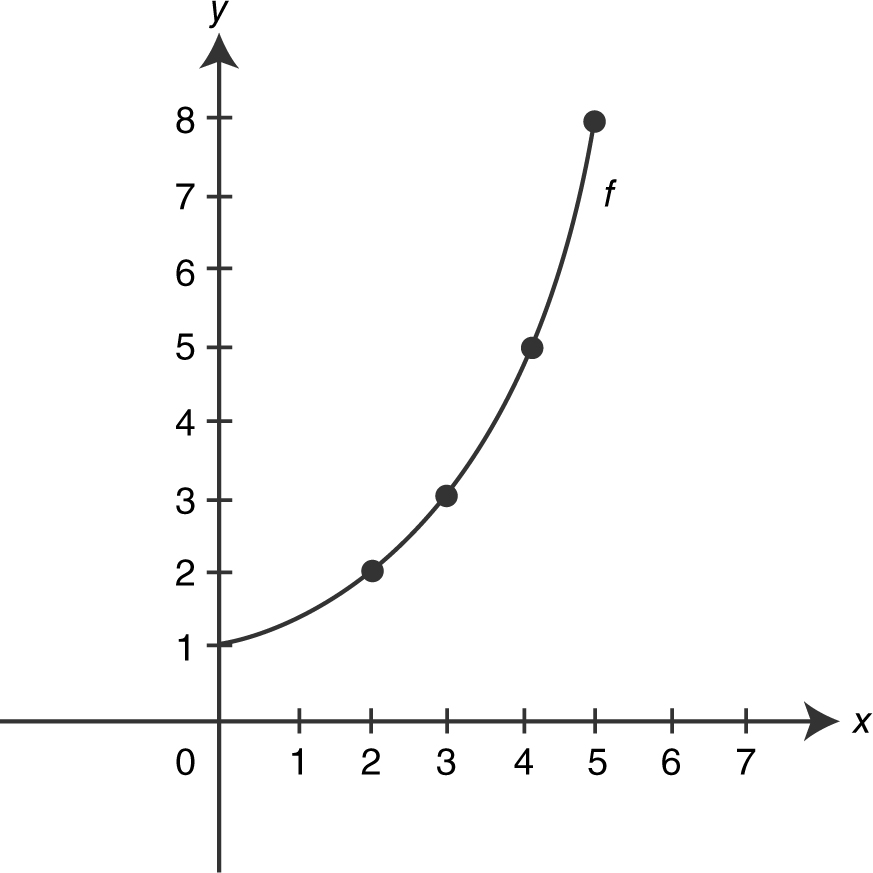
Figure 7.4-1
Since f ′(3) is equivalent to the slope of the tangent to f (x ) at x = 3, there are several ways you can find its approximate value.
Method 1: Use the slope of the line segment joining the points at x = 3 and x = 4.
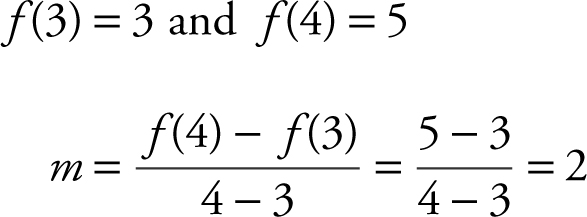
Method 2: Use the slope of the line segment joining the points at x = 2 and x = 3.

Method 3: Use the slope of the line segment joining the points at x = 2 and x = 4.

Note that  is the average of the results from methods 1 and 2.
is the average of the results from methods 1 and 2.
Thus, f ′(3) ≈ 1, 2, or  depending on which line segment you use.
depending on which line segment you use.
Example 2
Let f be a continuous and differentiable function. Selected values of f are shown below. Find the approximate value of f ′ at x = 1.

You can use the difference quotient  to approximate f ′(a ).
to approximate f ′(a ).

Or, you can use the symmetric difference quotient  to approximate f ′(a ).
to approximate f ′(a ).

Thus, f ′(3) ≈ 0.49, 0.465, 0.54, or 0.63 depending on your method.
Note that f is decreasing on (–2, –1) and increasing on (–1, 3). Using the symmetric difference quotient with h = 3 would not be accurate. (See Figure 7.4-2 .)
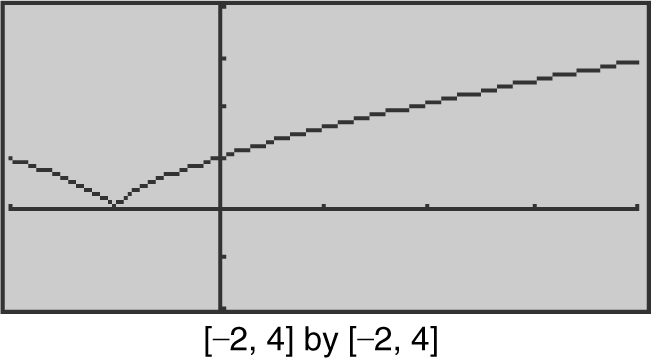
Figure 7.4-2

• Remember that the  because the
because the  .
.
7.5 Derivatives of Inverse Functions
Let f be a one-to-one differentiable function with inverse function f –1 . If f ′(f –1 (a )) ≠ 0, then the inverse function f –1 is differentiable at a and (f –1 )′(a ) =  . (See Figure 7.5-1 .)
. (See Figure 7.5-1 .)

Figure 7.5-1
If y = f –1 (x ) so that x = f (y ), then  with
with  .
.
Example 1
If f (x ) = x 3 + 2x – 10, find (f –1 )′(x ).
Step 1: Check if (f –1 )′(x ) exists. f ′(x ) = 3x 2 + 2 and f ′(x ) > 0 for all real values of x . Thus, f (x ) is strictly increasing which implies that f (x ) is 1 – 1. Therefore, (f –1 )′(x ) exists.
Step 2: Let y = f (x ) and thus y = x 3 + 2x – 10.
Step 3: Interchange x and y to obtain the inverse function x = y 3 + 2y – 10.
Step 4: Differentiate with respect to 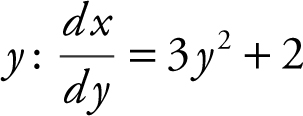 .
.
Step 5: Apply formula 
Example 2
Example 1 could have been done by using implicit differentiation.
Step 1: Let y = f (x ), and thus y = x 3 + 2x – 10.
Step 2: Interchange x and y to obtain the inverse function x = y 3 + 2y – 10.
Step 3: Differentiate each term implicitly with respect to x .

Step 4: Solve for  .
.

Example 3
If f (x ) = 2x 5 + x 3 + 1, find (a) f ′(1) and f ′(1) and (b) (f –1 )(4) and (f –1 )′(4).
Enter y 1 = 2x 5 + x 3 + 1. Since y 1 is strictly increasing, f (x ) has an inverse.
(a) f (1) = 2(1)5 + (1)3 + 1 = 4
f ′(x ) = 10x 4 + 3x 2
f ′(1) = 10(1)4 + 3(1)2 = 13
(b) Since f (1) = 4 implies the point (1, 4) is on the curve f (x ) = 2x 5 + x 3 + 1, therefore, the point (4, 1) (which is the reflection of (1, 4) on y = x ) is on the curve (f –1 )(x ). Thus, (f –1 )(4) = 1.

Example 4
If f (x ) = 5x 3 + x + 8, find (f –1 )′(8).
Enter y 1 = 5x 3 + x + 8. Since y 1 is strictly increasing near x = 8, f (x ) has an inverse near x = 8.
Note that f (0) = 5(0)3 + 0 + 8 = 8 which implies the point (0, 8) is on the curve of f (x ).
Thus, the point (8, 0) is on the curve of (f –1 )(x ).

Therefore, 

• You do not have to answer every question correctly to get a 5 on the AP Calculus AB exam. But always select an answer to a multiple-choice question. There is no penalty for incorrect answers.
7.6 Higher Order Derivatives
If the derivative f ′ of a function f is differentiable, then the derivative of f ′ is the second derivative of f represented by f ″ (reads as f double prime). You can continue to differentiate f as long as there is differentiability.
Some of the Symbols of Higher Order Derivatives

Note that  .
.
Example 1
If y = 5x 3 + 7x – 10, find the first four derivatives.

Example 2
If  , find f ″ (4).
, find f ″ (4).
Rewrite:  and differentiate:
and differentiate:  .
.
Differentiate again:

Example 3
If y = x cos x , find y ″.

Or, you can use a calculator and enter d [x ∗ cos x , x , 2] and obtain the same result.
7.7 L’Hôpital’s Rule for Indeterminate Forms
Let lim represent one of the limits:  or
or  . Suppose f (x ) and g (x ) are differentiable and g ′(x ) = 0 near c , except possibly at c , and suppose lim f (x ) = 0 and lim g (x ) = 0. Then the
. Suppose f (x ) and g (x ) are differentiable and g ′(x ) = 0 near c , except possibly at c , and suppose lim f (x ) = 0 and lim g (x ) = 0. Then the  is an indeterminate form of the type
is an indeterminate form of the type  . Also, if lim f (x ) = ±∞ and lim g (x ) = ±∞, then the
. Also, if lim f (x ) = ±∞ and lim g (x ) = ±∞, then the  , is an indeterminate form of the type
, is an indeterminate form of the type  . In both cases,
. In both cases,  and
and  , L’Hôpital’s Rule states that lim = lim
, L’Hôpital’s Rule states that lim = lim  .
.
Example 1
Find lim  , if it exists.
, if it exists.
Since 
 , this limit is an indeterminate form. Taking the derivatives,
, this limit is an indeterminate form. Taking the derivatives,  and
and  . By L’Hôpital’s Rule,
. By L’Hôpital’s Rule, 
 .
.
Example 2
Find  , if it exists.
, if it exists.
Rewriting  as
as  shows that the limit is an indeterminate form, since
shows that the limit is an indeterminate form, since  and
and  . Differentiating and applying L’Hôpital’s Rule means that
. Differentiating and applying L’Hôpital’s Rule means that  . Unfortunately, this new limit is also indeterminate. However, it is possible to apply L’Hôpital’s Rule again, so
. Unfortunately, this new limit is also indeterminate. However, it is possible to apply L’Hôpital’s Rule again, so  equals to
equals to  . This expression approaches zero as x becomes large, so
. This expression approaches zero as x becomes large, so  .
.
7.8 Rapid Review
1. If y = ex 3 , find  .
.
Answer: Using the chain rule,  .
.
2. Evaluate  .
.
Answer: The limit is equivalent to  .
.
3. Find f ′(x ) if f (x ) = ln(3x ).
Answer:  .
.
4. Find the approximate value of f ′(3). (See Figure 7.8-1 .)

Figure 7.8-1
Answer: Using the slope of the line segment joining (2, 1) and (4, 3),  .
.
5. Find  if xy = 5x 2 .
if xy = 5x 2 .
Answer: Using implicit differentiation,  . Thus,
. Thus, 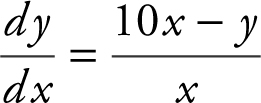 .
.
Or simply solve for y leading to y = 5x and thus,  .
.
6. If  , find
, find  .
.
Answer: Rewrite y = 5x - 2. Then, =  and
and  .
.
7. Using a calculator, write an equation of the line tangent to the graph f (x ) = –2x 4 at the point where f ′(x ) = –1.
Answer: f ′(x ) = –8x 3 . Using a calculator, enter [Solve ] [–8x ∧ 3 =-1, x ] and obtain  . Using the calculator
. Using the calculator  . Thus, tangent is
. Thus, tangent is  .
.
8. 
Answer : Since  consider
consider  .
.
9. 
Answer : Since  consider
consider  .
.
7.9 Practice Problems
Part A The use of a calculator is not allowed.
Find the derivative of each of the following functions.
1 . y = 6x 5 – x + 10
2 . 
3 . 
4 . 
5 . f (x ) = (3x – 2)5 (x 2 – 1)
6 . 
7 . y = 10 cot(2x – 1)
8 . y = 3x sec(3x )
9 . y = 10 cos[sin(x 2 – 4)]
10 . y = 8 cos–1 (2x )
11 . y = 3e 5 + 4xe x
12 . y = ln(x 2 + 3)
Part B Calculators are allowed.
13 . Find  , if x 2 + y 3 = 10 – 5xy .
, if x 2 + y 3 = 10 – 5xy .
14 . The graph of a function f on [1, 5] is shown in Figure 7.9-1 . Find the approximate value of f ′(4).

Figure 7.9-1
15 . Let f be a continuous and differentiable function. Selected values of f are shown below. Find the approximate value of f ′ at x = 2.

16 . If f (x ) = x 5 + 3x – 8, find (f –1 )′(–8).
17 . Write an equation of the tangent to the curve y = ln x at x = e .
18 . If y = 2x sin x , find  at
at  .
.
19 . If the function f (x ) = (x – 1)2 /3 + 2, find all points where f is not differentiable.
20 . Write an equation of the normal line to the curve x cos y = 1 at  .
.
21 . 
22 . 
23 . 
24 . 
25 . 
7.10 Cumulative Review Problems
(Calculator) indicates that calculators are permitted.
26 . Find 
27 . If f (x ) = cos2 (π – x ), find f ′(0).
28 . Find  .
.
29 . (Calculator) Let f be a continuous and differentiable function. Selected values of f are shown below. Find the approximate value of f ′ at x = 2.

30 . (Calculator) If  determine if f (x ) is continuous at (x = 3). Explain why or why not.
determine if f (x ) is continuous at (x = 3). Explain why or why not.
7.11 Solutions to Practice Problems
Part A The use of a calculator is not allowed.
1 . Applying the power rule, 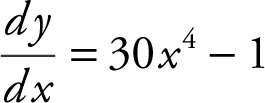 .
.
2 . Rewrite  as f (x ) = x –1 + x –2/3 . Differentiate:
as f (x ) = x –1 + x –2/3 . Differentiate:  .
.
3 . Rewrite  .
.
Differentiate:  .
.
An alternate method is to differentiate  directly, using the quotient rule.
directly, using the quotient rule.
4 . Applying the quotient rule,

5 . Applying the product rule, u = (3x – 2)5 and v = (x 2 – 1), and then the chain rule,

6 . Rewrite  as.
as.
Applying first the chain rule and then the quotient rule,
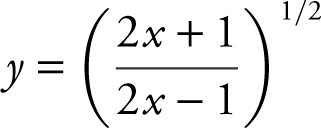
Note:  ,
,
if  which implies
which implies  or
or  .
.
Another method is to write 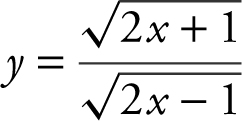 and use the product rule.
and use the product rule.
Another method is to write y = (2x + 1)1/2 (2x – 1)1/2 and use the product rule.
7 . Let u = 2x – 1,

8 . Using the product rule,

9 . Using the chain rule, let u = sin(x 2 – 4).

10 . Using the chain rule, let u = 2x .

11 . Since 3e 5 is a constant, its derivative is 0.

12 . Let 
Part B Calculators are allowed.
13 . Using implicit differentiation, differentiate each term with respect to x .

14 . Since f ′(4) is equivalent to the slope of the tangent to f (x ) at x = 4, there are several ways you can find its approximate value.
Method 1: Use the slope of the line segment joining the points at x = 4 and x = 5.

Method 2: Use the slope of the line segment joining the points at x = 3 and x = 4.

Method 3: Use the slope of the line segment joining the points at x = 3 and x = 5.

Note that –2 is the average of the results from methods 1 and 2. Thus f ′(4) ≈ –3, –1, or –2 depending on which line segment you use.
15 . You can use the difference quotient  to approximate f ′(a ). Let h = 1;
to approximate f ′(a ). Let h = 1; 
 .
.
Or, you can use the symmetric difference quotient  to approximate f ′(a ).
to approximate f ′(a ).
Let h = 1; 
 .
.
Thus, f ′(2) ≈ 4 or 5 depending on your method.
16 . Enter y 1 = x 5 + 3x – 8. The graph of y 1 is strictly increasing. Thus f (x ) has an inverse. Note that f (0) = –8. Thus the point (0, –8) is on the graph of f (x ) which implies that the point (–8, 0) is on the graph of f – 1(x ).
f ′(x ) = 5x 4 + 3 and f ′(0) = 3.
Since  , thus
, thus 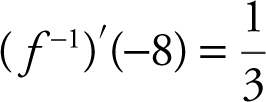 .
.
17 .  and
and  Thus the slope of the tangent to y = ln x at x = e is
Thus the slope of the tangent to y = ln x at x = e is  . At x = e , y = ln x = ln e = 1, which means the point (e ,1) is on the curve of y = ln x . Therefore, an equation of the tangent is
. At x = e , y = ln x = ln e = 1, which means the point (e ,1) is on the curve of y = ln x . Therefore, an equation of the tangent is  or
or  See Figure 7.11-1 .
See Figure 7.11-1 .
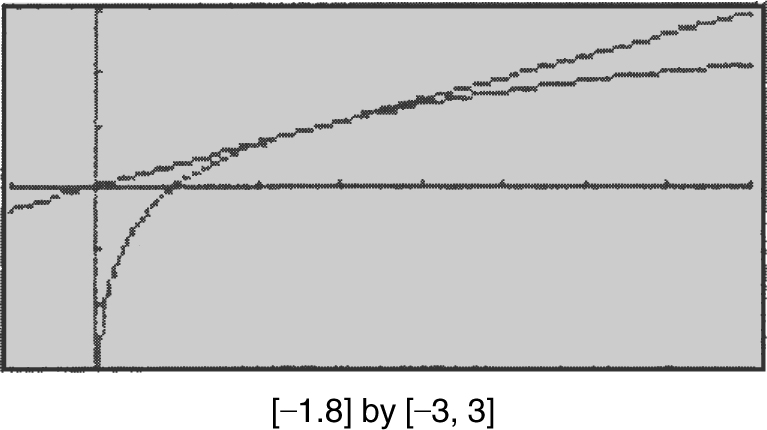
Figure 7.11-1
18 . 

Or, using a calculator, enter d (2x – sin(x ), x , 2)  and obtain –π .
and obtain –π .
19 . Enter y 1 = (x – 1)2 /3 + 2 in your calculator. The graph of y 1 forms a cusp at x = 1. Therefore, f is not differentiable at x = 1.
20 . Differentiate with respect to x :

Thus, the slope of the tangent to the curve at (2, π /3) is  The slope of the normal line to the curve at (2, π /3) is
The slope of the normal line to the curve at (2, π /3) is  . Therefore an equation of the normal line is
. Therefore an equation of the normal line is  .
.
21 . 
22 . 
23 . 
24 . 
25 . 
7.12 Solutions to Cumulative Review Problems
26 . The expression  the derivative of sin x at x = π /2 which is the slope of the tangent to sin x at x = π /2. The tangent to sin x at x = π /2 is parallel to the x -axis.
the derivative of sin x at x = π /2 which is the slope of the tangent to sin x at x = π /2. The tangent to sin x at x = π /2 is parallel to the x -axis.
Therefore the slope is 0, i.e.,  . An alternate method is to expand sin
. An alternate method is to expand sin 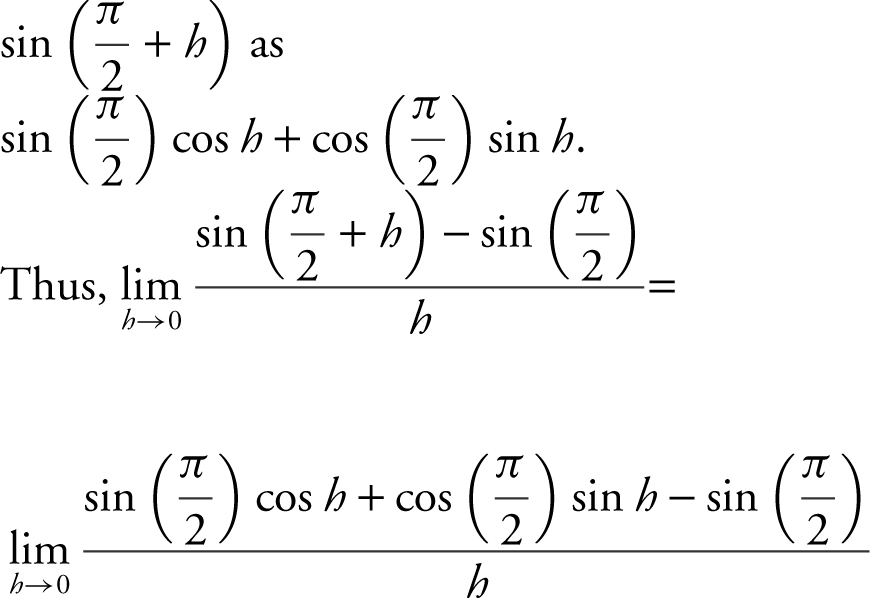 .
.

27 . Using the chain rule, let u = (π – x ).
Then, 
28 . Since the degree of the polynomial in the denominator is greater than the degree of the polynomial in the numerator, the limit is 0.
29 . You can use the differencequotient  to approximate f ′(a ).
to approximate f ′(a ).

Or, you can use the symmetric difference quotient  to approximate f ′(a ).
to approximate f ′(a ).

Thus, f ′(2) = 1.7, 2.05, or 1.25 depending on your method.
30 . (See Figure 7.12–1 .) Checking the three conditions of continuity:
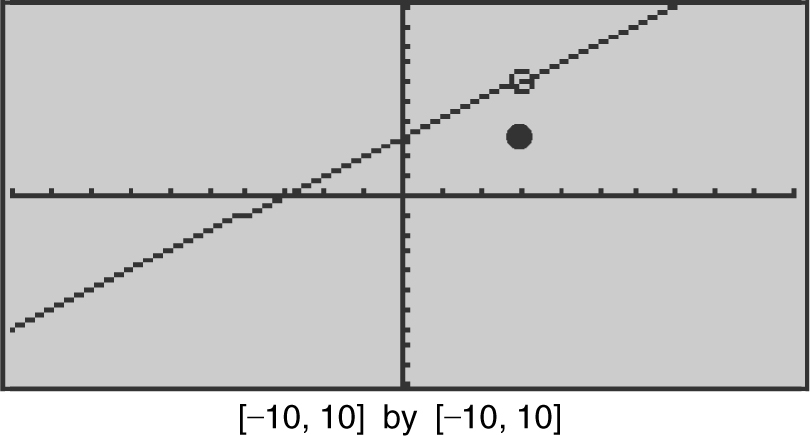
Figure 7.12-1
(1) f (3) = 3
(2) 
(3) Since  , f (x ) is discontinuous at x = 3.
, f (x ) is discontinuous at x = 3.
CHAPTER 8
Big Idea 2: Derivatives
Graphs of Functions and Derivatives
IN THIS CHAPTER
Summary: Many questions on the AP Calculus AB exam involve working with graphs of a function and its derivatives. In this chapter, you will learn how to use derivatives both algebraically and graphically to determine the behavior of a function. Applications of Rolle’s Theorem, the Mean Value Theorem, and the Extreme Value Theorem are also shown.

Key Ideas
 Rolle’s Theorem, Mean Value Theorem, and Extreme Value Theorem
Rolle’s Theorem, Mean Value Theorem, and Extreme Value Theorem
 Test for Increasing and Decreasing Functions
Test for Increasing and Decreasing Functions
 First and Second Derivative Tests for Relative Extrema
First and Second Derivative Tests for Relative Extrema
 Test for Concavity and Point of Inflection
Test for Concavity and Point of Inflection
 Curve Sketching
Curve Sketching
 Graphs of Derivatives
Graphs of Derivatives
8.1 Rolle’s Theorem, Mean Value Theorem, and Extreme Value Theorem
Main Concepts: Rolle’s Theorem, Mean Value Theorem, Extreme Value Theorem

• Set your calculator to Radians and change it to Degrees if/when you need to. Do not forget to change it back to Radians after you have finished using it in Degrees.
Rolle’s Theorem
If f is a function that satisfies the following three conditions:
1. f is continuous on a closed interval [a , b ]
2. f is differentiable on the open interval (a , b )
3. f (a ) = f (b ) = 0
then there exists a number c in (a , b ) such that f ′(c ) = 0. (See Figure 8.1-1 .)

Figure 8.1-1
Note that if you change condition 3 from f (a ) = f (b ) = 0 to f (a ) = f (b ), the conclusion of Rolle’s Theorem is still valid.
Mean Value Theorem
If f is a function that satisfies the following conditions:
1. f is continuous on a closed interval [a , b ]
2. f is differentiable on the open interval (a , b )
then there exists a number c in (a , b ) such that  . (See Figure 8.1-2 .)
. (See Figure 8.1-2 .)
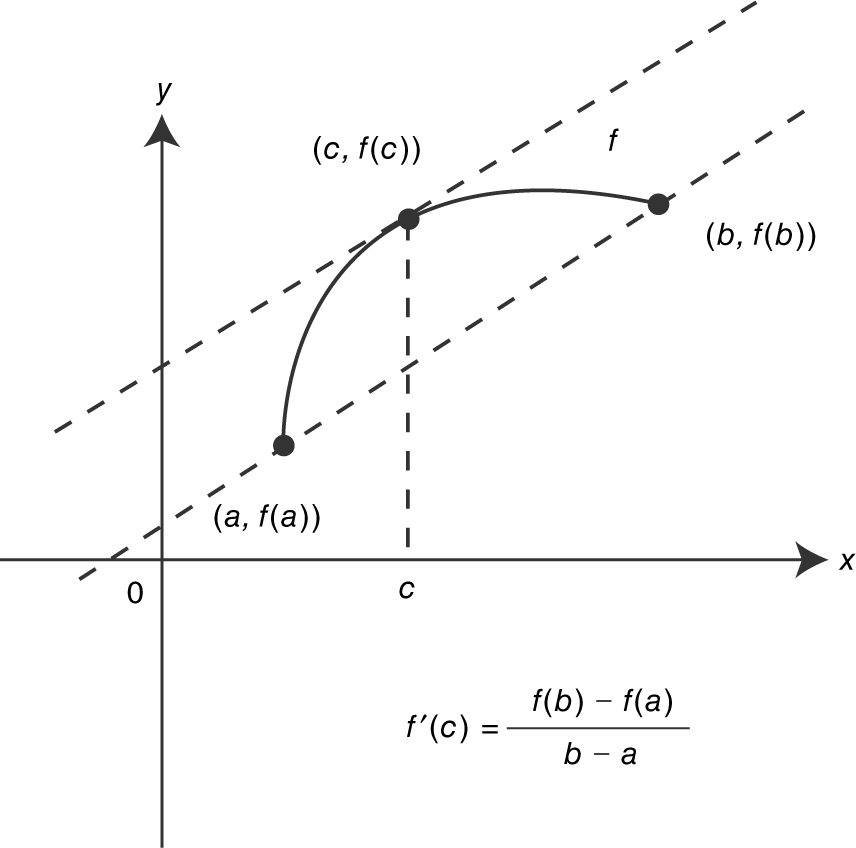
Figure 8.1-2
Example 1
If f (x ) = x 2 + 4x – 5, show that the hypotheses of Rolle’s Theorem are satisfied on the interval [–4, 0] and find all values of c that satisfy the conclusion of the theorem. Check the three conditions in the hypotheses of Rolle’s Theorem:
(1) f (x ) = x 2 + 4x – 5 is continuous everywhere since it is polynomial.
(2) The derivative f ′(x ) = 2x + 4 is defined for all numbers and thus is differentiable on (–4, 0).
(3) f (0) = f (–4) = –5. Therefore, there exists a c in (–4, 0) such that f ′(c ) = 0. To find c , set f ′(x ) = 0. Thus, 2x + 4 = 0 ⇒ x = –2, i.e., f ′(–2) = 0. (See Figure 8.1-3 .)

Figure 8.1-3
Example 2
Let  . Using Rolle’s Theorem, show that there exists a number c in the domain of f such that f ′(c ) = 0. Find all values of c .
. Using Rolle’s Theorem, show that there exists a number c in the domain of f such that f ′(c ) = 0. Find all values of c .
Note f (x ) is a polynomial and thus f (x ) is continuous and differentiable everywhere.
Enter  . The zeros of y 1 are approximately –2.3, 0.9, and 2.9 i.e., f (–2.3) = f (0.9) = f (2.9) = 0. Therefore, there exists at least one c in the interval (–2.3, 0.9) and at least one c in the interval (0.9, 2.9) such that f ′(c ) = 0. Use d [Differentiate ] to find f ′(x ): f ′(x ) = x 2 – x – 2. Set f ′(x ) = 0 ⇒ x 2 – x – 2 = 0 or (x – 2)(x + 1) = 0.
. The zeros of y 1 are approximately –2.3, 0.9, and 2.9 i.e., f (–2.3) = f (0.9) = f (2.9) = 0. Therefore, there exists at least one c in the interval (–2.3, 0.9) and at least one c in the interval (0.9, 2.9) such that f ′(c ) = 0. Use d [Differentiate ] to find f ′(x ): f ′(x ) = x 2 – x – 2. Set f ′(x ) = 0 ⇒ x 2 – x – 2 = 0 or (x – 2)(x + 1) = 0.
Thus, x = 2 or x = –1, which implies f ′(2) = 0 and f ′(–1) = 0. Therefore, the values of c are –1 and 2. (See Figure 8.1-4 .)

Figure 8.1-4
Example 3
The points P (1, 1) and Q (3, 27) are on the curve f (x ) = x 3 . Using the Mean Value Theorem, find c in the interval (1, 3) such that f ′(c ) is equal to the slope of the secant  .
.
The slope of secant  is
is  . Since f (x ) is defined for all real numbers, f (x ) is continuous on [1, 3]. Also f ′(x ) = 3x 2 is defined for all real numbers. Thus, f (x ) is differentiable on (1, 3). Therefore, there exists a number c in (1, 3) such that f ′(c ) = 13.
. Since f (x ) is defined for all real numbers, f (x ) is continuous on [1, 3]. Also f ′(x ) = 3x 2 is defined for all real numbers. Thus, f (x ) is differentiable on (1, 3). Therefore, there exists a number c in (1, 3) such that f ′(c ) = 13.
Set f ′(c ) = 13 ⇒ 3(c )2 = 13 or  . Since only
. Since only  is in the interval (1, 3),
is in the interval (1, 3),  . (See Figure 8.1-5 .)
. (See Figure 8.1-5 .)

Figure 8.1-5
Example 4
Let f be the function f (x ) = (x – 1)2/3 . Determine if the hypotheses of the Mean Value Theorem are satisfied on the interval [0, 2], and if so, find all values of c that satisfy the conclusion of the theorem.
Enter y 1 = (x – 1)2/3 . The graph y 1 shows that there is a cusp at x = 1. Thus, f (x ) is not differentiable on (0, 2) which implies there may or may not exist a c in (0, 2) such that  . The derivative
. The derivative  and
and  . Set
. Set  . Note that f is not differentiable (a + x = 1). Therefore, c does not exist. (See Figure 8.1-6 .)
. Note that f is not differentiable (a + x = 1). Therefore, c does not exist. (See Figure 8.1-6 .)

Figure 8.1-6

• The formula for finding the area of an equilateral triangle is  where s is the length of a side. You might need this to find the volume of a solid whose cross sections are equilateral triangles.
where s is the length of a side. You might need this to find the volume of a solid whose cross sections are equilateral triangles.
Extreme Value Theorem
If f is a continuous function on a closed interval [a , b ], then f has both a maximum and a minimum value on the interval.
Example 1
If f (x ) = x 3 + 3x 2 – 1, find the maximum and minimum values of f on [– 2, 2]. Since f (x ) is a polynomial, it is a continuous function everywhere. Enter y 1 = x 3 + 3x 2 – 1. The graph of y 1 indicates that f has a minimum of –1 at x = 0 and a maximum value of 19 at x = 2. (See Figure 8.1-7 .)
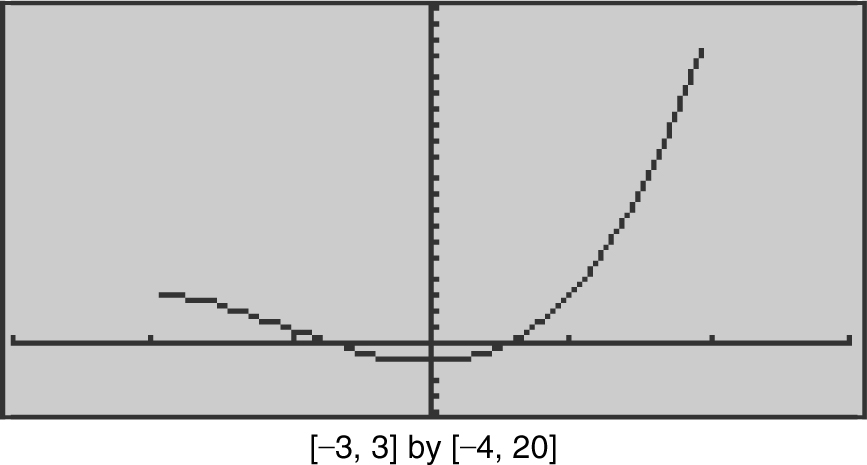
Figure 8.1-7
Example 2
If 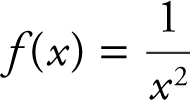 , find any maximum and minimum values of f on [0, 3]. Since f (x ) is a rational function, it is continuous everywhere except at values where the denominator is 0. In this case, at x = 0, f (x ) is undefined. Since f (x ) is not continuous on [0, 3], the Extreme Value Theorem may not be applicable. Enter
, find any maximum and minimum values of f on [0, 3]. Since f (x ) is a rational function, it is continuous everywhere except at values where the denominator is 0. In this case, at x = 0, f (x ) is undefined. Since f (x ) is not continuous on [0, 3], the Extreme Value Theorem may not be applicable. Enter  . The graph of y 1 shows that as x → 0+ , f (x ) increases without bound (i.e., f (x ) goes to infinity). Thus, f has no maximum value. The minimum value occurs at the endpoint x = 3 and the minimum value is
. The graph of y 1 shows that as x → 0+ , f (x ) increases without bound (i.e., f (x ) goes to infinity). Thus, f has no maximum value. The minimum value occurs at the endpoint x = 3 and the minimum value is  . (See Figure 8.1-8 .)
. (See Figure 8.1-8 .)

Figure 8.1-8
8.2 Determining the Behavior of Functions
Main Concepts: Test for Increasing and Decreasing Functions, First Derivative Test and Second Derivative Test for Relative Extrema, Test for Concavity and Points of Inflection
Test for Increasing and Decreasing Functions
Let f be a continuous function on the closed interval [a , b ] and differentiable on the open interval (a , b ).
1. If f ′(x ) > 0 on (a , b ), then f is increasing on [a , b ].
2. If f ′(x ) < 0 on (a , b ), then f is decreasing on [a , b ].
3. If f ′(x ) = 0 on (a , b ), then f is constant on [a , b ].
Definition: Let f be a function defined at a number c . Then c is a critical number of f if either f ′(c ) = 0 or f ′ (c ) does not exist. (See Figure 8.2-1 .)

Figure 8.2-1
Example 1
Find the critical numbers of f (x ) = 4x 3 + 2x 2 .
To find the critical numbers of f (x ), you have to determine where f ′(x ) = 0 and where f ′(x ) does not exist. Note f ′(x ) = 12x 2 + 4x , and f ′(x ) is defined for all real numbers. Let f ′(x ) = 0 and thus 12x 2 + 4x = 0, which implies 4x (3x + 1) = 0 ⇒ x = –1/3 or x = 0. Therefore, the critical numbers of f are 0 and –1/3. (See Figure 8.2-2 .)

Figure 8.2-2
Example 2
Find the critical numbers of f (x ) = (x – 3)2/5 .
 . Note that f ′(x ) is undefined at x = 3 and that f ′(x ) ≠ 0. Therefore, 3 is the only critical number of f . (See Figure 8.2-3 .)
. Note that f ′(x ) is undefined at x = 3 and that f ′(x ) ≠ 0. Therefore, 3 is the only critical number of f . (See Figure 8.2-3 .)

Figure 8.2-3
Example 3
The graph of f ′ on (1, 6) is shown in Figure 8.2-4 . Find the intervals on which f is increasing or decreasing.

Figure 8.2-4
Solution: (See Figure 8.2-5 .)

Figure 8.2-5
Thus, f is decreasing on [1, 2] and [5, 6] and increasing on [2, 5].
Example 4
Find the open intervals on which f (x ) = (x 2 – 9)2/3 is increasing or decreasing.
Step 1: Find the critical numbers of f .

Set f ′(x ) = 0 ⇒ 4x = 0 or x = 0.
Since f ′(x ) is a rational function, f ′(x ) is undefined at values where the denominator is 0. Thus, set x 2 – 9 = 0 ⇒ x = 3 or x = –3. Therefore, the critical numbers are –3, 0, and 3.
Step 2: Determine intervals.

Intervals are (–∞, –3), (–3, 0), (0, 3), and (3, ∞).
Step 3: Set up a table.

Step 4: Write a conclusion. Therefore, f (x ) is increasing on [–3, 0] and [3, ∞) and decreasing on (– ∞, –3] and [0, 3]. (See Figure 8.2-6 .)

Figure 8.2-6
Example 5
The derivative of a function f is given as f ′(x ) = cos(x 2 ). Using a calculator, find the values of x on  such that f is increasing. (See Figure 8.2-7 .)
such that f is increasing. (See Figure 8.2-7 .)

Figure 8.2-7
Using the [Zero ] function of the calculator, you obtain x = 1.25331 is a zero of f ′ on  . Since f ′(x ) = cos(x 2 ) is an even function, x = –1.25331 is also a zero on
. Since f ′(x ) = cos(x 2 ) is an even function, x = –1.25331 is also a zero on  . (See Figure 8.2-8 .)
. (See Figure 8.2-8 .)

Figure 8.2-8
Thus, f is increasing on [–1.2533, 1.2533].

• Be sure to bubble in the right grid. You have to be careful in filling in the bubbles especially when you skip a question.
First Derivative Test and Second Derivative Test for Relative Extrema
First Derivative Test for Relative Extrema
Let f be a continuous function and c be a critical number of f . (Figure 8.2-9 .)

Figure 8.2-9
1. If f ′(x ) changes from positive to negative at x = c (f ′ > 0 for x< c and f ′ < 0 for x > c ), then f has a relative maximum at c .
2. If f ′(x ) changes from negative to positive at x = c (f ′ < 0 for x < c and f ′ > 0 for x > c ), then f has a relative minimum at c .
Second Derivative Test for Relative Extrema
Let f be a continuous function at a number c .
1. If f ′(c ) = 0 and f ″(c ) < 0, then f (c ) is a relative maximum.
2. If f ′(c ) = 0 and f ″(c ) > 0, then f (c ) is a relative minimum.
3. If f ′(c ) = 0 and f ″(c ) = 0, then the test is inconclusive. Use the First Derivative Test.
Example 1
The graph of f ′, the derivative of a function f , is shown in Figure 8.2-10 . Find the relative extrema of f .

Figure 8.2-10
Solution: (See Figure 8.2-11 .)

Figure 8.2-11
Thus, f has a relative maximum at x = –2, and a relative minimum at x = 3.
Example 2
Find the relative extrema for the function  .
.
Step 1: Find f ′(x ).
f ′(x ) = x 2 – 2x – 3
Step 2: Find all critical numbers of f (x ).
Note that f ′(x ) is defined for all real numbers.
Set f ″(x ) = 0: x 2 – 2x – 3 = 0 ⇒ (x – 3)(x + 1) = 0 ⇒ x = 3 or x = –1.
Step 3: Find f ″(x ): f ″ (x ) = 2x – 2.
Step 4: Apply the Second Derivative Test.
f ″(3) = 2(3) – 2 = 4 ⇒ f (3) is a relative minimum.
f ″(–1) = 2(–1) – 2 = –4 ⇒ f (–1) is a relative maximum.
 and
and  .
.
Therefore, –9 is a relative minimum value of f and  is a relative maximum value. (See Figure 8.2-12 .)
is a relative maximum value. (See Figure 8.2-12 .)

Figure 8.2-12
Example 3
Find the relative extrema for the function f (x ) = (x 2 – 1)2/3 .
Using the First Derivative Test
Step 1: Find f ′(x ).

Step 2: Find all critical numbers of f .
Set f ′(x ) = 0. Thus, 4x = 0 or x = 0.
Set x 2 – 1 = 0. Thus, f ′(x ) is undefined at x = 1 and x = –1. Therefore, the critical numbers are –1, 0, and 1.
Step 3: Determine intervals.

The intervals are (–∞, –1), (–1, 0), (0, 1), and (1, ∞).
Step 4: Set up a table.

Step 5: Write a conclusion.
Using the First Derivative Test, note that f (x ) has a relative maximum at x = 0 and relative minimums at x = –1 and x = 1.
Note that f (–1) = 0, f (0) = 1, and f (1) = 0. Therefore, 1 is a relative maximum value and 0 is a relative minimum value. (See Figure 8.2-13 .)

Figure 8.2-13

• Do not forget the constant, C , when you write the antiderivative after evaluating an indefinite integral, e.g., ∫ cos xdx = sin x + C .
Test for Concavity and Points of Inflection
Test for Concavity
Let f be a differentiable function.
1. If f ″ > 0 on an interval I, then f is concave upward on I.
2. If f ″ < 0 on an interval I, then f is concave downward on I.
(See Figures 8.2-14 and 8.2-15 .)
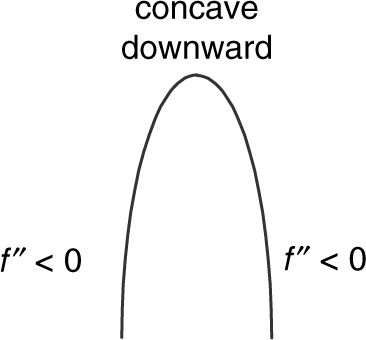
Figure 8.2-14

Figure 8.2-15
Points of Inflection
A point P on a curve is a point of inflection if:
1. the curve has a tangent line at P, and
2. the curve changes concavity at P (from concave upward to downward or from concave downward to upward).
(See Figures 8.2-16 –8.2-18 .)

Figure 8.2-16

Figure 8.2-17

Figure 8.2-18
Note that if a point (a , f (a )) is a point of inflection, then f ″(c ) = 0 or f ″(c ) does not exist. (The converse of the statement is not necessarily true.)
Note: There are some textbooks that define a point of inflection as a point where the concavity changes and do not require the existence of a tangent at the point of inflection. In that case, the point at the cusp in Figure 8.2-18 would be a point of inflection.
Example 1
The graph of f ′, the derivative of a function f , is shown in Figure 8.2-19 . Find the points of inflection of f and determine where the function f is concave upward and where it is concave downward on [–3, 5].

Figure 8.2-19
Solution: (See Figure 8.2-20 .)

Figure 8.2-20
Thus, f is concave upward on [–3, 0) and (3, 5], and is concave downward on (0, 3).
There are two points of inflection: one at x = 0 and the other at x = 3.
Example 2
Using a calculator, find the values of x at which the graph of y = x 2 e x changes concavity.
Enter y 1 = x ∧ 2 ∗ e ∧ x and y 2 = d (y 1(x ), x , 2). The graph of y 2, the second derivative of y , is shown in Figure 8.2-21 . Using the [Zero ] function, you obtain x = –3.41421 and x = –0.585786. (See Figures 8.2-21 and 8.2-22 .)

Figure 8.2-21

Figure 8.2-22
Thus, f changes concavity at x = –3.41421 and x = –0.585786.
Example 3
Find the points of inflection of f (x ) = x 3 – 6x 2 + 12x – 8 and determine the intervals where the function f is concave upward and where it is concave downward.
Step 1: Find f ′(x ) and f ″(x ).
f ′(x ) = 3x 2 – 12x + 12
f ″(x ) = 6x – 12
Step 2: Set f ″(x ) = 0.
6x – 12 = 0
x = 2
Note that f ″(x ) is defined for all real numbers.
Step 3: Determine intervals.

The intervals are (–∞, 2) and (2, ∞).
Step 4: Set up a table.

Since f (x ) has change of concavity at x = 2, the point (2, f (2)) is a point of inflection. f (2) = (2)3 – 6(2)2 + 12(2) – 8 = 0.
Step 5: Write a conclusion.
Thus, f (x ) is concave downward on (–∞, 2), concave upward on (2, ∞), and f (x ) has a point of inflection at (2, 0). (See Figure 8.2-23 .)

Figure 8.2-23
Example 4
Find the points of inflection of f (x ) = (x – 1)2/3 and determine the intervals where the function f is concave upward and where it is concave downward.
Step 1: Find f ′(x ) and f ″(x ).

Step 2: Find all values of x where f ″(x ) = 0 or f ″(x ) is undefined.
Note that f ″(x ) ≠ 0 and that f ″(1) is undefined.
Step 3: Determine intervals.

The intervals are (–∞, 1) and (1, ∞).
Step 4: Set up a table.

Note that since f (x ) has no change of concavity at x = 1, f does not have a point of inflection.
Step 5: Write a conclusion.
Therefore, f (x ) is concave downward on (–∞, ∞) and has no point of inflection. (See Figure 8.2-24 .)

Figure 8.2-24
Example 5
The graph of f is shown in Figure 8.2-25 and f is twice differentiable. Which of the following statements is true?

Figure 8.2-25
(A) f (5) < f ′(5) < f ″(5)
(B) f ″(5) < f ′(5) < f (5)
(C) f ′(5) < f (5) < f ″(5)
(D) f ′(5) < f ″(5) < f (5)
The graph indicates that (1) f (5) = 0; (2) f ′(5) < 0, since f is decreasing; and (3) f ″(5) > 0, since f is concave upward. Thus, f ′(5) < f (5) < f ″(5), choice (C).

• Move on. Do not linger on a problem too long. Make an educated guess. You can earn many more points from other problems.
8.3 Sketching the Graphs of Functions
Main Concepts: Graphing without Calculators, Graphing with Calculators
Graphing without Calculators
General Procedure for Sketching the Graph of a Function

Steps:
1. Determine the domain and if possible the range of the function f (x ).
2. Determine if the function has any symmetry, i.e., if the function is even (f (x ) = f (–x )), odd (f (x ) = –f (–x )), or periodic (f (x + p ) = f (x )).
3. Find f ′(x ) and f ″(x ).
4. Find all critical numbers (f ′(x ) = 0 or f ′(x ) is undefined) and possible points of inflection (f ″(x ) = 0 or f ″(x ) is undefined).
5. Using the numbers in Step 4, determine the intervals on which to analyze f (x ).
6. Set up a table using the intervals, to
(a) determine where f (x ) is increasing or decreasing.
(b) find relative and absolute extrema.
(c) find points of inflection.
(d) determine the concavity of f (x ) on each interval.
7. Find any horizontal, vertical, or slant asymptotes.
8. If necessary, find the x -intercepts, the y -intercepts, and a few selected points.
9. Sketch the graph.
Example 1
Sketch the graph of  .
.
Step 1: Domain: all real numbers x ≠ ± 5.
Step 2: Symmetry: f (x ) is an even function (f (x ) = f (–x )); symmetrical with respect to the y -axis.
Step 3: 
Step 4: Critical numbers:
f ′(x ) = 0 ⇒ –42x = 0 or x = 0
f ′(x ) is undefined at x = ±5 which are not in the domain.
Possible points of inflection:
f ″(x ) ≠ 0 and f ″(x ) is undefined at x = ±5 which are not in the domain.
Step 5: Determine intervals:

Intervals are (–∞, –5), (–5, 0), (0, 5), and (5, ∞).
Step 6: Set up a table:

Step 7: Vertical asymptote: x = 5 and x = –5
Horizontal asymptote: y = 1
Step 8: 
x -intercept: (–2, 0) and (2, 0)
(See Figure 8.3-1 .)

Figure 8.3-1
Graphing with Calculators
Example 1
Using a calculator, sketch the graph of f (x ) = –x 5/3 + 3x 2/3 indicating all relative extrema, points of inflection, horizontal and vertical asymptotes, intervals where f (x ) is increasing or decreasing, and intervals where f (x ) is concave upward or downward.
1. Domain: all real numbers; Range: all real numbers
2. No symmetry
3. Relative maximum: (1.2, 2.03)
Relative minimum: (0, 0)
Points of inflection: (–0.6, 2.56)
4. No asymptote
5. f (x ) is decreasing on (–∞, 0], [1.2, ∞) and increasing on (0, 1.2).
6. Evaluating f ″(x ) on either side of the point of inflection (–0.6, 2.56)

⇒ f (x ) is concave upward on (–∞, –0.6) and concave downward on (–0.6, ∞). (See Figure 8.3-2 .)

Figure 8.3-2
Example 2
Using a calculator, sketch the graph of f (x ) = e –x 2 /2 , indicating all relative minimum and maximum points; points of inflection; vertical and horizontal asymptotes; and intervals on which f (x ) is increasing, decreasing, concave upward, or concave downward.
1. Domain: all real numbers; Range (0, 1]
2. Symmetry: f (x ) is an even function, and thus is symmetrical with respect to the y -axis.
3. Relative maximum: (0, 1)
No relative minimum
Points of inflection: (–1, 0.6) and (1, 0.6)
4. y = 0 is a horizontal asymptote; no vertical asymptote.
5. f (x ) is increasing on (–∞, 0] and decreasing on [0, ∞).
6. f (x ) is concave upward on (–∞, –1) and (1, ∞); and concave downward on (–1, 1).
(See Figure 8.3-3 .)

Figure 8.3-3

• When evaluating a definite integral, you do not have to write a constant C , e.g.,  . Notice, no C .
. Notice, no C .
8.4 Graphs of Derivatives
The functions f , f ′, and f ″ are interrelated, and so are their graphs. Therefore, you can usually infer from the graph of one of the three functions (f , f ′, or f ″) and obtain information about the other two. Here are some examples.
Example 1
The graph of a function f is shown in Figure 8.4-1 . Which of the following is true for f on (a , b )?

Figure 8.4-1
I. f ′ ≥ 0 on (a , b )
II. f ″ > 0 on (a , b )
Solution:
I. Since f is strictly increasing, f ′ ≥ 0 on (a , b ) is true.
II. The graph is concave downward on (a , 0) and upward on (0, b ). Thus, f ″ > 0 on (0, b ) only. Therefore, only statement I is true.
Example 2
Given the graph of f ′ in Figure 8.4-2 , find where the function f : (a) has its relative maximum(s) or relative minimums, (b) is increasing or decreasing, (c) has its point(s) of inflection, (d) is concave upward or downward, and (e) if f (–2) = f (2) = 1 and f (0) = –3, draw a sketch of f .
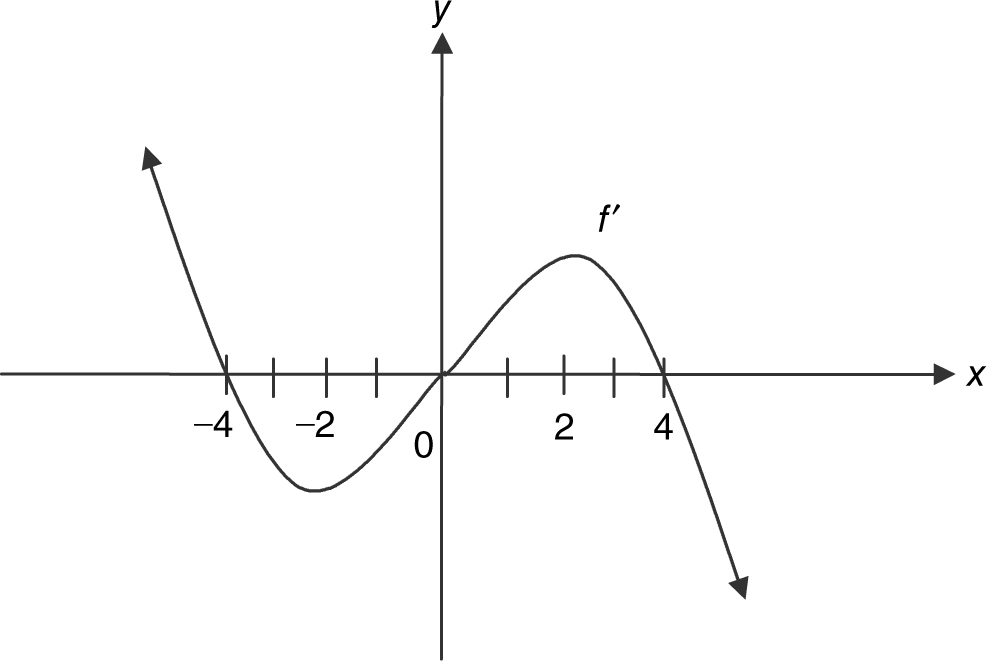
Figure 8.4-2
(a) Summarize the information of f ′ on a number line:

The function f has a relative maximum at x = –4 and at x = 4, and a relative minimum at x = 0.
(b) The function f is increasing on interval (–∞, –4] and [0, 4], and f is decreasing on [–4, 0] and [4, ∞).
(c) Summarize the information of f ″ on a number line:

A change of concavity occurs at x = –2 and at x = 2 and f ′ exists at x = –2 and at x = 2, which implies that there is a tangent line to the graph of f at x = –2 and at x = 2. Therefore, f has a point of inflection at x = –2 and at x = 2.
(d) The graph of f is concave upward on the interval (–2, 2) and concave downward on (–∞, –2) and (2, ∞).
(e) A sketch of the graph of f is shown in Figure 8.4-3 .

Figure 8.4-3
Example 3
Given the graph of f ′ in Figure 8.4-4 , find where the function f (a) has a horizontal tangent, (b) has its relative extrema, (c) is increasing or decreasing, (d) has a point of inflection, and (e) is concave upward or downward.
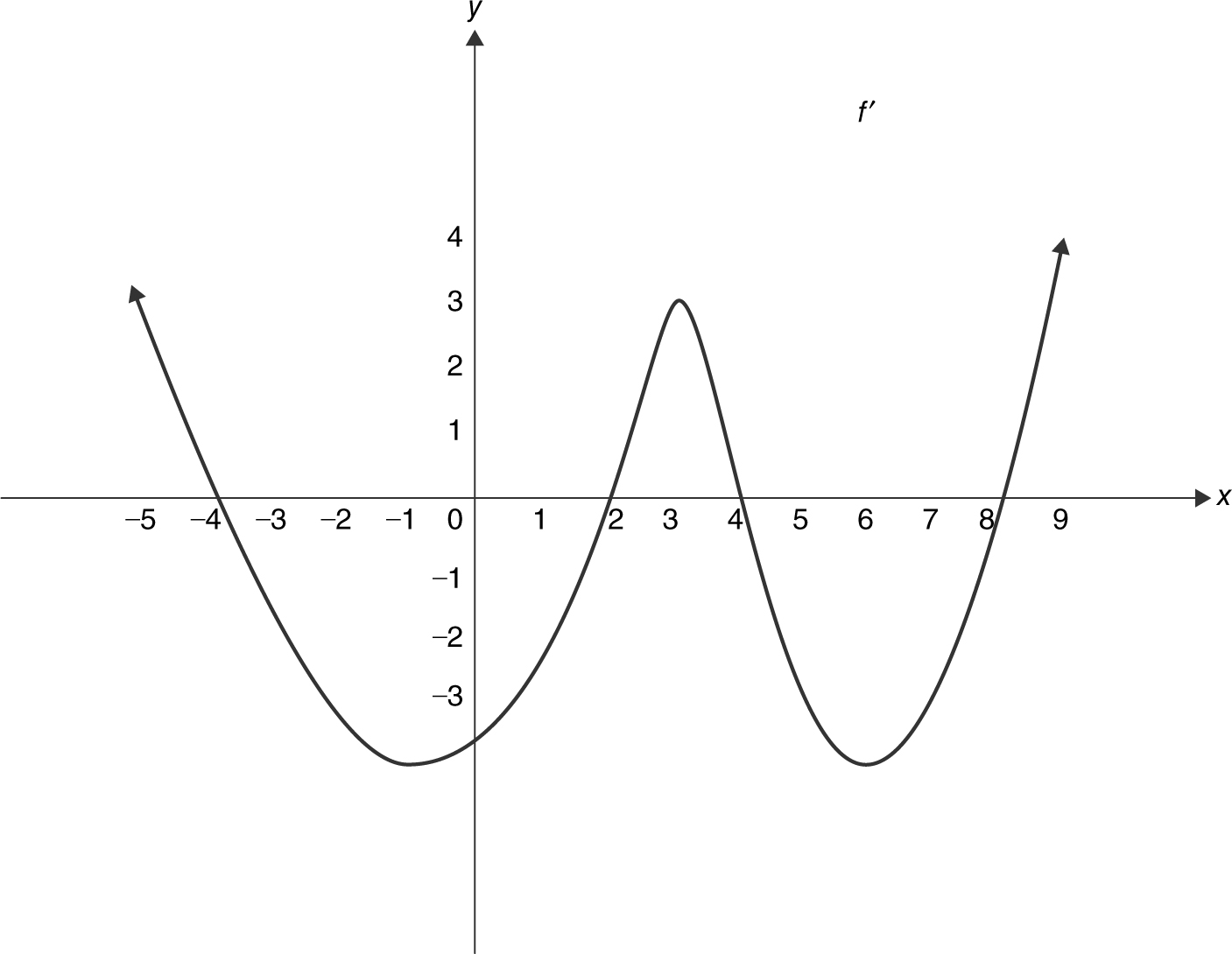
Figure 8.4-4
(a) f ′(x ) = 0 at x = –4, 2, 4, 8. Thus, f has a horizontal tangent at these values.
(b) Summarize the information of f ′ on a number line:

The First Derivative Test indicates that f has relative maximums at x = –4 and 4; and f has relative minimums at x = 2 and 8.
(c) The function f is increasing on (–∞, –4], [2, 4], and [8, ∞) and is decreasing on [–4, 2] and [4, 8].
(d) Summarize the information of f ″ on a number line:

A change of concavity occurs at x = –1, 3, and 6. Since f ′(x ) exists, f has a tangent at every point. Therefore, f has a point of inflection at x = –1, 3, and 6.
(e) The function f is concave upward on (–1, 3) and (6, ∞) and concave downward on (–∞, –1) and (3, 6).
Example 4
A function f is continuous on the interval [–4, 3] with f (–4) = 6 and f (3) = 2 and the following properties:

(a) Find the intervals on which f is increasing or decreasing.
(b) Find where f has its absolute extrema.
(c) Find where f has the points of inflection.
(d) Find the intervals where f is concave upward or downward.
(e) Sketch a possible graph of f .
Solution:
(a) The graph of f is increasing on [1, 3] since f ′ > 0 and decreasing on [–4, –2] and [–2, 1] since f ′ < 0.
(b) At x = –4, f (x ) = 6. The function decreases until x = 1 and increases back to 2 at x = 3. Thus, f has its absolute maximum at x = –4 and its absolute minimum at x = 1.
(c) A change of concavity occurs at x = –2, and since f ′(–2) = 0, which implies a tangent line exists at x = –2, f has a point of inflection at x = –2.
(d) The graph of f is concave upward on (–4, –2) and concave downward on (–2, 1) and (1, 3).
(e) A possible sketch of f is shown in Figure 8.4-5 .

Figure 8.4-5
Example 5
If f (x ) = |ln(x + 1)|, find  . (See Figure 8.4-6 .)
. (See Figure 8.4-6 .)

Figure 8.4-6
The domain of f is (–1, ∞).
f (0) = |ln(0 + 1)| = |ln(1)| = 0


Therefore,  .
.
8.5 Rapid Review
1. If f ′(x ) = x 2 – 4, find the intervals where f is decreasing. (See Figure 8.5-1 .)

Figure 8.5-1
Answer: Since f ′(x ) < 0 if –2 < x < 2, f is decreasing on (–2, 2).
2. If f ″(x ) = 2x – 6 and f ′ is continuous, find the values of x where f has a point of inflection. (See Figure 8.5-2 .)

Figure 8.5-2
Answer: Thus, f has a point of inflection at x = 3.
3. (See Figure 8.5-3 .) Find the values of x where f has change of concavity.

Figure 8.5-3
Answer: f has a change of concavity at x = 0. (See Figure 8.5-4 .)
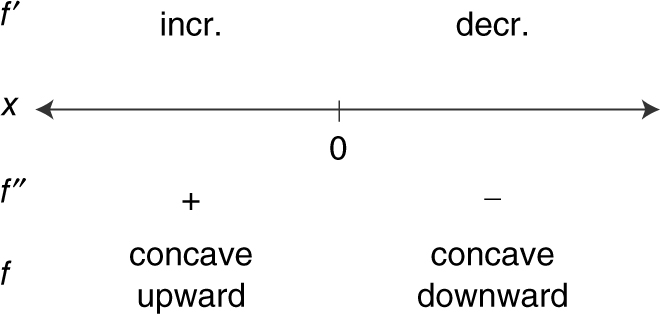
Figure 8.5-4
4. (See Figure 8.5-5 .) Find the values of x where f has a relative minimum.

Figure 8.5-5
Answer: f has a relative minimum at x = –2. (See Figure 8.5-6 .)

Figure 8.5-6
5. (See Figure 8.5-7 .) Given f is twice differentiable, arrange f (10), f ′(10), f ″(10) from smallest to largest.
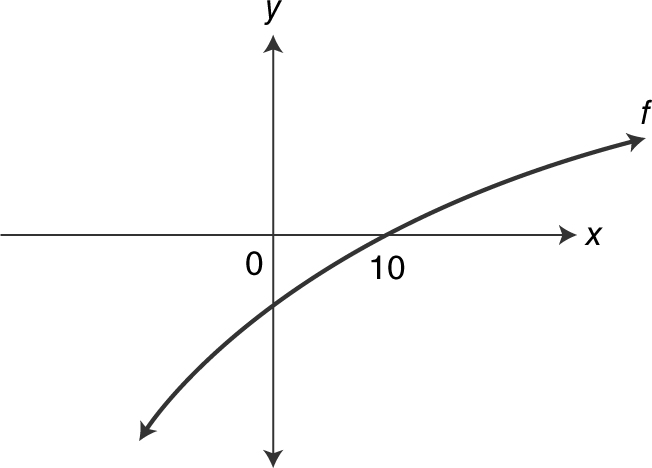
Figure 8.5-7
Answer: f (10) = 0, f ′(10) > 0 since f is increasing, and f ″(10) < 0 since f is concave downward. Thus, the order is f ″(10), f (10), f ′(10).
6. (See Figure 8.5-8 .) Find the values of x where f ′ is concave up.

Figure 8.5-8
Answer: f ′ is concave upward on (–∞, 0). (See Figure 8.5-9 .)

Figure 8.5-9
8.6 Practice Problems
Part A The use of a calculator is not allowed.
1 . If f (x ) = x 3 – x 2 – 2x , show that the hypotheses of Rolle’s Theorem are satisfied on the interval [–1, 2] and find all values of c that satisfy the conclusion of the theorem.
2 . Let f (x ) = e x . Show that the hypotheses of the Mean Value Theorem are satisfied on [0, 1] and find all values of c that satisfy the conclusion of the theorem.
3 . Determine the intervals in which the graph of  is concave upward or downward.
is concave upward or downward.
4 . Given f (x ) = x + sin x 0 ≤ x ≤ 2π , find all points of inflection of f .
5 . Show that the absolute minimum of  on [– 5, 5] is 0 and the absolute maximum is 5.
on [– 5, 5] is 0 and the absolute maximum is 5.
6 . Given the function f in Figure 8.6-1 , identify the points where:
(a) f ′ < 0 and f ″ > 0,
(b) f ′ < 0 and f ″ < 0,
(c) f ′ = 0,
(d) f ″ does not exist.

Figure 8.6-1
7 . Given the graph of f ″ in Figure 8.6-2 , determine the values of x at which the function f has a point of inflection.

Figure 8.6-2
8 . If f ″(x ) = x 2 (x + 3)(x – 5), find the values of x at which the graph of f has a change of concavity.
9 . The graph of f ′ on [–3, 3] is shown in Figure 8.6-3 . Find the values of x on [–3, 3] such that (a) f is increasing and (b) f is concave downward.

Figure 8.6-3
10 . The graph of f is shown in Figure 8.6-4 and f is twice differentiable. Which of the following has the largest value:
(a) f (–1)
(b) f ′(–1)
(c) f ″(–1)
(d) f (–1) and f ′(–1)

Figure 8.6-4
Sketch the graphs of the following functions indicating any relative and absolute extrema, points of inflection, intervals on which the function is increasing, decreasing, concave upward, or concave downward.
11 . f (x ) = x 4 – x 2
12 . 
Part B Calculators are allowed.
13 . Given the graph of f ′ in Figure 8.6-5 , determine at which of the four values of x (x 1 , x 2 , x 3 , x 4 ) f has:
(a) the largest value,
(b) the smallest value,
(c) a point of inflection,
(d) and at which of the four values of x does f ″ have the largest value.

Figure 8.6-5
14 . Given the graph of f in Figure 8.6-6 , determine at which values of x is
(a) f ′(x ) = 0
(b) f ″(x ) = 0
(c) f ′ a decreasing function

Figure 8.6-6
15 . A function f is continuous on the interval [–2, 5] with f (–2) = 10 and f (5) = 6 and the following properties:

(a) Find the intervals on which f is increasing or decreasing.
(b) Find where f has its absolute extrema.
(c) Find where f has points of inflection.
(d) Find the intervals where f is concave upward or downward.
(e) Sketch a possible graph of f .
16 . Given the graph of f ′ in Figure 8.6-7 , find where the function f
(a) has its relative extrema.
(b) is increasing or decreasing.
(c) has its point(s) of inflection.
(d) is concave upward or downward.
(e) if f (0) = 1 and f (6) = 5, draw a sketch of f .

Figure 8.6-7
17 . If f (x ) = |x 2 – 6x – 7|, which of the following statements about f are true?
I. f has a relative maximum at x = 3.
II. f is differentiable at x = 7.
III. f has a point of inflection at x = –1.
18 . How many points of inflection does the graph of y = cos(x 2 ) have on the interval [–π , π ]?
Sketch the graphs of the following functions indicating any relative extrema, points of inflection, asymptotes, and intervals where the function is increasing, decreasing, concave upward, or concave downward.
19 . f (x ) = 3e – x 2 /2
20 . f (x ) = cos x sin2 x [0, 2π ]
8.7 Cumulative Review Problems
(Calculator) indicates that calculators are permitted.
21 . Find  if (x 2 + y 2 )2 = 10xy .
if (x 2 + y 2 )2 = 10xy .
22 . Evaluate 
23 . Find  if y = cos(2x ) + 3x 2 – 1.
if y = cos(2x ) + 3x 2 – 1.
24 . (Calculator) Determine the value of k such that the function
 is continuous
is continuous
for all real numbers.
25 . A function f is continuous on the interval [–1, 4] with f (–1) = 0 and f (4) = 2 and the following properties:

(a) Find the intervals on which f is increasing or decreasing.
(b) Find where f has its absolute extrema.
(c) Find where f has points of inflection.
(d) Find intervals on which f is concave upward or downward.
(e) Sketch a possible graph of f .
8.8 Solutions to Practice Problems
Part A—The use of a calculator is not allowed.
1 . Condition 1: Since f (x ) is a polynomial, it is continuous on [–1, 2].
Condition 2: Also, f (x ) is differentiable on (–1, 2) because f ′(x ) = 3x 2 – 2x – 2 is defined for all numbers in [–1, 2].
Condition 3: f (–1) = f (2) = 0. Thus, f (x ) satisfies the hypotheses of Rolle’s Theorem which means there exists a c in [–1, 2] such that f ′(c ) = 0. Set f ′(x ) = 3x 2 – 2x – 2 = 0. Solve 3x 2 – 2x – 2 = 0, using the quadratic formula and obtain  . Thus, x ≈ 1.215 or –0.549 and both values are in the interval (–1, 2). Therefore,
. Thus, x ≈ 1.215 or –0.549 and both values are in the interval (–1, 2). Therefore,  .
.
2 . Condition 1: f (x ) = ex is continuous on [0, 1].
Condition 2: f (x ) is differentiable on (0, 1) since f ′(x ) = ex is defined for all numbers in [0, 1].
Thus, there exists a number c in [0, 1] such that  . Set f ′(x ) = e x = (e – 1). Thus, e x = (e – 1). Take ln of both sides. ln(e x ) = ln(e – 1) ⇒ x = ln(e – 1).
. Set f ′(x ) = e x = (e – 1). Thus, e x = (e – 1). Take ln of both sides. ln(e x ) = ln(e – 1) ⇒ x = ln(e – 1).
Thus, x ≈ 0.541 which is in the interval (0, 1). Therefore, c = ln(e – 1).
3 . 
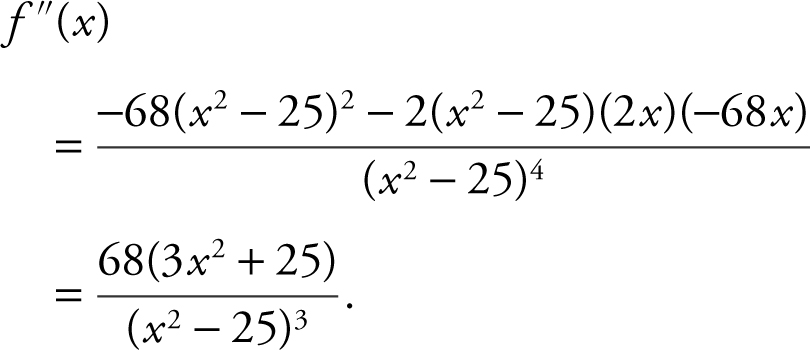
Set f ″ > 0. Since (3x 2 + 25) > 0, ⇒ (x 2 – 25)3 > 0 ⇒ x 2 – 25 > 0, x < –5 or x > 5. Thus, f (x ) is concave upward on (–∞, –5) and (5, ∞) and concave downward on (–5, 5).
4 . Step 1: f (x ) = x + sin x ,
f ′(x ) = 1 + cos x ,
f ″ = – sin x .
Step 2: Set f ″(x ) = 0 ⇒ – sin x = 0 or
x = 0, π , 2π .
Step 3: Check intervals.

Step 4: Check for tangent line: At x = π , f ′(x ) = 1 + (–1) ⇒ 0 there is a
tangent line at x = π .
Step 5: Thus, (π , π ) is a point of inflection.
5 . Step 1: Rewrite f (x ) as
f (x ) = (25 – x 2 )1/2 .
Step 2: 
Step 3: Find critical numbers. f ′(x ) = 0; at x = 0; and f ′(x ) is undefined at x = ±5.
Step 4:

f ′(0) = 0 and
(and f (0) = 5) ⇒ (0, 5) is a relative maximum. Since f (x ) is continuous on [–5, 5], f (x ) has both a maximum and a minimum value on [–5, 5] by the Extreme Value Theorem. And since the point (0,5) is the only relative extremum, it is an absolute extremum. Thus, (0,5) is an absolute maximum point and 5 is the maximum value. Now we check the endpoints, f (–5) = 0 and f (5) = 0. Therefore, (–5, 0) and (5, 0) are the lowest points for f on [–5, 5]. Thus, 0 is the absolute minimum value.
6 . (a) Point A f ′ < 0 ⇒ decreasing and f ″ > 0 ⇒ concave upward.
(b) Point E f ′ < 0 ⇒ decreasing and f ″ < 0 ⇒ concave downward.
(c) Points B and D f ′ = 0 ⇒ horizontal tangent.
(d) Point C f ″ does not exist ⇒ vertical tangent.
7 . A change in concavity ⇒ a point of inflection. At x = a , there is a change of concavity; f ″ goes from positive to negative ⇒ concavity changes from upward to downward. At x = c , there is a change of concavity; f ″ goes from negative to positive ⇒ concavity changes from downward to upward. Therefore, f has two points of inflection, one at x = a and the other at x = c .
8 . Set f ″(x ) = 0. Thus, x 2 (x + 3)(x – 5) = 0 ⇒ x = 0, x = –3 or x = 5. (See Figure 8.8-1 .)
Thus, f has a change of concavity at x = –3 and at x = 5.

Figure 8.8-1
9 . (See Figure 8.8-2 .)
Thus, f is increasing on [2, 3] and concave downward on (0, 1).

Figure 8.8-2
10 . The correct answer is (A).
f (–1) = 0; f ′(0) < 0 since f is decreasing and f ″(–1) < 0 since f is concave downward. Thus, f (–1) has the largest value.
11 . Step 1: Domain: all real numbers.
Step 2: Symmetry: Even function (f (x ) = f (– x )); symmetrical with respect to the y -axis.
Step 3: f ′(x ) = 4x 3 – 2x and f ″(x ) = 12x 2 – 2.
Step 4: Critical numbers: f ′(x ) is defined for all real numbers. Set f ′(x ) = 4x 3 – 2x = 0 ⇒ 2x (2x 2 – 1) = 0 ⇒ x = 0 or x = ± . Possible points of inflection: f ″(x ) is defined for all real numbers. Set f ″(x ) = 12x 2 – 2 = 0
. Possible points of inflection: f ″(x ) is defined for all real numbers. Set f ″(x ) = 12x 2 – 2 = 0
x = ± .
.
Step 5: Determine intervals:

Intervals are: 
 ,
,
 , and
, and
 .
.
Since f ′(x ) is symmetrical with respect to the y -axis, you only need to examine half of the intervals.
Step 6: Set up a table (Table 8.8-1 ). The function has an absolute minimum value of (–1/4) and no absolute maximum value.
Table 8.8-1

Step 7: Sketch the graph. (See Figure 8.8-3 .)

Figure 8.8-3
12 . Step 1: Domain: all real numbers x ≠ 4.
Step 2: Symmetry: none.
Step 3: Find f ′ and f ″.

Step 4: Critical numbers: f ′(x ) ≠ 0 and f ′(x ) is undefined at x = 4.
Step 5: Determine intervals.

Intervals are (–∞, 4) and (4, ∞).
Step 6: Set up table as below:

Step 7: Horizontal asymptote:
 . Thus, y = 1 is a horizontal asymptote. Vertical asymptote:
. Thus, y = 1 is a horizontal asymptote. Vertical asymptote:
 and
and
 ; Thus, x = 4 is a vertical asymptote.
; Thus, x = 4 is a vertical asymptote.
Step 8: x -intercept: Set f ′(x ) = 0 ⇒ x + 4 = 0; x = –4. y -intercept: Set x = 0 ⇒ f (x ) = –1.
Step 9: Sketch the graph. (See Figure 8.8-4 .)

Figure 8.8-4
13 . (a)

The function f has the largest value (of the four choices) at x = x 1 . (See Figure 8.8-5 .)

Figure 8.8-5
(b) And f has the smallest value at x = x 4 .
(c)

A change of concavity occurs at x = x 3 , and f ′(x 3 ) exists which implies there is a tangent to f at x = x 3 . Thus, at x = x 3 , f has a point of inflection.
(d) The function f ″ represents the slope of the tangent to f ′. The slope of the tangent to f ′ is the largest at x = x 4 .
14 . (a) Since f ′(x ) represents the slope of the tangent, f ′(x ) = 0 at x = 0, and x = 5.
(b) At x = 2, f has a point of inflection which implies that if f ″(x ) exists, f ″(x ) = 0. Since f ′(x ) is differentiable for all numbers in the domain, f ″(x ) exists, and f ″(x ) = 0 at x = 2.
(c) Since the function f is concave downward on (2, ∞), f ″ < 0 on (2, ∞) which implies f ′ is decreasing on (2, ∞).
15 . (a) The function f is increasing on the intervals (–2, 1) and (3, 5) and decreasing on (1, 3).
(b) The absolute maximum occurs at x = 1, since it is a relative maximum, f (1) > f (–2) and f (5) < f (–2). Similarly, the absolute minimum occurs at x = 3, since it is a relative minimum, and f (3) < f (5) < f (–2).
(c) No point of inflection. (Note that at x = 3, f has a cusp.)
Note: Some textbooks define a point of inflection as a point where the concavity changes and do not require the existence of a tangent. In that case, at x = 3, f has a point of inflection.
(d) Concave upward on (3, 5) and concave downward on (–2, 3).
(e) A possible graph is shown in Figure 8.8-6 .

Figure 8.8-6
16 . (a)

The function f has its relative minimum at x = 0 and its relative maximum at x = 6.
(b) The function f is increasing on [0, 6] and decreasing on (– ∞, 0] and [6, ∞).
(c)

Since f ′(3) exists and a change of concavity occurs at x = 3, f has a point of inflection at x = 3.
(d) Concave upward on (–∞, 3) and downward on (3, ∞).
(e) Sketch a graph. (See Figure 8.8-7 .)

Figure 8.8-7
17 . (See Figure 8.8-8 .)
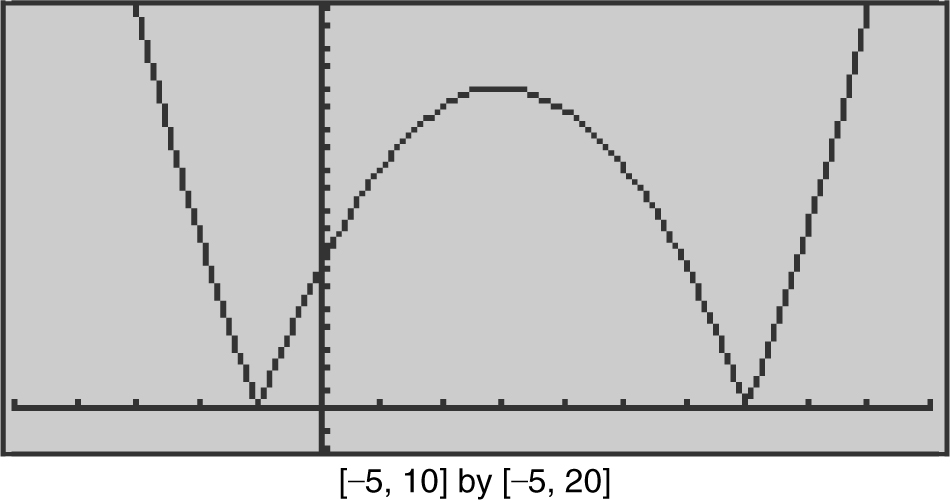
Figure 8.8-8
The graph of f indicates that a relative maximum occurs at x = 3, f is not differentiable at x = 7, since there is a cusp at x = 7 and f does not have a point of inflection at x = –1, since there is no tangent line at x = –1. Thus, only statement I is true.
18 . (See Figure 8.8-9 .)

Figure 8.8-9
Enter y 1 = cos(x 2 )
Using the [Inflection ] function of your calculator, you obtain three points of inflection on [0, π ]. The points of inflection occur at x = 1.35521, 2.1945, and 2.81373. Since y 1 = cos(x 2 ) is an even function, there is a total of 6 points of inflection on [–π , π ]. An alternate solution is to enter  . (y 1 (x ), x , 2).
. (y 1 (x ), x , 2).
The graph of y 2 indicates that there are 6 zeros on [–π , π ].
19 . Enter y 1 = 3 ∗ e ∧ (–x ∧ 2/2). Note that the graph has a symmetry about the y -axis. Using the functions of the calculator, you will find:
(a) a relative maximum point at (0, 3), which is also the absolute maximum point;
(b) points of inflection at (–1, 1.819) and (1, 1.819);
(c) y = 0 (the x -axis) a horizontal asymptote;
(d) y 1 increasing on (–∞, 0] and decreasing on [0, ∞); and
(e) y 1 concave upward on (–∞, –1) and (1, ∞) and concave downward on (–1, 1). (See Figure 8.8-10 .)

Figure 8.8-10
20 . (See Figure 8.8-11 .) Enter y 1 = cos(x ) ∗ (sin(x )) ∧ 2. A fundamental domain of y 1 is [0, 2 π ]. Using the functions of the calculator, you will find:

Figure 8.8-11
(a) relative maximum points at (0.955, 0.385), (π , 0), and (5.328, 0.385), and relative minimum points at (2.186, – 0.385) and (4.097, – 0.385);
(b) points of inflection at (0.491, 0.196),  , (2.651, – 0.196), (3.632, – 0.196),
, (2.651, – 0.196), (3.632, – 0.196),  , and (5.792, 0.196);
, and (5.792, 0.196);
(c) no asymptote;
(d) function is increasing on intervals (0, 0.955), (2.186, π ), and (4.097, 5.328), and decreasing on intervals (0.955, 2.186), (π , 4.097), and (5.328, 2π );
(e) function is concave upward on intervals (0, 0.491), 
 , and (5.792, 2π ), and concave downward on the intervals
, and (5.792, 2π ), and concave downward on the intervals  , (2.651,3.632), and
, (2.651,3.632), and  .
.
8.9 Solutions to Cumulative Review Problems
21 . 

22 . Substituting x = 0 in the expression  leads to
leads to  , ana indeterminant form. Apply L’Hôpital’s Rule and you have
, ana indeterminant form. Apply L’Hôpital’s Rule and you have  or
or  . Alternatively,
. Alternatively, 
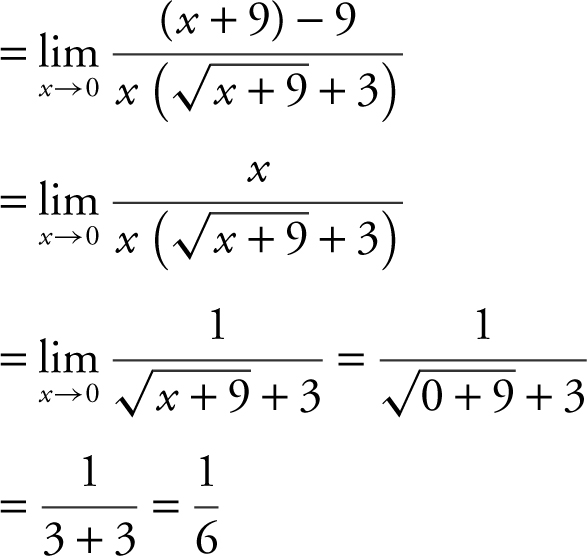
23 . y = cos(2x ) + 3x 2 – 1 
24 . (Calculator) The function f is continuous everywhere for all values of k except possibly at x = 1. Checking with the three conditions of continuity at x = 1:
(1) f (1) = (1)2 – 1 = 0
(2)  thus, 2 + k 0 ⇒ k = – 2. Since
thus, 2 + k 0 ⇒ k = – 2. Since  , therefore,
, therefore,  .
.
(2)  . Thus, k = –2.
. Thus, k = –2.
25 . (a) Since f ′ > 0 on (-1, 0) and (0, 2), the function f is increasing on the intervals [-1, 0] and [0, 2]. Since f ′ < 0 on (2, 4), f is decreasing on [2, 4].
(b) The absolute maximum occurs at x = 2, since it is a relative maximum and it is the only relative extremum on (–1, 4). The absolute minimum occurs at x = –1, since f (–1) < f (4) and the function has no relative minimum on [–1, 4].
(c) A change of concavity occurs at x = 0. However, f ′(0) is undefined, which implies f may or may not have a tangent at x = 0. Thus, f may or may not have a point of inflection at x = 0.
(d) Concave upward on (–1, 0) and concave downward on (0, 4).
(e) A possible graph is shown in Figure 8.9-1 .
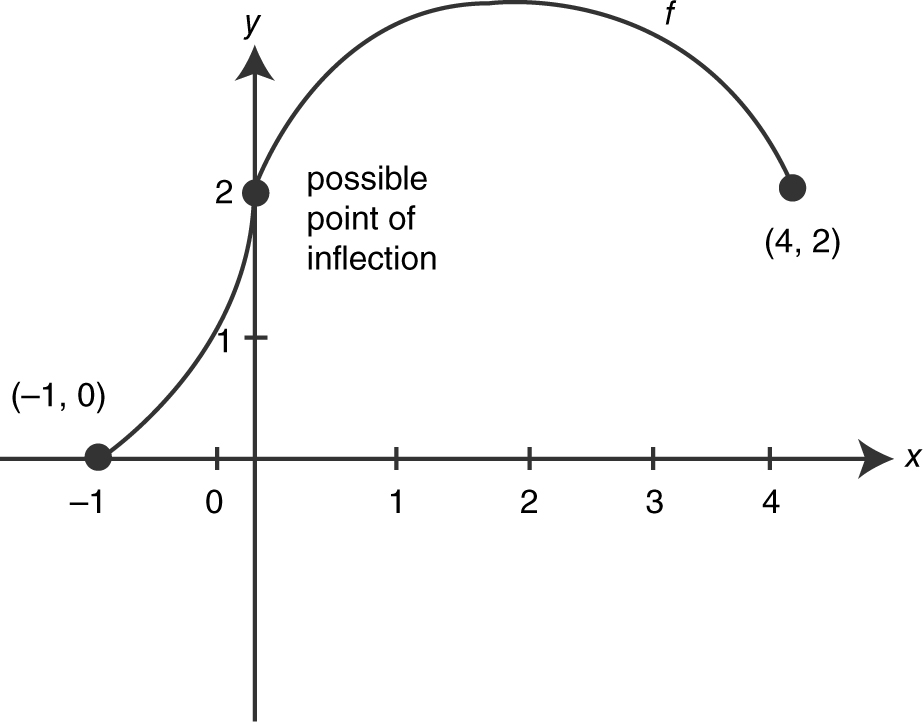
Figure 8.9-1
CHAPTER 9
Big Idea 2: Derivatives
Applications of Derivatives
IN THIS CHAPTER
Summary: Two of the most common applications of derivatives involve solving related rate problems and applied maximum and minimum problems. In this chapter, you will learn the general procedures for solving these two types of problems and to apply these procedures to examples. Both related rate and applied maximum and minimum problems appear often on the AP Calculus AB exam.

Key Ideas
 General Procedure for Solving Related Rate Problems
General Procedure for Solving Related Rate Problems
 Common Related Rate Problems
Common Related Rate Problems
 Inverted Cone, Shadow, and Angle of Elevation Problems
Inverted Cone, Shadow, and Angle of Elevation Problems
 General Procedure for Solving Applied Maximum and Minimum Problems
General Procedure for Solving Applied Maximum and Minimum Problems
 Distance, Area, Volume, and Business Problems
Distance, Area, Volume, and Business Problems
9.1 Related Rate
Main Concepts: General Procedure for Solving Related Rate Problems, Common Related Rate Problems, Inverted Cone (Water Tank) Problem, Shadow Problem, Angle of Elevation Problem

General Procedure for Solving Related Rate Problems
1. Read the problem and, if appropriate, draw a diagram.
2. Represent the given information and the unknowns by mathematical symbols.
3. Write an equation involving the rate of change to be determined. (If the equation contains more than one variable, it may be necessary to reduce the equation to one variable.)
4. Differentiate each term of the equation with respect to time.
5. Substitute all known values and known rates of change into the resulting equation.
6. Solve the resulting equation for the desired rate of change.
7. Write the answer and indicate the units of measure.
Common Related Rate Problems
Example 1
When the area of a square is increasing twice as fast as its diagonals, what is the length of a side of the square?
Let z represent the diagonal of the square. The area of a square is  .
.

 .
.
Since  .
.
Let s be a side of the square. Since the diagonal z = 2, then s 2 + s 2 = z 2 .
⇒ 2s 2 = 4 ⇒ s 2 = 4 ⇒ s 2 = 2 or  .
.
Example 2
Find the surface area of a sphere at the instant when the rate of increase of the volume of the sphere is nine times the rate of increase of the radius.
Volume of a sphere:  Surface area of a sphere: S = 4πr 2 .
Surface area of a sphere: S = 4πr 2 .
 .
.
Since  , you have
, you have  or 9 = 4πr 2 .
or 9 = 4πr 2 .
Since S = 4πr 2 , the surface area is S = 9 square units.
Note: At 9 = 4πr 2 , you could solve for r and obtain  or
or  . You could then substitute
. You could then substitute 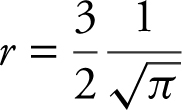 into the formula for surface area S = 4πr 2 and obtain 9. These steps are of course correct but not necessary.
into the formula for surface area S = 4πr 2 and obtain 9. These steps are of course correct but not necessary.
Example 3
The height of a right circular cone is always three times the radius. Find the volume of the cone at the instant when the rate of increase of the volume is twelve times the rate of increase of the radius.
Let r, h be the radius and height of the cone, respectively.
Since h = 3r , the volume of the cone  .
.

When 
Thus, 

Inverted Cone (Water Tank) Problem
A water tank is in the shape of an inverted cone. The height of the cone is 10 meters and the diameter of the base is 8 meters as shown in Figure 9.1-1 . Water is being pumped into the tank at the rate of 2 m3 /min. How fast is the water level rising when the water is 5 meters deep? (See Figure 9.1-1 .)

Figure 9.1-1
Solution:
Step 1: Define the variables. Let V be the volume of water in the tank; h be the height of the water level at t minutes; r be the radius of the surface of the water at t minutes; and t be the time in minutes.
Step 2: Given: 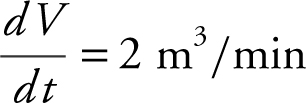 . Height = 10 m, diameter = 8 m.
. Height = 10 m, diameter = 8 m.
Find:  at h =5.
at h =5.
Step 3: Set up an equation: 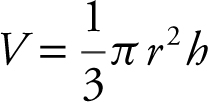 .
.
Using similar triangles, you have  ; or
; or  . (See Figure 9.1-2 .)
. (See Figure 9.1-2 .)

Figure 9.1-2
Thus, you can reduce the equation to one variable:
 .
.
Step 4: Differentiate both sides of the equation with respect to t .

Step 5: Substitute known values.

Step 6: Thus, the water level is rising at  when the water is 5 m high.
when the water is 5 m high.
Shadow Problem
A light on the ground 100 feet from a building is shining at a 6-foot-tall man walking away from the light and toward the building at the rate of 4 ft/sec. How fast is his shadow on the building becoming shorter when he is 40 feet from the building? (See Figure 9.1-3 .)

Figure 9.1-3
Solution:
Step 1: Let s be the height of the man’s shadow; x be the distance between the man and the light; and t be the time in seconds.
Step 2: Given:  the man is 6 ft tall; distance between light and building = 100 ft. Find
the man is 6 ft tall; distance between light and building = 100 ft. Find  at x = 60.
at x = 60.
Step 3: (See Figure 9.1-4 .) Writing an equation using similar triangles, you have:
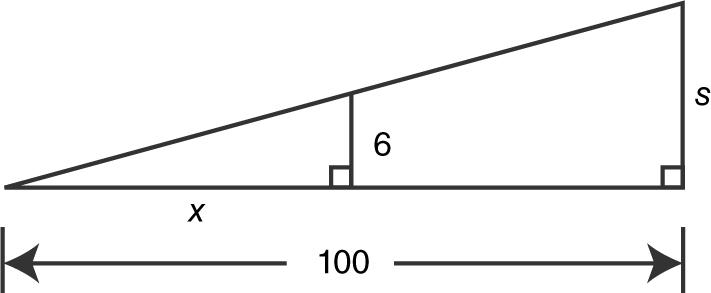
Figure 9.1-4

Step 4: Differentiate both sides of the equation with respect to t .

Step 5: Evaluate  at x = 60.
at x = 60.
Note: When the man is 40 ft from the building, x (distance from the light) is 60 ft.

Step 6: The height of the man’s shadow on the building is changing at  ft/sec.
ft/sec.

Angle of Elevation Problem
A camera on the ground 200 meters away from a hot air balloon (also on the ground) records the balloon rising into the sky at a constant rate of 10 m/sec. How fast is the camera’s angle of elevation changing when the balloon is 150 m in the air? (See Figure 9.1-5 .)
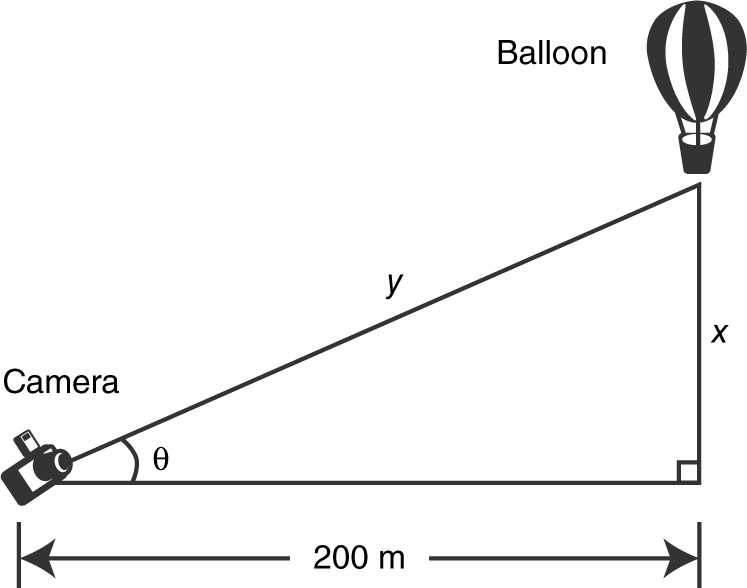
Figure 9.1-5
Step 1: Let x be the distance between the balloon and the ground; θ be the camera’s angle of elevation; and t be the time in seconds.
Step 2: Given:  distance between camera and the point on the ground where the balloon took off is 200 m,
distance between camera and the point on the ground where the balloon took off is 200 m,  .
.
Step 3: Find  at x = 150 m.
at x = 150 m.
Step 4: Differentiate both sides with respect to t .
 .
.
Step 5:  and at x = 150.
and at x = 150.

Since y > 0, then y = 250. Thus, sec  .
.

Step 6: The camera’s angle of elevation changes at approximately 1.833 deg/sec when the balloon is 150 m in the air.
9.2 Applied Maximum and Minimum Problems
Main Concepts: General Procedure for Solving Applied Maximum and Minimum Problems, Distance Problem, Area and Volume Problems, Business Problems

General Procedure for Solving Applied Maximum and Minimum Problems
Steps:
1. Read the problem carefully and if appropriate, draw a diagram.
2. Determine what is given and what is to be found, and represent these quantities by mathematical symbols.
3. Write an equation that is a function of the variable representing the quantity to be maximized or minimized.
4. If the equation involves other variables, reduce the equation to a single variable that represents the quantity to be maximized or minimized.
5. Determine the appropriate interval for the equation (i.e., the appropriate domain for the function) based on the information given in the problem.
6. Differentiate to obtain the first derivative and to find critical numbers.
7. Apply the First Derivative Test or the Second Derivative Test by finding the second derivative.
8. Check the function values at the endpoints of the interval.
9. Write the answer(s) to the problem and, if given, indicate the units of measure.
Distance Problem
Find the shortest distance between the point A (19, 0) and the parabola y = x 2 – 2x + 1.
Solution:
Step 1: Draw a diagram. (See Figure 9.2-1 .)

Figure 9.2-1
Step 2: Let P (x , y ) be the point on the parabola and let Z represent the distance between points P (x , y ) and A (19, 0).
Step 3: Using the distance formula,

(Special case: In distance problems, the distance and the square of the distance have the same maximum and minimum points.) Thus, to simplify computations, let L = Z 2 = (x – 19)2 + (x – 1)4 . The domain of L is (–∞, ∞).
Step 4: Differentiate: 
 is defined for all real numbers.
is defined for all real numbers.
Set  = 0; 2x 3 – 6x 2 + 7x – 21 = 0. The factors of 21 are ±1, ±3, ±7, and ± 21.
= 0; 2x 3 – 6x 2 + 7x – 21 = 0. The factors of 21 are ±1, ±3, ±7, and ± 21.
Using Synthetic Division, 2x 3 – 6x 2 + 7x – 21 = (x – 3)(2x 2 + 7) = 0 ⇒ x = 3.
Thus the only critical number is x = 3.
(Note: Step 4 could have been done using a graphing calculator.)
Step 5: Apply the First Derivative Test.

Step 6: Since x = 3 is the only relative minimum point in the interval, it is the absolute minimum.
Step 7: At x = 3, 
 . Thus, the shortest distance is
. Thus, the shortest distance is  .
.

Area and Volume Problems
Example Area Problem
The graph of  encloses a region with the x -axis and y -axis in the first quadrant. A rectangle in the enclosed region has a vertex at the origin and the opposite vertex on the graph of
encloses a region with the x -axis and y -axis in the first quadrant. A rectangle in the enclosed region has a vertex at the origin and the opposite vertex on the graph of  . Find the dimensions of the rectangle so that its area is a maximum.
. Find the dimensions of the rectangle so that its area is a maximum.
Solution:
Step 1: Draw a diagram. (See Figure 9.2-2 .)

Figure 9.2-2
Step 2: Let P (x , y ) be the vertex of the rectangle on the graph of  .
.
Step 3: Thus, the area of the rectangle is:

The domain of A is [0, 4].
Step 4: Differentiate:

Step 5:  is defined for all real numbers.
is defined for all real numbers.
Set  = 0 ⇒ –x + 2 = 0; x = 2.
= 0 ⇒ –x + 2 = 0; x = 2.
A (x ) has one critical number x = 2.
Step 6: Apply the Second Derivative Test:
 ⇒ A (x ) has a relative maximum point at x = 2; A (2) = 2.
⇒ A (x ) has a relative maximum point at x = 2; A (2) = 2.
Since x = 2 is the only relative maximum, it is the absolute maximum. (Note that at the endpoints: A (0) = 0 and A (4) = 0.)
Step 7: At x = 2,  .
.
Therefore, the length of the rectangle is 2, and its width is 1.
Example Volume Problem (with calculator)
If an open box is to be made using a square sheet of tin, 20 inches by 20 inches, by cutting a square from each corner and folding the sides up, find the length of a side of the square being cut so that the box will have a maximum volume.
Solution:
Step 1: Draw a diagram. (See Figure 9.2-3 .)

Figure 9.2-3
Step 2: Let x be the length of a side of the square to be cut from each corner.
Step 3: The volume of the box is V (x ) = x (20 – 2x )(20 – 2x ).
The domain of V is [0, 10].
Step 4: Differentiate V (x ).
Enter d (x ∗ (20 – 2x ) ∗ (20 – 2x ), x ) and we have 4(x – 10)(3x – 10).
Step 5: V ′(x ) is defined for all real numbers:
Set V ′(x ) = 0 by entering: [Solve ] (4(x – 10)(3x – 10) = 0, x ), and obtain x = 10 or  . The critical numbers of V (x ) are x = 10 and
. The critical numbers of V (x ) are x = 10 and  . V (10) = 0 and
. V (10) = 0 and  . Since V (10) = 0, you need to test only
. Since V (10) = 0, you need to test only  .
.
Step 6: Using the Second Derivative Test, enter d (x ∗ (20 – 2x ) ∗ (20 – 2x ), x ,2)| and obtain –80. Thus,
and obtain –80. Thus,  is a relative maximum. Since it is the only relative maximum on the interval, it is the absolute maximum. (Note at the other endpoint x = 0, V (0) = 0.)
is a relative maximum. Since it is the only relative maximum on the interval, it is the absolute maximum. (Note at the other endpoint x = 0, V (0) = 0.)
Step 7: Therefore, the length of a side of the square to be cut is  .
.

Business Problems
Summary of Formulas
1. P = R – C : Profit = Revenue – Cost
2. R = xp : Revenue = (Units Sold)(Price Per Unit)
3.  Average
Average
4.  Marginal Revenue ≈ Revenue from selling one more unit
Marginal Revenue ≈ Revenue from selling one more unit
5.  Marginal Profit ≈ Profit from selling one more unit
Marginal Profit ≈ Profit from selling one more unit
6.  Marginal Cost ≈ Cost of producing one more unit
Marginal Cost ≈ Cost of producing one more unit
Example 1
Given the cost function C (x ) = 100 + 8x + 0.1x 2 , (a) find the marginal cost when x = 50; and (b) find the marginal profit at x = 50, if the price per unit is $20.
Solution:
(a) Marginal cost is C ′(x ). Enter d (100 + 8x + 0.1x 2 , x )|x = 50 and obtain $18.
(b) Marginal profit is P ′(x )
P = R – C
P = 20x – (100 + 8x + 0.1x 2 ). Enter d (20x – (100 + 8x + 0.1x ∧ 2, x )|x = 50 and obtain 2.

Example 2
Given the cost function C (x ) = 500 + 3x + 0.01x 2 and the demand function (the price function) p (x ) = 10, find the number of units produced in order to have maximum profit.
Solution:
Step 1: Write an equation.
Profit = Revenue – Cost
P = R – C
Revenue = (Units Sold)(Price Per Unit)
R = xp (x ) = x (10) = 10x
P = 10x – (500 + 3x + 0.01x 2 )
Step 2: Differentiate.
Enter d (10x – (500 + 3x + 0.01x ∧ 2, x )) and obtain 7 – 0.02x .
Step 3: Find critical numbers.
Set 7 – 0.02x = 0 ⇒ x = 350.
Critical number is x = 350.
Step 4: Apply Second Derivative Test.
Enter d (10x – (500 + 3x + 0.01x ∧ 2), x , 2)|x = 350 and obtain –0.02.
Since x = 350 is the only relative maximum, it is the absolute maximum.
Step 5: Write a solution.
Thus, producing 350 units will lead to maximum profit.
9.3 Rapid Review
1. Find the instantaneous rate of change at x = 5 of the function  .
.
Answer: 
2. If h is the diameter of a circle and h is increasing at a constant rate of 0.1 cm/sec, find the rate of change of the area of the circle when the diameter is 4 cm.
Answer: 
3. The radius of a sphere is increasing at a constant rate of 2 inches per minute. In terms of the surface area, what is the rate of change of the volume of the sphere?
Answer:  since
since 
4. Using your calculator, find the shortest distance between the point (4, 0) and the line y = x . (See Figure 9.3-1 .)

Figure 9.3-1
Answer:

Enter 
Use the [Zero ] function for y 2 and obtain x = 2. Note that when x < 2, y 2 < 0 which means y 1 is decreasing and when x > 2, y 2 > 0 which means y 1 is increasing and thus at x = 2, y 1 is a minimum. Use the [Value ] function for y 1 at x = 2 and obtain y 1 = 2.82843. Thus, the shortest distance is approximately 2.828.
9.4 Practice Problems
Part A—The use of a calculator is not allowed.
1 . A spherical balloon is being inflated. Find the volume of the balloon at the instant when the rate of increase of the surface area is eight times the rate of increase of the radius of the sphere.
2 . A 13-foot ladder is leaning against a wall. If the top of the ladder is sliding down the wall at 2 ft/sec, how fast is the bottom of the ladder moving away from the wall when the top of the ladder is 5 feet from the ground? (See Figure 9.4-1 .)

Figure 9.4-1
3 . Air is being pumped into a spherical balloon at the rate of 100 cm3 /sec. How fast is the diameter increasing when the radius is 5 cm?
4 . A woman 5 feet tall is walking away from a streetlight hung 20 feet from the ground at the rate of 6 ft/sec. How fast is her shadow lengthening?
5 . A water tank in the shape of an inverted cone has a height of 18 feet and a base radius of 12 feet. If the tank is full and the water is drained at the rate of 4 ft3 /min, how fast is the water level dropping when the water level is 6 feet high?
6 . Two cars leave an intersection at the same time. The first car is going due east at the rate of 40 mph and the second is going due south at the rate of 30 mph. How fast is the distance between the two cars increasing when the first car is 120 miles from the intersection?
7 . If the perimeter of an isosceles triangle is 18 cm, find the maximum area of the triangle.
8 . Find a number in the interval (0, 2) such that the sum of the number and its reciprocal is the absolute minimum.
9 . An open box is to be made using a piece of cardboard 8 cm by 15 cm by cutting a square from each corner and folding the sides up. Find the length of a side of the square being cut so that the box will have a maximum volume.
10 . What is the shortest distance between the point  and the parabola y = –x 2 ?
and the parabola y = –x 2 ?
11 . If the cost function is C (x ) = 3x 2 + 5x + 12, find the value of x such that the average cost is a minimum.
12 . A man with 200 meters of fence plans to enclose a rectangular piece of land using a river on one side and a fence on the other three sides. Find the maximum area that the man can obtain.
Part B—Calculators are allowed.
13 . A trough is 10 meters long and 4 meters wide. (See Figure 9.4-2 .) The two sides of the trough are equilateral triangles. Water is pumped into the trough at 1 m3 /min. How fast is the water level rising when the water is 2 meters high?

Figure 9.4-2
14 . A rocket is sent vertically up in the air with the position function s = 100t 2 where s is measured in meters and t in seconds. A camera 3000 m away is recording the rocket. Find the rate of change of the angle of elevation of the camera 5 sec after the rocket went up.
15 . A plane lifts off from a runway at an angle of 20°. If the speed of the plane is 300 mph, how fast is the plane gaining altitude?
16 . Two water containers are being used. (See Figure 9.4-3 .)

Figure 9.4-3
One container is in the form of an inverted right circular cone with a height of 10 feet and a radius at the base of 4 feet. The other container is a right circular cylinder with a radius of 6 feet and a height of 8 feet. If water is being drained from the conical container into the cylindrical container at the rate of 15 ft3 /min, how fast is the water level falling in the conical tank when the water level in the conical tank is 5 feet high? How fast is the water level rising in the cylindrical container?
17 . The wall of a building has a parallel fence that is 6 feet high and 8 feet from the wall. What is the length of the shortest ladder that passes over the fence and leans on the wall? (See Figure 9.4-4 .)
18 . Given the cost function C(x ) = 2500 + 0.02x + 0.004x 2 , find the product level such that the average cost per unit is a minimum.
19 . Find the maximum area of a rectangle inscribed in an ellipse whose equation is 4x 2 + 25y 2 = 100.
20 . A right triangle is in the first quadrant with a vertex at the origin and the other two vertices on the x – and y -axes. If the hypotenuse passes through the point (0.5, 4), find the vertices of the triangle so that the length of the hypotenuse is the shortest possible length.

Figure 9.4-4
9.5 Cumulative Review Problems
(Calculator) indicates that calculators are permitted.
21 . If y = sin2 (cos(6x – 1)), find  .
.
22 . Evaluate  .
.
23 . The graph of f ′ is shown in Figure 9.5-1 . Find where the function f : (a) has its relative extrema or absolute extrema; (b) is increasing or decreasing; (c) has its point(s) of inflection; (d) is concave upward or downward; and (e) if f (3) = –2, draw a possible sketch of f .
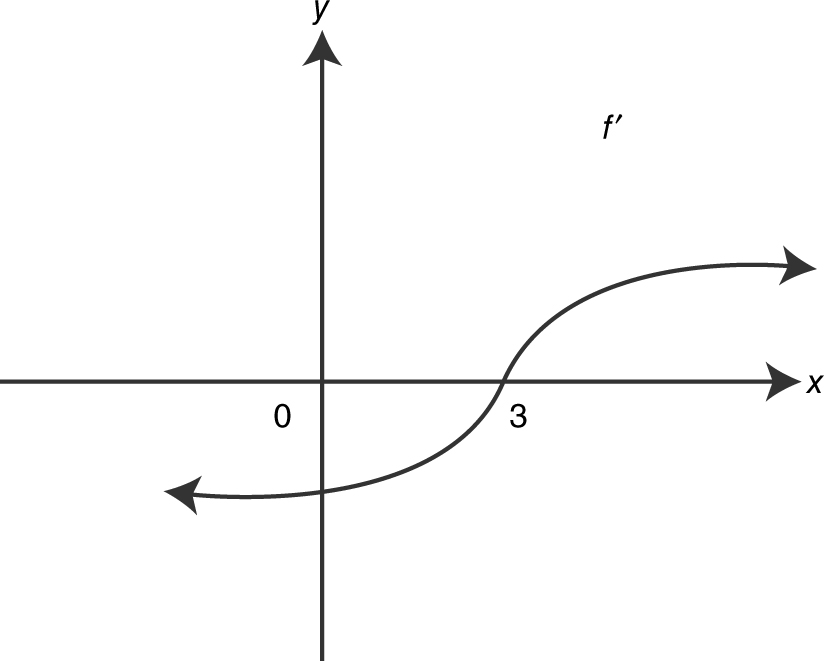
Figure 9.5-1
24 . (Calculator) At what value(s) of x does the tangent to the curve x 2 + y 2 = 36 have a slope of –1?
25 . (Calculator) Find the shortest distance between the point (1, 0) and the curve y = x 3 .
9.6 Solutions to Practice Problems
Part A—The use of a calculator is not allowed .
1 . Volume: 
Surface Area:  .
.
Since 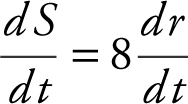 ,
,

or 
At  cubic units.
cubic units.
2 . Pythagorean Theorem yields x 2 + y 2 = (13)2 .
Differentiate: 
 .
.
At x = 5, (5)2 + y 2 = 132 ⇒ y = ± 12, since y > 0, y = 12.
Therefore,  . The ladder is moving away from the wall at
. The ladder is moving away from the wall at  when the top of the ladder is 5 feet from the ground.
when the top of the ladder is 5 feet from the ground.
3 . Volume of a sphere is 
Differentiate: 
 .
.
Substitute: 100 = 4π(5)2  .
.
Let x be the diameter. Since  .
.
Thus, 
=  . The diameter is increasing at
. The diameter is increasing at  when the radius is 5 cm.
when the radius is 5 cm.
4 . (See Figure 9.6-1 .) Using similar triangles, with y the length of the shadow you have:

Figure 9.6-1

Differentiate:

5 . (See Figure 9.6-2 .) Volume of a cone

Figure 9.6-2
 .
.
Using similar triangles, you have
 or
or  , thus
, thus
reducing the equation to

Differentiate:  .
.
Substituting known values:
 or
or  . The water level is dropping at
. The water level is dropping at  when h = 6 ft.
when h = 6 ft.
6 . (See Figure 9.6-3 .)

Figure 9.6-3
Step 1: Using the Pythagorean Theorem, you have x 2 + y 2 = z 2 . You also have  and
and  .
.
Step 2: Differentiate:
 .
.
At x = 120, both cars have traveled 3 hours and thus, y = 3(30) = 90. By the Pythagorean Theorem, (120)2 + (90)2 = z 2 ⇒ z = 150.
Step 3: Substitute all known values into the equation:

Step 4: The distance between the two cars is increasing at 50 mph at x = 120.
7 . (See Figure 9.6-4 .)

Figure 9.6-4
Step 1: Applying the Pythagorean
Theorem, you have x 2 = y 2 + (9 – x )2 ⇒ y 2 = x 2 – (9 – x )2 = x 2 – 81 – 18x + x 2 = 18x – 81 = 9(2x – 9), or 
 since y < 0,
since y < 0,  .
.
The area of the triangle 
Step 2: 
Step 3: Set 
 is undefined at
is undefined at  critical numbers are
critical numbers are  and 6.
and 6.
Step 4: First Derivative Test:

Thus at x = 6, the area A is a relative maximum.

Step 5: Check endpoints. The domain of A is [9/2, 9]. A (9/2) = 0; and A (9) = 0. Therefore, the maximum area of an isosceles triangle with the perimeter of 18 cm is  cm2 . (Note that at x = 6, the triangle is an equilateral triangle.)
cm2 . (Note that at x = 6, the triangle is an equilateral triangle.)
8 . Step 1: Let x be the number and  be its
be its
Step 2:  with 0 < x < 2.
with 0 < x < 2.
Step 3: 
Step 4: Set  ⇒ x = ±1, since the domain is (0, 2), thus x = 1.
⇒ x = ±1, since the domain is (0, 2), thus x = 1.  is defined for all x in (0, 2). Critical number is x = 1.
is defined for all x in (0, 2). Critical number is x = 1.
Step 5: Second Derivative Test:  and
and  . Thus at x = 1, s is a relative minimum. Since it is the only relative extremum, at x = 1, it is the absolute minimum.
. Thus at x = 1, s is a relative minimum. Since it is the only relative extremum, at x = 1, it is the absolute minimum.
9 . (See Figure 9.6-5 .)

Figure 9.6-5
Step 1: Volume: V = x (8 – 2x )(15 – 2x ) with 0 ≤ x ≤ 4.
Step 2: Differentiate: Rewrite as V = 4x 3 – 46x 2 + 120x
 = 12x 2 – 92x + 120.
= 12x 2 – 92x + 120.
Step 3: Set V = 0 ⇒ 12x 2 – 92x + 120 = 0 ⇒ 3x 2 – 23x + 30 = 0. Using the quadratic formula, you have x = 6 or  and
and  is defined for all real numbers.
is defined for all real numbers.
Step 4: Second Derivative Test:
 .
.
Thus,  is a relative maximum.
is a relative maximum.
Step 5: Check endpoints.
At x = 0, V = 0 and at x = 4, V = 0. Therefore, at  , V is the absolute maximum.
, V is the absolute maximum.
10 . (See Figure 9.6-6 .)

Figure 9.6-6
Step 1: Distance Formula:

Step 2: Let S = Z 2 , since S and Z have the same maximums and minimums.

Step 3: Set  x = 1 and
x = 1 and  is defined for all real numbers.
is defined for all real numbers.
Step 4: Second Derivative Test:

Thus at x = 1, Z has a minimum, and since it is the only relative extremum, it is the absolute minimum.
Step 5: At x = 1,

Therefore, the shortest distance is

11 . Step 1: Average Cost:

Step 2: 
Step 3: Set 
 Since x > 0, x = 2 and
Since x > 0, x = 2 and  is undefined at x = 0 which is not in the domain.
is undefined at x = 0 which is not in the domain.
Step 4: Second Derivative Test:
 and
and 
Thus at x = 2, the average cost is a minimum.
12 . (See Figure 9.6-7 .)
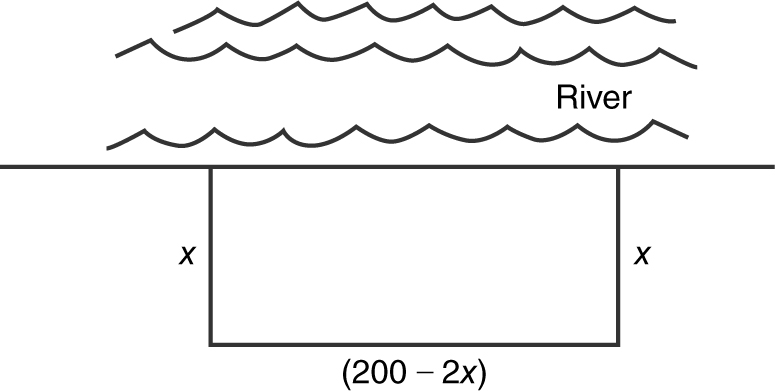
Figure 9.6-7
Step 1: Area:
A = x (200 – 2x ) = 200x – 2x 2 with 0 ≤ x ≤ 100.
Step 2: A ′(x ) = 200 – 4x
Step 3: Set A ′(x ) = 0 ⇒ 200 – 4x = 0; x = 50.
Step 4: Second Derivative Test:
A ″(x ) = –4; thus at x = 50, the area is a relative maximum. A (50) = 5000 m2 .
Step 5: Check endpoints.
A (0) = 0 and A (100) = 0; therefore at x = 50, the area is the absolute maximum and 5000 m2 is the maximum area.
Part B—Calculators are allowed.
13 .
Step 1: Let h be the height of the trough and 4 be a side of one of the two equilateral triangles. Thus, in a 30–60 right triangle,  .
.
Step 2: Volume:
V = (area of the triangle) · 10
 .
.
Step 3: Differentiate with respect to t .

Step 4: Substitute known values:
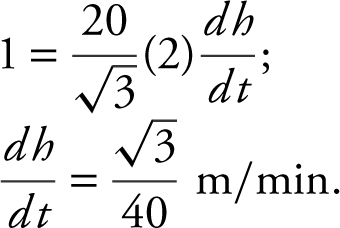
The water level is rising 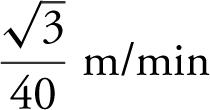 when the water level is 2 m high.
when the water level is 2 m high.
14 . (See Figure 9.6-8 .)

Figure 9.6-8
Step 1: tan θ = S /3000
Step 2: Differentiate with respect to t .

Step 3: At t = 5; S = 100(5)2 = 2500; Thus, Z 2 = (3000)2 + (2500)2 = 15,250,000. Therefore,  , since Z > 0,
, since Z > 0,  . Substitute known values into the equation:
. Substitute known values into the equation:

 radian/sec. The angle of elevation is changing at 0.197 radian/sec, 5 seconds after liftoff.
radian/sec. The angle of elevation is changing at 0.197 radian/sec, 5 seconds after liftoff.
15 . (See Figure 9.6-9 .)

Figure 9.6-9

h = (sin 20°)(300)t ;  ≈ 102.606 mph. The plane is gaining altitude at 102.606 mph.
≈ 102.606 mph. The plane is gaining altitude at 102.606 mph.
16 . 
Similar triangles:  or
or

Substitute known values:

The water level in the cone is falling at
 ft/min ≈ 1.19 ft/min when the water level is 5 feet high.
ft/min ≈ 1.19 ft/min when the water level is 5 feet high.
Vcylinder = π R2 H = π(6)2H = 36πH .

 ft/min ≈ 0.1326 ft/min or 1.592 in/min.
ft/min ≈ 0.1326 ft/min or 1.592 in/min.
The water level in the cylinder is rising at  ft/min = 0.133 ft/min.
ft/min = 0.133 ft/min.
17 . Step 1: Let x be the distance of the foot of the ladder from the higher wall. Let y be the height of the point where the ladder touches the higher wall. The slope of the ladder is  or
or 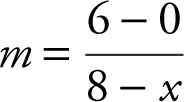 .
.
Thus,

Step 2: Pythagorean Theorem:

Step 3: Enter

The graph of y 1 is continuous on the interval x > 8. Use the [Minimum ] function of the calculator and obtain x = 14.604; y = 19.731. Thus the minimum value of l is 19.731 or the shortest ladder is approximately 19.731 feet.
18 . Step 1: Average  thus,
thus, 

Step 2: Enter:  + .02 + .004 * x
+ .02 + .004 * x
Step 3: Use the [Minimum ] function in the calculator and obtain x = 790.6.
Step 4: Verify the result with the First Derivative Test. Enter y 2 = d (2500/x +.02 +.004x , x ); Use the [Zero ] function and obtain x = 790.6. Thus 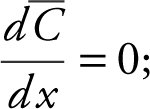 at x = 790.6. Apply the First Derivative Test:
at x = 790.6. Apply the First Derivative Test:

Thus the minimum average cost per unit occurs at x = 790.6. (The graph of the average cost function is shown in Figure 9.6-10 .)

Figure 9.6-10
19 . (See Figure 9.6-11 .)
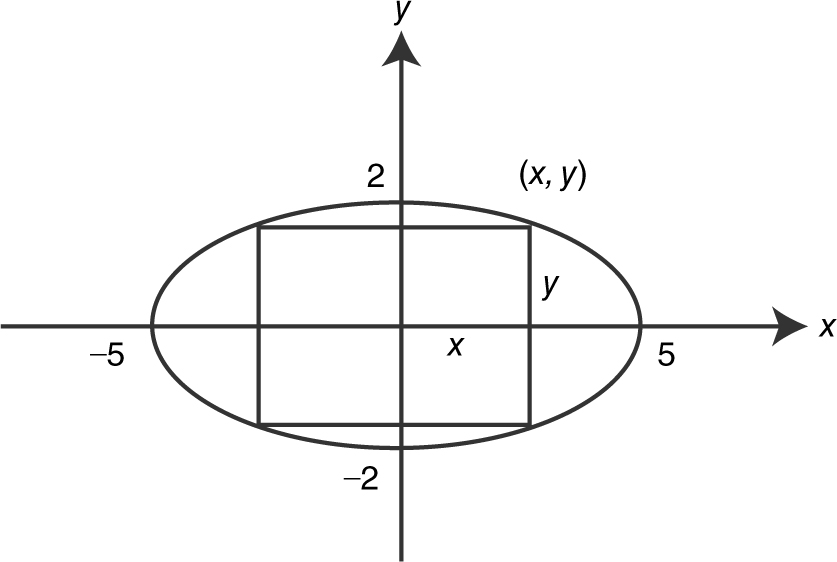
Figure 9.6-11
Step 1: Area A = (2x )(2y ); 0 ≤ x ≤ 5 and 0 ≤ y ≤ 2.
Step 2: 4x 2 + 25y 2 = 100;
25y 2 = 100 – 4x 2 .

Step 3: 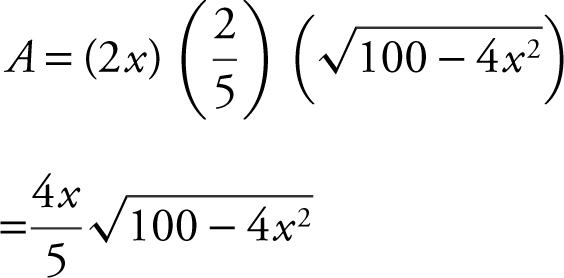
Step 4: Enter 
Use the [Maximum ] function and obtain x = 3.536 and y 1 = 20.
Step 5: Verify the result with the First Derivative Test.
Enter
 . Use the [Zero ] function and obtain x = 3.536.
. Use the [Zero ] function and obtain x = 3.536.
Note that:

The function f has only one relative extremum. Thus, it is the absolute extremum. Therefore, at x = 3.536, the area is 20 and the area is the absolute maxima.
20 . (See Figure 9.6-12 .)

Figure 9.6-12
Step 1: Distance formula:
l 2 = x 2 + y 2 ; x > 0.5 and y > 4.
Step 2: The slope of the hypotenuse:

Step 3:  .
.

Step 4: Enter  and use the [Minimum ] function of the calculator and obtain x = 2.5.
and use the [Minimum ] function of the calculator and obtain x = 2.5.
Step 5: Apply the First Derivative Test. Enter y 2 = d (y 1(x ), x ) and use the [Zero ] function and obtain x = 2.5.
Note that:

Since f has only one relative extremum, it is the absolute extremum. Thus, at x = 3, it is an absolute minimum.
Step 6: Thus, at x = 2.5, the length of the hypotenuse is the shortest. At x = 2.5,  . The vertices of the triangle are (0, 0), (2.5, 0), and (0, 5).
. The vertices of the triangle are (0, 0), (2.5, 0), and (0, 5).
9.7 Solutions to Cumulative Review Problems
21 . 
22 . As x → ∞, the numerator  approaches 0 and the denominator increases without bound (i.e., ∞). Thus, the
approaches 0 and the denominator increases without bound (i.e., ∞). Thus, the  .
.
23 . (a) Summarize the information of f ′ on a number line.

Since f has only one relative extremum, it is the absolute extremum. Thus, at x = 3, it is an absolute minimum.
(b) The function f is decreasing on the interval (–∞, 3) and increasing on (3, ∞).
(c)

No change of concavity ⇒ No point of inflection.
(d) The function f is concave upward for the entire domain (–∞, ∞).
(e) Possible sketch of the graph for f (x ). (See Figure 9.7-1 .)

Figure 9.7-1
24 . (Calculator) (See Figure 9.7-2 .)

Figure 9.7-2
Step 1: Differentiate:

Step 2: Set  y = x
y = x
Step 3: Solve for y : x 2 + y 2 = 36 ⇒ y 2 = 36 – x 2 ;
 .
.
Step 4: Thus, = x ⇒ ± x ⇒ 36 – x 2 = x 2 ⇒ 36 = 2x 2 or
x ⇒ 36 – x 2 = x 2 ⇒ 36 = 2x 2 or  .
.
25 . (Calculator) (See Figure 9.7-3 .)
Step 1: Distance formula:


Figure 9.7-3
Step 2: Enter: 
Use the [Minimum ] function of the calculator and obtain x = .65052 and y 1 = .44488. Verify the result with the First Deriative Test. Enter y 2 = d (y 1(x ), x ) and use the [Zero ] function and obtain x = .65052.

Thus the shortest distance is approximately 0.445.
CHAPTER 10
Big Idea 2: Derivatives
More Applications of Derivatives
IN THIS CHAPTER
Summary : Finding an equation of a tangent is one of the most common questions on the AP Calculus AB exam. In this chapter, you will learn how to use derivatives to find an equation of a tangent, and to use the tangent line to approximate the value of a function at a specific point. You will also learn to apply derivatives to solve rectilinear motion problems.

Key Ideas
 Tangent and Normal Lines
Tangent and Normal Lines
 Linear Approximations
Linear Approximations
 Motion Along a Line
Motion Along a Line
10.1 Tangent and Normal Lines
Main Concepts: Tangent Lines, Normal Lines
Tangent Lines
If the function y is differentiable at x = a , then the slope of the tangent line to the graph of y at x = a is given as 
Types of Tangent Lines
Horizontal Tangents:  . (See Figure 10.1-1 .)
. (See Figure 10.1-1 .)

Figure 10.1-1
Vertical Tangents: ( does not exist but
does not exist but  = 0). (See Figure 10.1-2 .)
= 0). (See Figure 10.1-2 .)

Figure 10.1-2
Parallel Tangents:  . (See Figure 10.1-3 .)
. (See Figure 10.1-3 .)

Figure 10.1-3
Example 1
Write an equation of the line tangent to the graph of y = –3 sin 2x at  . (See Figure 10.1-4 .)
. (See Figure 10.1-4 .)

Figure 10.1-4
y = –3 sin 2x ; 
Slope of tangent  .
.
Point of tangency: 
Therefore,  is the point of tangency.
is the point of tangency.
Equation of tangent: y – 0 = 6(x – π /2) or y = 6x – 3π .
Example 2
If the line y = 6x + a is tangent to the graph of y = 2x 3 , find the value(s) of a .
Solution:
 (See Figure 10.1-5 .)
(See Figure 10.1-5 .)

Figure 10.1-5
The slope of the line y = 6x + a is 6.
Since y = 6x + a is tangent to the graph of y = 2x 3 , thus 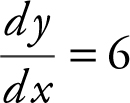 for some values of x .
for some values of x .
Set 6x 2 = 6 ⇒ x 2 = 1 or x = ±1.
At x = –1, y = 2x 3 = 2(–1)3 = –2;(–1, –2) is a tangent point. Thus, y = 6x + a ⇒ –2 = 6(–1) + a or a = 4.
At x = 1, y = 2x 3 = 2(1)3 = 2; (1, 2) is a tangent point.
Thus, y = 6x + a ⇒ 2 = 6(1) + a or a = –4.
Therefore, a = ±4.
Example 3
Find the coordinates of each point on the graph of y 2 – x 2 – 6x + 7 = 0 at which the tangent line is vertical. Write an equation of each vertical tangent. (See Figure 10.1-6 .)
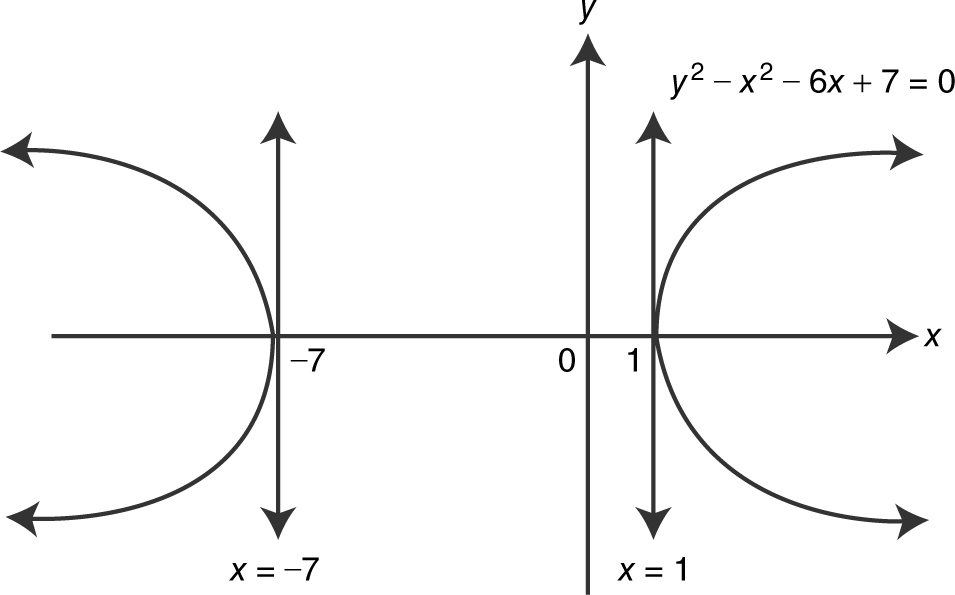
Figure 10.1-6
Step 1: Find  .
.
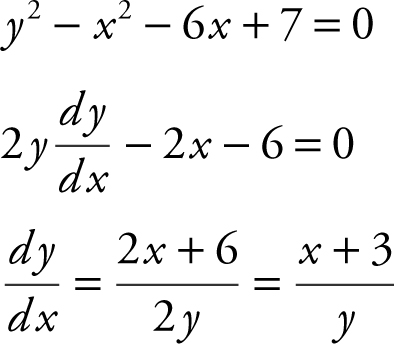
Step 2: Find  .
.

Step 3: Find points of tangency.
At y = 0, y 2 – x 2 – 6x + 7 = 0 becomes –x 2 – 6x + 7 = 0 ⇒ x 2 + 6x – 7 = 0 ⇒ (x + 7)(x – 1) = 0 ⇒ x = –7 or x = 1.
Thus, the points of tangency are (–7, 0) and (1, 0).
Step 4: Write equations for vertical tangents: x = –7 and x = 1.
Example 4
Find all points on the graph of y = |xex | at which the graph has a horizontal tangent.
Step 1: Find  .
.

Step 2: Find the x -coordinate of points of tangency.
Horizontal tangent  .
.
If x ≥ 0, set ex + xex = 0 ⇒ ex (1 + x ) = 0 ⇒ x = –1 but x ≥ 0, therefore, no solution.
If x < 0, set –ex – xex = 0 ⇒ –ex (1 + x ) = 0 ⇒ x = –1.
Step 3: Find points of tangency.
At 
Thus at the point (–1, 1/e ), the graph has a horizontal tangent. (See Figure 10.1-7 .)

Figure 10.1-7
Example 5
Using your calculator, find the value(s) of x to the nearest hundredth at which the slope of the line tangent to the graph of y = 2 ln (x 2 + 3) is equal to  . (See Figures 10.1-8 and 10.1-9 .)
. (See Figures 10.1-8 and 10.1-9 .)

Figure 10.1-8

Figure 10.1-9
Step 1: Enter y 1 = 2 ∗ ln (x ^2 + 3).
Step 2: Enter y 2 = d (y 1 (x ), x ) and enter 
Step 3: Using the [Intersection ] function of the calculator for y 2 and y 3 , you obtain x = –7.61 or x = –0.39.
Example 6
Using your calculator, find the value(s) of x at which the graphs of y = 2x 2 and y = ex have parallel tangents.
Step 1: Find  for both y = 2x 2 and y = ex .
for both y = 2x 2 and y = ex .

Step 2: Find the x -coordinate of the points of tangency. Parallel tangents ⇒ slopes are equal.
Set 4x = ex ⇒ 4x – ex = 0.
Using the [Solve ] function of the calculator, enter [Solve ] (4x – e ^(x ) = 0, x ) and obtain x = 2.15 and x = 0.36.

Normal Lines
The normal line to the graph of f at the point (x 1 , y 1 ) is the line perpendicular to the tangent line at (x 1 , y 1 ). (See Figure 10.1-10 .)

Figure 10.1-10
Note that the slope of the normal line and the slope of the tangent line at any point on the curve are negative reciprocals, provided that both slopes exist.
(m normal line )(m tangent line ) = –1.
Special Cases:
(See Figure 10.1-11 .)

Figure 10.1-11
At these points, m tangent = 0; but m normal does not exist.
(See Figure 10.1-12 .)

Figure 10.1-12
At these points, m tangent does not exist; however m normal = 0.
Example 1
Write an equation for each normal to the graph of y = 2 sin x for 0 ≤ x ≤ 2π that has a slope of  .
.
Step 1: Find m tangent .

Step 2: Find m normal .

⇒ x = cos–1 (–1) or x = π . (See Figure10.1-13 .)

Figure 10.1-13
Step 3: Write equation of normal line.
At x = π , y = 2 sin x = 2(0) = 0; (π , 0).
Since  , equation of normal is:
, equation of normal is:
 or
or  .
.
Example 2
Find the point on the graph of y = ln x such that the normal line at this point is parallel to the line y = –ex – 1.
Step 1: Find m tangent .

Step 2: Find m normal .

Slope of y = –ex – 1 is –e .
Since normal is parallel to the line y = –ex – 1, set m normal = –e ⇒ –x = –e or x = e .
Step 3: Find the point on the graph. At x = e , y = ln x = ln e = l . Thus the point of the graph of y = ln x at which the normal is parallel to y = –ex – 1 is (e , 1). (See Figure 10.1-14 .)

Figure 10.1-14
Example 3
Given the curve  : (a) write an equation of the normal to the curve
: (a) write an equation of the normal to the curve  at the point (2, 1/2), and (b) does this normal intersect the curve at any other point? If yes, find the point.
at the point (2, 1/2), and (b) does this normal intersect the curve at any other point? If yes, find the point.
Step 1: Find m tangent .

Step 2: Find m normal .

Step 3: Write equation of normal.
m normal = 4; (2, 1/2)
Equation of normal:  , or
, or  .
.
Step 4: Find other points of intersection.

Using the [Intersection ] function of your calculator, enter  and
and  and obtain x = –0.125 and y = –8. Thus, the normal line intersects the graph of
and obtain x = –0.125 and y = –8. Thus, the normal line intersects the graph of  at the point (–0.125, –8) as well.
at the point (–0.125, –8) as well.

10.2 Linear Approximations
Main Concepts: Tangent Line Approximation, Estimating the n th Root of a Number, Estimating the Value of a Trigonometric Function of an Angle
Tangent Line Approximation (or Linear Approximation)
An equation of the tangent line to a curve at the point (a , f (a )) is: y = f (a ) + f ′ (a )(x – a ), providing that f is differentiable at a . (See Figure 10.2-1 .) Since the curve of f (x ) and the tangent line are close to each other for points near x = a , f (x ) ≈ f (a ) + f ′ (a )(x – a ).

Figure 10.2-1
Example 1
Write an equation of the tangent line to f (x ) = x 3 at (2, 8). Use the tangent line to find the approximate values of f (1.9) and f (2.01).
Differentiate f (x ): f ′(x ) = 3x 2 ; f ′(2) = 3(2)2 = 12. Since f is differentiable at x = 2, an equation of the tangent at x = 2 is:
y = f (2) + f ′ (2)(x – 2)
y = (2)3 + 12(x – 2) = 8 + 12x – 24 = 12x – 16
f (1.9) ≈ 12(1.9) – 16 = 6.8
f (2.01) ≈ 12(2.01) – 16 = 8.12. (See Figure 10.2-2 .)

Figure 10.2-2
Example 2
If f is a differentiable function and f (2) = 6 and  , find the approximate value of f (2.1).
, find the approximate value of f (2.1).
Using tangent line approximation, you have
(a) f (2) = 6 ⇒ the point of tangency is (2, 6);
(b)  ⇒ the slope of the tangent at x = 2 is
⇒ the slope of the tangent at x = 2 is  ;
;
(c) the equation of the tangent is  or
or  ;
;
(d) thus,  .
.
Example 3
The slope of a function at any point (x , y ) is  . The point (3, 2) is on the graph of f . (a) Write an equation of the line tangent to the graph of f at x = 3. (b) Use the tangent line in part (a) to approximate f (3.1).
. The point (3, 2) is on the graph of f . (a) Write an equation of the line tangent to the graph of f at x = 3. (b) Use the tangent line in part (a) to approximate f (3.1).
(a) Let y = f (x ), then 

Equation of tangent: y – 2 = –2(x – 3) or y = –2x + 8.
(b) f (3.1) ≈ –2(3.1) + 8 ≈ 1.8
Estimating the n th Root of a Number
Another way of expressing the tangent line approximation is: f (a + Δx ) ≈ f (a ) + f ′(a )Δx , where Δx is a relatively small value.
Example 1
Find the approximate value of  using linear approximation.
using linear approximation.
Using  and Δx = 1.
and Δx = 1.
Thus, 
Example 2
Find the approximate value of  using linear approximation.
using linear approximation.
Let f (x ) = x 1/3 , a = 64, Δx = – 2. Since  and
and  , you can use f (a + Δx ) ≈ f (a ) + f ′(a )Δx . Thus, f (62) =
, you can use f (a + Δx ) ≈ f (a ) + f ′(a )Δx . Thus, f (62) = 

Estimating the Value of a Trigonometric Function of an Angle
Example
Approximate the value of sin 31°.
Note: You must express the angle measurement in radians before applying linear approximations.  radians and
radians and  radians.
radians.
Let f (x ) = sin x ,  and
and  .
.
Since f ′ (x ) = cos x and  , you can use linear approximations:
, you can use linear approximations:

10.3 Motion Along a Line
Main Concepts: Instantaneous Velocity and Acceleration, Vertical Motion, Horizontal Motion
Instantaneous Velocity and Acceleration

Example 1
The position function of a particle moving on a straight line is s (t ) = 2t 3 – 10t 2 + 5. Find (a) the position, (b) instantaneous velocity, (c) acceleration, and (d) speed of the particle at t = 1.
Solution:
(a) s (1) = 2(1)3 – 10(1)2 + 5 = –3
(b) v (t ) = s ′(t ) = 6t 2 – 20t
v (1) = 6(1)2 – 20(1) = –14
(c) a (t ) = v ′(t ) = 12t – 20
a (1) = 12(1) – 20 = –8
(d) Speed = |v (t )| = |v (1)| = 14
Example 2
The velocity function of a moving particle is  for 0 ≤ t ≤ 7.
for 0 ≤ t ≤ 7.
What is the minimum and maximum acceleration of the particle on 0 ≤ t ≤ 7?

(See Figure 10.3-1 .) The graph of a (t ) indicates that:

Figure 10.3-1
(1) The minimum acceleration occurs at t = 4 and a (4) = 0.
(2) The maximum acceleration occurs at t = 0 and a (0) = 16.
Example 3
The graph of the velocity function is shown in Figure 10.3-2 .

Figure 10.3-2
(a) When is the acceleration 0?
(b) When is the particle moving to the right?
(c) When is the speed the greatest?
Solution:
(a) a (t ) = v ′(t ) and v ′(t ) is the slope of tangent to the graph of v . At t = 1 and t = 3, the slope of the tangent is 0.
(b) For 2 < t < 4, v (t ) > 0. Thus the particle is moving to the right during 2 < t < 4.
(c) Speed = |v (t )| at t = 1, v (t ) = –4.
Thus, speed at t = 1 is |–4| = 4 which is the greatest speed for 0 ≤ t ≤ 4.

Vertical Motion
Example
From a 400-foot tower, a bowling ball is dropped. The position function of the bowling ball s (t ) = –16t 2 + 400, t ≥ 0 is in seconds. Find:
(a) the instantaneous velocity of the ball at t = 2 seconds.
(b) the average velocity for the first 3 seconds.
(c) when the ball will hit the ground.
Solution:
(a) v (t ) = s ′(t ) = –32t
v (2) = 32(2) = –64 ft/sec
(b) Average velocity  .
.
(c) When the ball hits the ground, s (t ) = 0.
Thus, set s (t ) = 0 ⇒ –16t 2 + 400 = 0; 16t 2 = 400; t = ±5.
Since t ≥ 0, t = 5. The ball hits the ground at t = 5 sec.

Horizontal Motion
Example
The position function of a particle moving in a straight line is s (t ) = t 3 – 6t 2 + 9t – 1, t ≥ 0. Describe the motion of the particle.
Step 1: Find v (t ) and a (t ).
v (t ) = 3t 2 – 12t + 9
a (t ) = 6t – 12
Step 2: Set v (t ) and a (t ) = 0.

Step 3: Determine the directions of motion. (See Figure 10.3-3 .)

Figure 10.3-3
Step 4: Determine acceleration. (See Figure 10.3-4 .)

Figure 10.3-4
Step 5: Draw the motion of the particle. (See Figure 10.3-5 .) s (0) = –1, s (1) = 3, s (2) = 1 and s (3) = –1

Figure 10.3-5
At t = 0, the particle is at –1 and moving to the right. It slows down and stops at t = 1 and at t = 3. It reverses direction (moving to the left) and speeds up until it reaches 1 at t = 2. It continues moving left but slows down and stops at –1 at t = 3. Then it reverses direction (moving to the right) again and speeds up indefinitely. (Note: “Speeding up” is defined as when |v (t )| increases and “slowing down” is defined as when |v (t )| decreases.)
10.4 Rapid Review
1. Write an equation of the normal line to the graph y = ex at x = 0.
Answer : 
At x = 0, y = e 0 = 1 ⇒ you have the point (0, 1).
Equation of normal: y – 1 = –1(x – 0) or y = –x + 1.
2. Using your calculator, find the values of x at which the function y = –x 2 + 3x and y = ln x have parallel tangents.
Answer : 
Set  Using the [Solve ] function on your calculator, enter
Using the [Solve ] function on your calculator, enter
[Solve ] 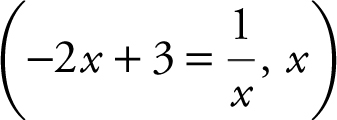 and obtain x = 1 or
and obtain x = 1 or 
3. Find the linear approximation of f (x ) = x 3 at x = 1 and use the equation to find f (1.1).
Answer : f (1) = 1 ⇒ (1, 1) is on the tangent line and f ′(x ) = 3x 2 ⇒ f ′(1) = 3.
y – 1 = 3(x – 1) or y = 3x – 2.
f (1.1) ≈ 3(1.1) – 2 ≈ 1.3
4. (See Figure 10.4-1 .)
(a) When is the acceleration zero? (b) Is the particle moving to the right or left?

Figure 10.4-1
Answer : (a) a (t ) = v ′(t ) and v ′(t ) is the slope of the tangent. Thus, a (t ) = 0 at t = 2.
(b) Since v (t ) ≥ 0, the particle is moving to the right.
5. Find the maximum acceleration of the particle whose velocity function is v (t ) = t 2 + 3 on the interval 0 ≤ t ≤ 4.
Answer : a (t ) = v ′(t ) = 2(t ) on the interval 0 ≤ t ≤ 4, a (t ) has its maximum value at t = 4. Thus a (t ) = 8. The maximum acceleration is 8.
10.5 Practice Problems
Part A—The use of a calculator is not allowed.
1 . Find the linear approximation of f (x ) = (1 + x )1/4 at x = 0 and use the equation to approximate f (0.1).
2 . Find the approximate value of  using linear approximation.
using linear approximation.
3 . Find the approximate value of cos 46° using linear approximation.
4 . Find the point on the graph of y = |x 3 | such that the tangent at the point is parallel to the line y – 12x = 3.
5 . Write an equation of the normal to the graph of y = ex at x = ln 2.
6 . If the line y – 2x = b is tangent to the graph y = –x 2 + 4, find the value of b .
7 . If the position function of a particle  , find the velocity and position of particle when its acceleration is 0.
, find the velocity and position of particle when its acceleration is 0.
8 . The graph in Figure 10.5-1 represents the distance in feet covered by a moving particle in t seconds. Draw a sketch of the corresponding velocity function.
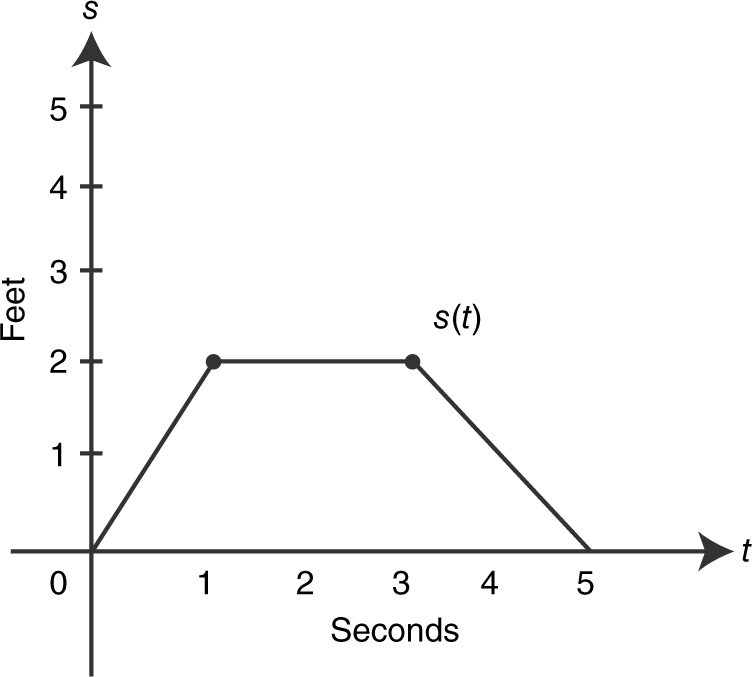
Figure 10.5-1
9 . The position function of a moving particle is shown in Figure 10.5-2 .

Figure 10.5-2
For which value(s) of t (t 1 , t 2 , t 3 ) is:
(a) the particle moving to the left?
(b) the acceleration negative?
(c) the particle moving to the right and slowing down?
10 . The velocity function of a particle is shown in Figure 10.5-3 .

Figure 10.5-3
(a) When does the particle reverse direction?
(b) When is the acceleration 0?
(c) When is the speed the greatest?
11 . A ball is dropped from the top of a 640-foot building. The position function of the ball is s (t ) = –16t 2 + 640, where t is measured in seconds and s (t ) is in feet. Find:
(a) The position of the ball after 4 seconds.
(b) The instantaneous velocity of the ball at t = 4.
(c) The average velocity for the first 4 seconds.
(d) When the ball will hit the ground.
(e) The speed of the ball when it hits the ground.
12 . The graph of the position function of a moving particle is shown in Figure 10.5-4 .

Figure 10.5-4
(a) What is the particle’s position at t = 5?
(b) When is the particle moving to the left?
(c) When is the particle standing still?
(d) When does the particle have the greatest speed?
Part B—Calculators are allowed.
13 . The position function of a particle moving on a line is s (t ) = t 3 – 3t 2 + 1, t ≥ 0 where t is measured in seconds and s in meters. Describe the motion of the particle.
14 . Find the linear approximation of f (x ) = sin x at x = π . Use the equation to find the approximate value of  .
.
15 . Find the linear approximation of f (x ) = ln (1 + x ) at x = 2.
16 . Find the coordinates of each point on the graph of y 2 = 4 – 4x 2 at which the tangent line is vertical. Write an equation of each vertical tangent.
17 . Find the value(s) of x at which the graphs of y = ln x and y = x 2 + 3 have parallel tangents.
18 . The position functions of two moving particles are s 1 (t ) = ln t and s 2 (t ) = sin t and the domain of both functions is 1 ≤ t ≤ 8. Find the values of t such that the velocities of the two particles are the same.
19 . The position function of a moving particle on a line is s (t ) = sin(t ) for 0 ≤ t ≤ 2π . Describe the motion of the particle.
20 . A coin is dropped from the top of a tower and hits the ground 10.2 seconds later. The position function is given as s (t ) = –16t 2 – v 0 t + s 0 , where s is measured in feet, t in seconds, and v 0 is the initial velocity and s 0 is the initial position. Find the approximate height of the building to the nearest foot.
10.6 Cumulative Review Problems
(Calculator) indicates that calculators are permitted.
21 . Find  if y = x sin–1 (2x ).
if y = x sin–1 (2x ).
22 . Given f (x ) = x 3 – 3x 2 + 3x – 1 and the point (1, 2) is on the graph of f –1 (x ). Find the slope of the tangent line to the graph of f –1 (x ) at (1, 2).
23 . Evaluate  .
.
24 . A function f is continuous on the interval (–1, 8) with f (0) = 0, f (2) = 3, and f (8) = 1/2 and has the following properties:

(a) Find the intervals on which f is increasing or decreasing.
(b) Find where f has its absolute extrema.
(c) Find where f has the points of inflection.
(d) Find the intervals on which f is concave upward or downward.
(e) Sketch a possible graph of f .
25 . The graph of the velocity function of a moving particle for 0 ≤ t ≤ 8 is shown in Figure 10.6-1 . Using the graph:
(a) Estimate the acceleration when v (t ) = 3 ft/sec.
(b) Find the time when the acceleration is a minimum.

Figure 10.6-1
10.7 Solutions to Practice Problems
Part A—The use of a calculator is not allowed.
1 . Equation of tangent line:

2 . f (a + Δx ) ≈ f (a ) + f ′(a )Δx
Let  and f (28) = f (27+1).
and f (28) = f (27+1).

3 . f (a + Δx ) ≈ f (a ) + f ′(a ) Δx Convert to radians:

Let f (x ) = cos x and f (45°) =

Then f ′(x ) = – sin x and

4 . Step 1: Find m tangent .
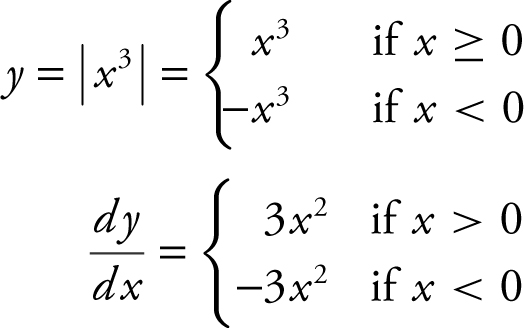
Step 2: Set m tangent = slope of line y – 12x = 3.
Since y – 12x = 3 ⇒ y = 12x + 3, then m = 12.
Set 3x 2 = 12 ⇒ x = ±2
since x ≥ 0, x = 2.
Set –3x 2 = 12 ⇒ x 2 = –4. Thus ∅.
Step 3: Find the point on the curve. (See Figure 10.7-1 .)

Figure 10.7-1
At x = 2, y = x 3 = 23 = 8.
Thus, the point is (2, 8).
5 . Step 1: Find m tangent .

Step 2: Find m normal .
At x = ln 2, m normal = 
Step 3: Write equation of normal. At x = ln 2, y = ex = e ln2 = 2. Thus the point of tangency is (ln 2, 2). The equation of normal:

6 . Step 1: Find m tangent .

Step 2: Find the slope of line y – 2x = b
y – 2x = b ⇒
y = 2x + b or m = 2.
Step 3: Find point of tangency.
Set m tangent = slope of line y – 2x = b ⇒ – 2x = 2 ⇒ x = –1.
At x = –1, y = –x 2 + 4 = –(–1)2 + 4 = 3; (–1, 3).
Step 4: Find b .
Since the line y – 2x = b passes through the point (–1, 3), thus 3 – 2(–1) = b or b = 5.
7 . v (t ) = s ′(t ) = t 2 – 6t ;
a (t ) = v ′(t ) = s ″(t ) = 2t – 6
Set a (t ) = 0 ⇒ 2t – 6 = 0 or t = 3. v (3) = (3)2 – 6(3) = – 9;
 .
.
8 . On the interval (0, 1), the slope of the line segment is 2. Thus the velocity v (t ) = 2 ft/sec. On (1, 3), v (t ) = 0 and on (3, 5), v (t ) = –1. (See Figure 10.7-2 .)
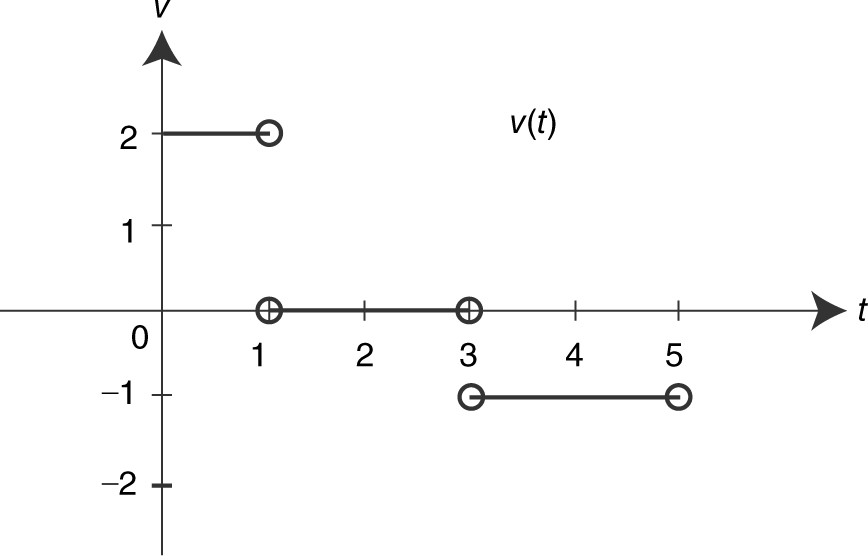
Figure 10.7-2
9 . (a) At t = t 2 , the slope of the tangent is negative. Thus, the particle is moving to the left.
(b) At t = t 1 , and at t = t 2 , the curve is concave downward  acceleration is negative.
acceleration is negative.
(c) At t = t 1 , the slope > 0 and thus the particle is moving to the right. The curve is concave downward ⇒ the particle is slowing down.
10 . (a) At t = 2, v (t ) changes from positive to negative, and thus the particle reverses its direction.
(b) At t = 1, and at t = 3, the slope of the tangent to the curve is 0. Thus, the acceleration is 0.
(c) At t = 3, speed is equal to |– 5| = 5 and 5 is the greatest speed.
11 . (a) s (4) = –16(4)2 + 640 = 384 ft
(b) v (t ) = s ′(t ) = –32t
v (4) =–32(4) ft/s = –128 ft/sec
(c) Average velocity = 

(d) Set s (t ) = 0 ⇒ –16t 2 + 640 = 0 ⇒ 16t 2 = 640 or t = ±  .
.
Since t ≥ 0, or t = ±  or t ≈ 6.32 sec.
or t ≈ 6.32 sec.
(e) |v ( )| = |–32(
)| = |–32( | = | – 64
| = | – 64 | ft/s or ≈ 202.39 ft/sec
| ft/s or ≈ 202.39 ft/sec
12 . (a) At t = 5, s (t ) = 1.
(b) For 3 < t < 4, s (t ) decreases. Thus, the particle moves to the left when 3 < t < 4.
(c) When 4 < t < 6, the particle stays at 1.
(d) When 6 < t < 7, speed = 2 ft/sec, the greatest speed, which occurs where s has the greatest slope.
Part B—Calculators are allowed.
13 . Step 1: v (t ) = 3t 2 – 6t
a (t ) = 6t – 6
Step 2: Set v (t ) = 0 ⇒ 3t 2 – 6t = 0 ⇒ 3t (t – 2) = 0, or t = 0 or t = 2 Set a (t ) = 0 ⇒ 6t – 6 = 0 or t = 1.
Step 3: Determine the directions of motion. (See Figure 10.7-3 .)

Figure 10.7-3
Step 4: Determine acceleration. (See Figure 10.7-4 .)

Figure 10.7-4
Step 5: Draw the motion of the particle. (See Figure 10.7-5 .) s (0) = 1, s (1) = –1, and s (2) = –3.

Figure 10.7-5
The particle is initially at 1 (t = 0). It moves to the left speeding up until t = 1, when it reaches –1. Then it continues moving to the left, but slowing down until t = 2 at –3. The particle reverses direction, moving to the right and speeding up indefinitely.
14 . Linear approximation:
y = f (a ) + f ′(a )(x – a ) a = π
f (x ) = sin x and f (π ) = sin π = 0
f ′(x ) = cos x and f ′(π ) = cos π = –1.
Thus, y = 0 + (–1)(x –π ) or
y = –x + π .
 is approximately:
is approximately:
 or ≈ –0.0175.
or ≈ –0.0175.
15 . y = f (a ) + f ′(a )(x – a )
f (x ) = ln (1 + x ) and f (2) = ln (1 + 2) = ln 3
 and
and 
Thus,  .
.
16 . Step 1: Find  .
.
y 2 = 4 – 4x 2

Step 2: Find  .
.

Set  or y = 0.
or y = 0.
Step 3: Find points of tangency.
At y = 0, y 2 = 4 – 4x 2 becomes 0 = 4 – 4x 2
⇒ x = ±1.
Thus, points of tangency are (1, 0) and (–1, 0).
Step 4: Write equations of vertical tangents x = 1 and x = –1.
17 . Step 1: Find  for y = ln x and y = x2 + 3.
for y = ln x and y = x2 + 3.

Step 2: Find the x -coordinate of point(s) of tangency.
Parallel tangents ⇒ slopes are equal. Set  .
.
Using the [Solve ] function of your calculator, enter [Solve ]  and obtain
and obtain 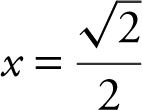 or
or  . Since for y = ln x ,
. Since for y = ln x ,  .
.
18 . s 1 (t ) = ln t and  .
.
s 2 (t ) = sin(t ) and
s ′2 (t ) = cos(t ); 1 ≤ t ≤ 8.
Enter  and y 2 = cos(x ). Use the [Intersection ] function of the calculator and obtain t = 4.917 and t = 7.724.
and y 2 = cos(x ). Use the [Intersection ] function of the calculator and obtain t = 4.917 and t = 7.724.
19 . Step 1: s (t ) = sin t
v (t ) = cos t
a (t ) = – sin t
Step 2: Set v (t ) = 0 ⇒ cos t = 0;
 and
and  .
.
Set a (t ) = 0 ⇒ – sin t = 0; t =π and 2π.
Step 3: Determine the directions of motion. (See Figure 10.7-6 .)

Figure 10.7-6
Step 4: Determine acceleration. (See Figure 10.7-7 .)

Figure 10.7-7
Step 5: Draw the motion of the particle. (See Figure 10.7-8 .)

Figure 10.7-8
The particle is initially at 0, s (0) = 0. It moves to the right but slows down to a stop at 1 when  = 1. It then turns and moves to the left speeding up until it reaches 0, when t = π, s (π) = 0 and continues to the left, but slowing down to a stop at – 1 when
= 1. It then turns and moves to the left speeding up until it reaches 0, when t = π, s (π) = 0 and continues to the left, but slowing down to a stop at – 1 when  . It then turns around again, moving to the right, speeding up to 0 when t = 2π, s (2π) = 0.
. It then turns around again, moving to the right, speeding up to 0 when t = 2π, s (2π) = 0.
20 . s (t ) = – 16t 2 + v 0 t + s 0
s 0 = height of building and v 0 = 0.
Thus, s (t ) =– 16t 2 + s 0 .
When the coin hits the ground, s (t ) = 0, t = 10.2. Thus, set s (t ) = 0 ⇒ – 16t 2 + s 0 = 0 ⇒ – 16(10.2)2 + s 0 = 0 s 0 = 1664.64 ft. The building is approximately 1665 ft tall.
10.8 Solutions to Cumulative Review Problems
21 . Using product rule, let u = x ; v = sin–1 (2x ).

22 . Let y = f (x ) ⇒ y = x 3 – 3x 2 + 3x – 1. To find f –1 (x ), switch x and
y : x = y 3 – 3y 2 + 3y – 1.
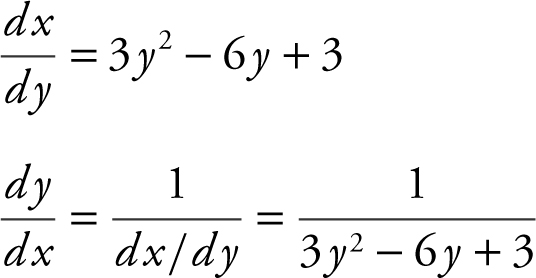

23 . Substituting x = 100 into the expression  would lead to
would lead to  . Apply L’Hôpital’s Rule, and you have
. Apply L’Hôpital’s Rule, and you have  or
or  . Another approach to solve the problem is as follows. Multiply both numerator and denominator by the conjugate of the denominator (
. Another approach to solve the problem is as follows. Multiply both numerator and denominator by the conjugate of the denominator ( + 10):
+ 10):

An alternative solution is to factor the numerator:

24 . (a) f ′ > 0 on (–1, 2), f is increasing on (–1, 2), f ′< 0 on (2, 8), f is decreasing on (2, 8).
(b) At x = 2, f ′ = 0 and f ″ < 0, thus at x = 2, f has a relative maximum. Since it is the only relative extremum on the interval, it is an absolute maximum. Since f is a continuous function on a closed interval and at its endpoints f (–1) < 0 and f (8) = 1/2, f has an absolute minimum at x = –1.
(c) At x = 5, f has a change of concavity and f ′ exists at x = 5.
(d) f ″ < 0 on (–1, 5), f is concave downward on (–1, 5).
f ″ > 0 on (5, 8), f is concave upward on (5, 8).
(e) A possible graph of f is given in Figure 10.8-1 .
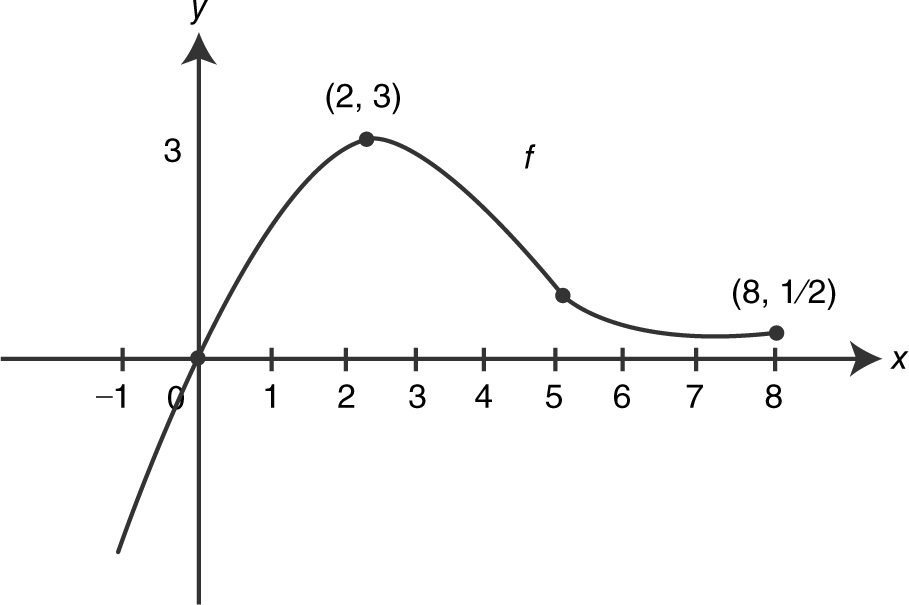
Figure 10.8-1
25 . (a) v (t ) = 3 ft/sec at t = 6. The tangent line to the graph of v (t ) at t = 6 has a slope of approximately m = 1. (The tangent passes through the points (8, 5) and (6, 3); thus m = 1.) Therefore the acceleration is 1 ft/sec2 .
(b) The acceleration is a minimum at t = 0, since the slope of the tangent to the curve of v (t ) is the smallest at t = 0.
CHAPTER 11
Big Idea 3: Integrals and the Fundamental Theorems of Calculus
Integration
IN THIS CHAPTER
Summary: On the AP Calculus AB exam, you will be asked to evaluate integrals of various functions. In this chapter, you will learn several methods of evaluating integrals including U-Substitution. Also, you will be given a list of common integration and differentiation formulas, and a comprehensive set of practice problems. It is important that you work out these problems and check your solutions with the given explanations.

Key Ideas
 Evaluating Integrals of Algebraic Functions
Evaluating Integrals of Algebraic Functions
 Integration Formulas
Integration Formulas
 U-Substitution Method Involving Algebraic Functions
U-Substitution Method Involving Algebraic Functions
 U-Substitution Method Involving Trigonometric Functions
U-Substitution Method Involving Trigonometric Functions
 U-Substitution Method Involving Inverse Trigonometric Functions
U-Substitution Method Involving Inverse Trigonometric Functions
 U-Substitution Method Involving Logarithmic and Exponential Functions
U-Substitution Method Involving Logarithmic and Exponential Functions
11.1 Evaluating Basic Integrals
Main Concepts: Antiderivatives and Integration Formulas, Evaluating Integrals

Antiderivatives and Integration Formulas
Definition: A function F is an antiderivative of another function f if F ′ (x ) = f (x ) for all x in some open interval. Any two antiderivatives of f differ by an additive constant C . We denote the set of antiderivatives of f by  f (x )dx , called the indefinite integral of f .
f (x )dx , called the indefinite integral of f .
Integration Rules:
1. 
2. 
3. 
4. 


More Integration Formulas:
16. 
17. 
18. 
19. 
20. 
21. 
22. 
23. 
24. 
Note: After evaluating an integral, always check the result by taking the derivative of the answer (i.e., taking the derivative of the antiderivative).

Evaluating Integrals

Example 1
Evaluate 
Applying the formula 

Example 2
Evaluate 
Rewrite 
Example 3
If  , and the point (0, –1) lies on the graph of y , find y .
, and the point (0, –1) lies on the graph of y , find y .
Since  , then y is an antiderivative of
, then y is an antiderivative of  . Thus,
. Thus,  dx = x 3 + 2x + C. The point (0, – 1) is on the graph of y .
dx = x 3 + 2x + C. The point (0, – 1) is on the graph of y .
Thus, y = x 3 + 2x + C becomes –1 = 03 + 2(0) + C or C = –1. Therefore, y = x 3 + 2x – 1.
Example 4
Evaluate 
Rewrite as 
Example 5
Evaluate 
Rewrite as 
Example 6
Evaluate 
Rewrite: 
Example 7
Evaluate 

Example 8
Evaluate 

Example 9
Evaluate 
Rewrite: 
Example 10
Evaluate 
Rewrite the integral as 
Example 11
Evaluate 
Rewrite as 3 
Example 12
Evaluate 
Rewrite as 
Example 13
Evaluate 


Reminder: You can always check the result by taking the derivative of the answer.

11.2 Integration by U-Substitution
Main Concepts: The U-Substitution Method, U-Substitution and Algebraic Functions, U-Substitution and Trigonometric Functions, U-Substitution and Inverse Trigonometric Functions, U-Substitution and Logarithmic and Exponential Functions
The U-Substitution Method
The Chain Rule for Differentiation

The Integral of a Composite Function
If f (g (x )) and f ′ are continuous and F ′ = f , then

Making a U-Substitution
Let u = g (x ), then du = g ′(x )dx


Procedure for Making a U-Substitution
Steps:
1. Given f (g (x )); let u = g (x ).
2. Differentiate: du = g ′(x )dx .
3. Rewrite the integral in terms of u .
4. Evaluate the integral.
5. Replace u by g (x ).
6. Check your result by taking the derivative of the answer.
U-Substitution and Algebraic Functions
Another Form of the Integral of a Composite Function
If f is a differentiable function, then

Making a U-Substitution
Let u = f (x ); then du = f ′(x )dx .

Example 1
Evaluate 
Step 1: Let u = x + 1; then x = u – 1.
Step 2: Differentiate: du = dx .
Step 3: Rewrite: 
Step 4: Integrate: 
Step 5: Replace 
Step 6: Differentiate and Check: 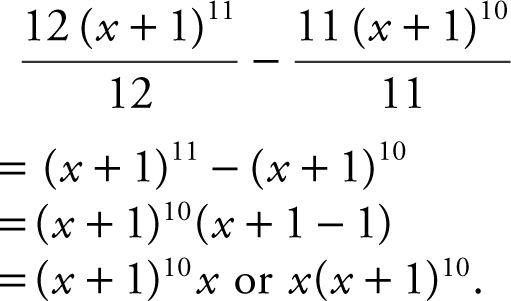
Example 2
Evaluate 
Step 1: Let u = x – 2; then x = u + 2.
Step 2: Differentiate: du = dx .
Step 3: Rewrite: 
Step 4: Integrate: 
Step 5: Replace: 
Step 6: Differentiate and Check: 
Example 3
Evaluate 
Step 1: Let u = 2x – 5.
Step 2: Differentiate: 
Step 3: Rewrite: 
Step 4: Integrate: 
Step 5: Replace: 
Step 6: Differentiate and Check: 
Example 4
Evaluate 
Step 1: Let u = x 3 – 8.
Step 2: Differentiate: 
Step 3: Rewrite: 
Step 4: Integrate: 
Step 5: Replace: 
Step 6: Differentiate and Check: 
U-Substitution and Trigonometric Functions
Example 1
Evaluate 
Step 1: Let u = 4x .
Step 2: Differentiate: 
Step 3: Rewrite: 
Step 4: Integrate: 
Step 5: Replace: 
Step 6: Differentiate and Check: 
Example 2
Evaluate 
Step 1: Let u = tan x .
Step 2: Differentiate: du = sec2 x dx .
Step 3: Rewrite: 
Step 4: Integrate: 
Step 5: Replace u : 2(tan x )3 /2 + C or 2 tan3 /2 x + C .
Step 6: Differentiate and Check: 
Example 3
Evaluate 
Step 1: Let u = x 3 .
Step 2: Differentiate: 
Step 3: Rewrite: 
Step 4: Integrate: 
Step 5: Replace: 
Step 6: Differentiate and Check: 

U-Substitution and Inverse Trigonometric Functions
Example 1
Evaluate 
Step 1: Let u = 2x .
Step 2: Differentiate: 
Step 3: Rewrite: 
Step 4: Integrate: 
Step 5: Replace: 
Step 6: Differentiate and Check: 
Example 2
Evaluate 
Step 1: Rewrite: 
Let u = x + 1.
Step 2: Differentiate: du = dx .
Step 3: Rewrite: 
Step 4: Integrate: 
Step 5: Replace: 
Step 6: Differentiate and Check: 

U-Substitution and Logarithmic and Exponential Functions
Example 1
Evaluate 
Step 1: Let u = x 4 – 1.
Step 2: Differentiate: 
Step 3: Rewrite: 
Step 4: Integrate: 
Step 5: Replace: 
Step 6: Differentiate and Check: 
Example 2
Evaluate 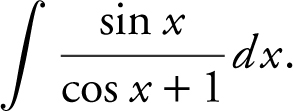
Step 1: Let u = cos x + 1.
Step 2: Differentiate: du = – sin xdx ⇒ –du = sin xdx .
Step 3: Rewrite: 
Step 4: Integrate: –ln |u | + C .
Step 5: Replace u : –ln |cos x + 1| + C .
Step 6: Differentiate and Check: 
Example 3
Evaluate 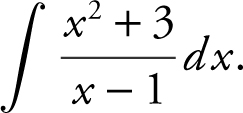
Step 1: Rewrite  ; by dividing (x 2 + 3) by (x – 1).
; by dividing (x 2 + 3) by (x – 1).

Let u = x – 1.
Step 2: Differentiate: du = dx .
Step 3: Rewrite:  .
.
Step 4: Integrate: 4 ln|u | + C .
Step 5: Replace u : 4 ln|x – 1| + C .

Step 6: Differentiate and Check:

Example 4
Evaluate 
Step 1: Let u = ln x .
Step 2: Differentiate: 
Step 3: Rewrite: 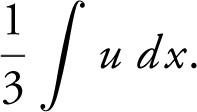
Step 4: Integrate: 
Step 5: Replace 
Step 6: Differentiate and Check: 
Example 5
Evaluate 
Step 1: Let u = 2x – 5.
Step 2: Differentiate: 
Step 3: Rewrite: 
Step 4: Integrate: 
Step 5: Replace 
Step 6: Differentiate and Check: 
Example 6
Evaluate 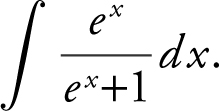
Step 1: Let u = ex + 1.
Step 2: Differentiate: du = ex dx .
Step 3: Rewrite: 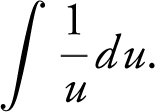
Step 4: Integrate: ln |u | + C .
Step 5: Replace u : ln |ex + 1| + C .
Step 6: Differentiate and Check: 
Example 7
Evaluate 
Step 1: Let u = 3x 2 .
Step 2: Differentiate: 
Step 3: Rewrite: 
Step 4: Integrate: 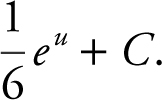
Step 5: Replace: 
Step 6: Differentiate and Check: 
Example 8
Evaluate 
Step 1: Let u = 2x .
Step 2: Differentiate: 
Step 3: Rewrite: 
Step 4: Integrate: 
Step 5: Replace: 
Step 6: Differentiate and Check: 
Example 9
Evaluate 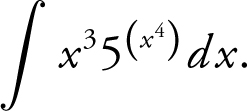
Step 1: Let u = x 4 .
Step 2: Differentiate: 
Step 3: Rewrite: 
Step 4: Integrate: 
Step 5: Replace: 
Step 6: Differentiate and Check: 
Example 10
Evaluate 
Step 1: Let u = cos π x .
Step 2: Differentiate: 
Step 3: Rewrite: 
Step 4: Integrate: 
Step 5: Replace: 
Step 6: Differentiate and Check: 
11.3 Rapid Review
1. Evaluate 
Answer: Rewrite as 
2. Evaluate 
Answer: Rewrite as 
3. Evaluate 
Answer: Rewrite as  . Let u = x 2 – 1.
. Let u = x 2 – 1.
Thus, 
4. Evaluate 
Answer: – cos x + C .
5. Evaluate 
Answer: Let u = 2x and obtain 
6. Evaluate 
Answer: Let u = ln  and obtain
and obtain 
7. Evaluate 
Answer: Let  and obtain
and obtain 
11.4 Practice Problems
Evaluate the following integrals in problems 1 to 20. No calculators are allowed. (However, you may use calculators to check your results.)
1 . 
2 . 
3 . 
4 . 
5 . 
6 . 
7 . 
8 . 
9 . 
10 . 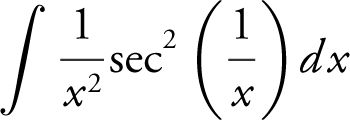
11 . 
12 . 
13 . 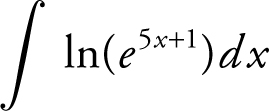
14 . 
15 . 
16 . 
17 . If  and the point (0, 6) is on the graph of y , find y .
and the point (0, 6) is on the graph of y , find y .
18 . 
19 . 
20 . If f (x ) is the antiderivative of  and f (1) = 5, find f (e ).
and f (1) = 5, find f (e ).
11.5 Cumulative Review Problems
(Calculator) indicates that calculators are permitted.
21 . The graph of the velocity function of a moving particle for 0 ≤ t ≤ 10 is shown in Figure 11.5-1 .
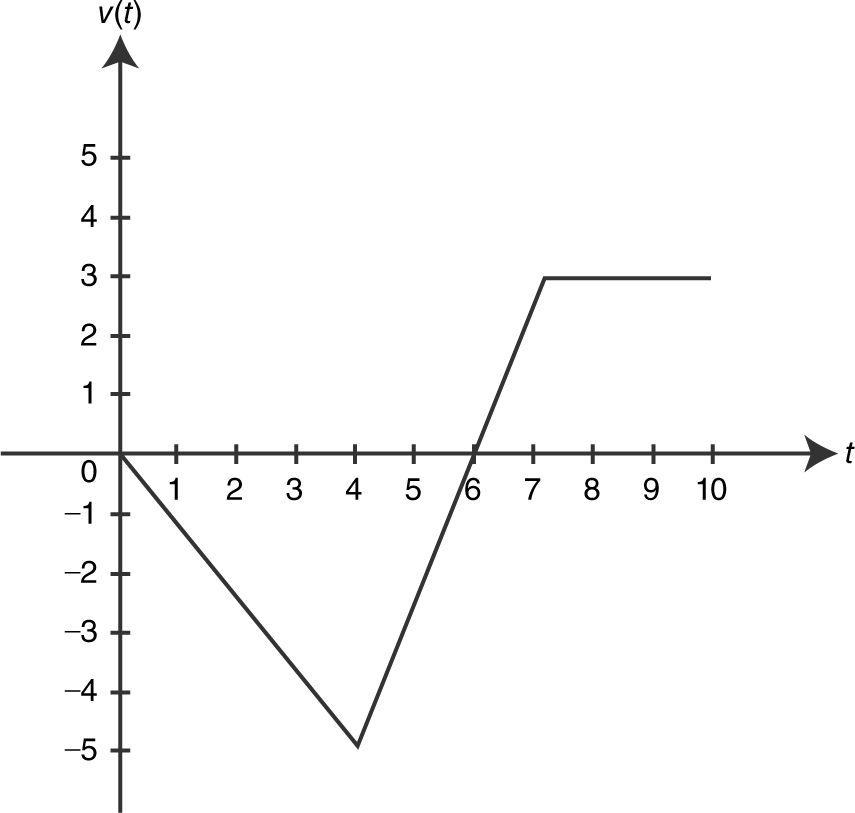
Figure 11.5-1
(a) At what value of t is the speed of the particle the greatest?
(b) At what time is the particle moving to the right?
22 . Air is pumped into a spherical balloon, whose maximum radius is 10 meters. For what value of r is the rate of increase of the volume a hundred times that of the radius?
23 . Evaluate 
24 . (Calculator) The function f is continuous and differentiable on (0, 2) with f ″ (x ) > 0 for all x in the interval (0, 2).
Some of the points on the graph are shown below.

Which of the following is the best approximation for f ′ (1)?
(a) f ′ (1) < 2
(b) 0.5 < f ′ (1) < 1
(c) 1.5 < f ′ (1) < 2.5
(d) 2.5 < f ′ (1) < 3.5
(e) f ′ (1) > 2
25 . The graph of the function f ″ on the interval [1, 8] is shown in Figure 11.5-2 . At what value(s) of t on the open interval (1, 8), if any, does the graph of the function f ′ :

Figure 11.5-2
(a) have a point of inflection?
(b) have a relative maximum or minimum?
(c) become concave upward?
11.6 Solutions to Practice Problems
1 . 
2 . Rewrite: 
3 . Let u = x 4 – 10; du = 4x 3 dx or  .
.
Rewrite: 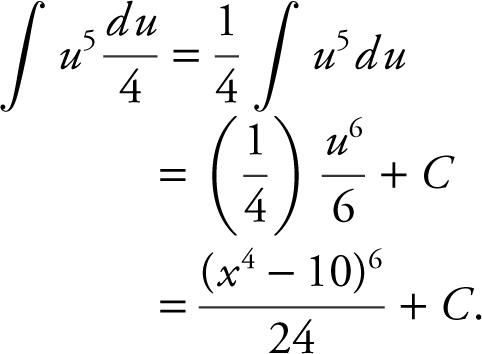
4 . Let u = x 2 + 1 ⇒ (u – 1) = x 2 and du = 2x dx or 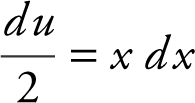 .
.
Rewrite: 

5 . Let u = x – 1; du = dx and (u + 1) = x .


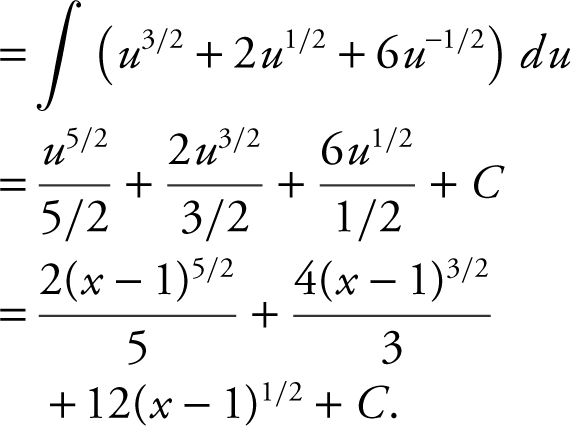
6 . Let  or 2du = dx .
or 2du = dx .
Rewrite: 
7 . Let u = x 2 ; du = 2x dx or 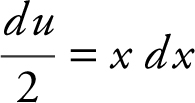 .
.
Rewrite: 
8 . Let u = cos x ; du = – sin x dx or –du = sin x dx .
Rewrite: 

9 . Rewrite: 
Let u = x + 1; du = dx .
Rewrite: 

10 . Let 
Rewrite: 
11 . Rewrite: 
Let u = 6x ; du = 6 dx or  .
.
Rewrite: 

12 . Let u = ln x ; 
Rewrite: 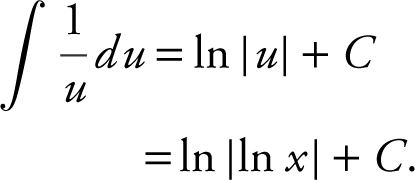
13 . Since ex and ln x are inverse functions:

14 . Rewrite: 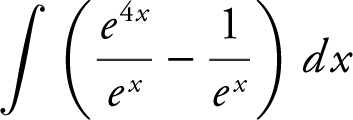

Let u = 3x ; du = 3dx ;

Let v = –x ; dv = – dx ;

Thus, 

Note: C 1 and C 2 are arbitrary constants, and thus C 1 + C 2 = C .
15 . Rewrite:
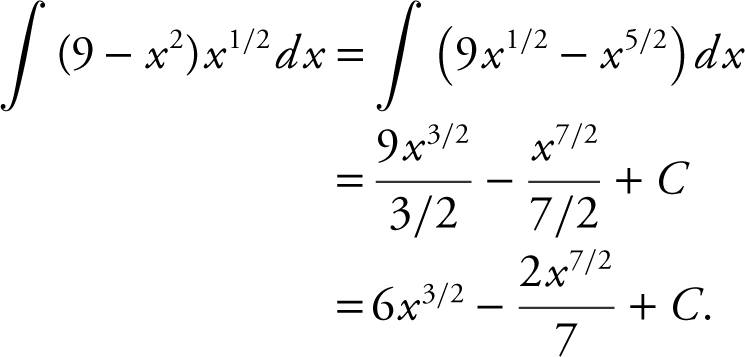
16 . Let  or
or

Rewrite: 

17 . Since  , then y =
, then y =

The point (0, 6) is on the graph of y .
Thus, 6 = e 0 + 2(0) + C ⇒ 6 = 1 + C or C = 5. Therefore, y = e x + 2x + 5.
18 . Let u = ex ; du = ex dx .
Rewrite: 
19 . Let u = ex + e– x ; du = (ex – e – x ) dx .

20 . Since f (x ) is the antiderivative of  ,
,

Given f (1) = 5; thus, ln (1) + C = 5 ⇒ 0 + C =5 or C = 5.
Thus, f (x ) = ln | x | + 5 and f (e ) = ln (e ) + 5 = 1 + 5 = 6.
11.7 Solutions to Cumulative Review Problems
21 . (a) At t = 4, speed is 5 which is the greatest on 0 ≤ t ≤ 10.
(b) The particle is moving to the right when 6 < t < 10.
22 . 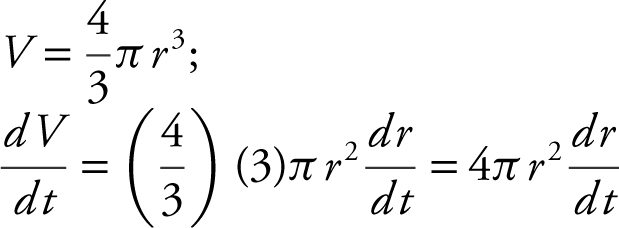

23 . Let u = ln x ;  .
.
Rewrite: 
24 . Label given points as A, B, C, D, and E. Since f ″(x ) > 0 ⇒ f is concave upward for all x in the interval [0, 2]. Thus,  < f ′(x ) <
< f ′(x ) < 
 = 1.5 and
= 1.5 and  = 2.5. Therefore, 1.5 < f ′(1) < 2.5, choice (c). (See Figure 11.7-1 .)
= 2.5. Therefore, 1.5 < f ′(1) < 2.5, choice (c). (See Figure 11.7-1 .)
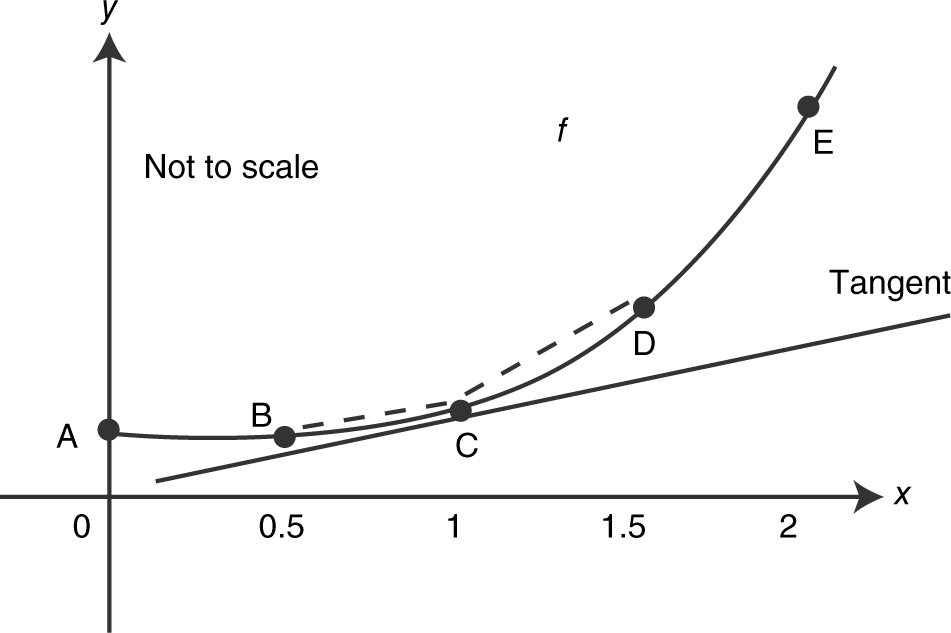
Figure 11.7-1
25 . (a) f ″ is decreasing on [1, 6) ⇒ f ″ < 0 ⇒ f ′ is concave downward on [1, 6) and f ′ is increasing on (6, 8] ⇒ f ′ is concave upward on (6, 8]. Thus, at x = 6, f ′ has a change of concavity. Since f ″ exists at x = 6 (which implies there is a tangent to the curve of f ′ at x = 6), f ′ has a point of inflection at x = 6.
(b) f ″ > 0 on [1, 4] ⇒ f ′ is increasing and f ″ < 0 on (4, 8] ⇒ f ′ is decreasing. Thus at x = 4, f ′ has a relative maximum at x = 4. There is no relative minimum.
(c) f ″ is increasing on [6, 8] ⇒ f ′ > 0 ⇒ f ′ is concave upward on [6, 8].
CHAPTER 12
Big Idea 3: Integrals and the Fundamental Theorems of Calculus
Definite Integrals
IN THIS CHAPTER
Summary: In this chapter, you will be introduced to the summation notation, the concept of a Riemann Sum, the Fundamental Theorems of Calculus, and the properties of definite integrals. You will also be shown techniques for evaluating definite integrals involving algebraic, trigonometric, logarithmic, and exponential functions. In addition, you will learn how to work with improper integrals. The ability to evaluate integrals is a prerequisite to doing well on the AP Calculus AB exam.

Key Ideas
 Summation Notation
Summation Notation
 Riemann Sums
Riemann Sums
 Properties of Definite Integrals
Properties of Definite Integrals
 The First Fundamental Theorem of Calculus
The First Fundamental Theorem of Calculus
 The Second Fundamental Theorem of Calculus
The Second Fundamental Theorem of Calculus
 Evaluating Definite Integrals
Evaluating Definite Integrals
12.1 Riemann Sums and Definite Integrals
Main Concepts: Sigma Notation, Definition of a Riemann Sum, Definition of a Definite Integral, and Properties of Definite Integrals
Sigma Notation or Summation Notation

where i is the index of summation, l is the lower limit, and n is the upper limit of summation. (Note: The lower limit may be any non-negative integer ≤ n .)
Examples

Summation Formulas
If n is a positive integer, then:
1. 
2. 
3. 
4. 
5. 
Example
 .
.

(Note: This question has not appeared in an AP Calculus AB exam in recent years.)

Definition of a Riemann Sum
Let f be defined on [a , b ] and xi be points on [a , b ] such that x 0 = a , xn = b , and a < x 1 < x 2 < x 3 … < x n –1 < b . The points a , x 1 , x 2 , x 3 , … x n –1 , and b form a partition of f denoted as Δ on [a , b ]. Let Δxi be the length of the i th interval [x i –1 , xi ] and ci be any point in the i th interval. Then the Riemann sum of f for the partition is  .
.
Example 1
Let f be a continuous function defined on [0, 12] as shown below.

Find the Riemann sum for f (x ) over [0, 12] with 3 subdivisions of equal length and the midpoints of the intervals as ci .
Length of an interval  . (See Figure 12.1-1 .)
. (See Figure 12.1-1 .)

Figure 12.1-1

The Riemann sum is 596.
Example 2
Find the Riemann sum for f (x ) = x 3 + 1 over the interval [0, 4] using 4 subdivisions of equal length and the midpoints of the intervals as ci . (See Figure 12.1-2 .)

Figure 12.1-2
Length of an interval  .
.

Enter Σ ((1 – 0.5)3 + 1, i , 1, 4) = 66.
The Riemann sum is 66.
Definition of a Definite Integral
Let f be defined on [a , b ] with the Riemann sum for f over [a , b ] written as  .
.
If max Δxi is the length of the largest subinterval in the partition and the  exists, then the limit is denoted by:
exists, then the limit is denoted by:
 .
.
 is the definite integral of f from a to b .
is the definite integral of f from a to b .
Example 1
Use a midpoint Riemann sum with three subdivisions of equal length to find the approximate value of  .
.

midpoints are x = 1, 3, and 5.

Example 2
Using the limit of the Riemann sum, find  .
.
Using n subintervals of equal lengths, the length of an interval

Let ci = xi ; max Δxi → 0 ⇒ n → ∞.

Thus, 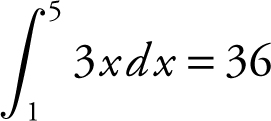
(Note: This question has not appeared in an AP Calculus AB exam in recent years.)
Properties of Definite Integrals
1. If f is defined on [a , b ], and the  exists, then f is integrable on [a , b ].
exists, then f is integrable on [a , b ].
2. If f is continuous on [a , b ], then f is integrable on [a , b ].
If f (x ), g (x ), and h (x ) are integrable on [a , b ], then
3. 
4. 
5.  when C is a constant.
when C is a constant.
6. 
7.  provided f (x ) ≥ 0 on [a , b ].
provided f (x ) ≥ 0 on [a , b ].
8.  provided f (x ) ≥ g (x ) on [a , b ].
provided f (x ) ≥ g (x ) on [a , b ].
9. 
10.  ; provided g (x ) ≤ f (x ) ≤ h (x ) on [a , b ].
; provided g (x ) ≤ f (x ) ≤ h (x ) on [a , b ].
11.  ; provided m ≤ f (x ) ≤ M on [a , b ].
; provided m ≤ f (x ) ≤ M on [a , b ].
12.  ; provided f (x ) is integrable on an interval containing a , b , c .
; provided f (x ) is integrable on an interval containing a , b , c .
Examples
1. 
2. 
3. 
4. 
5. 
Note: Or 
 do not have to be arranged from smallest to largest.
do not have to be arranged from smallest to largest.
The remaining properties are best illustrated in terms of the area under the curve of the function as discussed in the next section.

12.2 Fundamental Theorems of Calculus
Main Concepts: First Fundamental Theorem of Calculus, Second Fundamental Theorem of Calculus
First Fundamental Theorem of Calculus
If f is continuous on [a , b ] and F is an antiderivative of f on [a , b ], then
 .
.
Note: F (b ) – F (a ) is often denoted as  .
.
Example 1
Evaluate  .
.
 .
.
Example 2
Evaluate  .
.

Example 3
If  , find k .
, find k .


Example 4
If f ′ (x ) = g (x ), and g is a continuous function for all real values of x , express  in terms of f .
in terms of f .
Let u = 3x ; du = 3dx or  .
.

Example 5
Evaluate  .
.
Cannot evaluate using the First Fundamental Theorem of Calculus since  is discontinuous at x = 1.
is discontinuous at x = 1.
Example 6
Using a graphing calculator, evaluate  .
.
Using a TI-89 graphing calculator, enter  and obtain 2π .
and obtain 2π .
Second Fundamental Theorem of Calculus
If f is continuous on [a , b ] and  , then F ′ (x ) = f (x ) at every point x in [a , b ].
, then F ′ (x ) = f (x ) at every point x in [a , b ].
Example 1
Evaluate  .
.
Let u = 2t ; du = 2dt or  .
.

Example 2

Example 3
Find  ; if y =
; if y =  .
.
Let u = 2x ; then  .
.
Rewrite: 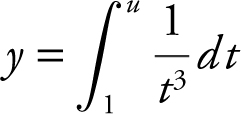 .
.

Example 4
Find  ; if
; if  .
.
Rewrite:  .
.
Let u = x 2 ; then  .
.
Rewrite:  .
.

Example 5
Find  ; if
; if  .
.


Example 6
 , integrate to find F (x ) and then differentiate to find f ′ (x ).
, integrate to find F (x ) and then differentiate to find f ′ (x ).

12.3 Evaluating Definite Integrals
Main Concepts: Definite Integrals Involving Algebraic Functions; Definite Integrals Involving Absolute Value; Definite Integrals Involving Trigonometric, Logarithmic, and Exponential Functions; Definite Integrals Involving Odd and Even Functions

Definite Integrals Involving Algebraic Functions
Example 1
Evaluate  .
.

Verify your result with a calculator.
Example 2
Evaluate  .
.
Begin by evaluating the indefinite integral  .
.
Let u = x 2 – 1; du = 2x dx or  .
.
Rewrite:  .
.
Thus the definite integral 

Verify your result with a calculator.
Example 3
Evaluate  .
.
Rewrite: 
Verify your result with a calculator.

Definite Integrals Involving Absolute Value
Example 1
Evaluate  .
.
Set 3x – 6 = 0; x = 2; thus  .
.
Rewrite integral:

Verify your result with a calculator.
Example 2
Evaluate  .
.
Set x 2 – 4 = 0; x = ± 2.
Thus  .
.
 .
.
Verify your result with a calculator.

Definite Integrals Involving Trigonometric, Logarithmic, and Exponential Functions
Example 1
Evaluate  .
.
Rewrite:  .
.
Verify your result with a calculator.
Example 2
Evaluate  .
.
Let u = 3t ; du = 3dt or  .
.

Verify your result with a calculator.
Example 3
 .
.
Verify your result with a calculator.
Example 4
 .
.
Verify your result with a calculator.
Definite Integrals Involving Odd and Even Functions
If f is an even function, that is, f (–x ) = f (x ), and is continuous on [–a , a ], then
 .
.
If f is an odd function, that is, F (x ) = – f (–x ), and is continuous on [–a , a ], then
 .
.
Example 1
Evaluate 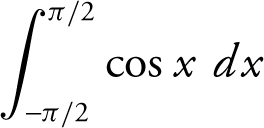 .
.
Since f (x ) = cos x is an even function,

Verify your result with a calculator.
Example 2
Evaluate 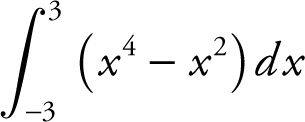 .
.
Since f (x ) = x 4 – x 2 is an even function, i.e., f (–x ) = f (x ), thus

Verify your result with a calculator.
Example 3
Evaluate  .
.
Since f (x ) = sin x is an odd function, i.e., f (–x ) = –f (x ), thus
 .
.
Verify your result algebraically.

You can also verify the result with a calculator.
Example 4
If  for all values of k , then which of the following could be the graph of f ? (See Figure 12.3-1 .)
for all values of k , then which of the following could be the graph of f ? (See Figure 12.3-1 .)

Figure 12.3-1

Thus f is an even function. Choice (C).
12.4 Rapid Review
1. Evaluate  .
.
Answer:  .
.
2. Evaluate  .
.
Answer:  .
.
3. If  , find G ′ (4).
, find G ′ (4).
Answer: G ′(x ) = (2x + 1)3/2 and G ′ (4) = 93/2 = 27.
4. If 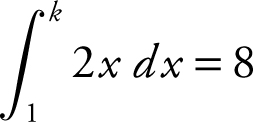 , find k .
, find k .
Answer:  .
.
5. If G (x ) is an antiderivative of (ex + 1) and G (0) = 0, find G (1).
Answer: G (x ) = ex + x + C
G (0) = e 0 + 0 + C = 0 ⇒ C = –1.
G (1) = e 1 + 1 – 1 = e .
6. If G ′ (x ) = g (x ), express  in terms of G (x ).
in terms of G (x ).
Answer: Let  .
.
 . Thus
. Thus  .
.
12.5 Practice Problems
Part A—The use of a calculator is not allowed .
Evaluate the following definite integrals.
1 . 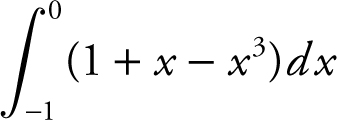
2 . 
3 . 
4 . 
5 . If  = 4, find k .
= 4, find k .
6 . 
7 . If f ′ (x ) = g (x ) and g is a continuous function for all real values of x , express  in terms of f .
in terms of f .
8 . 
9 . 
10 . If  (t )dt , find
(t )dt , find  .
.
11 . 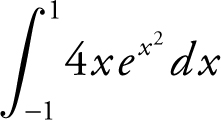
12 . 
Part B—Calculators are allowed.
13 . Find k if  .
.
14 . Evaluate  to the nearest 100th.
to the nearest 100th.
15 . If  , find
, find  .
.
16 . Use a midpoint Riemann sum with four subdivisions of equal length to find the approximate value of  .
.
17 . Given 
and  , find
, find
(a) 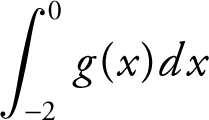
(b) 
(c) 
(d) 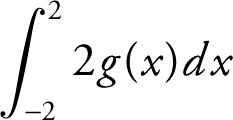
18 . Evaluate  .
.
19 . Find  if
if  .
.
20 . Let f be a continuous function defined on [0, 30] with selected values as shown below:

Use a midpoint Riemann sum with three subdivisions of equal length to find the approximate value of  .
.
12.6 Cumulative Review Problems
(Calculator) indicates that calculators are permitted.
21 . Evaluate  .
.
22 . Find  at x = 3 if y = |x 2 – 4|.
at x = 3 if y = |x 2 – 4|.
23 . The graph of f ′, the derivative of f , –6 ≤ x ≤ 8 is shown in Figure 12.6-1 .

Figure 12.6-1
(a) Find all values of x such that f attains a relative maximum or a relative minimum.
(b) Find all values of x such that f is concave upward.
(c) Find all values of x such that f has a change of concavity.
24 . (Calculator) Given the equation 9x 2 + 4y 2 – 18x + 16y = 11, find the points on the graph where the equation has a vertical or horizontal tangent.
25 . (Calculator) Two corridors, one 6 feet wide and another 10 feet wide meet at a corner. (See Figure 12.6-2 .) What is the maximum length of a pipe of negligible thickness that can be carried horizontally around the corner?

Figure 12.6-2
12.7 Solutions to Practice Problems
Part A—The use of a calculator is not allowed.
1 . 
2 . Let u = x – 2 du = dx .

3 . Let u = t + 1; du = dt and t = u – 1.

4 . Set x – 3 = 0; x = 3.

5 . 
Verify your results by evaluating
 .
.
6 . Let u = 1 + cos x ; du = – sin x dx or – du = sin x dx .

7 . Let u = 4x ; du = 4 dx or  .
.

8 . 
9 . Let u = t + 3; du = dt .

10 . 
11 . 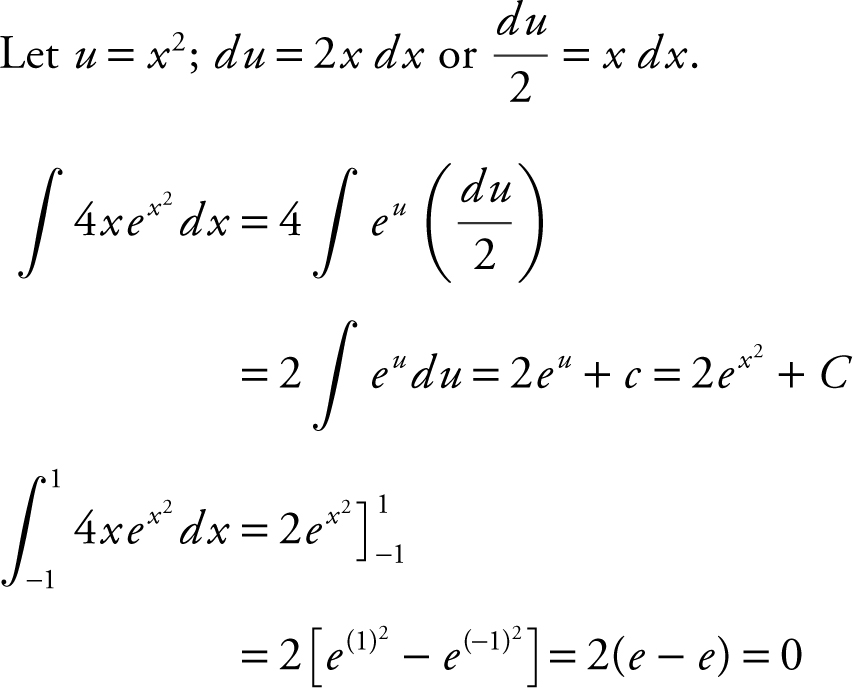
Note that f (x ) = 4xe x 2 is an odd function.
Thus,  .
.
12 . 
Note that f (x ) = cos x – x 2 is an even function. Thus, you could have written  and obtained the same result.
and obtained the same result.
Part B—Calculators are allowed.
13 . 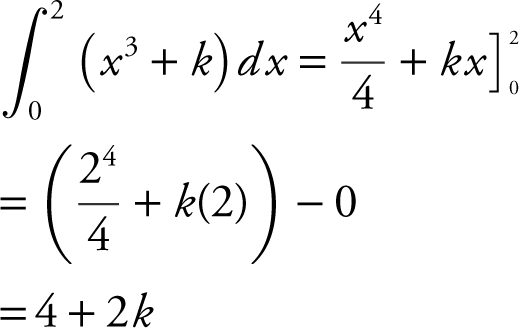
Set 4 + 2k = 10 and k = 3.
14 . Enter  and obtain – 4.70208 ≈ – 4.702.
and obtain – 4.70208 ≈ – 4.702.
15 . 
16 . 
Midpoints are x = 1, 3, 5, and 7.

17 . (a) 
(b) 
(c) 
(d) 
18 . 
19 . 

20 . 
Midpoints are x = 5, 15, and 25.

12.8 Solutions to Cumulative Review Problems
21 . As x → –∞,  .
.

22 . 
23 . (a) (See Figure 12.8-1 .)

Figure 12.8-1
The function f has a relative minimum at x = – 5 and x = 3, and f has a relative maximum at x = – 1 and x = 7.
(b) (See Figure 12.8-2 .)

Figure 12.8-2
The function f is concave upward on intervals (– 6, – 3) and (1, 5).
(c) A change of concavity occurs at x = – 3, x = 1, and x = 5.
24 . (Calculator) Differentiate both sides of 9x 2 + 4y 2 – 18x + 16y = 11.

Horizontal tangent  .
.
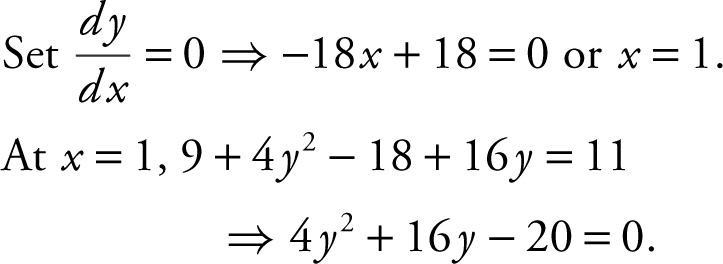
Using a calculator, enter [Solve ]
(4y ∧ 2 + 16y – 20 = 0, y ); obtaining y = – 5 or y = 1.
Thus at each of the points at (1, 1) and (1, – 5) the graph has a horizontal tangent.
Vertical tangent  is undefined.
is undefined.
Set 8y + 16 = 0 ⇒ y = – 2.
At y = – 2, 9x 2 + 16 – 18x – 32 = 11
⇒ 9x 2 – 18x – 27 = 0.
Enter [Solve ] (9x 2 – 18x – 27 = 0, x ) and obtain x = 3or x = – 1.
Thus, at each of the points (3, – 2) and (– 1, – 2), the graph has a vertical tangent. (See Figure 12.8-3 .)

Figure 12.8-3
25 . (Calculator)
Step 1: (See Figure 12.8-4 .) Let P = x + y where P is the length of the pipe and x and y are as shown. The minimum value of P is the maximum length of the pipe to be able to turn in the corner. By similar triangles,  and thus,
and thus, 
 .
.

Figure 12.8-4
Step 2: Find the minimum value of P .
Enter  . Use the [Minimum ] function of the calculator and obtain the minimum point (9.306, 22.388).
. Use the [Minimum ] function of the calculator and obtain the minimum point (9.306, 22.388).
Step 3: Verify with the First Derivative Test.
Enter y 2 = (y 1(x ), x ) and observe. (See Figure 12.8-5 .)

Figure 12.8-5
Step 4: Check endpoints.
The domain of x is (6, ∞). Since x = 9.306 is the only relative extremum, it is the absolute minimum. Thus the maximum length of the pipe is 22.388 feet.
CHAPTER 13
Big Idea 3: Integrals and the Fundamental Theorems of Calculus
Areas and Volumes
IN THIS CHAPTER
Summary: In this chapter, you will be introduced to several important applications of the definite integral. You will learn how to find the area under a curve and the volume of a solid. Some of the techniques that you will be shown include finding area under a curve by using rectangular and trapezoidal approximations, and finding the volume of a solid using cross sections, discs, and washers. These techniques involve working with algebraic expressions and lengthy computations. It is important that you work carefully through the practice problems provided in the chapter, and check your solutions with the given explanations.

 The function
The function 
 Rectangular Approximations
Rectangular Approximations
 Trapezoidal Approximations
Trapezoidal Approximations
 Area Under a Curve
Area Under a Curve
 Area Between Two Curves
Area Between Two Curves
 Solids with Known Cross Sections
Solids with Known Cross Sections
 The Disc Method
The Disc Method
 The Washer Method
The Washer Method
13.1 The Function 
The Second Fundamental Theorem of Calculus defines

and states that if f is continuous on [a , b ], then F ′ (x ) = f (x ) for every point x in [a , b ].
If f ≥ 0, then F ≥ 0. F (x ) can be interpreted geometrically as the area under the curve of f from t = a to t = x . (See Figure 13.1-1 .)

Figure 13.1-1
If f < 0, F < 0, F (x ) can be treated as the negative value of the area between the curve of f and the t -axis from t = a to t = x . (See Figure 13.1-2 .)

Figure 13.1-2
Example 1
If  for 0 ≤ x ≤ 2π , find the value(s) of x where f has a local minimum.
for 0 ≤ x ≤ 2π , find the value(s) of x where f has a local minimum.
 .
.
Method 2: You can solve this problem geometrically by using area. See Figure 13.1-3 .

Figure 13.1-3
The area “under the curve” is above the t -axis on [0, π /2] and below the x -axis on [π /2, 3π /2]. Thus the local minimum occurs at 3π /2.
Example 2
Let  and the graph of f is shown in Figure 13.1-4 .
and the graph of f is shown in Figure 13.1-4 .

Figure 13.1-4
(a) Evaluate: p (0), p (1), p (4).
(b) Evaluate: p (5), p (7), p (8).
(c) At what value of t does p have a maximum value?
(d) On what interval(s) is p decreasing?
(e) Draw a sketch of the graph of p .
Solution:


(c) Since f ≥ 0 on the interval [0, 4], p attains a maximum at t = 4.
(d) Since f (t ) is below the x -axis from t = 4 to t = 8, if x > 4,
 .
.
Thus, p is decreasing on the interval (4, 8).
(e) 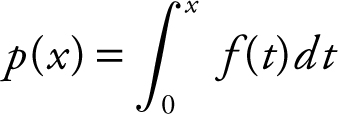 . See Figure 13.1-5 for a sketch.
. See Figure 13.1-5 for a sketch.


Figure 13.1-5

• Remember differentiability implies continuity, but the converse is not true, i.e., continuity does not imply differentiability, e.g., as in the case of a cusp or a corner.
Example 3
The position function of a moving particle on a coordinate axis is:
 , where t is in seconds and s is in feet.
, where t is in seconds and s is in feet.
The function f is a differentiable function and its graph is shown below in Figure 13.1-6 .

Figure 13.1-6
(a) What is the particle’s velocity at t = 4?
(b) What is the particle’s position at t = 3?
(c) When is the acceleration zero?
(d) When is the particle moving to the right?
(e) At t = 8, is the particle on the right side or left side of the origin?
Solution:
(a) Since  , then v (t ) = s ′ (t ) = f (t ).
, then v (t ) = s ′ (t ) = f (t ).
Thus, v (4) = –8 ft/sec.
(b)  .
.
(c) a (t ) = v ′ (t ). Since v ′ (t ) = f ′ (t ), v ′ (t ) = 0 at t = 4. Thus, a (4) = 0 ft/sec2 .
(d) The particle is moving to the right when v (t ) > 0. Thus, the particle is moving to the right on intervals (0, 2) and (7, 8).
(e) The area of f below the x -axis from x = 2 to x = 7 is larger than the area of f above the x -axis from x = 0 to x = 2 and x = 7 to x = 8. Thus,  and the particle is on the left side of the origin.
and the particle is on the left side of the origin.

• Do not forget that (fg )′ = f ′ g + g ′ f and not f ′ g ′. However, lim(fg ) = (lim f ) (lim g ).
13.2 Approximating the Area Under a Curve
Main Concepts: Rectangular Approximations, Trapezoidal Approximations
Rectangular Approximations
If f ≥ 0, the area under the curve of f can be approximated using three common types of rectangles: left-endpoint rectangles, right-endpoint rectangles, or midpoint rectangles. (See Figure 13.2-1 .)

Figure 13.2-1
The area under the curve using n rectangles of equal length is approximately:

If f is increasing on [a , b ], then left-endpoint rectangles are inscribed rectangles and the right-endpoint rectangles are circumscribed rectangles. If f is decreasing on [a , b ], then left-endpoint rectangles are circumscribed rectangles and the right-endpoint rectangles are inscribed. Furthermore,
 inscribed rectangle ≤ area under the curve
inscribed rectangle ≤ area under the curve  circumscribed rectangle.
circumscribed rectangle.
Example 1
Find the approximate area under the curve of f (x ) = x 2 + 1 from x = 0 to x = 2, using 4 left-endpoint rectangles of equal length. (See Figure 13.2-2 .)

Figure 13.2-2
Let Δxi be the length of i th rectangle. The length  .
.
Area under the curve  .
.
Enter Σ (((.5(x – 1))2 + 1) ∗ .5, x , 1, 4) and obtain 3.75.
Or, find the area of each rectangle:

Area of (RectI + RectII + RectIII + RectIV ) = 3.75.
Thus, the approximate area under the curve of f (x ) is 3.75.
Example 2
Find the approximate area under the curve of  from x = 4 to x = 9 using 5 right-endpoint rectangles. (See Figure 13.2-3 .)
from x = 4 to x = 9 using 5 right-endpoint rectangles. (See Figure 13.2-3 .)

Figure 13.2-3
Let Δxi be the length of the i th rectangle. The length  .
.


Or, using Σ notation:
 .
.
Enter  and obtain 13.160.
and obtain 13.160.
Thus the area under the curve is approximately 13.160.
Example 3
The function f is continuous on [1, 9] and f > 0. Selected values of f are given below:

Using 4 midpoint rectangles, approximate the area under the curve of f for x = 1 to x = 9. (See Figure 13.2-4 .)

Figure 13.2-4
Let Δxi be the length of the i th rectangle. The length  .
.
Area of RectI = f (2)(2) = (1.41)2 = 2.82.
Area of RectII = f (4)(2) = (2)2 = 4.
Area of RectIII = f (6)(2) = (2.45)2 = 4.90.
Area of RectIV = f (8)(2) = (2.83)2 = 5.66.
Area of (RectI + RectII + RectIII + RectIV ) = 2.82 + 4 + 4.90 + 5.66 = 17.38.
Thus the area under the curve is approximately 17.38.
Trapezoidal Approximations
Another method of approximating the area under a curve is to use trapezoids. See Figure 13.2-5 .

Figure 13.2-5
Formula for Trapezoidal Approximation
If f is continuous, the area under the curve of f from x = a to x = b is:
 .
.
Example 1
Find the approximate area under the curve of  from x = 0 to x = π , using 4 trapezoids. (See Figure 13.2-6 .)
from x = 0 to x = π , using 4 trapezoids. (See Figure 13.2-6 .)

Figure 13.2-6
Since  .
.
Area under the curve:


• When using a graphing calculator in solving a problem, you are required to write the setup that leads to the answer. For example, if you are finding the volume of a solid, you must write the definite integral and then use the calculator to compute the numerical value, e.g., Volume  . Simply indicating the answer without writing the integral would get you only one point for the answer. And you will not get full credit for the problem.
. Simply indicating the answer without writing the integral would get you only one point for the answer. And you will not get full credit for the problem.
13.3 Area and Definite Integrals
Main Concepts: Area Under a Curve, Area Between Two Curves
Area Under a Curve
If y = f (x ) is continuous and non-negative on [a , b ], then the area under the curve of f from a to b is:
 .
.
If f is continuous and f < 0 on [a , b ], then the area under the curve from a to b is:
 . See Figure 13.3-1 .
. See Figure 13.3-1 .

Figure 13.3-1
If x = g (y ) is continuous and non-negative on [c , d ], then the area under the curve of g from c to d is:
Area  . See Figure 13.3-2 .
. See Figure 13.3-2 .

Figure 13.3-2
Example 1
Find the area under the curve of f (x ) = (x – 1)3 from x = 0 to x = 2.
Step 1: Sketch the graph of f (x ). See Figure 13.3-3 .

Figure 13.3-3
Step 2: Set up integrals.
 .
.
Step 3: Evaluate the integrals.

Another solution is to find the area using a calculator.
Enter  and obtain
and obtain  .
.
Example 2
Find the area of the region bounded by the graph of f (x ) = x 2 – 1, the lines x = –2 and x = 2, and the x -axis.
Step 1: Sketch the graph of f (x ). See Figure 13.3-4 .

Figure 13.3-4
Step 2: Set up integrals.

Step 3: Evaluate the integrals.

Note: Since f (x ) = x 2 – 1 is an even function, you can use the symmetry of the graph and set area =  .
.
An alternate solution is to find the area using a calculator.
Enter  (abs (x ^2 – 1), x –2, 2) and obtain 4.
(abs (x ^2 – 1), x –2, 2) and obtain 4.
Example 3
Find the area of the region bounded by x = y 2 , y = –1, and y = 3. See Figure 13.3-5 .

Figure 13.3-5

Example 4
Using a calculator, find the area bounded by f (x ) = x 3 + x 2 – 6x and the x -axis. See Figure 13.3-6 .

Figure 13.3-6
Step 1: Enter y 1 = x ∧ 3 + x ∧ 2 – 6x .
Step 2: Enter  and obtain 21.083.
and obtain 21.083.
Example 5
The area under the curve y = ex from x = 0 to x = k is 1. Find the value of k .
Area =  . Take ln of both sides:
. Take ln of both sides:
ln(ek ) = ln 2; k = ln 2.
Example 6
The region bounded by the x -axis, and the graph of y = sin x between x = 0 and x = π is divided into 2 regions by the line x = k . If the area of the region for 0 ≤ x ≤ k is twice the area of the region k ≤ x ≤ π , find k . (See Figure 13.3-7 .)

Figure 13.3-7

Area Between Two Curves
Area Bounded by Two Curves: See Figure 13.3-8 .

Figure 13.3-8

Example 1
Find the area of the regions bounded by the graphs of f (x ) = x 3 and g (x ) = x . (See Figure 13.3-9 .)

Figure 13.3-9
Step 1: Sketch the graphs of f (x ) and g (x ).
Step 2: Find the points of intersection.

Step 3: Set up integrals.

Note: You can use the symmetry of the graphs and let area = 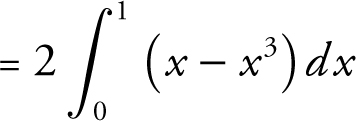 .
.
An alternate solution is to find the area using a calculator. Enter  and obtain
and obtain  .
.
Example 2
Find the area of the region bounded by the curve y = ex , the y -axis, and the line y = e 2 .
Step 1: Sketch a graph. (See Figure 13.3-10 .)

Figure 13.3-10
Step 2: Find the point of intersection. Set e 2 = ex ⇒ x = 2.
Step 3: Set up an integral:
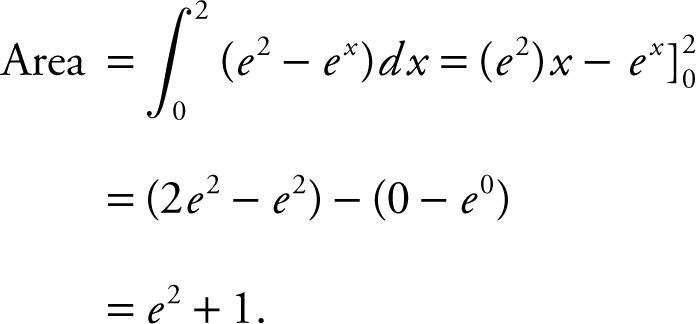
Or using a calculator, enter  and obtain (e 2 + 1).
and obtain (e 2 + 1).
Example 3
Using a calculator, find the area of the region bounded by y = sin x and  between 0 ≤ x ≤ π .
between 0 ≤ x ≤ π .
Step 1: Sketch a graph. (See Figure 13.3-11 .)

Figure 13.3-11
Step 2: Find the points of intersection.
Using the [Intersection ] function of the calculator, the intersection points are x = 0 and x = 1.89549.
Step 3: Enter nInt(sin(x ) – .5x , x , 0, 1.89549) and obtain 0.420798 ≈ 0.421.
(Note: You could also use the  function on your calculator and get the same result.)
function on your calculator and get the same result.)
Example 4
Find the area of the region bounded by the curve xy = 1 and the lines y = –5, x = e , and x = e 3 .
Step 1: Sketch a graph. (See Figure 13.3-12 .)

Figure 13.3-12
Step 2: Set up an integral.
 .
.
Step 3: Evaluate the integral.
 .
.

• Remember: If f ′ > 0, then f is increasing, and if f ″ > 0, then the graph of f is concave upward.
13.4 Volumes and Definite Integrals
Main Concepts: Solids with Known Cross Sections, The Disc Method, The Washer Method
Solids with Known Cross Sections
If A (x ) is the area of a cross section of a solid and A (x ) is continuous on [a , b ], then the volume of the solid from x = a to x = b is:
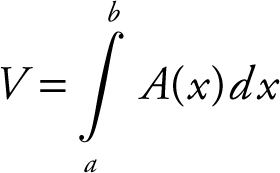
(See Figure 13.4-1 .)

Figure 13.4-1
Note: A cross section of a solid is perpendicular to the height of the solid.
Example 1
The base of a solid is the region enclosed by the ellipse  . The cross sections are perpendicular to the x -axis and are isosceles right triangles whose hypotenuses are on the ellipse. Find the volume of the solid. (See Figure 13.4-2 .)
. The cross sections are perpendicular to the x -axis and are isosceles right triangles whose hypotenuses are on the ellipse. Find the volume of the solid. (See Figure 13.4-2 .)

Figure 13.4-2
Step 1: Find the area of a cross section A (x ).

Step 2: Set up an integral.

Step 3: Evaluate the integral.

The volume of the solid is  .
.
Verify your result with a graphing calculator.
Example 2
Find the volume of a pyramid whose base is a square with a side of 6 feet long, and a height of 10 feet. (See Figure 13.4-3 .)
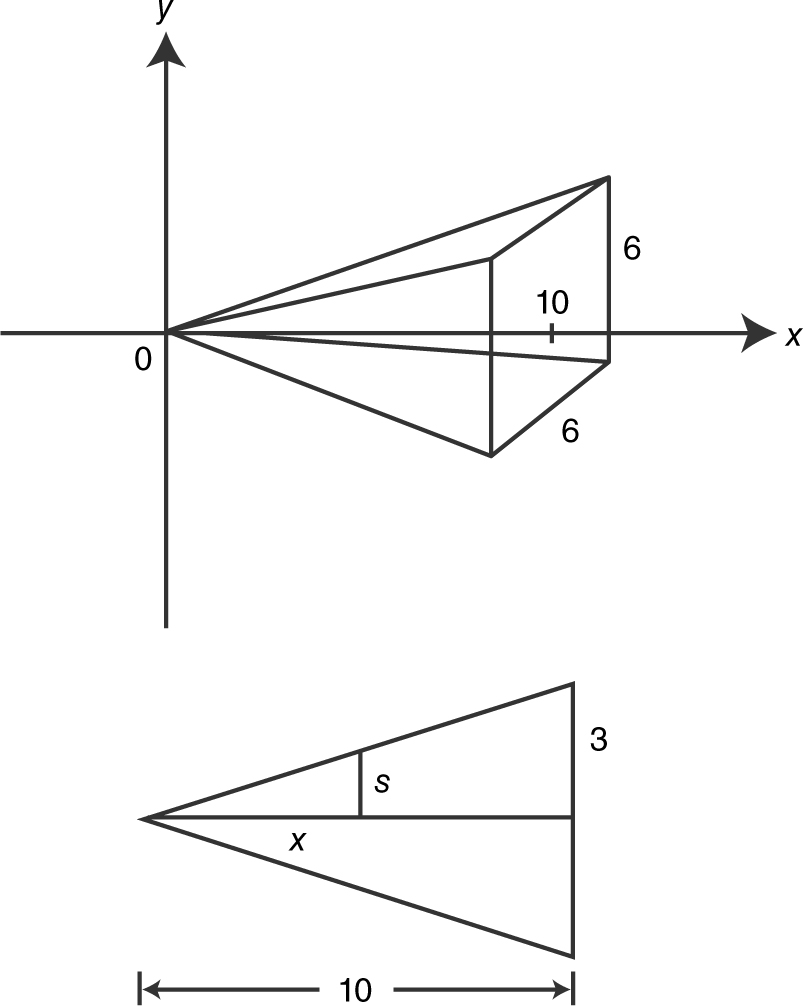
Figure 13.4-3
Step 1: Find the area of a cross section A (x ). Note each cross section is a square of side 2s .

Step 2: Set up an integral.

Step 3: Evaluate the integral.

The volume of the pyramid is 120 ft3 .
Example 3
The base of a solid is the region enclosed by a triangle whose vertices are (0, 0), (4, 0), and (0, 2). The cross sections are semicircles perpendicular to the x -axis. Using a calculator, find the volume of the solid. (See Figure 13.4-4 .)

Figure 13.4-4
Step 1: Find the area of a cross section.
Equation of the line passing through (0, 2) and (4, 0):

Step 2: Set up an integral.

Step 3: Evaluate the integral.
Enter  and obtain 2.0944.
and obtain 2.0944.
Thus the volume of the solid is 2.094.

• Remember: If f ′ < 0, then f is decreasing, and if f ″ < 0, then the graph of f is concave downward.
The Disc Method
The volume of a solid of revolution using discs:
Revolving about the x -axis:
 .
.
Revolving about the y -axis:
 .
.
(See Figure 13.4-5 .)
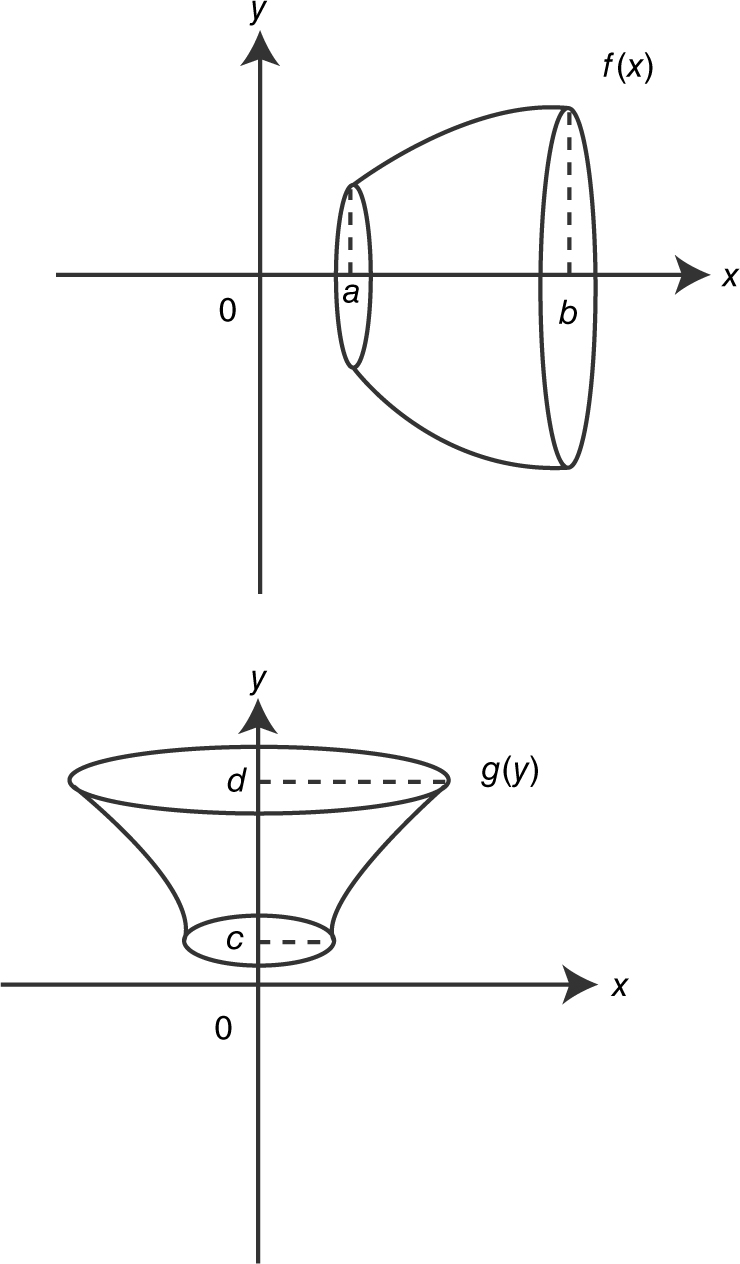
Figure 13.4-5
Revolving about a line y = k :
 .
.
Revolving about a line x = h :
 .
.
(See Figure 13.4-6 .)

Figure 13.4-6
Example 1
Find the volume of the solid generated by revolving about the x -axis the region bounded by the graph of  , the x -axis, and the line x = 5.
, the x -axis, and the line x = 5.
Step 1: Draw a sketch. (See Figure 13.4-7 .)
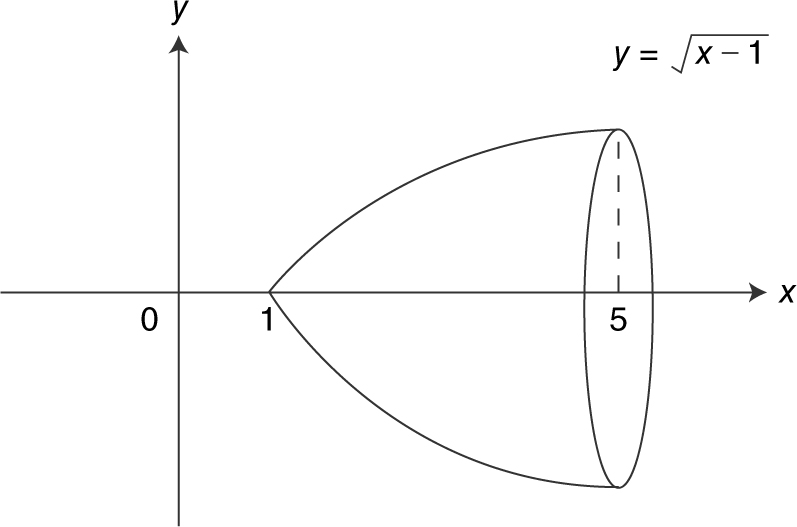
Figure 13.4-7
Step 2: Determine the radius of a disc from a cross section.

Step 3: Set up an integral.

Step 4: Evaluate the integral.

Verify your result with a calculator.
Example 2
Find the volume of the solid generated by revolving about the x -axis the region bounded by the graph of  where
where  , the x -axis, and the y -axis.
, the x -axis, and the y -axis.
Step 1: Draw a sketch. (See Figure 13.4-8 .)

Figure 13.4-8
Step 2: Determine the radius from a cross section.

Step 3: Set up an integral.

Step 4: Evaluate the integral.

Thus, the volume of the solid is π .
Verify your result with a calculator.
Example 3
Find the volume of the solid generated by revolving about the y -axis the region in the first quadrant bounded by the graph of y = x 2 , the y -axis, and the line y = 6.
Step 1: Draw a sketch. (See Figure 13.4-9 .)

Figure 13.4-9
Step 2: Determine the radius from a cross section.

Step 3: Set up an integral.

Step 4: Evaluate the integral.

The volume of the solid is 18π .
Verify your result with a calculator.
Example 4
Using a calculator, find the volume of the solid generated by revolving about the line y = 8 the region bounded by the graph of y = x 2 + 4, and the line y = 8.
Step 1: Draw a sketch. (See Figure 13.4-10 .)

Figure 13.4-10
Step 2: Determine the radius from a cross section.
r = 8 – y = 8 – (x 2 + 4) = 4 – x 2
Step 3: Set up an integral.
To find the intersection points, set 8 = x 2 + 4 ⇒ x = ±2.

Step 4: Evaluate the integral.
 .
.
Thus, the volume of the solid is  .
.
Verify your result with a calculator.
Example 5
Using a calculator, find the volume of the solid generated by revolving about the line y = –3 the region bounded by the graph of y = ex , the y -axis, and the lines x = ln 2 and y = –3.
Step 1: Draw a sketch. (See Figure 13.4-11 .)

Figure 13.4-11
Step 2: Determine the radius from a cross section.
r = y – (–3) = y + 3 = ex + 3
Step 3: Set up an integral.

Step 4: Evaluate the integral.

The volume of the solid is approximately 13.7383π .

• Remember: If f ′ is increasing, then f ″ > 0 and the graph of f is concave upward.
The Washer Method
The volume of a solid (with a hole in the middle) generated by revolving a region bounded by 2 curves:
About the x -axis:
 ; where f (x ) = outer radius and g (x ) = inner radius.
; where f (x ) = outer radius and g (x ) = inner radius.
About the y -axis:
 ; where p (y ) = outer radius and q (y ) = inner radius.
; where p (y ) = outer radius and q (y ) = inner radius.
About a line x = h :
 .
.
About a line y = k :
 .
.
Example 1
Using the Washer Method, find the volume of the solid generated by revolving the region bounded by y = x 3 and y = x in the first quadrant about the x -axis.
Step 1: Draw a sketch. (See Figure 13.4-12 .)

Figure 13.4-12
To find the points of intersection, set x = x 3 ⇒ x 3 – x = 0 or x (x 2 – 1) = 0, or x = –1, 0, 1. In the first quadrant x = 0, 1.
Step 2: Determine the outer and inner radii of a washer, whose outer radius = x ; and inner radius = x 3 .
Step 3: Set up an integral.

Step 4: Evaluate the integral.

Verify your result with a calculator.
Example 2
Using the Washer Method and a calculator, find the volume of the solid generated by revolving the region in Example 1 about the line y = 2.
Step 1: Draw a sketch. (See Figure 13.4-13 .)

Figure 13.4-13
Step 2: Determine the outer and inner radii of a washer.
The outer radius = (2 – x 3 ) and inner radius = (2 – x ).
Step 3: Set up an integral.

Step 4: Evaluate the integral.
 .
.
The volume of the solid is  .
.
Example 3
Using the Washer Method and a calculator, find the volume of the solid generated by revolving the region bounded by y = x 2 and x = y 2 about the y -axis.
Step 1: Draw a sketch. (See Figure 13.4-14 .)

Figure 13.4-14
Intersection points:  .
.

Step 2: Determine the outer and inner radii of a washer, with outer radius:
 and inner radius: x = y 2 .
and inner radius: x = y 2 .
Step 3: Set up an integral.

Step 4: Evaluate the integral.
 .
.
The volume of the solid is  .
.
13.5 Rapid Review
1. If  and the graph of g is shown in Figure 13.5-1 . Find f (3).
and the graph of g is shown in Figure 13.5-1 . Find f (3).

Figure 13.5-1

2. The function f is continous on [1, 5] and f > 0 and selected values of f are given below.

Using 2 midpoint rectangles, approximate the area under the curve of f for x = 1 to x = 5.
Answer: Midpoints are x = 2 and x = 4 and the width of each rectangle  .
.
Area ≈ Area of Rect1 + Area of Rect2 ≈ 4(2) + 8(2) ≈ 24.
3. Set up an integral to find the area of the regions bounded by the graphs of y = x 3 and y = x . Do not evaluate the integral.
Answer: Graphs intersect at x = –1 and x = 1. (See Figure 13.5-2 .)
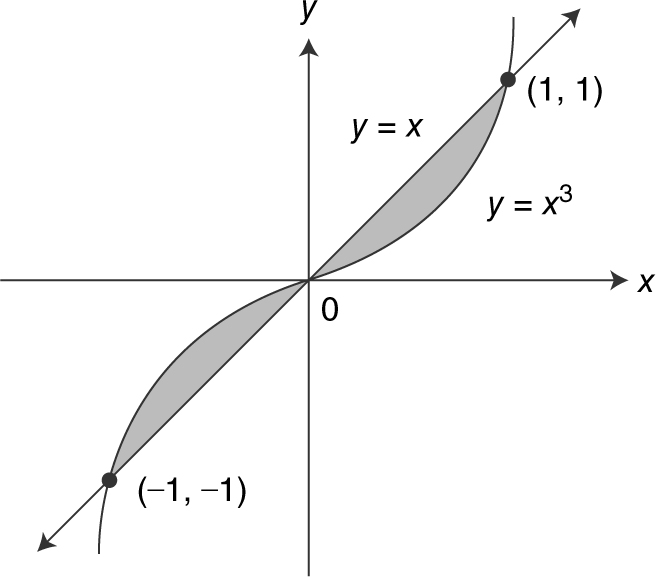
Figure 13.5-2
 .
.
Or, using symmetry,  .
.
4. The base of a solid is the region bounded by the lines y = x , x = 1, and the x -axis. The cross sections are squares perpendicular to the x -axis. Set up an integral to find the volume of the solid. Do not evaluate the integral.
Answer: Area of cross section = x 2 .
 .
.
5. Set up an integral to find the volume of a solid generated by revolving the region bounded by the graph of y = sin x , where 0 ≤ x ≤ π and the x -axis, about the x -axis. Do not evaluate the integral.
 .
.
6. The area under the curve of  from x = a to x = 5 is approximately 0.916 where 1 ≤ a < 5. Using your calculator, find a .
from x = a to x = 5 is approximately 0.916 where 1 ≤ a < 5. Using your calculator, find a .

13.6 Practice Problems
Part A—The use of a calculator is not allowed.
1 . Let  where the graph of f is given in Figure 13.6-1 .
where the graph of f is given in Figure 13.6-1 .

Figure 13.6-1
(a) Evaluate F (0), F (3), and F (5).
(b) On what interval(s) is F decreasing?
(c) At what value of t does F have a maximum value?
(d) On what interval is F concave up?
2 . Find the area of the region(s) enclosed by the curve f (x ) = x 3 , the x -axis, and the lines x = –1 and x = 2.
3 . Find the area of the region(s) enclosed by the curve y = |2x – 6|, the x -axis, and the lines x = 0 and x = 4.
4 . Find the approximate area under the curve  from x = 1 to x = 5, using four right-endpoint rectangles of equal lengths.
from x = 1 to x = 5, using four right-endpoint rectangles of equal lengths.
5 . Find the approximate area under the curve y = x 2 + 1 from x = 0 to x = 3, using the Trapezoidal Rule with n = 3.
6 . Find the area of the region bounded by the graphs  , y = –x , and x = 4.
, y = –x , and x = 4.
7 . Find the area of the region bounded by the curves x = y 2 and x = 4.
8 . Find the area of the region bounded by the graphs of all four equations:  ; x -axis; and the lines,
; x -axis; and the lines,  and x = π .
and x = π .
9 . Find the volume of the solid obtained by revolving about the x -axis, the region bounded by the graphs of y = x 2 + 4, the x -axis, the y -axis, and the lines x = 3.
10 . The area under the curve  from x = 1 to x = k is 1. Find the value of k .
from x = 1 to x = k is 1. Find the value of k .
11 . Find the volume of the solid obtained by revolving about the y -axis the region bounded by x = y 2 + 1, x = 0, y = –1, and y = 1.
12 . Let R be the region enclosed by the graph y = 3x , the x -axis, and the line x = 4. The line x = a divides region R into two regions such that when the regions are revolved about the x -axis, the resulting solids have equal volume. Find a .
Part B—Calculators are allowed.
13 . Find the volume of the solid obtained by revolving about the x -axis the region bounded by the graphs of f (x ) = x 3 and g (x ) = x 2 .
14 . The base of a solid is a region bounded by the circle x 2 + y 2 = 4. The cross sections of the solid perpendicular to the x -axis are equilateral triangles. Find the volume of the solid.
15 . Find the volume of the solid obtained by revolving about the y -axis, the region bounded by the curves x = y 2 and y = x – 2. For Problems 16 through 19, find the volume of the solid obtained by revolving the region as described below. (See Figure 13.6-2 .)

Figure 13.6-2
16 . R 1 about the x -axis.
17 . R 2 about the y -axis.
18 . R 1 about the line  .
.
19 . R 2 about the line  .
.
20 . The function f (x ) is continuous on [0, 12] and the selected values of f (x ) are shown in the table.

Find the approximate area under the curve of f from 0 to 12 using three midpoint rectangles.
13.7 Cumulative Review Problems
(Calculator) indicates that calculators are permitted.
21 . If  , find
, find  in terms of k .
in terms of k .
22 . A man wishes to pull a log over a 9-foot-high garden wall as shown in Figure 13.7-1 . He is pulling at a rate of 2 ft/sec. At what rate is the angle between the rope and the ground changing when there are 15 feet of rope between the top of the wall and the log?

Figure 13.7-1
23 . (Calculator) Find a point on the parabola  that is closest to the point (4, 1).
that is closest to the point (4, 1).
24 . The velocity function of a particle moving along the x -axis is v (t ) = t cos(t 2 + 1) for t ≥ 0.
(a) If at t = 0, the particle is at the origin, find the position of the particle at t = 2.
(b) Is the particle moving to the right or left at t = 2?
(c) Find the acceleration of the particle at t = 2 and determine if the velocity of the particle is increasing or decreasing. Explain why.
25 . (Calculator) given f (x ) = xex and g (x ) = cos x , find:
(a) The area of the region in the first quadrant bounded by the graphs f (x ), g (x ), and x = 0.
(b) The volume obtained by revolving the region in part (a) about the x -axis.
13.8 Solutions to Practice Problems
Part A—The use of a calculator is not allowed.
1 . (a)
(b) Since  , F is decreasing on the interval [3, 5].
, F is decreasing on the interval [3, 5].
(c) At t = 3, F has a maximum value.
(d) F ′ (x ) = f (x ), F ′ (x ) is increasing on (4, 5) which implies F ≤ (x ) > 0. Thus F is concave upward on (4, 5).
2 . (See Figure 13.8-1 .)

Figure 13.8-1

3 . (See Figure 13.8-2 .)

Figure 13.8-2
Set 2x – 6 = 0; x = 3 and

4 . (See Figure 13.8-3 .)

Figure 13.8-3

5 . (See Figure 13.8-4 .)

Figure 13.8-4

6 . (See Figure 13.8-5 .)

Figure 13.8-5

7 . (See Figure 13.8-6 .)

Figure 13.8-6
Intersection points: 4 = y 2 ⇒ y = ±2.

You can use the symmetry of the region and obtain the  . An alternative method is to find the area by setting up an integral with respect to the x -axis and expressing x = y 2 as
. An alternative method is to find the area by setting up an integral with respect to the x -axis and expressing x = y 2 as  and
and  .
.
8 . (See Figure 13.8-7 .)

Figure 13.8-7

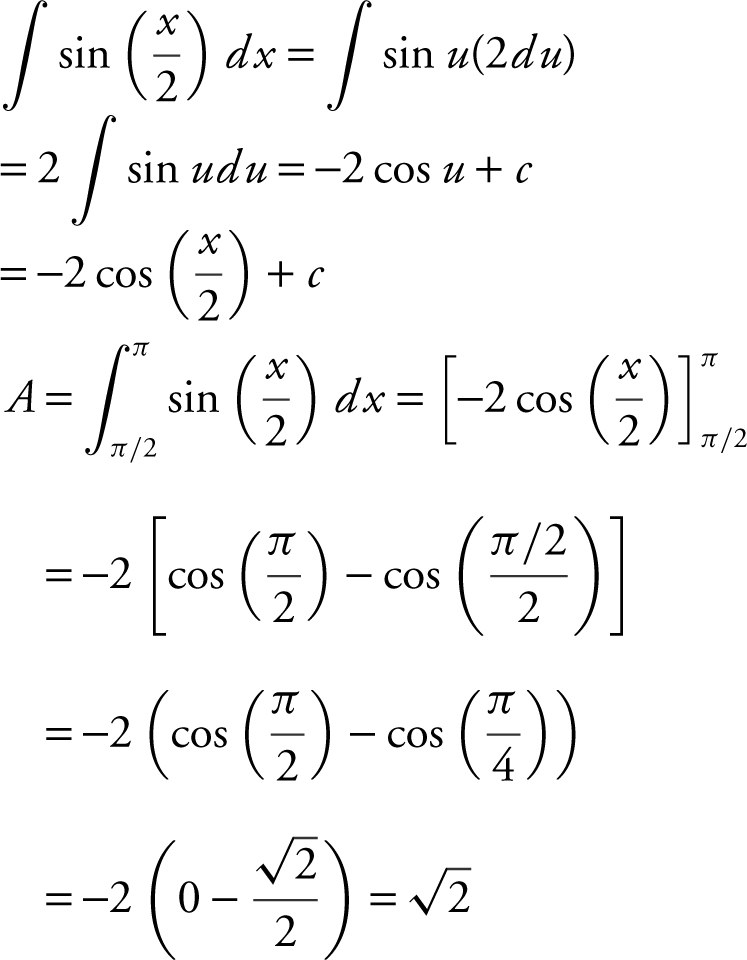
9 . (See Figure 13.8-8 .)

Figure 13.8-8
Using the Disc Method:

10 . Area

Set ln k = 1. Thus e ln k = e 1 or k = e .
11 . (See Figure 13.8-9 .)

Figure 13.8-9
Using the Disc Method:

Note: You can use the symmetry of the region and find the volume by
 .
.
12 . Volume of solid by revolving R :

You can verify your result by evaluating
 . The result is 96π .
. The result is 96π .
Part B—Calculators are allowed.
13 . (See Figure 13.8-10 .)
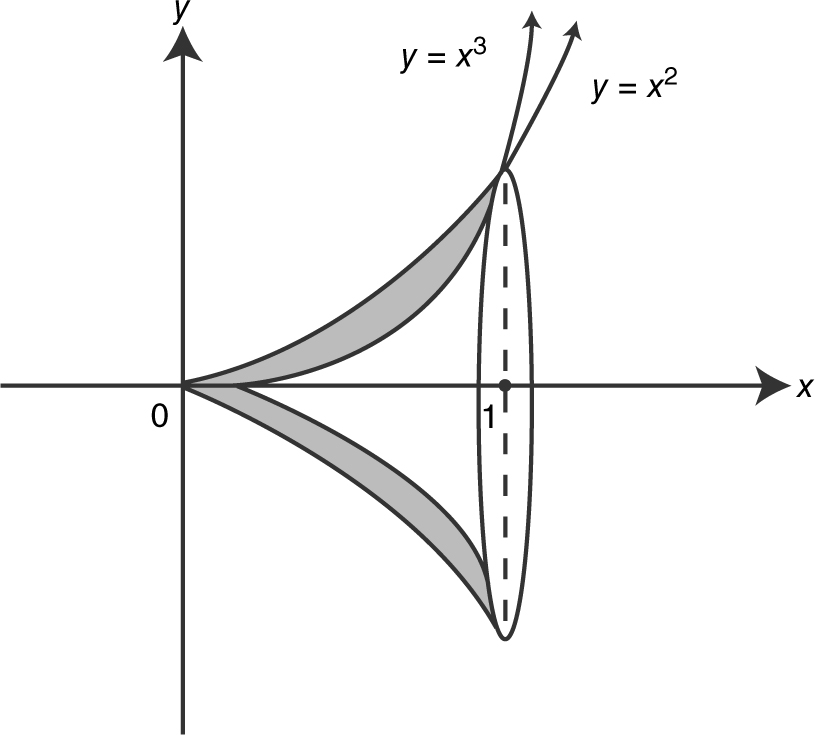
Figure 13.8-10
Step 1: Using the Washer Method: Points of Intersection: Set x 3 = x 2 ⇒ x 3 – x 2 = 0 ⇒ x 2 (x – 1) = 0 or x = 1. Outer radius = x 2 ; Inner radius = x 3 .
Step 2: 
Step 3: Enter  and obtain
and obtain  .
.
14 . (See Figure 13.8-11 .)

Figure 13.8-11
Step 1: x 2 + y 2 = 4 ⇒ y 2 = 4 – x 2 ⇒  Let s = a side of an equilateral triangle
Let s = a side of an equilateral triangle  .
.
Step 2: Area of a cross section:
 .
.
Step 3: 
Step 4: Enter  and obtain
and obtain  .
.
15 . (See Figure 13.8-12 .)
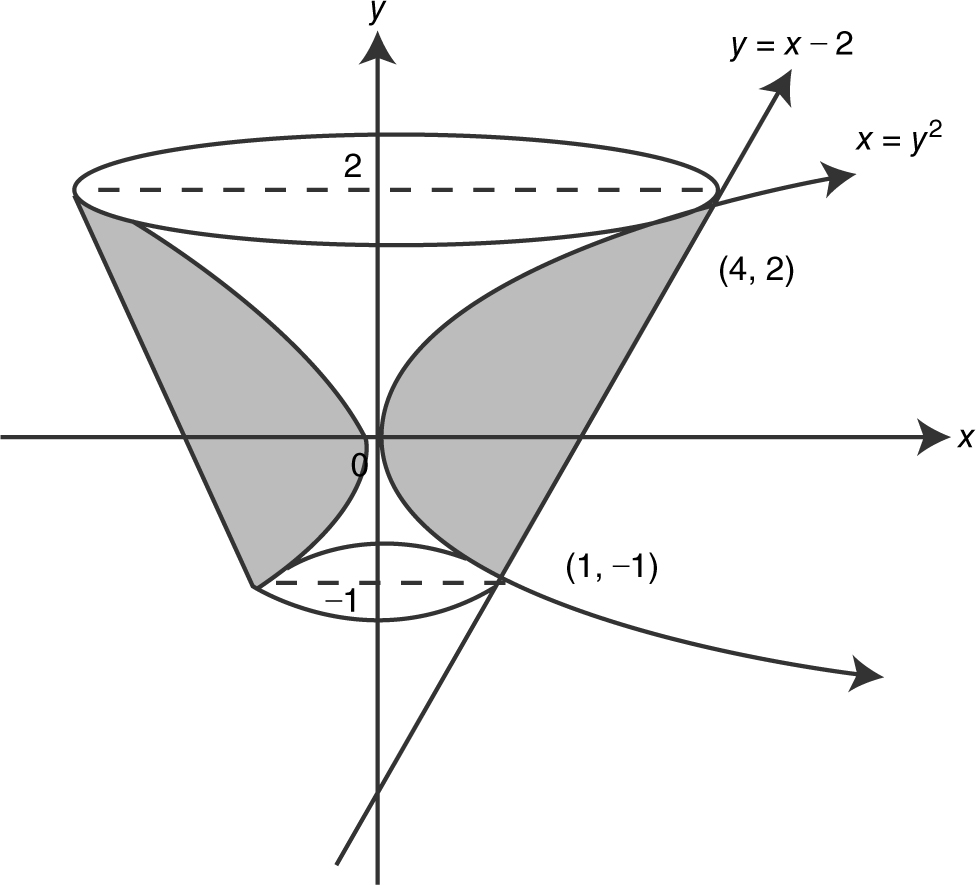
Figure 13.8-12
Step 1: Using the Washer Method:
Points of Intersection:
y = x – 2 ⇒ x = y + 2
Set y 2 = y + 2
⇒ y 2 – y – 2 = 0
⇒ (y – 2)(y + 1) = 0
or y = –1 or y = 2.
Outer radius = y + 2;
Inner radius = y 2 .
Step 2: 
Step 3: Enter

and obtain  .
.
16 . (See Figure 13.8-13 .)

Figure 13.8-13
Step 1: Using the Washer Method:
y = 8, y = x 3
Outer radius = 8;
Inner radius = x 3 .

Step 2: Enter ∫ π (82 – x 6 , x , 0, 2) and obtain  .
.
17 . (See Figure 13.8-14 .)

Figure 13.8-14
Using the Washer Method:
Outer radius: x = 2;
Inner radius: x = y 1/3 .

Using your calculator, you obtain
 .
.
18 . (See Figure 13.8-15 .)

Figure 13.8-15
Step 1: Using the Disc Method:
Radius = (8 – x 3 ).

Step 2: Enter  and obtain
and obtain  .
.
19 . (See Figure 13.8-16 .)

Figure 13.8-16
Using the Disc Method:
Radius = 2 – x = (2 – y 1/3 ).

Using your calculator, you obtain
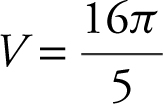 .
.
20 .  .
.
xi = midpoint of the i th interval.
Length of  .
.
Area of RectI = f (2)Δx 1 = (2.24)(4) = 8.96.
Area of RectII = f (6)Δx 2 = (3.61)(4) = 14.44.
Area of RectIII = f (10)Δx 3 = (4.58)(4) = 18.32.
Total Area = 8.96 + 14.44 + 18.32 = 41.72.
The area under the curve is approximately 41.72.
13.9 Solutions to Cumulative Review Problems
21 . (See Figure 13.9-1 .)
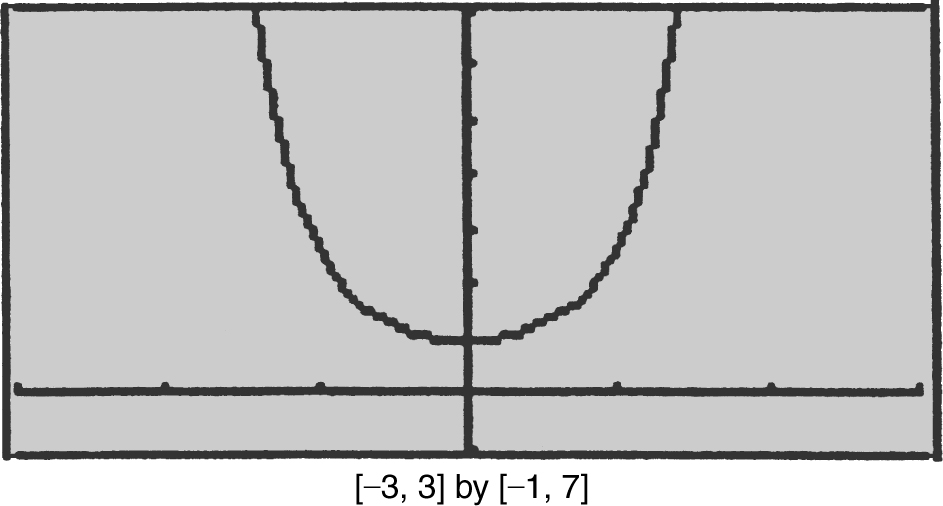
Figure 13.9-1

Since e x 2 is an even function, thus

22 . (See Figure 13.9-2 .)

Figure 13.9-2

Differentiate both sides:
 .
.
When x = 15, 92 + y 2 = 152 ⇒ y = 12.
Thus,  .
.
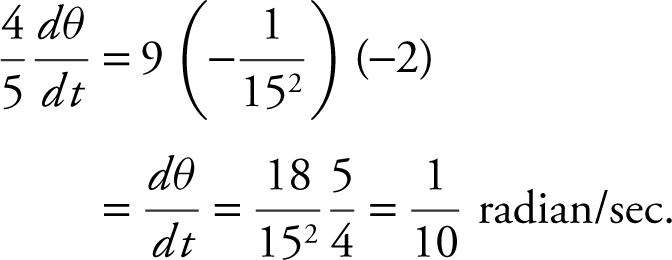
23 . (See Figure 13.9-3 .)

Figure 13.9-3
Step 1: Distance Formula:

where the domain is all real numbers.
Step 2: Enter y 1 = 
Enter y 2 = d (y 1 (x ), x ).
Step 3: Use the [Zero ] function and obtain x = 2 for y 2 .
Step 4: Use the First Derivative Test. (See Figures 13.9-4 and 13.9-5 .) At x = 2, L has a relative minimum. Since at x = 2, L has the only relative extremum, it is an absolute minimum.

Figure 13.9-4

Figure 13.9-5
Step 5: At  . Thus, the point on
. Thus, the point on  closest to the point (4, 1) is the point (2, 2).
closest to the point (4, 1) is the point (2, 2).
24 . (a) s (0) = 0 and
 .
.
Enter 
and obtain  .
.
Thus,  .
.

(b) v (2) = 2 cos(22 + 1) = 2 cos(5) = 0.567324
Since v (2) > 0, the particle is moving to the right at t = 2.
(c) a (t ) = v ′(t )
Enter d (x * cos(x ^ 2 + 1), x )|x = 2 and obtain 7.95506.
Thus, the velocity of the particle is increasing at t = 2, since a (2) > 0.
25 . (See Figure 13.9-6 .)

Figure 13.9-6
(a) Point of Intersection: Use the [Intersection ] function of the calculator and obtain (0.517757, 0.868931).

(0, 0.51775) and obtain 0.304261. The area of the region is approximately 0.304.
(b) Step 1: Using the Washer Method:
Outer radius = cos x ;
Inner radius = xex .

Step 2: Enter 
and obtain 1.16678.
The volume of the solid is approximately 1.167.
CHAPTER 14
Big Idea 3: Integrals and the Fundamental Theorems of Calculus
More Applications of Definite Integrals
IN THIS CHAPTER
Summary: In this chapter, you will learn to solve problems using a definite integral as accumulated change. These problems include distance traveled problems, temperature problems, and growth problems. You will also learn to work with slope fields and to solve differential equations.

Key Ideas
 Average Value of a Function
Average Value of a Function
 Mean Value Theorem for Integrals
Mean Value Theorem for Integrals
 Distance Traveled Problems
Distance Traveled Problems
 Definite Integral as Accumulated Change
Definite Integral as Accumulated Change
 Differential Equations
Differential Equations
 Slope Fields
Slope Fields
14.1 Average Value of a Function
Main Concepts: Mean Value Theorem for Integrals, Average Value of a Function on [a , b ]
Mean Value Theorem for Integrals
If f is continuous on [a , b ], then there exists a number c in [a , b ] such that  . (See Figure 14.1-1 .)
. (See Figure 14.1-1 .)

Figure 14.1-1
Example 1
Given  , verify the hypotheses of the Mean Value Theorem for Integrals for f on [1, 10] and find the value of c as indicated in the theorem.
, verify the hypotheses of the Mean Value Theorem for Integrals for f on [1, 10] and find the value of c as indicated in the theorem.
The function f is continuous for x ≥ 1, thus:

Example 2
Given f (x ) = x 2 , verify the hypotheses of the Mean Value Theorem for Integrals for f on [0, 6] and find the value of c as indicated in the theorem.
Since f is a polynomial, it is continuous and differentiable everywhere,

Since only  is in the interval [0, 6], c =
is in the interval [0, 6], c =  .
.

Average Value of a Function on [a, b ]
Average Value of a Function on an Interval
If f is a continuous function on [a , b ], then the Average Value of f on [a , b ]  .
.
Example 1
Find the average value of y = sin x between x = 0 and x = π .
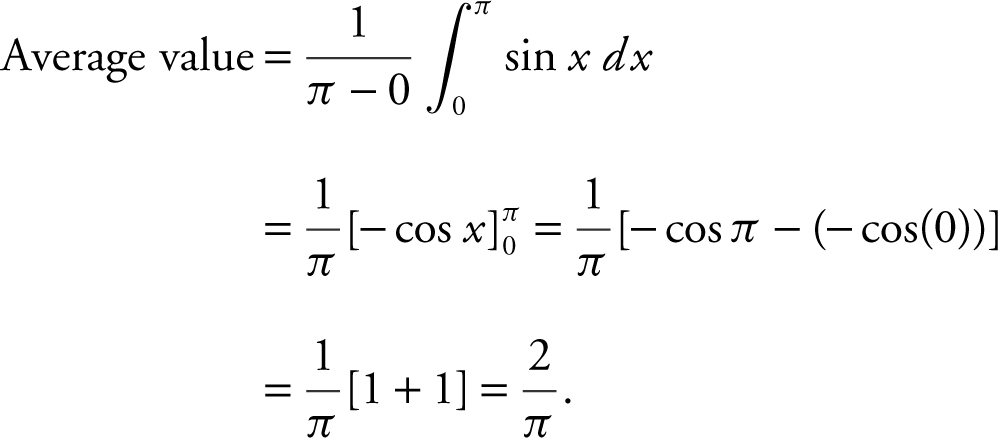
Example 2
The graph of a function f is shown in Figure 14.1-2 . Find the average value of f on [0, 4].

Figure 14.1-2

Example 3
The velocity of a particle moving on a line is v (t ) = 3t 2 – 18t + 24. Find the average velocity from t = 1 to t = 3.

Note: The average velocity for t = 1 to t = 3 is 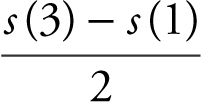 , which is equivalent to the computations above.
, which is equivalent to the computations above.
14.2 Distance Traveled Problems
Summary of Formulas
Position Function:  .
.
Velocity:  .
.
Acceleration:  .
.
Speed: |v (t )|.
Displacement from  .
.
Total Distance Traveled from  .
.
Example 1
See Figure 14.2-1 .

Figure 14.2-1
The graph of the velocity function of a moving particle is shown in Figure 14.2-1 . What is the total distance traveled by the particle during 0 ≤ t ≤ 12?

Example 2
The velocity function of a moving particle on a coordinate line is v (t ) = t 2 + 3t – 10 for 0 ≤ t ≤ 6. Find (a) the displacement by the particle during 0 ≤ t ≤ 6, and (b) the total distance traveled during 0 ≤ t ≤ 6.

The total distance traveled by the particle is  or approximately 88.667.
or approximately 88.667.
Example 3
The velocity function of a moving particle on a coordinate line is v (t ) = t 3 – 6t 2 + 11t – 6.
Using a calculator, find (a) the displacement by the particle during 1 ≤ t ≤ 4, and (b) the total distance traveled by the particle during 1 ≤ t ≤ 4.

(b) Total Distance Traveled =  .
.
Enter y 1 = x ∧ 3 – 6x ∧ 2 + 11x – 6 and use the [Zero ] function to obtain x -intercepts at x = 1, 2, 3.


Example 4
The acceleration function of a moving particle on a coordinate line is a (t ) = –4 and v 0 = 12 for 0 ≤ t ≤ 8. Find the total distance traveled by the particle during 0 ≤ t ≤ 8.

Total distance traveled by the particle is 68.
Example 5
The velocity function of a moving particle on a coordinate line is v (t ) = 3 cos(2t ) for 0 ≤ t ≤ 2π . Using a calculator:
(a) Determine when the particle is moving to the right.
(b) Determine when the particle stops.
(c) The total distance traveled by the particle during 0 ≤ t ≤ 2π .
Solution:
(a) The particle is moving to the right when v (t ) > 0.
Enter y 1 = 3 cos(2x ). Obtain y 1 = 0 when  , and
, and  .
.
The particle is moving to the right when:
 .
.
(b) The particle stops when v (t ) = 0.
Thus the particle stops at  , and
, and  .
.
(c) Total distance traveled  .
.
Enter  (abs(3 cos(2x )), x , 0, 2π ) and obtain 12.
(abs(3 cos(2x )), x , 0, 2π ) and obtain 12.
The total distance traveled by the particle is 12.
14.3 Definite Integral as Accumulated Change
Main Concepts: Business Problems, Temperature Problem, Leakage Problem, Growth Problem
Business Problems

P ′(x ), R ′(x ), and C ′(x ) are the instantaneous rates of change of profit, revenue, and cost, respectively.
Example 1
The marginal profit of manufacturing and selling a certain drug is P ′(x ) = 100 – 0.005x .
How much profit should the company expect if it sells 10,000 units of this drug?


Example 2
If the marginal cost of producing x units of a commodity is C ′(x ) = 5 + 0.4x ,
find (a) the marginal cost when x = 50;
(b) the cost of producing the first 100 units.
Solution:
(a) Marginal cost at x = 50:
C ′(50) = 5 + 0.4(50) = 5 + 20 = 25.
(b) Cost of producing 100 units:

Temperature Problem
Example
On a certain day, the changes in the temperature in a greenhouse beginning at 12 noon are represented by  degrees Fahrenheit, where t is the number of hours elapsed after 12 noon. If at 12 noon, the temperature is 95°F, find the temperature in the greenhouse at 5 p.m.
degrees Fahrenheit, where t is the number of hours elapsed after 12 noon. If at 12 noon, the temperature is 95°F, find the temperature in the greenhouse at 5 p.m.
Let F (t ) represent the temperature of the greenhouse.

The temperature in the greenhouse at 5 p.m. is 98.602°F.
Leakage Problems
Example
Water is leaking from a faucet at the rate of l (t ) = 10e -0.5t gallons per hour, where t is measured in hours. How many gallons of water will have leaked from the faucet after a 24-hour period?
Let L (x ) represent the number of gallons that have leaked after x hours.

Using your calculator, enter ∫ (10e ^(−0.5x ), x , 0, 24) and obtain 19.9999. Thus, the number of gallons of water that have leaked after x hours is approximately 20 gallons.

Growth Problem
Example
On a farm, the animal population is increasing at a rate which can be approximately represented by g (t ) = 20 + 50 ln(2 + t ), where t is measured in years. How much will the animal population increase to the nearest tens between the third and fifth years?
Let G (x ) be the increase in animal population after x years.
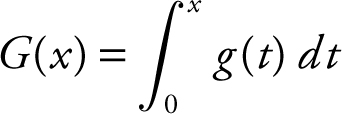
Thus, the population increase between the third and fifth years

Enter  and obtain 218.709.
and obtain 218.709.
Thus the animal population will increase by approximately 220 between the third and fifth years.
14.4 Differential Equations
Main Concepts: Exponential Growth/Decay Problems, Separable Differential Equations
Exponential Growth/Decay Problems
1. If  , then the rate of change of y is proportional to y .
, then the rate of change of y is proportional to y .
2. If y is a differentiable function of t with  , then y (t ) = y 0 e kt ; where y 0 is initial value of y and k is constant. If k > 0, then k is a growth constant and if k < 0, then k is the decay constant.
, then y (t ) = y 0 e kt ; where y 0 is initial value of y and k is constant. If k > 0, then k is a growth constant and if k < 0, then k is the decay constant.
Example 1—Population Growth
If the amount of bacteria in a culture at any time increases at a rate proportional to the amount of bacteria present and there are 500 bacteria after one day and 800 bacteria after the third day:
(a) approximately how many bacteria are there initially, and
(b) approximately how many bacteria are there after 4 days?
Solution:
(a) Since the rate of increase is proportional to the amount of bacteria present, then:
 where y is the amount of bacteria at any time.
where y is the amount of bacteria at any time.
Therefore, this is an exponential growth/decay model: y (t ) = y 0 e kt .
Step 1: y (1) = 500 and y (3) = 800
500 = y 0 e k and 800 = y 0 e 3k
Step 2: 
Substitute y 0 = 500e -k into 800 = y 0 e 3k .
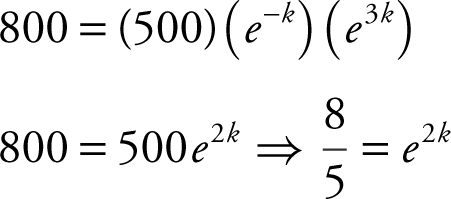
Take the ln of both sides :

Step 3: Substitute  into one of the equations.
into one of the equations.
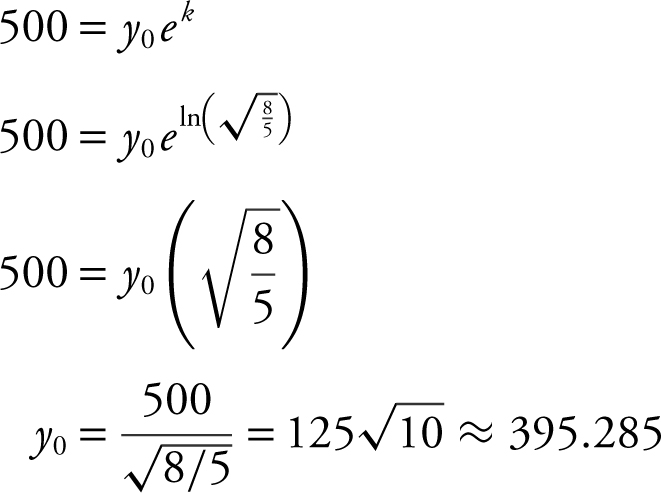
Thus, there are 395 bacteria present initially.
(b) 
Thus there are approximately 1012 bacteria present after 4 days.

Example 2—Radioactive Decay
Carbon-14 has a half-life of 5750 years. If initially there are 60 grams of carbon-14, how many grams are left after 3000 years?
Step 1: y (t ) = y 0 e kt = 60e kt
Since half-life is 5750 years,  .
.

Step 2: 
Thus, there will be approximately 41.792 grams of carbon-14 after 3000 years.
Separable Differential Equations
General Procedure

Steps:
1. Separate the variables: g (y )dy = f (x )dx .
2. Integrate both sides: ∫g (y )dy = ∫ f (x )dx .
3. Solve for y to get a general solution.
4. Substitute given conditions to get a particular solution.
5. Verify your result by differentiating.
Example 1
Given  and
and  , solve the differential equation.
, solve the differential equation.
Step 1: Separate the variables:  .
.
Step 2: Integrate both sides:  .
.
Step 3: General solution:  .
.
Step 4: Particular solution:  .
.
Step 5: Verify result by differentiating.

Example 2
Find a solution of the differentiation equation  .
.
Step 1: Separate variables: dy = x sin(x 2 )dx .
Step 2: Integrate both sides:  .
.
Let u = x 2 ; du = 2x dx or  .
.

Step 3: Substitute given condition:

Step 4: Verify result by differentiating:

Example 3
If  and at x = 0, y ′ = –1, and y = 3, find a solution of the differential equation.
and at x = 0, y ′ = –1, and y = 3, find a solution of the differential equation.
Step 1: Rewrite  as
as  .
.
Step 2: Separate variables: dy ′ = (2x + 1)dx .
Step 3: Integrate both sides:  .
.
Step 4: Substitute given condition: At x = 0, y ′ = –1; –1 = 0 + 0 + C 1 ⇒ C 1 = –1. Thus, y ′ = x 2 + x – 1.
Step 5: Rewrite:  .
.
Step 6: Separate variables: dy = (x 2 + x – 1)dx .
Step 7: Integrate both sides: 
Step 8: Substitute given condition: At x = 0, y = 3; 3 = 0 + 0 – 0 + C 2 ⇒ C 2 = 3.
Therefore,  .
.
Step 9: Verify result by differentiating:

Example 4
Find the general solution of the differential equation  .
.
Step 1: Separate variables:
 .
.
Step 2: Integrate both sides: 
Step 3: General solution: solve for y .

The general solution is y = C (x 2 + 1).
Step 4: Verify result by differentiating:

Example 5
Write an equation for the curve that passes through the point (3, 4) and has a slope at any point (x , y ) as  .
.
Step 1: Separate variables: 2y dy = (x 2 + 1)dx .
Step 2: Integrate both sides:  .
.
Step 3: Substitute given condition:  .
.
Thus,  .
.
Step 4: Verify the result by differentiating:
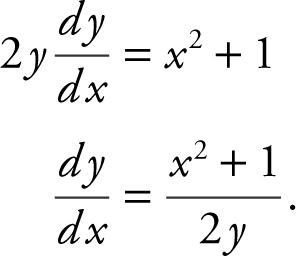
14.5 Slope Fields
Main Concepts: Slope Fields, Solution of Different Equations
A slope field (or a direction field ) for first-order differential equations is a graphic representation of the slopes of a family of curves. It consists of a set of short line segments drawn on a pair of axes. These line segments are the tangents to a family of solution curves for the differential equation at various points. The tangents show the direction which the solution curves will follow. Slope fields are useful in sketching solution curves without having to solve a differential equation algebraically.
Example 1
If  , draw a slope field for the given differential equation.
, draw a slope field for the given differential equation.
Step 1: Set up a table of values for  for selected values of x .
for selected values of x .

Note that since  , the numerical value of
, the numerical value of  is independent of the value of y . For example, at the points (1, –1), (1, 0), (1, 1), (1, 2), (1, 3), and at all the points whose x -coordinates are 1, the numerical value of
is independent of the value of y . For example, at the points (1, –1), (1, 0), (1, 1), (1, 2), (1, 3), and at all the points whose x -coordinates are 1, the numerical value of  is 0.5 regardless of their y -coordinates. Similarly, for all the points, whose x -coordinates are 2 (e.g., (2, – 1), (2, 0), (2, 3), etc.),
is 0.5 regardless of their y -coordinates. Similarly, for all the points, whose x -coordinates are 2 (e.g., (2, – 1), (2, 0), (2, 3), etc.),  . Also, remember that
. Also, remember that  represents the slopes of the tangent lines to the curve at various points. You are now ready to draw these tangents.
represents the slopes of the tangent lines to the curve at various points. You are now ready to draw these tangents.
Step 2: Draw short line segments with the given slopes at the various points. The slope field for the differential equation 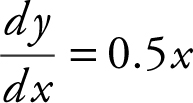 is shown in Figure 14.5-1 .
is shown in Figure 14.5-1 .

Figure 14.5-1
Example 2
Figure 14.5-2 shows a slope field for one of the differential equations given below. Identify the equation.

Figure 14.5-2
(a) 
(b) 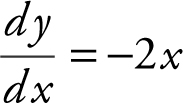
(c) 
(d) 
(e) 
Solution:
If you look across horizontally at any row of tangents, you’ll notice that the tangents have the same slope. (Points on the same row have the same y -coordinate but different x -coordinates.) Therefore, the numerical value of  (which represents the slope of the tangent) depends solely on the y -coordinate of a point and it is independent of the x -coordinate. Thus, only choice (c) and choice (d) satisfy this condition. Also notice that the tangents have a negative slope when y > 0 and have a positive slope when y < 0.
(which represents the slope of the tangent) depends solely on the y -coordinate of a point and it is independent of the x -coordinate. Thus, only choice (c) and choice (d) satisfy this condition. Also notice that the tangents have a negative slope when y > 0 and have a positive slope when y < 0.
Therefore, the correct choice is (d),  .
.
Example 3
A slope field for a differential equation is shown in Figure 14.5-3 . Draw a possible graph for the particular solution y = f (x ) to the differential equation function, if (a) the initial condition is f (0) = –2 and (b) the initial condition is f (0) = 0.

Figure 14.5-3
Solution:
Begin by locating the point (0, –2) as given in the initial condition. Follow the flow of the field and sketch the graph of the function. Repeat the same procedure with the point (0, 0). See the curves as shown in Figure 14.5-4 .

Figure 14.5-4
Example 4
Given the differential equation  .
.
(a) Draw a slope field for the differential equation at the 15 points indicated on the provided set of axes in Figure 14.5-5 .

Figure 14.5-5
(b) Sketch a possible graph for the particular solution y = f (x ) to the differential equation with the initial condition f (0) = 3.
(c) Find, algebraically, the particular solution y = f (x ) to the differential equation with the initial condition f (0) = 3.
Solution:
(a) Set up a table of values for  at the 15 given points.
at the 15 given points.
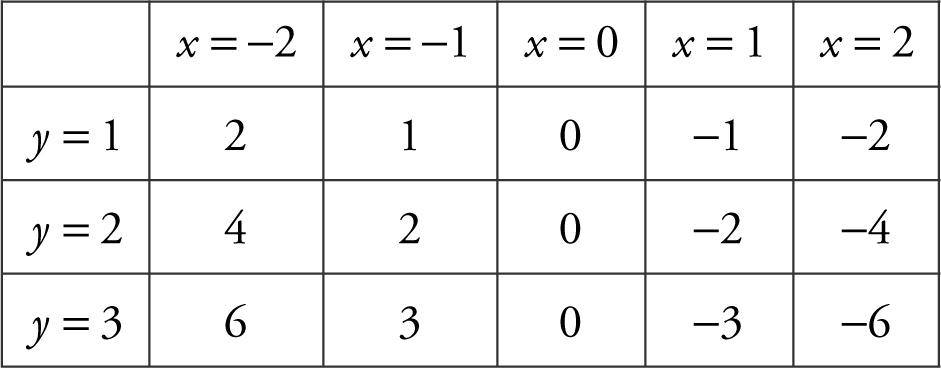
Then sketch the tangents at the various points as shown in Figure 14.5-6 .

Figure 14.5-6
(b) Locate the point (0, 3) as indicated in the initial condition. Follow the flow of the field and sketch the curve as shown Figure 14.5-7 .

Figure 14.5-7
(c) Step 1: Rewrite  as
as 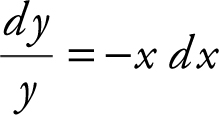 .
.
Step 2: Integrate both sides 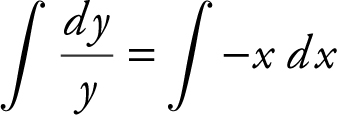 and obtain ln
and obtain ln  .
.
Step 3: Apply the exponential function to both sides and obtain  .
.
Step 4: Simplify the equation and get  .
.
Let k = e C and you have  .
.
Step 5: Substitute initial condition (0, 3) and obtain k = 3. Thus, you have  .
.
14.6 Rapid Review
1. Find the average value of y = sin x on [0, π ].

2. Find the total distance traveled by a particle during 0 ≤ t ≤ 3 whose velocity function is shown in Figure 14.6-1 .

Figure 14.6-1

3. Oil is leaking from a tank at the rate of f (t ) = 5e -0.1t gallons/hour, where t is measured in hours. Write an integral to find the total number of gallons of oil that will have leaked from the tank after 10 hours. Do not evaluate the integral.
 .
.
4. How much money should Mary invest at 7.5% interest a year compounded continuously, so that she will have $100,000 after 20 years.
Answer: y (t ) = y 0 e kt , k = 0.075, and t = 20. y (20) = 100,000 = y 0 e (0.075)(20) . Thus, using a calculator, you obtain y 0 ≈ 22313, or $22,313.
5. Given  and y (1) = 0, solve the differential equation.
and y (1) = 0, solve the differential equation.

6. Identify the differential equation for the slope field shown.
Answer: The slope field suggests a hyperbola of the form y 2 – x 2 = k , so 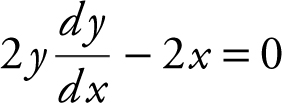 and
and  .
.

14.7 Practice Problems
Part A—The use of a calculator is not allowed.
1 . Find the value of c as stated in the Mean Value Theorem for Integrals for f (x ) = x 3 on [2, 4].
2 . The graph of f is shown in Figure 14.7-1 . Find the average value of f on [0, 8].
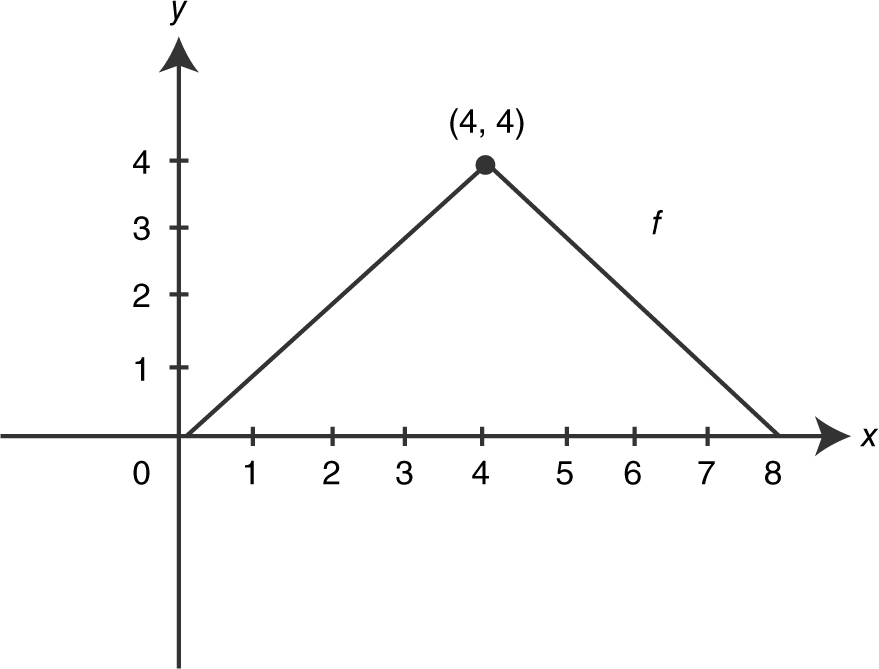
Figure 14.7-1
3 . The position function of a particle moving on a coordinate line is given as s (t ) = t 2 – 6t – 7, 0 ≤ t ≤ 10. Find the displacement and total distance traveled by the particle from 1 ≤ t ≤ 4.
4 . The velocity function of a moving particle on a coordinate line is v (t ) = 2t + 1 for 0 ≤ t ≤ 8. At t = 1, its position is –4. Find the position of the particle at t = 5.
5 . The rate of depreciation for a new piece of equipment at a factory is given as p (t ) = 50t – 600 for 0 ≤ t ≤ 10, where t is measured in years. Find the total loss of value of the equipment over the first 5 years.
6 . If the acceleration of a moving particle on a coordinate line is a (t ) = –2 for 0 ≤ t ≤ 4, and the initial velocity v 0 = 10, find the total distance traveled by the particle during 0 ≤ t ≤ 4.
7 . The graph of the velocity function of a moving particle is shown in Figure 14.7-2 . What is the total distance traveled by the particle during 0 ≤ t ≤ 12?

Figure 14.7-2
8 . If oil is leaking from a tanker at the rate of f (t ) = 10e 0.2t gallons per hour where t is measured in hours, how many gallons of oil will have leaked from the tanker after the first 3 hours?
9 . The change of temperature of a cup of coffee measured in degrees Fahrenheit in a certain room is represented by the function  , where t is measured in minutes. If the temperature of the coffee is initially 92°F, find its temperature after the first 5 minutes.
, where t is measured in minutes. If the temperature of the coffee is initially 92°F, find its temperature after the first 5 minutes.
10 . If the half-life of a radioactive element is 4500 years, and initially there are 100 grams of this element, approximately how many grams are left after 5000 years?
11 . Find a solution of the differential equation:
 .
.
12 . If 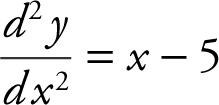 and at x = 0, y ′ = –2 and y = 1, find a solution of the differential equation.
and at x = 0, y ′ = –2 and y = 1, find a solution of the differential equation.
Part B—Calculators are allowed.
13 . Find the average value of y = tan x from  .
.
14 . The acceleration function of a moving particle on a straight line is given by a (t ) = 3e 2t , where t is measured in seconds, and the initial velocity is  . Find the displacement and total distance traveled by the particle in the first 3 seconds.
. Find the displacement and total distance traveled by the particle in the first 3 seconds.
15 . The sales of an item in a company follow an exponential growth/decay model, where t is measured in months. If the sales drop from 5000 units in the first month to 4000 units in the third month, how many units should the company expect to sell during the seventh month?
16 . Find an equation of the curve that has a slope of  at the point (x , y ) and passes through the point (0, 4).
at the point (x , y ) and passes through the point (0, 4).
17 . The population in a city was approximately 750,000 in 1980, and grew at a rate of 3% per year. If the population growth followed an exponential growth model, find the city’s population in the year 2002.
18 . Find a solution of the differential equation 4e y = y ′ – 3xe y and y (0) = 0.
19 . How much money should a person invest at 6.25% interest compounded continuously so that the person will have $50,000 after 10 years?
20 . The velocity function of a moving particle is given as v (t ) = 2 – 6e -t , t ≥ 0 and t is measured in seconds. Find the total distance traveled by the particle during the first 10 seconds.
14.8 Cumulative Review Problems
(Calculator) indicates that calculators are permitted.
21 . If 3e y = x 2 y , find  .
.
22 . Evaluate  .
.
23 . The graph of a continuous function f which consists of three line segments on [–2, 4] is shown in Figure 14.8-1 . If  ,
,

Figure 14.8-1
(a) Find F (–2) and F (0).
(b) Find F ′(0) and F ′(2).
(c) Find the value of x such that F has a maximum on [–2, 4].
(d) On which interval is the graph of F concave upward?
24 . (Calculator) The slope of a function y = f (x ) at any point (x , y ) is  and f (0) = 2.
and f (0) = 2.
(a) Write an equation of the line tangent to the graph of f at x = 0.
(b) Use the tangent in part (a) to find the approximate value of f (0.1).
(c) Find a solution y = f (x ) for the differential equation.
(d) Using the result in part (c), find f (0.1).
25 . (Calculator) Let R be the region in the first quadrant bounded by f (x ) = e x – 1 and g (x ) = 3 sin x .
(a) Find the area of region R .
(b) Find the volume of the solid obtained by revolving R about the x -axis.
(c) Find the volume of the solid having R as its base and semicircular cross sections perpendicular to the x -axis.
14.9 Solutions to Practice Problems
Part A—The use of a calculator is not allowed.
1 . 
2 . 
3 . 
4 . 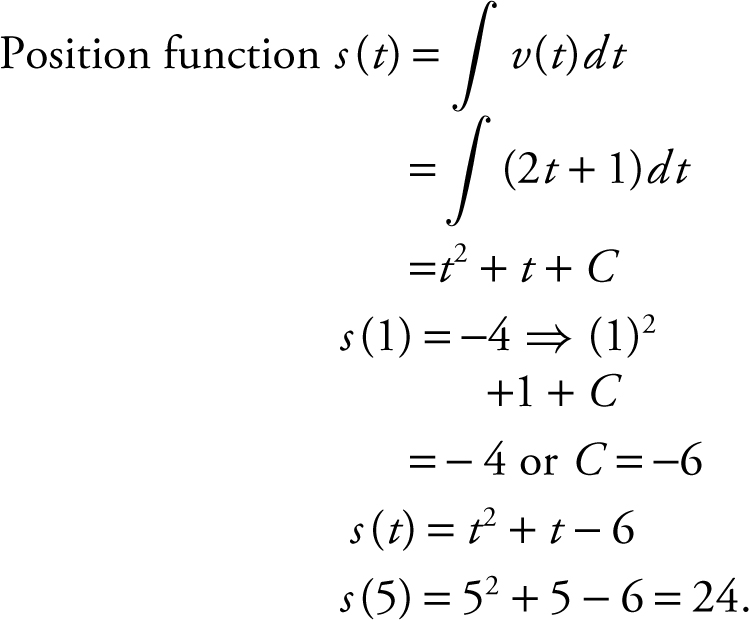
5 . 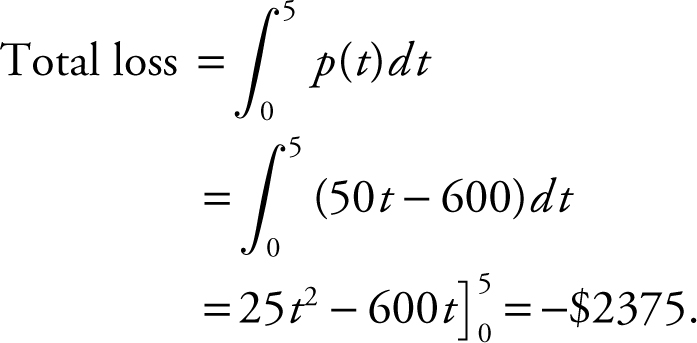
6 . 
7 . Total Distance Traveled

8 . 
9 . Total change in temperature

Thus the temperature of coffee after 5 minutes is (92 – 3.79594) ≈ 88.204°F.
10 . y (t ) = y 0 e kt
Half-life = 4500 years  .
.
Take ln of both sides:

There are approximately 46.29 grams left.
11 . Step 1: Separate variables:
dy = x cos(x 2 ) dx .
Step 2: Integrate both sides:

Step 3: Substitute given values.

Step 4: Verify result by differentiating:
 .
.
12 . Step 1: Rewrite  as
as 
 .
.
Step 2: Separate variables:
dy ′ = (x – 5)dx .
Step 3: Integrate both sides:

Step 4: Substitute given values:

Step 5: Rewrite: 
Step 6: Separate variables:
 .
.
Step 7: Integrate both sides:

Step 8: Substitute given values:

Step 9: Verify result by differentiating:

Part B—Calculators are allowed.
13 . Average value  .
.
Enter = (1/(π /3 – π /4))  (tan x, x, π /4, π /3)
(tan x, x, π /4, π /3)
and obtain  .
.
14 . 
Enter 
and obtain 298.822.
Distance traveled  .
.
Since  for t ≥ 0,
for t ≥ 0,
 .
.
15 . Step 1: 
Substituting:

Step 2: 
Step 3: y (7) = (5590.17)e -0.111572(7)
≈ 2560
Thus, sales for the 7th month are approximately 2560 units.
16 . Step 1: Separate variables:

Step 2: Integrate both sides:
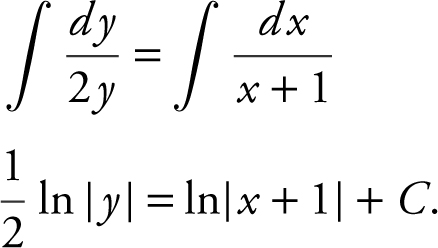
Step 3: Substitute given value (0, 4):


Step 4: Verify result by differentiating:

17 . 
18 . Step 1: Separate variables:

Step 2: Integrate both sides:

Step 3: Substitute given value: y (0) = 0 ⇒ e 0 = 0 – 0 + c ⇒ c = 1.
Step 4: Take ln of both sides:

Step 5: Verify result by differentiating: Enter d (– ln(1 – 4x – 3 (x –^2 )/2), x ) and obtain  , which is equivalent to e y (4 + 3x ).
, which is equivalent to e y (4 + 3x ).
19 . 
20 . Set v (t ) = 2 – 6e -t = 0. Using the [Zero ] function on your calculator, compute t = 1.09861.

Alternatively, use the [nInt ] function on the calculator.
Enter nInt(abs(2 – 6e ^ (–x )), x , 0, 10) and obtain the same result.
14.10 Solutions to Cumulative Review Problems
21 . 3e y = x 2 y

22 .  .
.
23 . (a)

(b) F ′ (x ) = f (x ); F ′ (0) = 2 and F ′ (2) = 4.
(c) Since f > 0 on [–2, 4], F has a maximum value at x = 4.
(d) The function f is increasing on (1, 3) which implies that f ′ > 0 on (1, 3).
Thus, F is concave upward on (1, 3). (Note: f ′ is equivalent to the 2nd derivative of F .)
24 . (a) 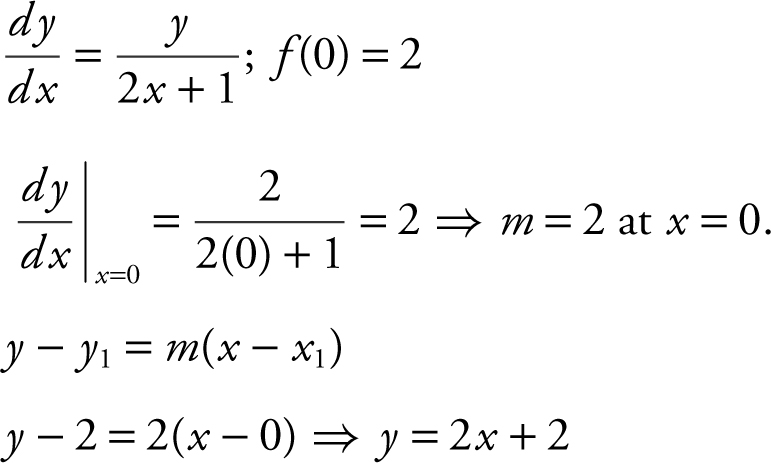
The equation of the tangent to f at x = 0 is y = 2x + 2.
(b) f (0.1) = 2 (0.1) + 2 = 2.2
(c) Solve the differential equation:
 .
.
Step 1: Separate variables:

Step 2: Integrate both sides:
 .
.
Step 3: Substitute given values (0, 2):
 .
.
Step 4: Verify result by differentiating
 .
.
Compare this with:
 .
.
Thus, the function is y = f (x ) = 2(2x + 1)1/2 .
(d) 
25 . See Figure 14.10-1 .

Figure 14.10-1
(a) Intersection points: Using the [Intersection ] function on the calculator, you have x = 0 and x = 1.37131.
 .
.
1.37131 and obtain 0.836303.
The area of region R is approximately 0.836.
(b) Using the Washer Method, volume of

x , 0, 1.37131) and obtain 2.54273π or 7.98824.
The volume of the solid is 7.988.
(c)  (Area of Cross Section)dx .
(Area of Cross Section)dx .
Area of Cross Section 
 .
.
Enter  (e ^(x ) – 1))^2, x , 0, 1.37131) and obtain 0.077184 π or 0.24248. The volume of the solid is approximately 0.077184 π or 0.242.
(e ^(x ) – 1))^2, x , 0, 1.37131) and obtain 0.077184 π or 0.24248. The volume of the solid is approximately 0.077184 π or 0.242.
STEP 5
Build Your Test-Taking Confidence
AP Calculus AB Practice Exam 1
AP Calculus AB Practice Exam 2
AP Calculus AB Practice Exam 1
ANSWER SHEET FOR MULTIPLE-CHOICE QUESTIONS

Section I—Part A

Directions:
Tear out the answer sheet provided on the previous page and mark your answers on it. All questions are given equal weight. Points are not deducted for incorrect answers and no points are given to unanswered questions. Unless otherwise indicated, the domain of a function f is the set of all real numbers. The use of a calculator is not permitted in this part of the exam.
1 . 
(A) −3
(B) 
(C) 0
(D) 3

2 . The figure above shows the graph of a piecewise function. The graph has a horizontal tangent at x = −4. What are all the values of x , such that −6 < x < 6, at which f is continuous but not differentiable?
(A) x = −2
(B) x = −4 and x = 0
(C) x = −2 and x = 0
(D) x = −0, and x = 2
3 . 
(A) 
(B) 
(C) 
(D) 

4 . The diagram above shows the graph of a function f for −2 ≤ x ≤4. Which of the following statements is/are true?
I. 
II. 
III. 
(A) I only
(B) II only
(C) I and II only
(D) I, II, and III
5 . 
(A) 
(B) 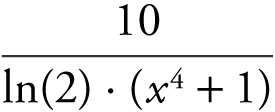
(C) 
(D) 
6 . 
(A) 
(B) 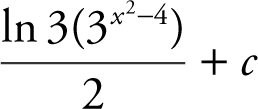
(C) 
(D) 3 x 2−3 + c

7 . In the figure above, which of the four given points on the graph is  and
and 
(A) A
(B) B
(C) C
(D) D

8 . The table above shows the values of the functions h and k and their derivatives at x = 4 and x = 8. What is the value of 
(A) 3
(B) 4
(C) 12
(D) 24
9 . If  , then f ′(2)=
, then f ′(2)=
(A) 
(B) 
(C) 
(D) 

10 . The figure above shows the graph of a continuous function f for −4 ≤ x ≤ 4. On what intervals is f ′(x ) > 0 for all values ofx ?
(A) (−4, 2) only
(B) (−4, −2) and (0, 2)
(C) (−2, 0) only
(D) (0, 4)
11 . If  for t ≥ 0 is the position of a moving particle on a straight line, at which of the following intervals of t is the speed of the particle decreasing?
for t ≥ 0 is the position of a moving particle on a straight line, at which of the following intervals of t is the speed of the particle decreasing?
(A) (1, 2) only
(B) (3, ∞) only
(C) (0, 1) and (2, 3)
(D) (1, 2) and (3, ∞)
12 . 
(A) −2
(B) −1
(C) 1
(D) nonexistent
13 . 
(A) −π
(B) 0
(C) 
(D) π
14 . If  is
is
(A) 6
(B) 9
(C) 
(D) 18
15 . Given the function f (x ) = x 3 − 3x 2 + 3x − 1, which of the following statements is true?
(A) The graph of f has a relative minimum at x = 1.
(B) The graph of f has a relative maximum at x = 1.
(C) The graph of f has a point of inflection x = 1.
(D) The graph of f has a relative minimum at x = 0.
16 . If  and
and  , what is the value of
, what is the value of 
(A) −14
(B) −6
(C) 6
(D) 8
17 . What is the slope of the tangent line to the curve 2x 2 y − 3xy 2 − 2 = 0 at the point (2, 1)?
(A) 
(B) 
(C) 
(D) 
18 . If f is a piecewise function defined as  , which of the following statements is/are true?
, which of the following statements is/are true?
I. 
II. 
III. f ′(2) = 4
(A) None
(B) I only
(C) II only
(D) I, II, and III
19 . Air is pumped into a spherical balloon at the rate of 10 cubic centimeters per second. How fast is the diameter, in centimeters per second, increasing when the radius is 5 cm? (The volume of a sphere is  .)
.)
(A) 
(B) 
(C) 
(D) 5π
20 .  is
is
(A) 0
(B) 
(C) 1
(D) 
21 . The area of the region bounded by the curves of y = −x 2 and y = x is
(A) 
(B) 
(C) 
(D) 6
22 . 
(A) 
(B) 
(C) 
(D) 4e 2x + c
23 . If  , then f ′(x )=
, then f ′(x )=
(A) 
(B) 
(C) 
(D) 
24 . Let f and g be differentiable functions such that f −1 (x ) = g (x ) for all x . The table below shows selected values of f (x ) and f ′(x ). What is the value of g ′(2)?

(A) −5
(B) −3
(C) 
(D) 2

25 . The figure above shows the slope field for which of the following differential equations?
(A) 
(B) 
(C) 
(D) 
26 . Let f be a continuous and twice differentiable function and f ″(x ) 0 for all x in the interval [4, 5]. Some of the values of f are shown in the table below.

Which of the following is true about f ′(4.6)?
(A) f ′(4.6) < 2
(B) f ′(4.6) > 6
(C) 0.2 < f ′(4.6) < 0.6
(D) 2 < f ′(4.6) < 6

27 . The graph of a function f is shown in the figure above. The graph of f consists of two line segments, and f is continuous on the interval [−3, 3]. If  , then g (−3) is
, then g (−3) is
(A) 
(B) 1
(C) 
(D) 
28 . The solution to the differential equation  where y (0) = e is
where y (0) = e is
(A) 
(B) y = e 3x
(C) y = −e 3x +1
(D) y = e (3x +1)
29 . The graph of a continuous function y = f (x ) passes through the point (e , 4) and  . Which of the following is the function f (x )?
. Which of the following is the function f (x )?
(A) y = 3 ln x + e
(B) y = 3 ln x + 1
(C) y = ln x + 4
(D) y = e x + 4
30 . The definite integral 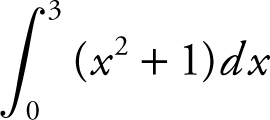 is equivalent to which of the following limits?
is equivalent to which of the following limits?
(A) 
(B) 
(C) 
(D) 
STOP. AP Calculus AB Practice Exam 1, Section I—Part A.
Section I—Part B

Directions:
Continue using the same answer sheet. Please note that the questions begin with number 76 . This is not an error; it was done to be consistent with the numbering system of the actual AP Calculus AB exam. All questions are given equal weight. Points are not deducted for incorrect answers and no points are given to unanswered questions. Unless otherwise indicated, the domain of a functionf is the set of all real numbers. If the exact numerical value does not appear among the given choices, select the best approximate value. The use of a calculator is permitted in this part of the exam.
76 . Given that  , if f is differentiable at x = 1, what is the value of a + 2b ?
, if f is differentiable at x = 1, what is the value of a + 2b ?
(A) 2
(B) 3
(C) 4
(D) 5
77 . If g ′(x ) = cos(π )x 2 + 1) and  , then g (2)=
, then g (2)=
(A) −0.681
(B) −0.319
(C) 0.181
(D) 0.681
78 . The point (−2, 5) is on the graph of a differential function f , and f −2) = 3. What is the estimate for f (−1.9), using local linear approximation for f at x = −2?
(A) −16.7
(B) −6.7
(C) −4.7
(D) 5.3
79 . If a function f has its derivative f ′(x ) given as f ′(x ) = −3e −x cos x + 2 for −2 < x < 2, on what interval(s) is f increasing?
(A) (−1.0407, 0.345)
(B) (0, 0.345)
(C) (−2, 0)
(D) (−2, − 1.407) and (0.345, 2)
80 . A particle moving in a straight line has a velocity of v (t ) = 2−t cos (2t ) feet per minute. What is the total distance in feet traveled by the particle when 0 ≤t ≤ 3 minutes? (A) 0.096 (B) 0.121
81 . How many points of inflection does the graph of  have on the intervals (0, 2π)?
have on the intervals (0, 2π)?
(A) 0
(B) 1
(C) 2
(D) 3
82 . The table below shows selected values of a continuous function f on the closed interval [1,16].

Using three left endpoint rectangles of equal length (LRAM ), what is the approximate value of 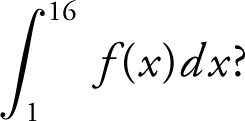
(A) 16.5
(B) 29
(C) 33.5
(D) 38

83 . The figure above shows the graph of the derivative of a function f . Which of the following could be the graph of f ?
(A) 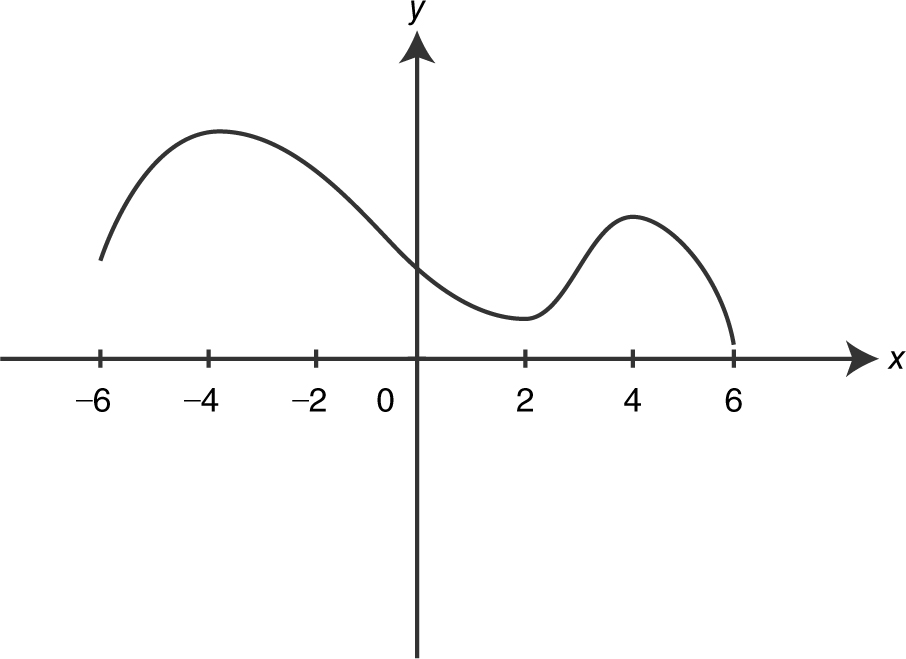
(B) 
(C) 
(D) 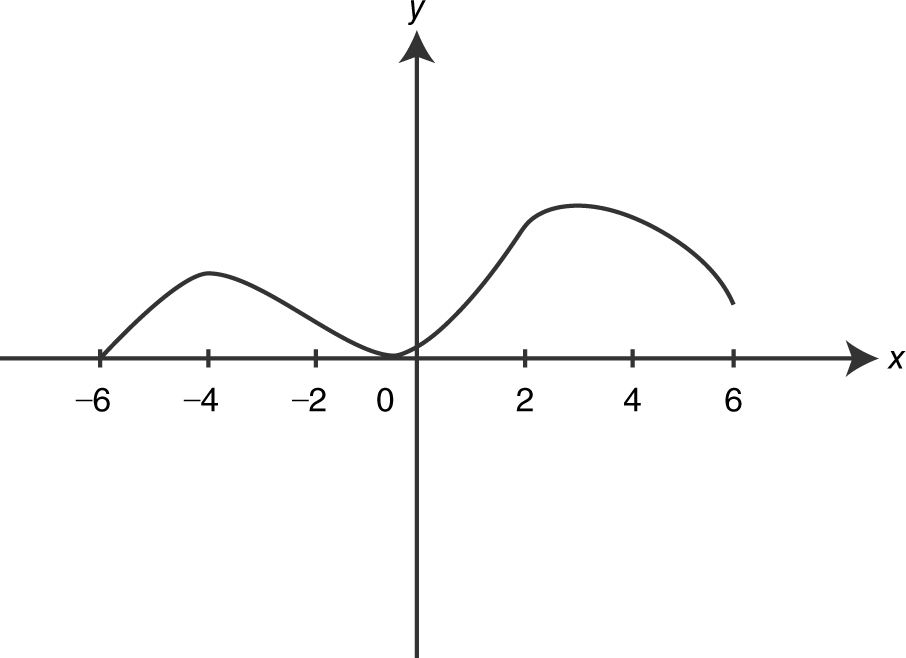
84 . A wire 40 centimeters long is being cut into two pieces to make a circle and a square. If the total area of the circle and the square is a minimum, how much wire, in centimeters, should be used for the circle?
(A) 17.596
(B) 22.404
(C) 40
(D) 56.010
85 . Given that f (x ) = arccos(2x ), what is the slope of the tangent to the graph of f at x = 0?
(A) −2
(B) 0
(C) 1
(D) 2
86 . A solid is generated by revolving, about the x -axis, the region bounded by the curves y = x 3 − 2x + 1 and y = x + 2 in the second quadrant. The volume of the solid is
(A) 2.241
(B) 7.039
(C) 10.348
(D) 16.279
87 . A function f is given as f (x ) = x 3 + 1 for 1 ≤ x ≤ 3. If 1 ≤ c ≤ 3 and f ′(c ) is equal to the average rate of change of f on the interval [1, 3], what is the value of c ?
(A) 
(B) 
(C) 6.5
(D) 13
88 . The velocity of a particle moving on a straight line is given as v (t ) = cos(t )(e sin(t ) ) for t ≥ 0. At  , what is the acceleration of the particle?
, what is the acceleration of the particle?
(A) −2.718
(B) −1.346
(C) −0.420
(D) 1.434
89 . The region, in the first quadrant, bounded by the graph of y = cos(x ), the x -axis, and the y -axis, is divided by the line x = k into two regions of equal area. What is the value of k ?
(A) 
(B) 
(C) 
(D) 
90 . In a given petri dish, the number of bacteria grows at approximately the rate of  bacteria per day, wheret is the number of days since the culture in the petri dish began. At day two, there are 150 bacteria. Which of the following is the best approximation for the number of bacteria at day five?
bacteria per day, wheret is the number of days since the culture in the petri dish began. At day two, there are 150 bacteria. Which of the following is the best approximation for the number of bacteria at day five?
(A) 623
(B) 638
(C) 773
(D) 788
STOP. End of AP Calculus AB Practice Exam, Section I—Part B.
Section II Part A

Directions:
Show all your work . You may not receive any credit for correct answers without supporting work. You may use an approved calculator to help solve a problem. However, you must clearly indicate the setup of your solution using mathematical notations and not calculator syntax. Calculators may be used to find the derivative of a function at a point, compute the numerical value of a definite integral, or solve an equation. Unless otherwise indicated, you may assume the following: (a) the numeric or algebraic answers need not be simplified; (b) your answer, if expressed in approximation, should be correct to 3 places after the decimal point; and (c) the domain of a function f is the set of all real numbers.
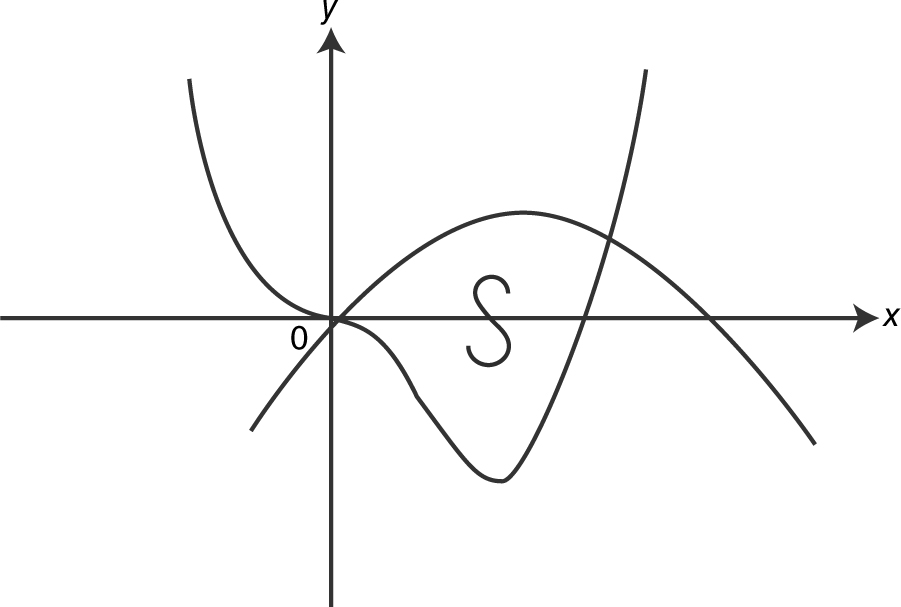
1 . As shown in the figure above, S is the region enclosed by the graphs of y = 2x 4 − 5x 3 and y = 4x − x 2 .
(A) Find the area of the region S.
(B) Find the volume of the solid generated when the region S is revolved about the line y = 4.
(C) If region S is the base of a solid, the height of the solid for all points in S at a distance x from the y -axis is given as h (x ) = 0.5 + 2x . Find the volume of the solid.
2 . A particle is moving along the x -axis. For 0 ≤t ≤ 10, the acceleration of the particle is given by  . At t = 0, the velocity of the particle is v (0) = −1.1.
. At t = 0, the velocity of the particle is v (0) = −1.1.
(A) Find the velocity of the particle at t = 4.
(B) For 0 ≤ t ≤ 10, at what time interval is the speed of the particle increasing?
(C) For 0 ≤ t ≤ 10, what is the average velocity of the particle?
(D) For 0 ≤ t ≤ 10, find the total distance traveled by the particle.
STOP. End of AP Calculus AB Practice Exam, Section II—Part A.
Section II—Part B

Directions:
The use of a calculator is not permitted in this part of the exam. You should show all work . You may not receive any credit for correct answers without supporting work. Unless otherwise indicated, the numeric or algebraic answers need not be simplified, and the domain of a function f is the set of all real numbers. When you have finished this part of the exam, you may return to the problems in Part A of Section II and continue to work on them. However, you may not use a calculator.
3 . Given the differential equation  .
.
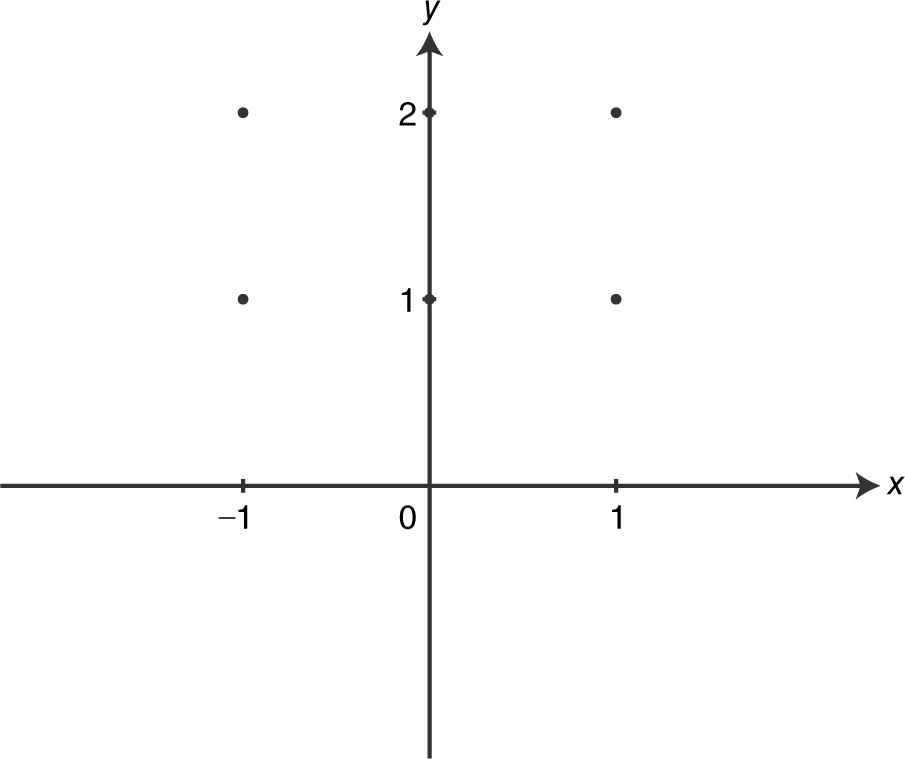
(A) On the axes provided in the figure above, sketch a slope field at the six indicated points.
(B) Let y = f (x ) be the particular solution to the differential equation with the initial condition f (0) = 1. Write an equation of the tangent line to the solution curve at the point (0, 1).
(C) Using the equation of the tangent line in part (b), find the approximate value of f (0.02).
(D) Find y = f (x ) with f (0) = 1.
4 . Let f be a continuous function on the interval [−2, 6], and f is twice differentiable with f ″(x ) < 0 on (−2, 6).
Selected values of f are shown below.

(A) Using trapezoidal approximation with four trapezoids, find the approximate value of  .
.
(B) Using the result in part (a), find the average value of f on [−2, 6].
(C) Find the average rate of change of f over the interval [−2, 6].
(D) Examine f ′(0) and f ′(2), and determine if f ′(0) is greater than, less than, or equal to f ′(2). Explain.

5 . A function f is continuous and twice differentiable for all values of x . The figure above shows the graph of f ′, the derivative of function f on the closed interval [−4, 2]. The graph of f ′ has horizontal tangents at x = −1 and x = 1.5. The areas of regions A , B , and C are 20, 10, and 6, respectively, and f (2) = 3.
(A) Find all x -values on (−4, 2) such that the function f has a local minimum. Justify your answer. (B) Find allx -values on (−4, 2) such that the graph of f has a point of inflection. Justify your answer.
(B) Find all x -values on (−4, 2) such that the graph of f has a point of inflection. Justify your answer.
(C) Evaluate  . Explain your reasoning.
. Explain your reasoning.
(D) Evaluate  . Explain your reasoning.
. Explain your reasoning.
6 . The equation of a curve is given as 14y − y 2 = x 2 + 24.
(A) Find  in terms of x and y .
in terms of x and y .
(B) Write an equation of the line tangent to the curve at the point (−3, 11).
(C) Write an equation of each vertical tangent to the curve.
(D) Evaluate  at the point (0, 2).
at the point (0, 2).
STOP. End of AP Calculus AB Practice Exam, Section II−Part B.
Answers to AB Practice Exam 1—Section I
Part A
1 . C
2 . D
3 . A
4 . C
5 . C
6 . A
7 . C
8 . A
9 . A
10 . C
11 . C
12 . B
13 . D
14 . B
15 . C
16 . C
17 . D
18 . B
19 . B
20 . B
21 . B
22 . B
23 . D
24 . C
25 . B
26 . D
27 . C
28 . D
29 . B
30 . D
Part B
76 . D
77 . D
78 . D
79 . D
80 . D
81 . D
82 . B
83 . A
84 . A
85 . A
86 . B
87 . A
88 . C
89 . A
90 . C
Answers to AB Practice Exam 1—Section II
Part A
1 . 
2 . 
Part B
3 . 
4 . 
5 . 
6 . 
Solutions for AP Calculus AB Practice Exam 1—Section II
Section I Part A
1 . The correct answer is (C).
Note that  , and
, and  . Therefore, the
. Therefore, the 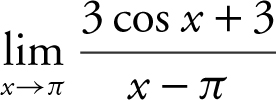 is an indeterminate form of the type
is an indeterminate form of the type  . Applying L’Hôpital’s Rule, you have
. Applying L’Hôpital’s Rule, you have  .
.
2 . The correct answer is (D).
At x = −4, the graph of f has a horizontal tangent, which implies that f is differentiable and f ′(−4) = 0.
At x = −2, f is discontinuous and thus not differentiable. At each of x = 0 and x = 2, the one-sided derivatives are different, so f is not differentiable. (Note that the graphs at x = 0 and x = 2 are sometimes referred to as “corners”.)
3 . The correct answer is (A).
Using the u -substitution method, let u = x 2 + 1, and obtain du = 2x dx , or  . Therefore,
. Therefore,  .
.
4 . The correct answer is (C).
Examining the graph, note that  . Since the two one-sided limits are equal,
. Since the two one-sided limits are equal,  exists. Statement I is true. Also, note that
exists. Statement I is true. Also, note that  . and
. and  . Therefore, statement II is true, but statement III is false because the two one-sided limits are not the same.
. Therefore, statement II is true, but statement III is false because the two one-sided limits are not the same.
5 . The correct answer is (C).
Recall the formula  . In this case, y = 10 log2 (x 4 + 1), and you have
. In this case, y = 10 log2 (x 4 + 1), and you have  .
.
6 . The correct answer is (A).
Let u = x 2 − 4. Differentiating, you have  . Using u -substitution, rewrite
. Using u -substitution, rewrite  . Recall the formula
. Recall the formula  . Therefore,
. Therefore,  .
.
7 . The correct answer is (C).
If a function is increasing, then  , and if a function is decreasing,
, and if a function is decreasing,  . Also, if a function is concave up,
. Also, if a function is concave up,  , and if a function is concave down,
, and if a function is concave down,  . Note the following:
. Note the following:

Thus, at point  and
and  .
.
8 . The correct answer is (A).
Note that the notation  is equivalent to (h · k )′(4), the derivative of a composite function, at x = 4. Begin with the chain rule:
is equivalent to (h · k )′(4), the derivative of a composite function, at x = 4. Begin with the chain rule:  . Therefore,
. Therefore,  .
.
9 . The correct answer is (A).
Note that  . Applying the Fundamental Theorem of Calculus, you have
. Applying the Fundamental Theorem of Calculus, you have  . Thus,
. Thus,  .
.
10 . The correct answer is (C).
Remember that if f is increasing, then f ′(x ) > 0, and that if f is decreasing, then f ′(x ) < 0. Examining the graph of f , you see that f (x ) is increasing on the interval (−2, 0). Therefore, f ′(x ) > 0 on the interval (−2, 0).
11 . The correct answer is (C).
The speed of a moving particle decreases when its velocity and acceleration have opposite signs, e.g., v (t ) > 0 and a (t ) < 0, or v (t ) < 0 and a (t ) > 0. The velocity and acceleration functions are v (t ) = t 2 − 4t + 3 and a (t ) = 2t − 4. Setv (t ) = 0, and obtain t 2 − 4t + 3 = 0 or (t − 3)(t − 1) = 0, which yieldsx = 1 and x = 3. Setting a (t ) = 0, you have 2t − 4 = 0, or t = 2.

Note that v (t ) and a (t ) have opposite signs on (0, 1) and (2, 3). Thus, the speed of the particle decreases on (0, 1) and (2, 3).
12 . The correct answer is (B).
Note that as x approaches  . Therefore,
. Therefore, 
 . Also,
. Also,  . Thus
. Thus  .
.
13 . The correct answer is (D).
Note that the formula  . Therefore,
. Therefore,  .
.
14 . The correct answer is (B).
Using the chain rule, you have f ′ = 24 sin2 (x ). Therefore,  .
.
15 . The correct answer is (C).
The first and second derivatives of f are f ′(x ) = 3x 2 − 6x + 3 and f ′(x ) = 6x − 6. Set f ′(x ) = 0, and you have 3x 2 − 6x + 3 = 0. Solve for x and obtain 3(x 2 − 2x + 1) = 0, or 3(x − 1)(x − 1) = 0, which yields x = 1. Setting f ′(x ) = 0, you have 6x − 6 = 0, or x = 1.
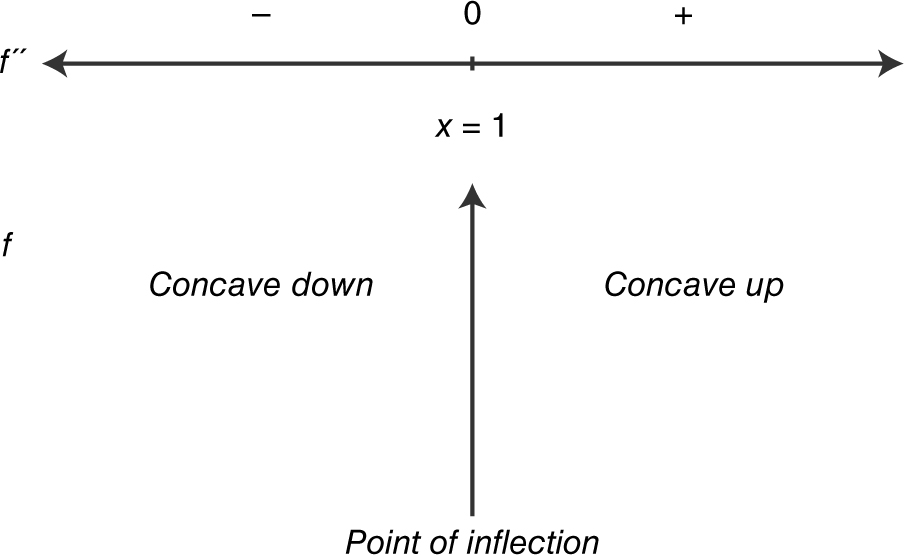
Note that the graph of f changes concavity from down to up. Since f is a differentiable function, it has a point of inflection at x = 1.
16 . The correct answer is (C).
Since  .
.
Also,  .
.
so  .
.
17 . The correct answer is (D).
Using implicit differentiation, you have  . Substitute x = 2 and y = 1, and obtain
. Substitute x = 2 and y = 1, and obtain  .
.
18 . The correct answer is (B).

Since f (x ) is discontinuous at x = 2, f ′(2) does not exist. Statement III is false. The limit in statement II represents the right-hand derivative (f + )′(x ), and (f + )′(2) does not exist because the point (2, 8) is not part of the function. Statement II is false. The limit in statement I represents the left-hand derivative (f − )′(x ), and forx ≤ 2, (f − )′(x ) = 2x . Thus, (f − )′(2) = 4. Statement I is true.
19 . The correct answer is (B).
The volume of a sphere is  , so
, so  , or
, or 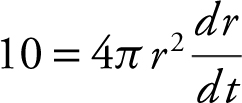 , which yields
, which yields  . The diameter D is twice the radius; D = 2r , and
. The diameter D is twice the radius; D = 2r , and  . Therefore,
. Therefore,  , and
, and  centimeters per second.
centimeters per second.
20 . The correct answer is (B).
Note that the definition of the derivative  . Therefore, the
. Therefore, the  is equivalent to
is equivalent to  . Note that there are other approaches to solving this problem, e.g., applying L’Hôpital’s Rule or expanding sin
. Note that there are other approaches to solving this problem, e.g., applying L’Hôpital’s Rule or expanding sin  .
.
21 . The correct answer is (B).

Find the intersection points by setting x = −x 2 . Rewrite x = −x 2 as x 2 + x = 0 or x (x + 1) = 0 and obtain x = 0 and x = − 1. The area of the region bounded by the curves is  .
.
22 . The correct answer is (B).
Rewrite  . Let u = –2 x and obtain du = –2dx , or
. Let u = –2 x and obtain du = –2dx , or  . Therefore,
. Therefore, 
 .
.
23 . The correct answer is (D).
Applying the quotient rule for derivatives, you have 

24 . The correct answer is (C).
Since f and g are inverse functions, if (a , b ) is on the graph of f , then (b , a ) is on the graph of g , and  . Note that f (4) = 2, which implies that g (2) = 4. Therefore,
. Note that f (4) = 2, which implies that g (2) = 4. Therefore,  .
.
25 . The correct answer is (B).
Note that the slopes of the tangents depend on the y -coordinates and only the y -coordinates. Also, note that when y > 1, the slopes are positive, and when y < 1, the slopes are negative. Of the given choices, only the differential equation in choice B satisfies these conditions.
26 . The correct choice is (D).
Since f ″(x ) > 0, f ′(x ) is increasing, and in this case, f ′(4.5) < f ′(4.6) < f ′(4.7). Note that  , and
, and  . Also note that
. Also note that

Therefore, 2 < f ′ (4.6) < 6.
27 . The correct choice is (C).
Note that 
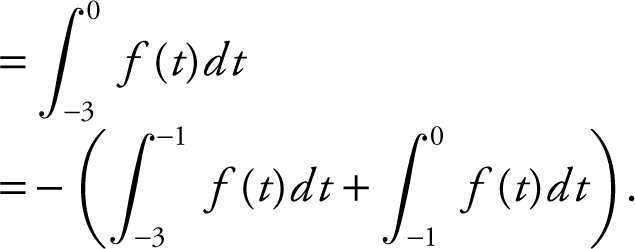
Using area of a triangle,  , and
, and  . Therefore,
. Therefore,  .
.
28 . The correct choice is (D).
Begin with  and obtain
and obtain  . Integrating both sides of the equation, you have ln|y | = x 3 + c . Substitute x = 0 and y = e , and obtain ln |e | = (0)3 + c , or c = 1, and the equation becomes ln |y | = x 3 + 1. Solving for y , you have e ln|y | = e x 3 +1) , or |y | = e (x 3 +1) , which yields y = ±e (x 3 +1) . Since y (0) = e , which means the graph passes through the point (0, e ), y = e (x 3 +1) .
. Integrating both sides of the equation, you have ln|y | = x 3 + c . Substitute x = 0 and y = e , and obtain ln |e | = (0)3 + c , or c = 1, and the equation becomes ln |y | = x 3 + 1. Solving for y , you have e ln|y | = e x 3 +1) , or |y | = e (x 3 +1) , which yields y = ±e (x 3 +1) . Since y (0) = e , which means the graph passes through the point (0, e ), y = e (x 3 +1) .
29 . The correct choice is (B).
Begin by solving the differential equation. Rewrite  as
as  . Integrating both sides, you have
. Integrating both sides, you have  , or y = 3 ln x + c . Substitute x = e and y = 4 in the equation, and obtain 4 = 3 ln e + c , or c = 1. Since, the point (e , 4) is on the graph of f (x ), y = 3 ln x = 1.
, or y = 3 ln x + c . Substitute x = e and y = 4 in the equation, and obtain 4 = 3 ln e + c , or c = 1. Since, the point (e , 4) is on the graph of f (x ), y = 3 ln x = 1.
30 . The correct choice is (D).

The width of each rectangle is  , and the heights of the rectangles are as follows:
, and the heights of the rectangles are as follows:  . . . or
. . . or  ,
,  , . . .
, . . .
The area under the curve is approximately
 , and the
, and the  .
.
Section I Part B
76 . The correct answer is (D).
Since the function f is differentiable at x = 1, f is also continuous at x = 1. At x = 1, set x 3 + x + a = 2bx − 1, and obtain (1)3 + (1) + a = 2b (1) − 1, or a = 2b − 3. Also, f ′ (x ) = 3x 2 + 1 for x ≤ 1, and f ′ (x ) = 2b for x > 1. At x = 1, set 3x 2 + 1 = 2b , and you have 3 (1)2 + 1 = 2b , or b = 2. Substituting b = 2 in a = 2b − 3, you have a = 1. Therefore, a + 2b = 1 + 2 (2) = 5.
77 . The correct answer is (D).
Note that  . Therefore,
. Therefore,  , or
, or  . Using your graphing calculator, you have
. Using your graphing calculator, you have  . Thus,
. Thus,  .
.
78 . The correct answer is (D).

The tangent line for local linearization approximation passes through the point (−2, 5) and has a slope of m = 3. The equation of the tangent is y − 5 = 3 (x + 2). At x = −1.9, y − 5 = 3 (−1.9 + 2), or y = 5.3. Therefore, f (−1.9) ≈ 5.3.
79 . The correct answer is (D).

Using your graphing calculator, examine the graph of f ′ (x ). Note that the graph of f ′ (x ) crosses the x -axis at x = −1.407 and x = 0.345. The graph also shows the following:

Therefore, the function f increases on the intervals (−2, − 1.407) and (0.345, 2).
80 . The correct answer is (D).
The total distance traveled is  . Using the TI-89 graphing calculator, enter
. Using the TI-89 graphing calculator, enter  and obtain 0.812884 ≈ 0.813.
and obtain 0.812884 ≈ 0.813.
81 . The correct answer is (D).

Using the TI-89 graphing calculator, enter the second derivative  into y 1 as follows:
into y 1 as follows:

Inspecting the graph of y 1 , you see that the curve crosses thex -axis three times, which means the second derivative changes sign three times. Since the functiony is a twice differentiable function, it has three points of inflection.
82 . The correct answer is (B).
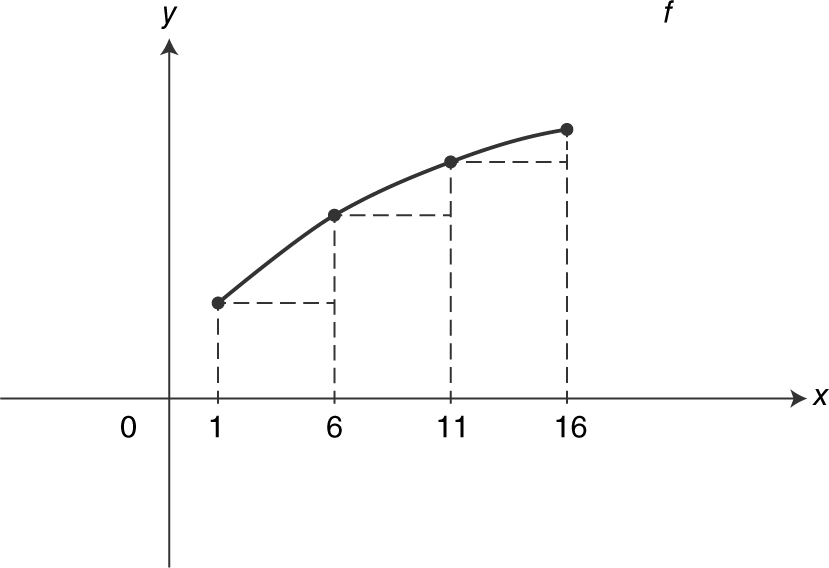
Note that the length of each rectangle is 5. Therefore:

83 . The correct answer is (A).
Note the following:

Also note that f ′(x ) = 0 at x = −4, 2, 4, so the graph of f has a horizontal tangent at each of these points. The only graph that satisfies these conditions is choice (A).
84 . The correct answer is (A).
Let x be the length of the wire used to make a circle. Therefore, the circumference of the circle is 2πr = x , or  . The area of the circle is
. The area of the circle is  . The remaining wire has a length of (40 − x ) and is made into a square. Therefore, a side of the square is
. The remaining wire has a length of (40 − x ) and is made into a square. Therefore, a side of the square is  , and the area of the square is
, and the area of the square is  . Let A be the total area of the two figues. Thus,
. Let A be the total area of the two figues. Thus,  . Enter this equation into the graphing calculator by letting A = y 1 . Examine the graph of y 1 .
. Enter this equation into the graphing calculator by letting A = y 1 . Examine the graph of y 1 .

Use the [ Minimum ] function on the calculator, and obtain x = 17.596 centimeters.
85 . The correct answer is (A).
Remember that  arccos
arccos  . Using the chain rule,
. Using the chain rule,  , and f ′(0) = −2. Therefore, the slope of the tangent to the graph of f at x = 0 is −2. Note that you could also find f (x ) and f ′(0) using your graph calculator.
, and f ′(0) = −2. Therefore, the slope of the tangent to the graph of f at x = 0 is −2. Note that you could also find f (x ) and f ′(0) using your graph calculator.
86 . The correct answer is (B).

Using the TI-89 graphing calculator, graph the two given equations. Find their intersection points in the second quadrant: x = −1.5321 and x = −0.3473. Find the volume of the solid of revolution:

87 . The correct answer is (A).
Since f (x ) = x 3 + 1, f ′(x ) = 3x 2 , and f ′(c ) = 3(c )2 . The average rate of change of f on [1, 3] is  . Set 3c 2 = 13, and obtain
. Set 3c 2 = 13, and obtain  .082. Note that only
.082. Note that only  is on the interval [1, 3]. Thus,
is on the interval [1, 3]. Thus,  .
.

See the figure above for a geometric representation of the problem.
88 . The correct answer is (C).
Remember, a (t ) = v ′(t ). Using the TI-89 graphing calculator, find a (t ), and evaluate it at  :
:
d (cos(t ) * e ^ (sin(t ), t )|t = π/4
= .0.1420036 ≈ −0.420
89 . The correct answer is (A).

Since the areas of the two regions are equal, set  , and obtain
, and obtain  . Evaluating the definite integrals, you have
. Evaluating the definite integrals, you have  , or 2 sin (k ) = 1, which yields sin
, or 2 sin (k ) = 1, which yields sin  , or
, or 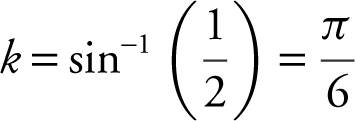 .
.
90 . The correct answer is (C).
Let R (t ) be the function representing the number of bacteria in the petri dish, so  . The net change in the number of bacteria between day two and day five is
. The net change in the number of bacteria between day two and day five is  , or
, or  . Thus, 623.227 = R(5) − 150, or R (5) = 773.227 ≈ 773.
. Thus, 623.227 = R(5) − 150, or R (5) = 773.227 ≈ 773.
Solutions for AP Calculus AB Practice Exam 1—Section II
Section II—Part A
1 . (A) Begin by finding the intersection points of the two curves, and obtain x = 0 and x = 2.60308.
Area of a region enclosed by two curves =  . In this case, the area of region
. In this case, the area of region  = 17.258.
= 17.258.

(B) Volume of a solid of revolution with hole  , where R is the outer radius and r is the inner radius. In this case, R = 4 − (2x 4 − 5x 3 ), and r = 4 − (4x − x 2 ). (Note that the highest point in region S is (2, 4).) Therefore, the volume of the solid revolving about the line y = 4 is:
, where R is the outer radius and r is the inner radius. In this case, R = 4 − (2x 4 − 5x 3 ), and r = 4 − (4x − x 2 ). (Note that the highest point in region S is (2, 4).) Therefore, the volume of the solid revolving about the line y = 4 is:

(C) Volume of a solid with a given base  . In this case, the area of the cross section = (0.5 + 2x )((4x − x 2 ) − (2x 4 − 5x 3 )). Thus, the volume of the solid with base
. In this case, the area of the cross section = (0.5 + 2x )((4x − x 2 ) − (2x 4 − 5x 3 )). Thus, the volume of the solid with base 
2 . (A) Remember,  , and in this case,
, and in this case,  . Using your TI-89 graphing calculator, you have v (t ) = −cos(ln(t + 1)) + c . Since v (0) = −1.1, you have −1.1 = −cos(ln(t + 1)) + c , or −1.1 = −cos(0) + c , which yields c = −0.1. Therefore, v (t ) = −cos(ln(t + 1)) − 0.1, and v (4) = −cos(ln(4 + 1)) − 0.1 = −0.061368, or −0.061. Another approach to find v (4) is as follows. Note that
. Using your TI-89 graphing calculator, you have v (t ) = −cos(ln(t + 1)) + c . Since v (0) = −1.1, you have −1.1 = −cos(ln(t + 1)) + c , or −1.1 = −cos(0) + c , which yields c = −0.1. Therefore, v (t ) = −cos(ln(t + 1)) − 0.1, and v (4) = −cos(ln(4 + 1)) − 0.1 = −0.061368, or −0.061. Another approach to find v (4) is as follows. Note that  = v (4) − (−1.1) = v (4) + 1.1. Therefore,
= v (4) − (−1.1) = v (4) + 1.1. Therefore,  . Also note that
. Also note that  1.03863. Therefore, v (4) = 1.03863 − 1.1 = −0.061368, or −0.061.
1.03863. Therefore, v (4) = 1.03863 − 1.1 = −0.061368, or −0.061.
(B) The speed of the particle is increasing when a (t ) and v (t ) are both positive or both negative. Examine the graphs of a (t ) and v (t ).

Note that for 0 ≤ t ≤ 10, a (t ) > 0, and for 4.31729
(C) The average value of a function f on a closed interval [a , b ] is  . In this case, the average velocity of the particle on the interval [0, 10] is
. In this case, the average velocity of the particle on the interval [0, 10] is 

 , or −0.018.
, or −0.018.
(D) The total distance traveled by the particle for 0 ≤ t ≤ 10 is 
 , or 4.447. Another approach to find the total distance traveled by the particle is to add the distance traveled to the left with the distance traveled to the right. From the graph of v (t ), the particle changes direction at t = 4.317. Therefore, the total distance
, or 4.447. Another approach to find the total distance traveled by the particle is to add the distance traveled to the left with the distance traveled to the right. From the graph of v (t ), the particle changes direction at t = 4.317. Therefore, the total distance  , which yields the same result, 4.447.
, which yields the same result, 4.447.
Section II—Part B
3 . (A)

Rewrite  as
as 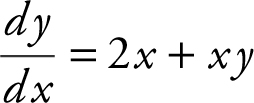 . Below is a summary of
. Below is a summary of  at the six given points.
at the six given points.

(B) At the point (0, 1),  . The equation of the tangent line is y − y 1 = m (x − x 1 ). In this case, y − 1 = 0(x − 0), or y = 1.
. The equation of the tangent line is y − y 1 = m (x − x 1 ). In this case, y − 1 = 0(x − 0), or y = 1.
(C) Since the tangent y = 1 is a constant function, the values of y stay at 1 for all values of x . Thus, using the tangent line at (0, 1) to approximate f (0.02), you have f (0.02) ≈ 1.
(D) Rewrite  as
as  , and obtain
, and obtain  . Integrating both sides of the equation, you have
. Integrating both sides of the equation, you have  . Integrate
. Integrate  by letting u = 2 + y and therefore du = dx . You obtain
by letting u = 2 + y and therefore du = dx . You obtain  . Thus, ln
. Thus, ln  . Applying the exponential function to both sides, you have
. Applying the exponential function to both sides, you have  . Since e c is an arbitrary constant, let k = e c and rewrite:
. Since e c is an arbitrary constant, let k = e c and rewrite:  as
as  . Substituting (0, 1) into the equation, you have |2 + 1| = (k )(e 0 ), which yields k = 3. Since the point (0, 1) is on the curve of y = f (x ), |2 + y | becomes 2 + y , and you have
. Substituting (0, 1) into the equation, you have |2 + 1| = (k )(e 0 ), which yields k = 3. Since the point (0, 1) is on the curve of y = f (x ), |2 + y | becomes 2 + y , and you have  , or
, or  .
.
4 . (A)
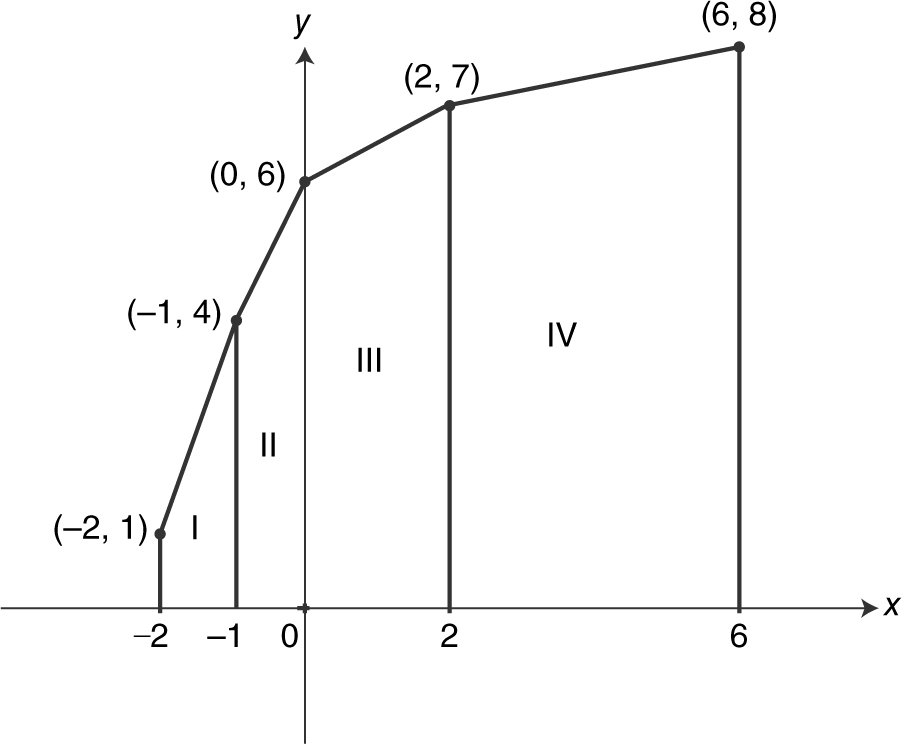

Therefore,

Note that you cannot use the formula

 , since the four given intervals have different lengths.
, since the four given intervals have different lengths.
(B) The average value of an integrable function on [a , b ] is  . In this case,
. In this case, 
 .
.
(C) The average rate of change of a continuous function on [a , b ] is  . In this case, the average rate of change of f is
. In this case, the average rate of change of f is  , or 0.875.
, or 0.875.
(D) Since f ″(x ) < 0 for all x ∈ (−2, 6) f ′(x ) is decreasing on the interval. Thus, f ′(0) > f ′(2).
5 . (A) Begin by summarizing f ′(x ) on a number line.

The graph of f has a local minimum at x = −2 on the interval (−4, 2).
(B) Summarize f ″(x ) on the number line.
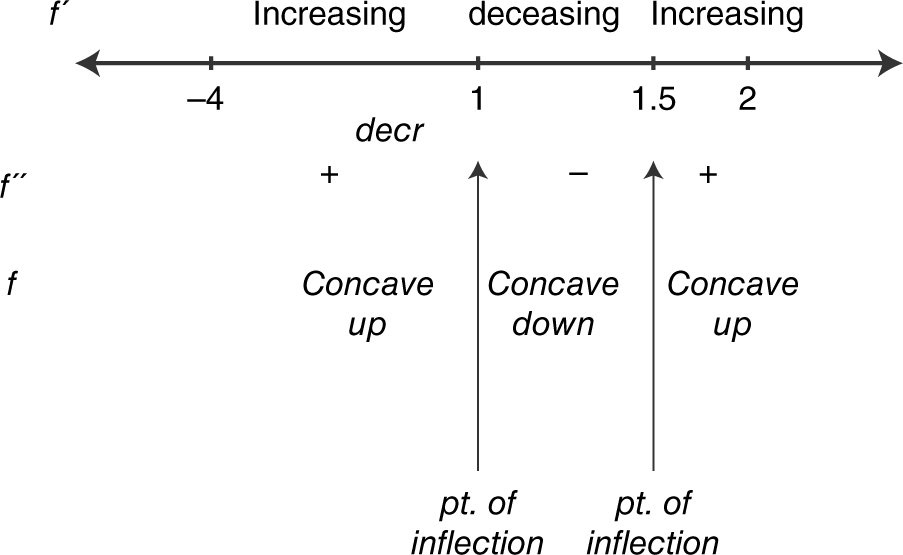
Since the graph of f changes concavity at x = −1 and x = 1.5, the graph of f has a point of inflection at x = −1 and x = 1.5.
(C) Note that  . Also,
. Also,  , with f (2) = 3. Since the area of region C is 6, and region C is below the x -axis, you have
, with f (2) = 3. Since the area of region C is 6, and region C is below the x -axis, you have  . Therefore, f (2) − f (1) = −6, or 3 − f (1) = −6, which yields f (1) = 9. Thus,
. Therefore, f (2) − f (1) = −6, or 3 − f (1) = −6, which yields f (1) = 9. Thus,  .
.
(D) By substituting x = −2, you have  . To find the value of f (−2), note that
. To find the value of f (−2), note that  . Also, using regions B and C , you have
. Also, using regions B and C , you have  . Therefore, 3 − f (−2) = 4, or f (−2) = −1. Since
. Therefore, 3 − f (−2) = 4, or f (−2) = −1. Since  leads to
leads to 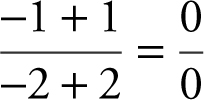 , an indeterminate form. Applying L’Hôpital’s Rule, you have
, an indeterminate form. Applying L’Hôpital’s Rule, you have  . Note that f ′(−2) = 0, and thus
. Note that f ′(−2) = 0, and thus  .
.
6 . (A) The equation of the curve is 14y − y 2 = x 2 + 24. Using implicit differentiation, you have  . Solve for
. Solve for  obtain
obtain  .
.
(B) The slope of the tangent at the point  . Using the formula of a line, y − y 1 = m (x − x 1 ), you have
. Using the formula of a line, y − y 1 = m (x − x 1 ), you have  , or
, or 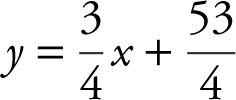 .
.
(C) The slope of all tangents to the curve is derived in part (A) as  . Remember that a vertical tangent has no slope. Therefore,
. Remember that a vertical tangent has no slope. Therefore,  is undefined for all vertical tangents, and
is undefined for all vertical tangents, and  is undefined when 7 − y = 0 or y = 7. Substituting y = 7 in the equation 14y − y 2 = x 2 + 24, you have 14(7) − (7)2 = x 2 + 24. Solve for x and obtain x = ±5. Therefore, the points of tangency are (5, 7) and (−5 7), and the equations of the vertical tangents are x = −5 and x = 5.
is undefined when 7 − y = 0 or y = 7. Substituting y = 7 in the equation 14y − y 2 = x 2 + 24, you have 14(7) − (7)2 = x 2 + 24. Solve for x and obtain x = ±5. Therefore, the points of tangency are (5, 7) and (−5 7), and the equations of the vertical tangents are x = −5 and x = 5.
(D) From part (A),  . Using the quotient rule, you have:
. Using the quotient rule, you have:  At the point (0, 2) on the curve,
At the point (0, 2) on the curve,  , Therefore,
, Therefore,  .
.
Scoring Sheet for AB Practice Exam 1
Section I—Part A

Section I—Part B

Section II—Part A (Each question is worth 9 points.)

Section II—Part B (Each question is worth 9 points)

Total Raw Score (Subtotals A + B + C + D) = 

AP Calculus AB Practice Exam 2
ANSWER SHEET FOR MULTIPLE-CHOICE QUESTIONS

Section I—Part A

Directions:
Use the answer sheet provided on the previous page. All questions are given equal weight. Points will not be deducted for incorrect answers, and no points will be given to unanswered questions. Unless otherwise indicated, the domain of a function f is the set of all real numbers. The use of a calculator is not permitted in this part of the exam.
1 . 
(A) 
(B) 
(C) 
(D) 
2 . The  is :
is :
(A) –1
(B) 0
(C) 
(D) 2
3 . What is the  , if
, if

(A) –3
(B) 1
(C) 3
(D) 11
4 . The graph of f ′ is shown below.

Which of the graphs below is a possible graph of f ?
(A) 
(B) 
(C) 
(D) 
5 . 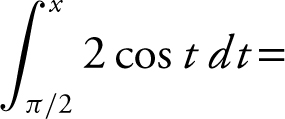
(A) 2 cos x
(B) –2 cos x
(C) 2 sin x
(D) 2 sin x – 2
6 . Given the equation y = 3e −2x , what is an equation of the normal line to the graph at x = ln 2?
(A) 
(B) 
(C) 
(D) 
7 . What is the 
(A) 
(B) 
(C) 0
(D) 
8 . If f (x) is an antiderivative of  and f (2) = 0, then f (0) =
and f (2) = 0, then f (0) =
(A) –6
(B) 6
(C) 
(D) 
9 . If a function f is continuous for all values of x , which of the following statements is/are always true?
I. 
II. 
III. 
(A) I only
(B) I and II only
(C) II only
(D) II and III only
10 . The graph of f is shown below and f is twice differentiable. Which of the following has the largest value: f (0), f ′(0), f ″(0)?
(A) f (0)
(B) f ′(0)
(C) f ″(0)
(D) f (0) and f ′(0)

11 . 
(A) 
(B) 
(C) 
(D) 
12 . If p ′(x ) = q (x ) and q is a continuous function for all values of x , then  is
is
(A) p (0) = – p (–4)
(B) 4p (0) – 4p (–4)
(C) 
(D) 
13 . Water is leaking from a tank at a rate represented by f (t ) whose graph is shown below. Which of the following is the best approximation of the total amount of water leaked from the tank for 1 ≤ t ≤ 3?
(A) 
(B) 5 gallons
(C) 175 gallons
(D) 350 gallons

14 . If f (x ) = 5 cos2 (π – x ), then  is
is
(A) 0
(B) – 5
(C) 5
(D) – 10
15 .  , then g ′(2) is
, then g ′(2) is
(A) 0
(B) 
(C) 
(D) 
16 . If  , a possible value of k is
, a possible value of k is
(A) –2
(B) 0
(C) 1
(D) 3
17 . If  for all positive values of a , then which of the following could be the graph of f ? (See below.)
for all positive values of a , then which of the following could be the graph of f ? (See below.)
(A) 
(B) 
(C) 
(D) 
18 . A function f is continuous on [1, 5] and some of the values of f are shown below:

If f has only one root, r , on the closed interval [1, 5], and r ≠ 3, then a possible value of b is
(A) –1
(B) 0
(C) 1
(D) 3
19 . Given the equation  , what is the instantaneous rate of change of V with respect to r at r = 5?
, what is the instantaneous rate of change of V with respect to r at r = 5?
(A) 
(B) 
(C) 
(D) 25π
20 . What is the slope of the tangent to the curve x 3 – y 2 = 1 at x = 1?
(A) 0
(B) 
(C) 
(D) Undefined
21 . The graph of function f is shown below. Which of the following is true for f on the interval (a , b )?

I. The function f is differentiable on (a , b ).
II. There exists a number k on (a , b ) such that f ′(k ) = 0.
III. f ″ > 0 on (a , b ).
(A) I only
(B) I and II only
(C) II only
(D) II and III only
22 . The velocity function of a moving particle on the x -axis is given as v (t ) = t 2 – 3t – 10. For what positive values of t is the particle’s speed increasing?
(A) 
(B) 
(C) t > 5 only
(D) 
23 . The graph of f consists of two line segments and a semicircle for – 2 ≤ x ≤ 2 as shown below. What is the value of 

(A) – 2 – 2π
(B) – 2 – π
(C) 
(D) 
24 . What is the average value of the function y = 3 cos(2x ) on the interval 
(A) – 2
(B) 
(C) 0
(D) 
25 . If f (x ) = |x 3 |, what is the value of 
(A) – 3
(B) 0
(C) 1
(D) 3
26 . A spherical balloon is being inflated. At the instant when the rate of increase of the volume of the sphere is four times the rate of increase of the radius, the radius of the sphere is
(A) 
(B) 
(C) 
(D) 
27 . If  and at x = 0, y = 4, a solution to the differential equation is
and at x = 0, y = 4, a solution to the differential equation is
(A) 
(B) 
(C) 
(D) 
28 . The area of the region enclosed by the graph of x = y 2 – 1 and they -axis is
(A) 
(B) 0
(C) 
(D) 
29 . The graph off ′, the derivative of f , is shown below. At which value of x does the graph f have a horizontal tangent?

(A) x 1
(B) 0
(C) x 2
(D) x 3
30 . If f (x ) = – |x – 3|, which of the following statements about f is true?
I. f is differentiable at x = 3.
II. f has an absolute minimum at x = 3.
III. f has a point of inflection at x = 3.
(A) II only
(B) III only
(C) II and III only
(D) None
STOP. AP Calculus AB Practice Exam 2 Section I—Part A
Section I—Part B

Directions:
Use the same answer sheet from Part A. Please note that the questions begin with number 76. This is not an error. It is done to be consistent with the numbering system of the actual AP Calculus AB exam. All questions are given equal weight. Points will not be deducted for incorrect answers, and no points will be given to unanswered questions. Unless otherwise indicated, the domain of a function f is the set of all real numbers. If the exact numerical value does not appear among the given choices, select the best approximate value. The use of a calculator is permitted in this part of the exam.
76 . The position function of a moving particle is s (t ) = 5 + 4t – t 2 for 0 ≤ t ≤ 10 where s is in meters and t is measured in seconds. What is the maximum speed in m/sec of the particle on the interval 0 ≤ t ≤ 10?
(A) – 16
(B) 2
(C) 4
(D) 16
77 . How many points of inflection does the graph of y = cos (x 2 ) have on the interval (0, π)?
(A) 0
(B) 1
(C) 2
(D) 3
78 . Let f be a continuous function on [4, 10] and have selected values as shown below:

Using three right endpoint rectangles of equal length, what is the approximate value of 
(A) 8.4
(B) 9.6
(C) 14.4
(D) 16.8
79 . Given a differentiable function f with f (– 1) = 2 and  . Using a tangent line to the graph of f at x = – 1 find an approximate value of f (– 1.1)?
. Using a tangent line to the graph of f at x = – 1 find an approximate value of f (– 1.1)?
(A) –3.05
(B) – 1.95
(C) 0.95
(D) 1.95
80 . If area under the curve of  is 0.66 from x = 1 to x = b , where b > 1, then the value of b is approximately,
is 0.66 from x = 1 to x = b , where b > 1, then the value of b is approximately,
(A) 1.93
(B) 2.25
(C) 3.15
(D) 3.74
81 . The base of a solid is a region enclosed by the circle x 2 + y 2 = 4. What is the approximate volume of the solid if the cross sections of the solid perpendicular to the x -axis are semicircles?
(A) 8π
(B) 
(C) 
(D) 
82 . The temperature of a cup of coffee is dropping at the rate of  degrees for 0 ≤ t ≤ 5, where f is measured in Fahrenheit and t in minutes. If initially, the coffee is 95°F, find its temperature to the nearest degree Fahrenheit 5 minutes later.
degrees for 0 ≤ t ≤ 5, where f is measured in Fahrenheit and t in minutes. If initially, the coffee is 95°F, find its temperature to the nearest degree Fahrenheit 5 minutes later.
(A) 84
(B) 85
(C) 91
(D) 92
83 . The graphs of f ′, g ′, p ′, and q ′ are shown below. Which of the functions f , g , p , or q have a relative minimum on (a , b )?
(A) f only
(B) g only
(C) p only
(D) q only

84 . What is the volume of the solid obtained by revolving the region enclosed by the graphs of x = y 2 and x = 9 about the y -axis?
(A) 36π
(B) 
(C) 
(D) 
85 . At what value(s) of x do the graphs of y = ex and y = x 2 + 5x have parallel tangent lines?
(A) – 2.5
(B) 0
(C) 0 and 5
(D) – 2.45 and 2.25
86 . Let y represent the population in a town. If y decreases according to the equation  , with t measured in years, and the population decreases by 25% in 6 years, then k =
, with t measured in years, and the population decreases by 25% in 6 years, then k =
(A) – 8.318
(B) – 1.726
(C) – 0.231
(D) – 0.048
87 . If  on [4, 8], then h has a local minimum at x =
on [4, 8], then h has a local minimum at x =
(A) 4
(B) 5
(C) 6
(D) 7
88 . The volume of the solid generated by revolving the region bounded by the graph of y = x 3 , the line y = 1, and the y -axis about the y -axis is
(A) 
(B) 
(C) 
(D) 

89 . If  and the graph of q is shown above, which of the graphs shown below is a possible graph of p ?
and the graph of q is shown above, which of the graphs shown below is a possible graph of p ?
(A) 
(B) 
(C) 
(D) 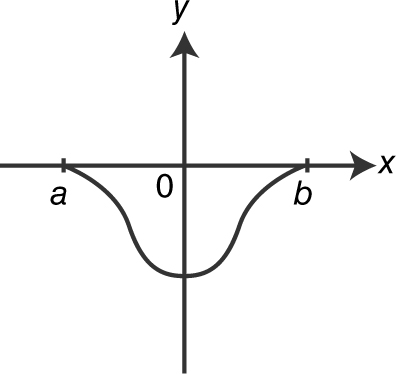
90 . The equation of the tangent line to the graph of y = sin x for 0 ≤ x ≤ π at the point where  is
is
(A) 
(B) 
(C) 
(D) 
STOP. AP Calculus AB Practice Exam 2 Section I—Part B
Section II—Part A

Directions:
Show all work. You may not receive any credit for correct answers without supporting work. You may use an approved calculator to help solve a problem. However, you must clearly indicate the setup of your solution using mathematical notations and not calculator syntax. Calculators may be used to find the derivative of a function at a point, compute the numerical value of a definite integral, or solve an equation. Unless otherwise indicated, you may assume the following: (a) the numeric or algebraic answers need not be simplified; (b) your answer, if expressed in approximation, should be correct to 3 places after the decimal point; and (c) the domain of a function f is the set of all real numbers.
1 . Let R be the region in the first quadrant enclosed by the graph of y = 2 cos x , the x -axis, and the y -axis.
(A) Find the area of the region R .
(B) If the line x = a divides the region R into two regions of equal area, find a .
(C) Find the volume of the solid obtained by revolving region R about the x -axis.
(D) If R is the base of a solid whose cross sections perpendicular to the x -axis are semicircles, find the volume of the solid.
2 . The temperature of a liquid at a chemical plant during a 20-minute period is given as  , where g (t ) is measured in degrees Fahrenheit, 0 ≤ t ≤ 20 and t is measured in minutes.
, where g (t ) is measured in degrees Fahrenheit, 0 ≤ t ≤ 20 and t is measured in minutes.
(A) Sketch the graph of g on the provided grid. What is the temperature of the liquid to the nearest hundredth of a degree Fahrenheit when t = 10? (See below.)

(B) What is the instantaneous rate of change of the temperature of the liquid to the nearest hundredth of a degree Fahrenheit at t = 10?
(C) At what values of t is the temperature of the liquid below 86°F?
(D) During the time within the 20-minute period when the temperature is below 86°F, what is the average temperature to the nearest hundredth of a degree Fahrenheit?
STOP. AP Calculus AB Practice Exam 2, Section II—Part A.
Section II—Part B

Directions:
The use of a calculator is not permitted in this part of the exam. When you have finished this part of the exam, you may return to the problems in Part A of Section II and continue to work on them. However, you may not use a calculator. You should show all work. You may not receive any credit for correct answers without supporting work. Unless otherwise indicated, the numeric or algebraic answers need not be simplified, and the domain of a function f is the set of all real numbers.
3 . A particle is moving on a coordinate line. The graph of its velocity function v (t ) for 0 ≤ t ≤ 24 seconds is shown below.

(A) Using midpoints of the three subintervals of equal length, find the approximate value 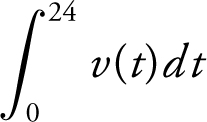 .
.
(B) Using the result in part (A), find the average velocity over the interval 0 ≤ t ≤ 24 seconds.
(C) Find the average acceleration over the interval 0 ≤ t ≤ 24 seconds.
(D) When is the acceleration of the particle equal to zero?
(E) Find the approximate acceleration at t = 20 seconds.
4 . Given the function f (x ) = 3e −2x ,
(A) at what value(s) of x , if any, is f ′(x ) = 0?
(B) at what value(s) of x , if any, is f ′(x ) = 0?
(C) find  and
and  .
.
(D) find the absolute maximum value of f and justify your answer.
(E) show that if f (x ) = ae −bx 2 where a > 0 and b > 0, the absolute maximum value of f is a .
5 . The function f is defined as  where the graph of g consists of five line segments as shown below.
where the graph of g consists of five line segments as shown below.
(A) Find f (− 3) and f (3).
(B) Find all values of x on (− 3, 3) such that f has a relative maximum or minimum. Justify your answer.
(C) Find all values of x on (− 3, 3) such that the graph f has a change of concavity. Justify your answer.
(D) Write an equation of the line tangent to the graph to f at x = 1.
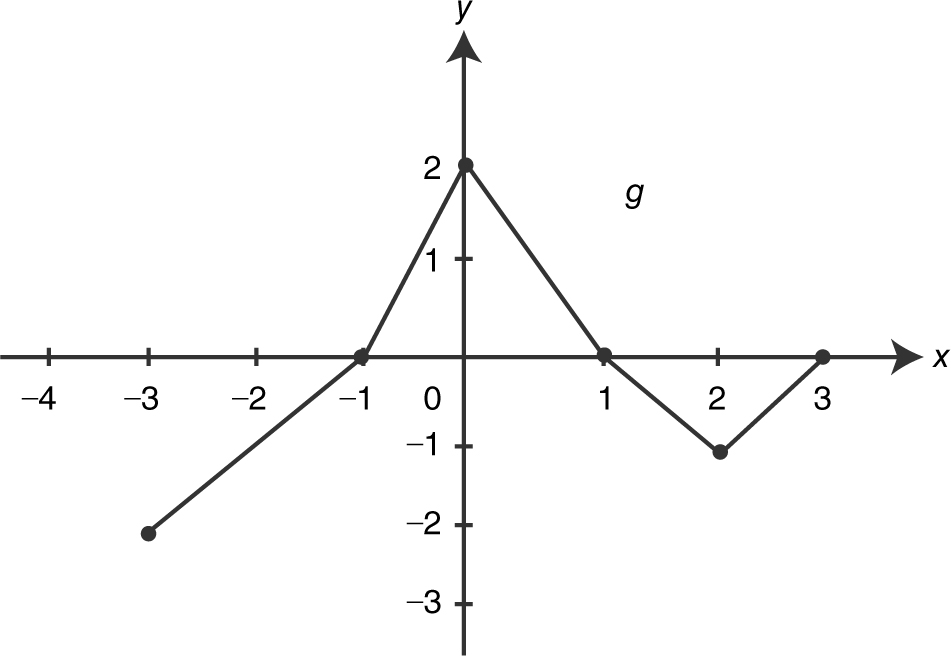
6 . The slope of a function f at any point (x , y ) is  . The point (2, 1) is on the graph of f .
. The point (2, 1) is on the graph of f .
(A) Write an equation of the tangent line to the graph of f at x = 2.
(B) Use the tangent line in part (A) to approximate f (2.5).
(C) Solve the differential equation  with the initial condition f (2) = 1.
with the initial condition f (2) = 1.
(D) Use the solution in part (C) and find f (2.5).
STOP. AP Calculus AB Practice Exam 2, Section II—Part B.
Answers to AB Practice Exam 2—Section I
Part A
1 . B
2 . B
3 . C
4 . D
5 . D
6 . A
7 . B
8 . D
9 . C
10 . A
11 . D
12 . C
13 . C
14 . A
15 . C
16 . D
17 . A
18 . A
19 . A
20 . D
21 . C
22 . D
23 . C
24 . C
25 . A
26 . B
27 . D
28 . D
29 . D
30 . D
Part B
76 . D
77 . D
78 . D
79 . D
80 . C
81 . B
82 . A
83 . A
84 . D
85 . D
86 . D
87 . B
88 . C
89 . D
90 . B
Answers to AB Practice Exam 2—Section II
Part A
1 . 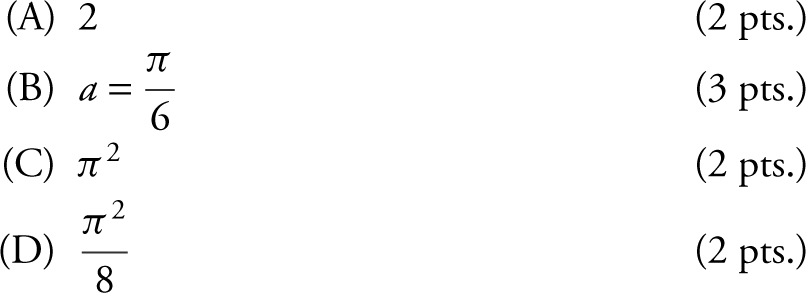
2 . 
Part B
3 . 
4 . 
5 . 
6 . 
Solutions to AB Practice Exam 2—Section I
Section I—Part A
1 . The correct answer is (B).

2 . The correct answer is (B).
The  , and
, and  . Therefore,
. Therefore, 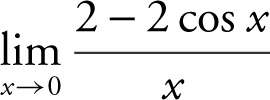 is an indeterminate form of
is an indeterminate form of  . Applying L’Hôpital’s Rule, you have
. Applying L’Hôpital’s Rule, you have  .
.
3 . The correct answer is (C).

4 . The correct answer is (D).

5 . The correct answer is (D).

6 . The correct answer is (A).

Slope of normal line at x = ln 2 is  .
.
At x = ln 2,  ; point
; point  .
.
Equation of normal line:
 or
or  .
.
7 . The correct answer is (B).

8 . The correct answer is (D).
Let u = x 3 + 1, du = 3x 2 dx or  .
.


9 . The correct answer is (C).
Statement I is not true , e.g.,
 .
.
Statement II is always true since
 by properties of definite integrals.
by properties of definite integrals.
Statement III is not true , e.g.,
 .
.
10 . The correct answer is (A).
f (0) = 0; f ′(0) < 0 since f is decreasing and f ″ < 0, f is concave downward. Thus, f (0) has the largest value.
11 . The correct answer is (D).

12 . The correct answer is (C).
Let u = 4x ;  .
.

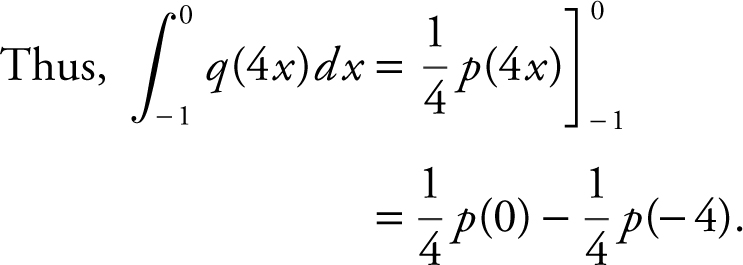
13 . The correct answer is (C).
The total amount of water leaked from the tank for

14 . The correct answer is (A).

15 . The correct answer is (C).

16 . The correct answer is (D).

17 . The correct answer is (A).
 is an odd function. The function whose graph is shown in (A) is the only odd function.
is an odd function. The function whose graph is shown in (A) is the only odd function.
18 . The correct answer is (A).

If b = 0, then r = 3, but r cannot be 3. If b = 1, or 3, f would have more than one root. Thus, of all the choices, the only possible value for b is – 1.
19 . The correct answer is (A).

20 . The correct answer is (D).

21 . The correct answer is (C).
I. f is differentiable on (a , b ) since the graph is a smooth curve.
II. There exists a horizontal tangent to the graph on (a , b ); thus, f ′(k ) = 0 for some k on (a , b ).
III. The graph is concave downward; thus f ″< 0.
22 . The correct answer is (D).


Since v (t ) and a (t ) are both negative on (0, 3/2), and are both positive on (5, ∞), the particle’s speed is increasing on these intervals.
23 . The correct answer is (C).

24 . The correct answer is (C).

25 . The correct answer is (A).

26 . The correct answer is (B).

Since  or
or
 .
.
27 . The correct answer is (D).


 . Substituting (0, 4)
. Substituting (0, 4)
 .
.
Thus, a solution is  .
.
28 . The correct answer is (D).


29 . The correct answer is (D).
At x = x 3 , f ′ = 0. Thus the tangent to the graph of f atx = x 3 is horizontal.
30 . The correct answer is (D).

The function f is not differentiable at x = 3, has an absolute maximum at x = 3, and has no point of inflection. Thus, all three statements are not true.
Section I—Part B
76 . The correct answer is (D).
s (t ) = 5 + 4t – t 2 ; v (t ) = s ′(t ) = 4 – 2t

Since v (t ) is a straight line with a negative slope, the maximum speed for 0 ≤ t ≤ 10 occurs at t = 10 where v (t ) = 4 – 2(10) = – 16. Thus maximum speed = 16.
77 . The correct answer is (D).

Using the [ Inflection ] function of your calculator, you will find three points of inflection. They occur at x = 1.335, 2.195, and 2.8.
78 . The correct answer is (D).
 .
.
79 . The correct answer is (D).
f (– 1) = 2 ⇒ point (– 1, 2).
 the slope at x = – 1 is
the slope at x = – 1 is  .
.
Equation of tangent at x = – 1 is  . Thus,
. Thus,  .
.
80 . The correct answer is (C).
 .
.
Let u = ln x ;  .
.


81 . The correct answer is (B).


82 . The correct answer is (B).
Temperature of coffee

83 . The correct answer is (A).
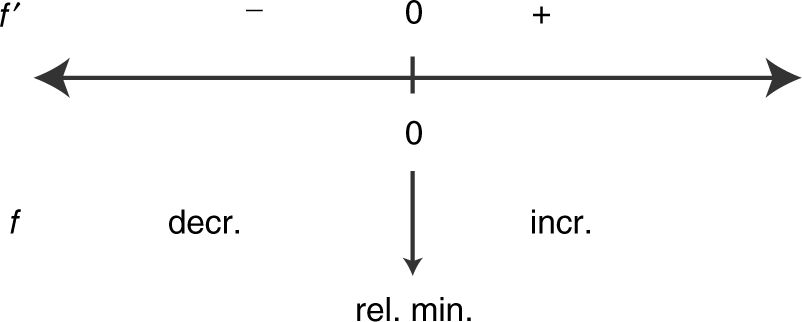
Only f has a relative minimum on (a , b ).
84 . The correct answer is (D).


85 . The correct answer is (D).

If the graphs have parallel tangents at a point, then the slopes of the tangents are equal. Enter y 1 = e x and y 2 = 2x + 5. Using the [Intersection ] function on your calculator, you obtain x = – 2.45 and x = 2.25.
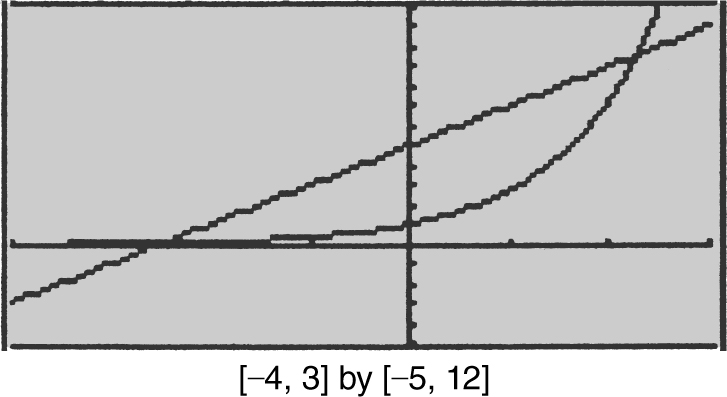
86 . The correct answer is (D).

87 . The correct answer is (B).
h ′(x ) = (x – 5)3

Thus, h has a relative minimum at x = 5.
88 . The correct answer is (C).


Using your calculator, you obtain V = 3π/5.
89 . The correct answer is (D).
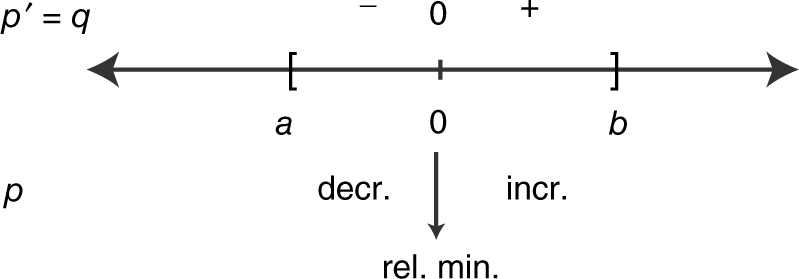
The graph in choice (D) is the one that satisfies the behavior of p .
90 . The correct answer is (B).

Equation of tangent line at  :
:

Solutions to AB Practice Exam 2—Section II
Section II—Part A
1 .

(A) 
(B) 
(C) 
(D) 
2 . (A)

(B) 

(C) Set the temperature of the liquid equal to 86°F. Using your calculator, let  . To find the intersection point of y 1 and y 2 , let y 3 = y 2 and find the zeros of y 3 . Using the [Zero ] function of your calculator, you obtain x = 15.708. Since y 1 < y 2 on the interval 15.708 < x ≤ 20, the temperature of the liquid is below 86.°F when 15.708 < t ≤ 20.
. To find the intersection point of y 1 and y 2 , let y 3 = y 2 and find the zeros of y 3 . Using the [Zero ] function of your calculator, you obtain x = 15.708. Since y 1 < y 2 on the interval 15.708 < x ≤ 20, the temperature of the liquid is below 86.°F when 15.708 < t ≤ 20.
(D) Average temperature below 86° 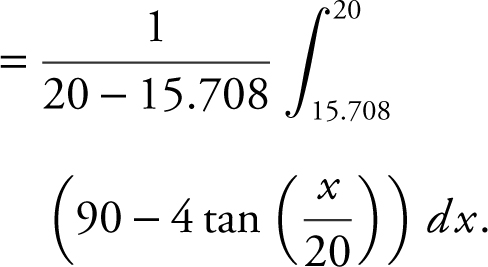 Using your calculator, you obtain:
Using your calculator, you obtain: 
Section II—Part B
3 . (A) The midpoints of 3 subintervals of equal length are:
t = 4, 12, and 20.
The length of each interval is 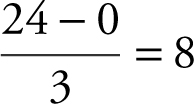 .
.

(B) 
(C) 
(D) a (t ) = 0 at t = 6 and t = 14, since the slopes of tangents at t = 6 and t = 14 are 0.
(E) 
4 . (A) f ′(x ) = 3(e −2x 2 )(–4x ) = – 12xe −2x 2 Setting f ′(x ) = 0, – 12xe −2x 2 = 0 ⇒ x = 0.
(B) 
(C) 
(D)


f (0) = 3, since f has only one critical point (at x = 0), thus at x = 0, f has an absolute maximum. The absolute maximum value is 3.
(E) f (x ) = ae −bx 2 , a > 0, b > 0
f ′(x ) = ae −bx 2 (–2bx ) = –2abxe −bx 2
Setting
f ′(x ) = 0, –2abxe −bx 2 = 0 ⇒ x = 0
 .
.
f ′(x ) > 0 if x < 0 and f ′(x ) < 0 if x > 0. Thus, f has a relative maximum at x = 0, and since it is the only critical point, f has an absolute maximum at x = 0. Since f (0) = a , the absolute maximum for f is a .
5 . (A)
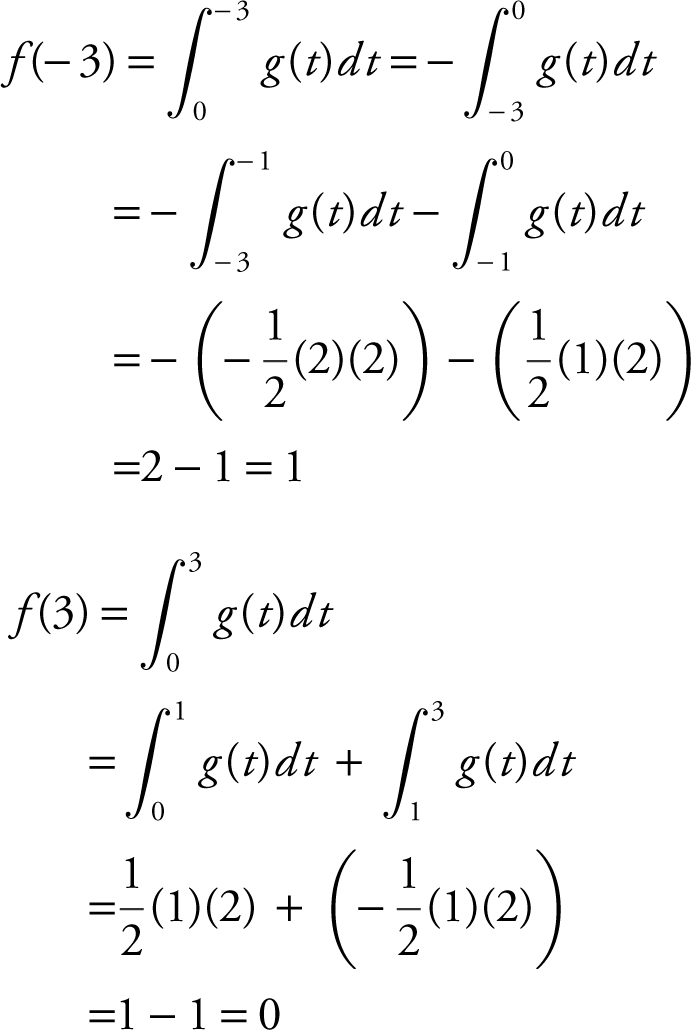
(B) Note that f ′(x ) = g (x ), and g (x ) < 0 on (– 3, – 1) and (1, 3) and that g (x ) > 0 on (− 1, 1). The function f increases on (−1, 1) and decreases on (1, 3). Thus f has a relative maximum at x = 1. Also, f decreases on (− 3, – 1) and increases on (− 1, 1). Thus, f has a relative minimum at x = – 1.
(C) f ′(x ) = g (x ) and f ″(x ) = g ′(x )

The function f has a change of concavity at x = 0 and x = 2.
(D) 
Thus, m = 0, point (1, 1); the equation of the tangent line to f (x ) at x = 1 is y = 1.
6 . (A)

Equation of tangent:

(B) 
(C) 

Since  .
.
Thus,  .
.
(D) 
Scoring Sheet for AB Practice Exam 2
Section I—Part A

Section I—Part B

Section II—Part A (Each question is worth 9 points.)

Section II—Part B (Each question is worth 9 points.)

Total Raw Score (Subtotals A + B + C + D) = 
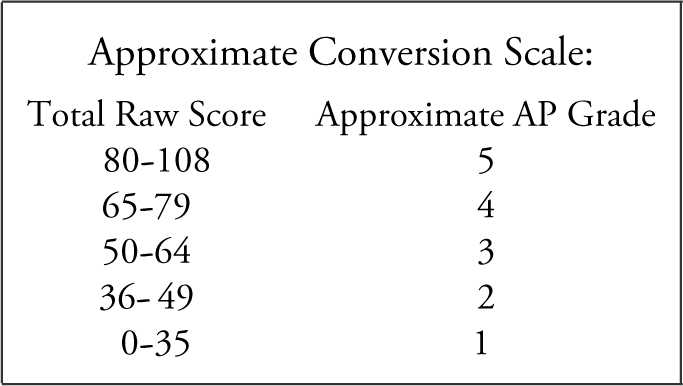
APPENDIX
1. Quadratic Formula:

2. Distance Formula:

3. Equation of a Circle:
x 2 + y 2 = r 2 center at (0, 0) and radius = r .
4. Equation of an Ellipse:
 center at (0, 0).
center at (0, 0).
 center at (h , k ).
center at (h , k ).
5. Area and Volume Formulas:


6. Special Angles:

7. Double Angles:
• sin 2θ = 2 sin θ cos θ
• cos 2θ = cos2 θ – sin2 θ or 1 – 2 sin2 θ or 2 cos2 θ – 1.
• 
• 
8. Pythagorean Identities:
• sin2 θ + cos2 θ = 1
• 1 + tan2 θ = sec2 θ
• 1 + cot2 θ = csc2 θ
9. Limits:
• 
10. L’Hôpital’s Rule for Indeterminate Forms Let lim represent one of the limits  . Suppose f (x ) and g (x ) are differentiable and g ′(x ) ≠ 0 near c , except possibly at c , and suppose lim f (x ) = 0 and lim g (x ) = 0. Then the lim
. Suppose f (x ) and g (x ) are differentiable and g ′(x ) ≠ 0 near c , except possibly at c , and suppose lim f (x ) = 0 and lim g (x ) = 0. Then the lim  is an indeterminate form of the type
is an indeterminate form of the type  . Also, if lim f (x ) = ±∞ and lim g (x ) = +∞, then the lim
. Also, if lim f (x ) = ±∞ and lim g (x ) = +∞, then the lim  is an indeterminate form of the type
is an indeterminate form of the type  . In both cases,
. In both cases,  and
and  , L’Hôpital’s Rule states that
, L’Hôpital’s Rule states that  .
.
11. Rules of Differentiation:
a. Definition of the Derivative of a Function:

b. Power Rule: 
c. Sum & Difference Rules:

d. Product Rule:

e. Quotient Rule:

Summary of Sum, Difference, Product, and Quotient Rules:

f. Chain Rule:

12. Inverse Function and Derivatives:

13. Differentiation and Integration Formulas: Integration Rules
a. 
b. 
c. 
d. 
Differentiation Formulas:
a. 
b. 
c. 
d. 
e. 
f. 
g. 
h. 
i. 
j. 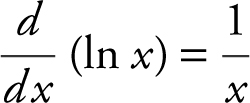
k. 
l. 
m. 
n. 
o. 
Integration Formulas:
a. 
b. 
c. 
d. 
e. 
f. 
g. 
h. 
i. 
j. 
k. 
l. 
m. 
n. 
o. 
More Integration Formulas:
a. 
b. 
c. 
d. 
e. 
f. 
g. 
h. 
i. 

Note: After evaluating an integral, always check the result by taking the derivative of the answer (i.e., taking the derivative of the antiderivative).
14. Intergration by parts  (and follow LIPET Rule).
(and follow LIPET Rule).
15. The Fundamental Theorem of Calculus
 ,
,
where F ′(x ) = f (x ).
 .
.
16. Trapezoidal Approximation:

17. Average Value of a Function:

18. Mean Value Theorem:
 for some c in (a , b ).
for some c in (a , b ).
Mean Value Theorem for Integrals:
 for some c in (a , b ).
for some c in (a , b ).
19. Area Bounded by 2 Curves:

where f (x ) ≥ g (x ).
20. Volume of a Solid with Known Cross Section:
 ,
,
where A (x ) is the cross section.
21. Disc Method:
 .
.
22. Using the Washer Method:
 ,
,
where f (x ) = outer radius and g (x ) = inner radius.
23. Distance Traveled Formulas:
• Position Function: 
• Velocity: 
• Acceleration: 
• Speed: |v (t )|
• Displacement from  = s (t 2 ) – s (t 1 ).
= s (t 2 ) – s (t 1 ).
• Total Distance Traveled from t 1 to  .
.
24. Business Formulas:
 .
.
P ′(x ), R ′(x ), C ′(x ) are the instantaneous rates of change of profit, revenue, and cost respectively.
25. Exponential Growth/Decay Formulas:
 .
.
BIBLIOGRAPHY
Advanced Placement Program Course Description. New York: The College Board, 2010.
Anton, H., Bivens, I. & Davis, S. Calculus , 7th edition. New York: John Wiley & Sons, 2001.
Apostol, Tom M. Calculus . Waltham, MA: Blaisdell Publishing Company, 1967.
Berlinski, David. A Tour of the Calculus . Colorado Springs: Vintage, 1997.
Boyer, Carl B. The History of the Calculus and Its Conceptual Development . New York: Dover, 1959.
Finney, R., Demana, F. D., Waits, B. K. & Kennedy, D. Calculus Graphical, Numerical, Algebraic . Boston: 3rd edition, Pearson Prentice Hall, 2002.
Larson, R. E., Hostetler, R. P. & Edwards, B. H. Calculus , 8th edition. New York: Brooks Cole, 2005.
Leithold, Louis. The Calculus with Analytic Geometry , 5th edition. New York: Longman Higher Education, 1986.
Sawyer, W. W. What Is Calculus About ? Washington, DC: Mathematical Association of America, 1961.
Spivak, Michael. Calculus , 4th edition. New York: Publish or Perish, 2008.
Stewart, James. Calculus , 4th edition. New York: Brooks/Cole Publishing Company, 1999.
WEBSITES
College Board Resources
APCalculus - Course Description
http://media.collegeboard.com/digitalServices/pdf/ap/ap-calculus-course-description.pdf
About the APCalculus AB Exam in General:
https://apstudent.collegeboard.org/apcourse/ap-calculus-ab/about-the-exam
Current Calculator Policy:
https://apstudent.collegeboard.org/apcourse/ap-calculus-ab/calculator-policy
AP Calculus AB - Course Overview:
https://apstudent.collegeboard.org/apcourse/ap-calculus-ab/
AP Calculus AB - Course Details:
https://apstudent.collegeboard.org/apcourse/ap-calculus-ab/course-details
AP Calculus AB - Sample Questions
https://apstudent.collegeboard.org/apcourse/ap-calculus-ab/exam-practice
Other Resources for Students
MIT OpenCourseware for Calculus
http://ocw.mit.edu/high-school/mathematics/
Khan Academy
https://www.khanacademy.org/math/differential-calculus
Teaching Resources
http://apcentral.collegeboard.com/apc/public/courses/teachers_corner/2178.html
 .
. in inches per second.
in inches per second. and
and  .
. and not
and not  .
. and the surface area is s = 4πr 2 . Note that v ′ = s .
and the surface area is s = 4πr 2 . Note that v ′ = s . where r is the radius of the base and h is the height of the cone.
where r is the radius of the base and h is the height of the cone. . Do not forget the
. Do not forget the  . If the cross sections of a solid are semi-circles, the integral for the volume of the solid will involve
. If the cross sections of a solid are semi-circles, the integral for the volume of the solid will involve  which is
which is  .
. or s = 4πr 2 , do not forget that r = 3.
or s = 4πr 2 , do not forget that r = 3. and y = y 0 ekt .
and y = y 0 ekt . .
.